|
 Date : 7/5/2017 (1) Date : 7/5/2017 (1)
| | 7/5/2017 | The holiday weekend is but a memory now and I hope your memories are good ones. It was a scorcher in many areas of Maryland and people flocked to the water for relief. It did my heart good to see fishing rods peeking out through mini -van windows or in the back of pickup trucks as folks headed to their waterside destinations. The summer will tend to move along now and before we know it we'll be starring Labor Day in the face so don't put off spending time with family and friends fishing.
The Lower Susquehanna River continues to give up a fair amount of striped bass for those willing to be at the Conowingo Dam pool at sunrise. The power generation releases usually begin before daybreak and continue into the afternoon. Casting heavy swimshads with surf casting gear into the most turbulent parts of the pool has been a great option. Others are having success casting topwater lures in the boulder fields farther down river at sun up. Josh Zylka holds up a nice striped bass caught in the lower Susquehanna on a popper.
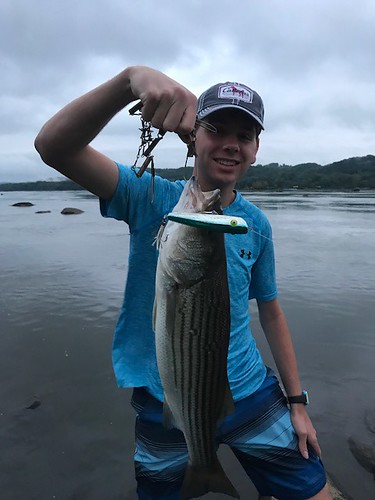
Photo courtesy of Craig Zylka
A few striped bass are being caught around the edges of the flats but most of the action in the upper bay is focused from the Rock Hall area south. Chumming has taken center stage at Swan Point, Love Point and Podickory Point. It has been a good idea to locate suspended fish on a depth finder and anchor up and allow chum and baits to drift into the deeper edges of the channel. As always a good tide is essential. As usual, the chum slicks are being swarmed with two and three year old striped bass that are less than twenty inches in length so it takes some strategy to get to the larger fish that often are 28" or better. Allowing baits to get to the bottom and in the back of the slick has been the best tactic, and sometimes it takes a squeeze on weight of a half-ounce or so a couple of feet in front of the bait. Surface water temperatures are now around 82 degrees so the larger fish will like to stay deep and mornings will usually offer better fishing results. Channel catfish can be part of the mix when fishing baits on the bottom.
Trolling has been another option in the upper bay and pulling small to medium parachutes, bucktails and surge tube lures in tandem or behind umbrella rigs with inline weights. Jigging can be fruitful, especially at the Bay Bridge piers and rock piles on a good running tide. Angelina Watts spend some time with her dad jigging around the Bay Bridge piers on July 4th and enjoyed good fishing.
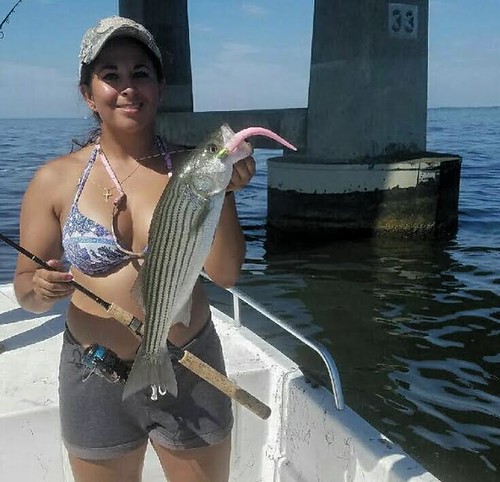
Photo courtesy of Rich Watts
White perch are providing plenty of fun fishing action in the tidal rivers and out in the bay. The deeper structure in the rivers such as old piers, rocks and prominent points have been a good place to fish with bottom rigs and bloodworms or grass shrimp or shad darts and jigs tipped with the same. Out in the bay, hard bottom at some of the shoal and knoll areas are holding good schools of good sized white perch.
In the middle bay region, just below the Bay Bridge, Hackett's Bar continues to be one of the better options for those who wish to chum for their striped bass. At times striped bass can be found suspended along channel edges near the mouth of Eastern Bay near the Hill. Anchoring up on suspended fish along the outside edge at about 30' and letting baits lie on the bottom at the distal end of the slick has been a great strategy. A large number of the striped bass being seen in the middle bay region are less than 20" in length so it takes some sorting through at times to come up with legal fish. Now that water temperatures are in the low 80's, mornings will usually offer the best opportunities for larger fish.
Trolling a mix of small to medium sized bucktails, parachutes or surge tube lures behind inline weights has been a good option along some of the steeper channel edges on the western side of the shipping channel and near Buoy 86 and the mouth of Eastern Bay. Jigging underneath breaking fish or when suspended fish can be spotted is also a good option this week. Eastern Bay and the main channel areas in the bay are good places to check.
The shallow water striped bass fishery in the middle bay region continues to offer enough nice striped bass over 20" to make getting up before sunrise worthwhile. Topwater lures are best in the grassy areas, to avoid fouling your lure. Old submerged breakwaters, prominent points and shoreline structure in the lower portions of the tidal rivers and the bay shores are the places to target. The rock jetty shoreline of Poplar Island is always a popular place to fish as are the shores of Eastern Bay and the lower Choptank.
Fishing for white perch in the lower sections of the region's tidal rivers and creeks continues to be good this week and offers some fun summer time fishing with light tackle. The perch are usually found close to structure such as old piers and rocks or on live oyster bottom. Bloodworms or live grass shrimp are two of the better baits to use on a simple bottom rig and placing a piece on a shad dart and working close to structure is a good option. Casting small spinners or beetle spins near shoreline structure with light tackle is always a fun past time.
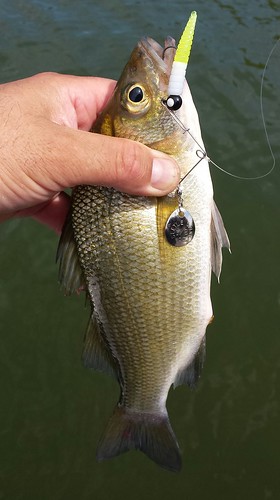
Photo courtesy of Rich Watts
In the lower bay region there is good chumming for a mix of striped bass and small bluefish along the eastern edge of the shipping channel from the HS Buoy south to Buoy 72 and the Middle Grounds. On the western side there has been some chumming action at Cove Point, Point No Point and up the Potomac River near St. Georges Island and Piney Point. Jigging has been good at these same locations on occasion when suspended fish can be spotted on depth finders or under small fish that are chasing bait on the surface. Soft plastic jigs have been a favorite lately despite the presence of bluefish.
There has been some good topwater action in the early morning hours at Cedar Point, the St. Mary's River shorelines and over on the Tangier/Pocomoke Sound area marsh islands and creeks. Most of the action on the western side of the bay tends to be striped bass but on the eastern side there is a mix of speckled trout, small striped bass and a few puppy drum. Drifting peeler crab or soft crab baits on a falling tide in many areas with a good current is a good way to catch speckled trout, as is casting white Gulp mullet swimshads.
Bottom fishing in the region is a mix of small croaker, kingfish, a few spot and a lot of white perch. There are some flounder being caught on the hard channel edges in Tangier and Pocomoke Sounds. Gulp baits on a bottom rig or jig head or a flounder rig baited with squid and or minnows have been good baits to use.
Recreational crabbing in the lower bay tidal rivers and creeks has been excellent this past week and most crabbers are doing well with chicken necks. In the middle bay region crabbing is good where razor clams have been the favorite bait for the best catches. Recreational crabbing in the upper bay tidal rivers has been fair at best with most struggling to come up with decent catches. Lucas Livingston sure was happy to be able to go crabbing with his grandfather and catch some whopper sized crabs.
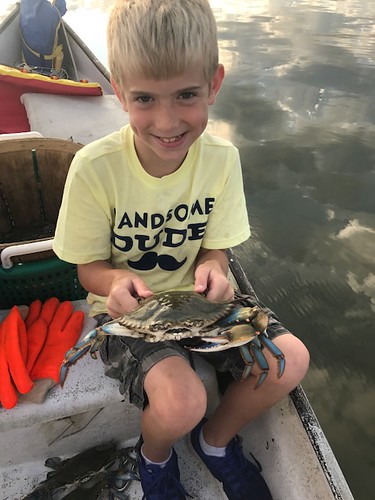
Photo courtesy of Jim Livingston
Freshwater trout fishing in the western region's trout management waters that are catch and release are offering good fishing for fly fishermen who keep an eye on the various hatches. These managed waters can be viewed on the trout stocking maps for the western and a few select central region waters. Pick a county and scroll down past the stocked waters section to the trout managed waters to obtain information.
Deep Creek Lake offers some good fishing for smallmouth and largemouth bass this week if one gets out before the sun rise. Boat traffic and vacationers are in full swing now on the lake and it makes it hard to fish in some form of peace and quiet. Largemouth and smallmouth bass can be found looking for shade under floating docks and flipping whacky rigged soft plastics is a great way to entice them to strike. Yellow perch, walleye and trout will be holding deep in the deepest parts of the lake such as the dam face.
Many freshwater fish are now into a summer mode of behavior where they seek shade and cool water during the day, which usually means they go deep or seek refuge under thick floating grass or some type of shade. That shade can be shoreline brush, docks and piers, fallen tree tops or suspended logs. They tend to move into shallower waters at dusk and largemouth bass will feed all night into early morning and then retreat to cooler waters. Generally the best tactics are to be on the water at dawn to fish topwater lures in the shallows over grass or shallow structure. Frogs, buzzbaits, chatterbaits or poppers are all good choices. During bright sunshine it is often best to fish whacky rigged soft plastics down through the floating grass in deeper waters or pitch them under docks or near deep structure. When fishing tidal rivers a falling tide in the morning is a great time to fish shallow grass and when fishing the tidal Potomac or lower Eastern Shore, northern snakeheads will be in the mix. Six year old Joseph Eccleston spent a fun evening at a local farm pond and is very happy with this nice largemouth bass.
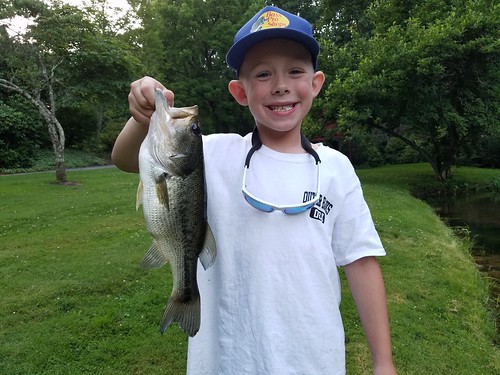
Photo courtesy of Joe Eccleston
Over on the far eastern side of the state at the Ocean City area, a wide range of summer species are providing good fishing. In the surf, those using shrimp, squid, bloodworms or sand fleas are catching a mix of croakers, kingfish, small black drum and flounder in the surf. Fishing with finger mullet will entice small bluefish and larger cut baits will catch a variety of inshore sharks which provide some fun catch and release action.
At the inlet and Route 50 Bridge area, flounder and sheepshead are being caught during the day. The flounder are caught on squid or minnow baits or by working jigs with Gulp baits along the bottom. The sheepshead and a few triggerfish are being caught on sand fleas along the jetties and bridge piers. In the evenings a few striped bass are being caught by jigging with bucktails and swimshads or by drifting cut baits or live eels, a few bluefish are also in the mix.
The channels in the back bays are holding flounder and when the water is clear the catches have been good. White Gulp baits are catching some of the larger flounder but the old standby of minnows and squid are hard to beat. A few sea trout, small bluefish and puppy drum help round out the mix. Flounder are also being caught on some of the shoals areas within a mile of the beaches.
The boats heading out to the wreck and reef sites are experiencing good fishing for sea bass for their patrons. Clams have been the preferred bait and flounder can also be part of the mix when jigs or flounder rigs are used.
The boats that are trolling along some of the 30 Fathom spots are finding yellowfin and bluefin tuna. The Hot Dog and the Sausages have been two of the more popular spots lately. Farther offshore a mix of yellowfin tuna in the 50 pound size range along with bigeye tuna and bluefin tuna are being found. White marlin, dolphin and the occasional wahoo help round out the mix. Green machines, rigged ballyhoo and spreader bars have been the formula for success.
"The most indispensable item in any fisherman's equipment is his hat. This ancient relic, with its battered crown and well-frayed band, preserves not only the memory of every trout he caught, but also the smell." - Corey Ford 1952
|  Date : 6/28/2017 (1) Date : 6/28/2017 (1)
| | 6/28/2017 | For many it seems hard to believe that the 4th of July holiday is upon us, for others it probably seemed like it would never get here. One thing is for certain, the kids are out of school and ready to have some vacation adventures with their parents or smaller outings which are often more cherished and meaningful. The important thing is to enjoy time together with family and few things offer better one on one time together than fishing. Plum Holton got to spend some time fishing with her dad out on the bay and they both shared in the excitement of her catching her first striped bass. Congratulations to Plum on a great catch!

Photo courtesy of Greg Jenkins
Striped bass fishing in the lower Susquehanna River and the flats area are moving towards a summer mode of fishing as water temperatures warm. The Conowingo Dam is releasing large amounts of water for power generation in the mornings and into late afternoons which helps cool water temperatures in the river and creates faster flows in the river. Those casting with surf rods into the dam pool with weighted swim shads are catching some nice striped bass. The best fishing for striped bass has been at day break and it usually only lasts till the sun clears the horizon. Topwater lures have been a favorite around the flats edges and in the river.
It is becoming the best of times for upper bay fishermen as more striped bass tend to be moving into the upper bay this week. Chumming has been very popular at Swan Point, Love Point, the Triple Buoys and Podickory Point. There are a lot of two and three year old striped bass being attracted to the chum slicks but there are good numbers of larger fish deep and back in the slicks. Trolling is a good option and often accounts for a better grade of fish. Richard Hoenes got to go fishing with his dad on Saturday and despite windy conditions they had a great time chumming at Love Point. Richard proudly holds up a nice 31" striped bass he caught.
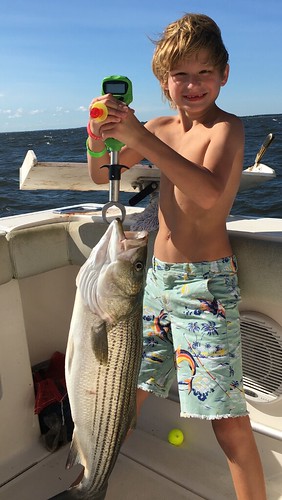
Photo courtesy of Richard Hoenes, Jr.
Working the channel edges around 35' deep with a variety of bucktails dressed with shads or twister tails, swim shads and surge tube lures in tandem or behind umbrella rigs are admission to the show. Inline weights or planers are needed to get down to the fish where they are suspended on the steeper edges.
At the Bay Bridge piers and rock piles there are striped bass and large white perch holding and waiting for someone to drop soft plastic jigs to them. A good running current is needed and heavy enough jigs to get to where the fish are holding. Jigging there has been excellent for the past few days and with a little luck the fish will hold there through the weekend. Eighty two year old Jerry Fischer and his son enjoyed some fun jigging action at the bridge piers yesterday and each caught a nice pair of striped bass.
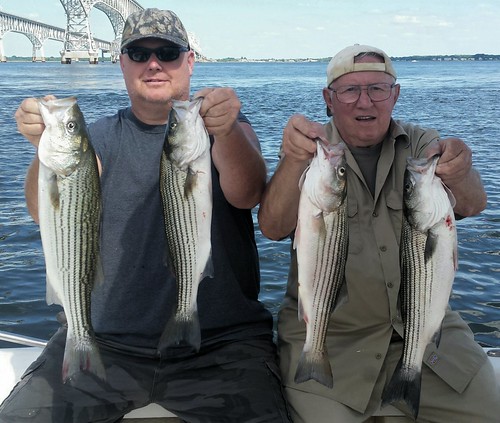
Photo courtesy of Rich Watts
Below the Bay Bridge striped bass fishing has been very good on the outside edge of Hackett's Bar for those chumming, jigging or trolling. Chumming has been the most popular way to fish and a large portion of the fish being caught are over 28" in length. As painful as it might seem, more than a few reported that they had to toss several striped bass back into the bay that went 30" or better while trying to catch a fish less than 28" to finish out their daily limit.
Breaking fish are being reported along the western and eastern edges of the shipping channel and also near anchored ships in the middle bay region. The surface action tends to be 2 and 3 year old striped bass with larger fish holding deeper so jigging deep is the way to go unless you fish light with poppers and enjoy the entertainment. As most know though you can't always count on things when it comes to fishing and some are surprised to find 30" striped bass mixing it up on top and smashing poppers. Watching depth finders as one slowly motors along channel edges or watching for slicks which indicate fish holding deep and on bait can be a good tactic. There have not been many bluefish in the middle bay region, so sea gulls sitting in groups is also a good sign to indicate periodic action in the area. Emily Arnold is all smiles with this nice striped bass she caught while fishing with her dad near Hackett's Bar.

Photo courtesy of Philip Arnold
Shallow water fishing for striped bass with poppers in the lower sections of the region's tidal rivers remains good this week but it is quickly becoming a dawn and dusk window of opportunity as water temperatures creep into the 80's this week. Eastern Bay, Poplar Island and the lower regions of the Severn, Choptank and Little Choptank have been offering some of the best action. Grass has been growing well this season so topwater lures have been the best way to fish to stay above the grass. Various poppers and Zara Spooks have been two of the most productive topwater lures.
Fishing for white perch continues to be a fun summer time activity in the tidal rivers and creeks in the middle bay region. Except for early mornings and late evenings when they might venture close to shoreline structure the perch have been holding in deeper waters over oyster bottom or near piers. Grass shrimp is perhaps one of the best baits to use but requires an investment in a shrimp dip net and time to catch your own bait. Pieces of bloodworms will fit the bill for those that wish to purchase bait. A simple one hook bottom rig that puts the hook about a foot off the bottom is near perfect presentation. A shad dart tipped with bait and worked close to the bottom is also an excellent option. The Kent Narrows, Matapeake Fishing Pier and the Bill Burton Fishing Pier are just three public areas that offers a great place to fish for white perch for shore bound anglers. This nice white perch was caught near the Bay Bridge rock piles.

Photo courtesy of Rich Watts
Lower bay region fishing for striped bass has been focused on chumming, trolling, jigging and casting to fish near shallow structure. Chumming has been the most popular and areas like the Middle Grounds, the channel edge from the HS Buoy south to Buoy 72, Cove Point and Point No Point as well as the steep channel edge near St. George's Island on the lower Potomac. Bluefish are part of the mix and hopefully cobia will start to move in soon.
Trolling along channel edges with a mix of swim shads, bucktails and surge tube lures down deep with inline weights or planers has been a good way to catch a nice grade of striped bass, The lower bay region has a lot of two and three year old striped bass that miss the 20" mark so throwbacks are common at times.
When suspended fish or breaking fish can be found or even slicks; jigging deep is a good way to find larger striped bass. Bay anchovies are being pounded by a mix of striped bass and bluefish in the region, often along channel edges with stiff currents. Soft plastics tend to be the most popular jigs to use in chartreuse, pink and sparkle pearl. The mouth of the Patuxent and the St. Mary's River continue to hold a lot of action for striped bass and bluefish, with a lot of throwbacks.
On the eastern side of the bay, the marsh edges and tidal creeks continue to be great places to find speckled trout and striped bass with bluefish also being part of the mix. Casting topwater poppers has been productive and popping corks with a white Gulp Mullet trailing has also been a great option. Drifting peeler crab or soft crab in the ebbing currents of the tidal creeks is also a great way to catch speckled trout and striped bass. Once again though many of the striped bass fail to meet the 20" minimum.
There are some croakers and spot being caught on both sides of the bay and plenty of white perch in all of the tidal creeks and rivers. Those that target them are catching flounder along hard-bottom channel edges in the Tangier and Pocomoke Sound areas.
Recreational crabbers continue to find crabs in a wide variety of water depths. Some have had the best luck in 10' to 15' of water and others report they are doing the best in shallower waters. Regardless of your preference for water depth, there is little room for discussion that razor clams are the top catching bait and early morning crabbing offers the best catches. This will be a very busy weekend for those who have promised crabs for the 4th of July holiday; please be patient and tolerant of those who cross you, for they know not what they do.
This will be a bit of a crazy weekend to try and fish at Deep Creek Lake due to holiday and vacation boat traffic so if you do go out; try to go very early and be careful out there. Smallmouth bass should be found on rocky flats in 6' of water or more and swimbaits and jerkbaits are good baits to target them. Floating docks are a great place to cast for largemouth and smallmouth bass if no one is bouncing on the dock, again it will be a busy time at the lake. There might be some refuge in the shallower coves where largemouth bass, chain pickerel and bluegills can be targeted.
John Mullican was kind enough to send us a great report from the upper Potomac and a few fishing suggestions. The upper Potomac River is in good shape and fishing well. Fishermen are finding lots of eager smallmouth bass, walleye, and catfish. Bass can be taken on a variety of lures, but I always have a topwater tied on to one rod and a tube or similar jig on another. Weightless soft plastic minnow baits or wacky rigged stick worms will catch plenty of fish too. River temperatures are near 80°F so fish are generally in or near grass beds, boulders, and ledges with good current flow. The larger tributaries to the Potomac are also great places to take a kayak or canoe float trip. Small tubes and crankbaits will catch a mixed bag of smallmouth, sunfish, and rock bass, even a channel catfish now and then.
Largemouth bass are slipping into a summer mode of behavior as water temperatures and hot sun govern their activities. Targeting shallow grass and brushy edges with topwater lures in the early morning hours or late evening hours is the name of the game now. During brighter sun, targeting grass with whacky rigged stick worms down into the grass is the next option. Flipping a variety of soft plastics under the shade of docks, fallen treetops or overhanging brush is a sure fire way to entice a lounging bass to pick up an easy meal. When fishing tidal rivers and creeks, try and schedule your trips on a falling tide during those early morning or late evening hours.
There are plenty of channel catfish in the tidal rivers and creeks of the bay and the upper Potomac. The warmer weather definitely lends itself to a lazy shaded spot along a shoreline with a comfortable chair and good company. The tidal Potomac is home to hordes of blue catfish and they are not hard to catch and the smaller ones make excellent table fare and the really large ones will just about pull your arms out of their sockets. This little guy seems that he could care less about getting slimed by this 20 lb. plus blue catfish and more focused on having a ball fishing with his dad.
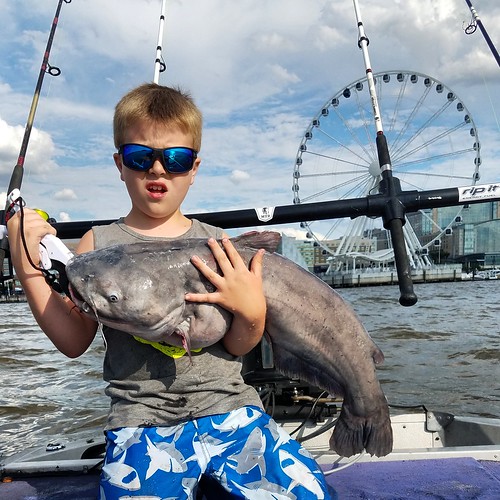
Photo courtesy of Sean Allen, Sr.
Despite warm summer temperatures there continues to be some amazing trout fishing opportunities in the western region's trout management waters. They continue to run cold enough to make for excellent trout fishing. Many are selected to be catch and release of have tackle limitations which help insure that there are plenty of trout available for those who wish to enjoy either catch and release trout fishing or fly fishing. These areas are also a great place to beat the summer heat.
In and around the Ocean City area water temperatures close to shore are about 68 degrees this week and if the weather holds, fishing should be good. It will be a busy weekend for sure as thousands of tourists descend upon the Ocean City area. If you are contemplating fishing at the inlet there will be a lot of boat traffic and if you're going to fish for flounder in the back bay channels such as the East, West or Thorofare channels it can be downright dangerous, so be careful out there.
Surf anglers are catching a few bluefish on finger mullet rigs, cut baits will draw in inshore sharks and a few striped bass. Smaller baits of squid or clam will catch a mix of blowfish, small black drum and flounder. So far we have not heard of any reports of kingfish in the surf but they should be here by now.
At the inlet and the Route 50 Bridge area, flounder can be caught on squid or minnows as well as jigs with Gulp white mullet baits. Sheepshead and small black drum are hanging out around the South Jetty and bridge piers and can be caught on sand fleas. Bluefish and striped bass often move through the area at night and can be caught by drifting cut bait, live eels or by casting swimbaits, bucktails or Got-Cha lures.
Flounder are in the back bay channels and also off the beaches at shoal areas. Drifting with squid and or minnow baits work well and larger baits such as Gulp baits work well on the larger flounder. Small sea bass and blowfish can be pesky at times when fishing with squid but tend to keep our younger anglers happy.
The boats heading out to the wreck and reef sites are finding good sea bass fishing for their anglers and there is a healthy mix of flounder to add to catches. Farther offshore there has been a good yellowfin and bluefin tuna bite at times at some of the 30 Fathom spots like the Hot Dog. Peyton Emerson scored big time with this beautiful 130 pound bluefin tuna he caught at the Hot Dog last weekend.

Photo courtesy of Peyton Emerson
The boats and crew that continue on to the canyons have been finding yellowfin tuna with a mix of sizes. Some are 40 pounds or better, but in many cases, they fail to meet the minimum size. Those trolling are also being rewarded with a mix of bluefin tuna, bigeye tuna, dolphin and a few mako sharks. Several white marlin have been caught and released and at least one blue marlin in the past few days.
"With the exception of painting, nothing in this life has held my interest as much as fishing. Fishing with a fly, bait, a handline; I don't care. Fishing, in my estimation, is not a hobby, a diversion, a pastime, a sport, an interest, a challenge or an escape. It is a necessary passion." - Russell Chatham
|  Date : 6/21/2017 (1) Date : 6/21/2017 (1)
| | 6/21/2017 | As we all know last Sunday was Father's Day and sons and daughters made every effort to be with dad and to share in some time together. Dads usually get to pick what they wish to do on Father's Day and when they team up with their sons and daughters it is a heartwarming sight to see. To the dads out there I hope you were able to spend time fishing and either reliving memories of being together or creating ones that will last through time. Matt and Morgan Jenkins got to go out fishing with their dad on Sunday and I'm sure there will be many more to come and they will remember this day and the fish their dad caught.

Photo courtesy of Greg Jenkins
Up at the lower Susquehanna River the Conowingo Dam has been releasing water in above average proportions during the afternoon and evening hours, most likely for power generation. Flows through the dam are minimal during the early morning hours which is a very good time to cast topwater lures and swim shads in the dam pool for striped bass. Striped bass are also being caught in the river and at the mouth of the river in the early morning hours on topwater lures such as poppers and Zara Spooks. There are some throwbacks involved but most are reporting a very nice grade of striped bass in the area. Channel catfish are common in the river and nearby channels as are flathead catfish. Largemouth bass can be found in the grass on the flats. Tony Veres very happy that he made the effort to get out early to fish the lower Susquehanna; these two fine striped bass were his reward.
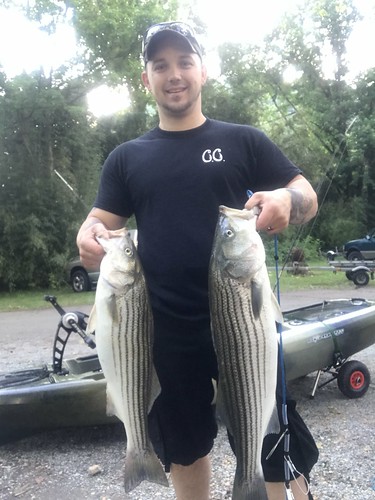
Photo courtesy of Tony Veres
The upper bay region is providing some good fishing for striped bass this week and it continues to improve in noticeable strides as more fish from the middle bay region move into the region. This has the earmarks of last year's pattern and if it holds true there is going to be some good striped bass fishing this summer in the upper bay. Chumming has been very good at Swan Point, Love Point and Podickory Point channel edges. There are a lot of two and three old fish in the region and tend to swarm through chum slicks with larger fish often holding close to the bottom and at the tail end of chum slicks.
Trolling with medium sized bucktails dressed with twister tails, Storm type swim shads and surge tube lures (hoses) in tandem or behind umbrella rigs have also been a good way to score on a nice grade of striped bass over 20 inches in length. Inline weights are needed for umbrella rigs and there is the option of using planers for single or tandem rigged lures. There are breaking fish being spotted throughout the region, usually on a good running tide. Most often these are smaller fish but often larger striped bass can be found underneath them close to the bottom by jigging or trolling deep. Soft plastic jigs in chartreuse, pink and pearl seem to be favorite colors.
Down at the Bay Bridge piers and the sewer pipe there has been some successful jigging to suspended fish at times on a good running tide. Some boats have also been anchoring up and chumming to the structure with good results.
Fishing for white perch has been excellent in the tidal rivers of the upper bay and especially the lower Patapsco River/Middle River complex. The perch tend to hold in about 15 feet of water during the day, tight to structure such as bridge piers, old piers, rocks and hard bottom. Bloodworms and peeler crab tend to be the best baits when fishing with a bottom rig. Shad darts tipped with a piece of bait will also get the job done. These same areas are also teeming with channel catfish that can be caught on bottom rigs baited with cut fish bait, chicken livers or nightcrawlers.
Fishing for striped bass in the middle bay region is good this week but many are reporting it has lost some of the luster it held last week as striped bass seem to be moving into the upper bay region. Chumming is still good this week along the 35 foot outer edge of Hackett's Bar but has dropped a notch from last week. Thomas Point has also been offering some chumming action as does anywhere suspended fish can be spotted on depth finders. A lot of two and three year old fish are a major portion of the fish being seen but enough larger fish over 20 inches are being caught. Trolling a mix of bucktails, swim shads and surge tube lures (hoses) has been a good way to catch striped bass this week along channel edges in about 35 feet of water. Most often the fish are suspended close to the bottom, so inline weights or planers are needed to get lures down to where the fish are.
Jigging is still a good option when suspended fish can be found on depth finders along channel edges on both sides of the bay. The western shipping channel edge from Thomas Point south past Chesapeake Beach continues to provide action as does the channel edges off Kent Island and inside Eastern Bay. Water temperatures in the middle bay region are about 77 degrees in the bay and a bit warmer in the tidal rivers. Early morning or late evening shallow water fishing with topwater lures in the tidal rivers and Poplar Island rocky shoreline continue to provide exciting fishing. Chase Savage holds up a beautiful striped bass he caught while jigging in the middle bay region recently.

Photo courtesy of Travis Long
Shore bound anglers have been enjoying some striped bass fishing at the Kent Narrows in the evenings when boat traffic subsides and at sun up. Most are casting bucktails and soft plastic jigs up current at an angle and bouncing them along on a tight line. Prominent points and piers can be good places to fish with topwater or crankbait type lures. Those with small boats continue to work favorite spots in the tidal rivers for striped bass. There tends to be a fair proportion of small fish as it is most places but offers fun fishing and enough fish over 20 inches to keep everyone happy.
Fishing for white perch continues to be very good in the middle bay tidal rivers. Fishing off docks or bulkheads with a simple one hook bottom rig and just enough weight to get your offering down to where the perch are, tight to structure. Grass shrimp is one of the best baits and in most areas you can easily catch them. Bloodworms are good but of course will cost you. Shad darts and small jigs worked deep are a good tactic and even better when tipped with a piece of bloodworm or a grass shrimp.
The lower bay region has a lot of exciting fishing opportunities this week and more fish are moving in from the south. A mix of striped bass, bluefish, speckled trout, flounder, croakers and spot are being caught this week and the cobia and Spanish mackerel are on the way.
There has been good chumming for a mix of striped bass and bluefish at the Middle Grounds north to the HS Buoy were fish can be found suspended along channel edges. There is also good chumming in the lower Potomac near Tall Timbers and St. Clements Island. These same areas offer opportunities for jigging and trolling. Soft plastics tend to be a favorite choice for jigging when suspended fish can be located. Those trolling are using a mix of bucktails, swim shads and surge tube lures behind inline weights and planers. St. Mary's River has been a good place to jig or cast topwater lures. There continues to be fun striped bass fishing around the mouth of the Patuxent and up the river. Most will agree there are a lot of fish less than 20 inches but the action whether casting topwater or jigs is lots of fun. The western edge of the shipping channel near Cove Point has also been holding some larger striped bass.
There have been a few reports of the first cobia and Spanish mackerel showing up in the region and hopefully more will continue to fill in the coming weeks. The cobia were showing up in chum slicks at the Middle grounds and the Spanish have been mixing it up with the striped bass and bluefish as they chase bay anchovies in the region.
Over on the eastern side of the bay a mix of striped bass and speckled trout are being caught from Hooper's Island south to Pocomoke Sound near creek channels and marsh edges on topwater lures, Gulp Mullet baits and by drifting soft crab or peeler crab baits. Flounder are being found near some of the hard channel edges in Tangier and Pocomoke Sounds. Croaker and spot are now becoming more common for those bottom fishing, white perch, small bluefish and kingfish round out the mix. Croaker, spot and speckled trout are also being caught on the western side of the bay near the Point Lookout area and blue catfish up the Potomac.
Many of the recreational and commercial crabbers I spoke to this week mentioned that they felt crabbing has slacked off this past week and that crabs seem to have moved towards the mouths of creeks and deeper water. Razor clams are still the hottest ticket in town for trot lining or traps but chicken necks will still catch. As is usually the case some areas produce better than others and at times you manage to make the right moves and get in on a nice mess of crabs. Jim Livingston casts a glance and a smile after catching this nice bushel of crabs by baiting his collapsible traps with razor clams in the middle bay region.
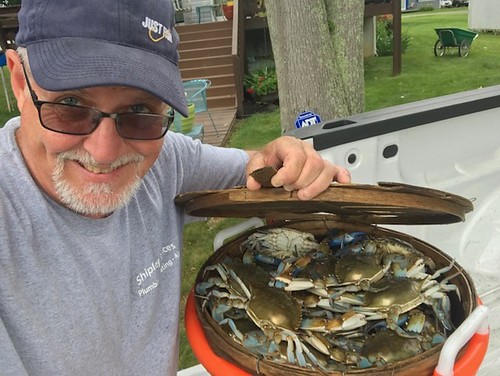
Photo courtesy of Jim Livingston
Freshwater fishing in the western region has been very good this week on several fronts. The upper Potomac River is in fine shape with clear water and higher flows making for some excellent smallmouth bass fishing. Water temperatures are about 76 degrees and tubes tend to be the most popular bait near current breaks and submerged ledges. At Deep Creek Lake there has been good fishing for smallmouth and largemouth bass near floating docks and fallen tree tops. Large yellow perch and walleye can be found deep along grass edges by drifting minnows and trout are being caught deep by trolling along the dam face.
The tidal Potomac has been offering some fine largemouth bass fishing lately and now that the FLW Tournament is over, there will be plenty of elbow room at fishing locations and boat ramps. Targeting grass tends to be the number one tactic with topwater lures or dropping stick worms down through the grass. Fishing on a falling tide early in the morning or late evening is often a great combination for success. Back in that same grass, northern snakeheads can be found lurking waiting to ambush any noisy chatterbait, buzzbait or plastic frog that might come their way. The northern snakehead can also be found over on the lower Eastern Shore Rivers from the Choptank south, and soon to a tidal river near you, if their range continues to expand as in past years. The Nanticoke, Pocomoke and Wicomico Rivers have been offering good largemouth bass fishing on falling tides and as water temperatures steadily climb, early morning hours are becoming the best time to fish. Not to be left out, the Susquehanna Flats have always offered good largemouth bass fishing in the thick grass that grows there.
For those of you who missed the brief mention in last week's report, we now have a new state record white catfish from tidal waters which has been discussed recently in the Maryland angling community. Jacob Vosburgh of Lexington Park was fishing recently in the lower Potomac River for catfish and did he ever catch a notable white catfish. Jacob was fishing with bloodworms when he landed an 8.27 lb. white catfish which has been established as the new Maryland state record in the Chesapeake Bay (Tidal) Division.
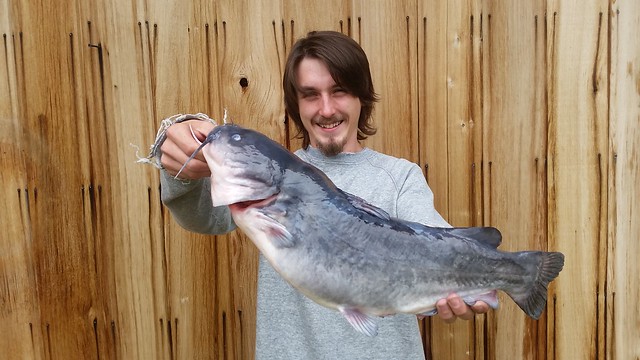
Photo courtesy of Jacob Vosburgh
Other species of freshwater fish such as bluegills, crappie and chain pickerel inhabit most ponds and lakes as well as the upper reaches of the tidal rivers. They can offer plenty of fun angling for all ages, whether one is using a spinning tackle of a fly rod. Channel catfish abound in most tidal rivers and selected reservoirs like Piney Run Reservoir in Carroll County.
Over at Ocean City the summer species are steadily moving in and fishing is hopping. In the surf there is a mix of bluefish, striped bass, flounder and blowfish. The bluefish are being caught on finger mullet rigs, the striped bass on cut bait and flounder and blowfish on squid. Inshore sharks are beginning to be caught on cut bait rigs meant for striped bass so be careful when releasing them since most are protected.
At the inlet and Route 50 Bridge area there are flounder and sheepshead being caught. The flounder are being caught on bait rigs or by working white Gulp mullet baits, the sheepshead are being caught on sand fleas. At night when boat traffic calms down bluefish and striped bass are being caught by casting bucktails or Got-Cha lures or by drifting cut bait or live eels. In the back bay channels flounder fishing has been good when water clarity is also good, there is also a few weakfish and red drum being caught.
Out at the wreck and reef sites, fishing for sea bass has been good and flounder and triggerfish are becoming a more common part of the mix. This angler is certainly happy that she booked on one of Ocean City's head boats to do a little sea bass fishing.
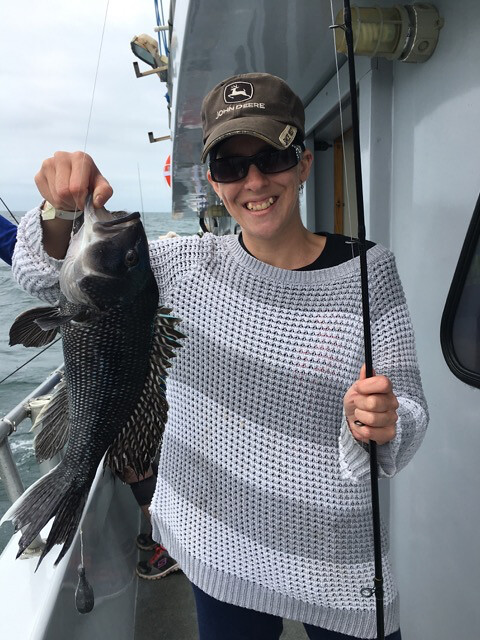
Photo courtesy of Monty Hawkins
The boats heading out to the canyons are having some exciting fishing and the action should only get better as water temperatures climb. The first white marlin was caught last week and then a second one shortly after. There has been a run of bluefin tuna ranging from 50 lbs. to giants and they have been providing some great fishing opportunities. Bigeye tuna and also yellowfin tuna are also being caught and with a mix like that, anglers must be careful in being able to tell the difference from a bigeye and bluefin tuna. Gaffer sized dolphin have been part of the trolling mix. Those stopping for some deep drop fishing have been bringing tilefish back to the docks and mako sharks are being caught from the 30 Fathom Line out to the canyons.
"So if escapism is a reason for angling-then the escape is to reality. The sense of freedom that we enjoy in the outdoors is, after all, a normal reaction to a more rational environment." - A. J. McClane
|  Date : 6/14/2017 (1) Date : 6/14/2017 (1)
| | 6/14/2017 | Despite increased water releases at the Conowingo Dam in the past week, water temperatures in the lower river area are climbing into the mid 70's this week. Fishing for channel catfish and flathead catfish near the dam pool and the lower river has been very good. There are striped bass being caught in the river but most are in the sub-legal size range. The best success for larger fish has been at the dam pool and the channel edges around the flats in the early morning and late evening hours. Casting topwater lures has been the best way to target these areas, especially along the edges of the flats. Dave Andrews shows what kind of reward can come your way when you get out on the water before sunrise and fish topwater lures. This beautiful 42 inch beast of a striped bass was caught before sunrise this past Sunday morning.
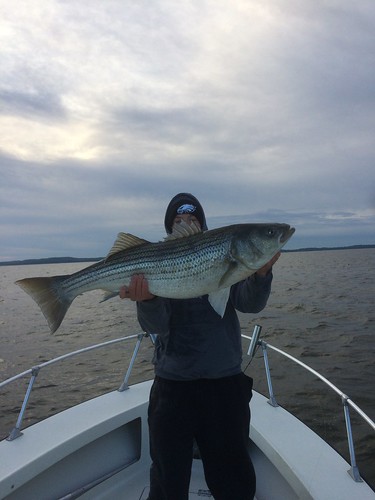
Photo courtesy of Dave Andrews
In the upper bay region most of the striped bass fishing action is taking place at Swan, Love and Podickory Points as well as the Muds where boats are anchoring up and chumming. The throwback ratio can be high at times with two and three year old striped bass dominating the chum slicks. Larger fish are present and often come from the back of the chum slick close to the bottom, as always a good tide is important. Trolling is a good option and usually offers a better grade of fish. Chartreuse bucktails and sassy shads have been a favorite as have surge tube lures. All are pulled behind inline weights to get them down to where the fish are suspended deep along channel edges. Jigging is another option, especially when suspended fish can be found near structure such as channel edges, the sewer pipe above the Bay Bridge or the Bay Bridge piers and rock piles.
Fishing for white perch in the upper bay has been very good in the region's tidal rivers and creeks. The lower Patapsco River and surrounding creeks have been a very popular to fish for white perch lately. Casting small jigs, spinnerbaits, spinners or fishing with bait have been producing nice catches of large perch. Channel catfish are also widespread in the upper bay region and can provide a lot of fun bottom fishing. Michael Remmell holds a very nice white perch.
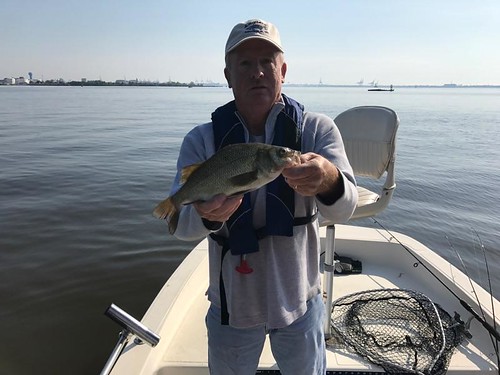
Photo courtesy of Michael Remmell
The striped bass fishing action has been good in the middle bay region along the main channel edges of the bay and several tidal rivers. Striped bass in the 2 and 3 year old age group tend to be very common when breaking fish are encountered or lured to chum slicks. There continues to be good chumming at the outside 30' edge of Hackett's Bar. Most are able to catch some impressive fish in the mid-20 inch class. Locations such as the Hill, the Diamonds and basically anywhere one can find fish suspended along channel edges can be good places to set up chum slicks. The channel edges of Tolly Bar and Gum Thickets are a couple other spots worth investigating.
Breaking fish are being seen from at times along steep channel edges where bait in the form of bay anchovies tends to be swept in the accelerated currents. Topwater lures are a fun way to fish but most are finding smaller striped bass on the surface and larger ones deeper with jigs. Soft plastic jigs seem to be the favorite choice in chartreuse, pearl and pink. Trolling is certainly a viable option in these same areas. Medium sized bucktails dressed with twistertails, spoons and surge tube lures behind inline weights or planers have been popular. Deep diving crankbaits will also work well but usually require a slower trolling speed.
Water temperatures are about 75° on the main part of the bay and slightly warmer in the tidal rivers. The shallow water fishery for striped bass has been very good this week but requires being ready to fish before sunrise or late in the evening. Poplar Island is a great place to fish topwater lures as is most of the larger tidal rivers in the region and Eastern Bay.
Fishing for white perch in the tidal rivers has been excellent this season with a greater number of larger white perch than we've seen in quite a while. Bottom fishing with bloodworms, peeler crab or grass shrimp is a great way to catch them around deep structure. Casting small spoons, spinners and jigs around shallower structure is also a great way to catch them in the mornings and evenings.
The lower bay region has plenty of fishing action this week. The size structure of the striped bass is very similar to the other regions of the bay; a lot of 2 and 3 year old striped bass with 4 and 5 year old fish mixed in. Breaking fish are being seen throughout the region with small striped bass and bluefish mixed it up on the surface and larger striped bass lurking in the depths. The channel edges where the current moves along at a good clip is a good place to look for bait being balled up. Jigging with soft plastics has been good when suspended fish can be found under breaking fish or holding near structure. Trolling is another good option and the steep channel edges in the lower Potomac near St. Georges Island of the shipping channel edges in the bay are good places to troll. A mix of bucktails, spoons and surge tube lures are working well behind inline weights or planers.
Chumming is another option and Buoys 70 and 72A, the Middle Grounds and Point No Point have been popular places to chum. A mix of striped bass and bluefish are being attracted to the chum slicks. Also anywhere fish can be spotted suspended near the bottom can offer a good chumming location.
The shallow water striped bass fishery has been fun for those casting topwater lures or swim shads in the lower Patuxent River, the St. Mary's River and the Eastern Shore creeks and tidal marshes. On the eastern side of the bay from Hooper's Island south to Pocomoke Sound there is excellent fishing for speckled trout. They are being caught in creek mouths on a falling tide by drifting soft crab or peeler crab baits or by casting Gulp swim shads or topwater lures along marsh edges. White perch fishing on both sides of the bay has been excellent in the tidal rivers and creeks. A few croakers are being caught at various traditional locations and flounder are being caught along channel edges in Tangier and Pocomoke Sounds.
Before we get into the crabbing, freshwater, and ocean reports, I wanted to mention a new state record white catfish in the Chesapeake Bay category (tidal waters) that was caught in the lower Potomac River, at the mouth of St. Clements Bay. Jacob Vosburgh, 20, of Lexington Park, caught the fish, recorded at 8.27 pounds, on June 1. The white catfish was 23 inches in length. Jacob was using bloodworms as bait with a "Carolina" style sliding-sinker rig. This rig is also known as a "fishfinder rig" or "sliding egg sinker rig" depending on the region where you are fishing. The "Carolina Rig" was originally developed by largemouth bass fisherman for use with plastic baits, but in this case, it was fished with a natural worm bait. Congratulations to Jacob on this great catch!
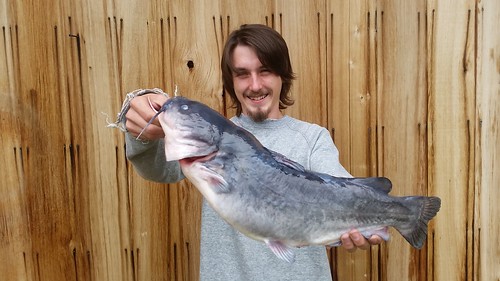
Photo courtesy of Branson Williams, Maryland Department of Natural Resources-Fishing and Boating Services
Recreational crabbing has been excellent in the middle and lower bay tidal creeks this week and fair to good in the upper bay. Razor clams continue to be the bait of choice for the best catches. Light crabs are now part of the mix so culling through your catch is a good idea.
Freshwater fishing at Deep Creek Lake has been good for smallmouth and largemouth bass near floating docks and shoreline structure. Tubes, stick worms and crankbaits have been good baits to use. Yellow perch and walleye are holding along deep grass edges and drifting minnows is a good way to target them. Trout can be found deep near the dam face and northern pike at cove entrances.
The upper Potomac River is in fine shape this week for smallmouth bass fishing. Casting tubes near current breaks, submerged ledges and large in current boulders is a good tactic. The premier trout management waters of the western region are providing good to excellent trout fishing this week. Broadford Lake received a stocking of 600 eight inch hybrid striped bass last month adding to the existing population that exists there, offering some excellent fishing opportunities.
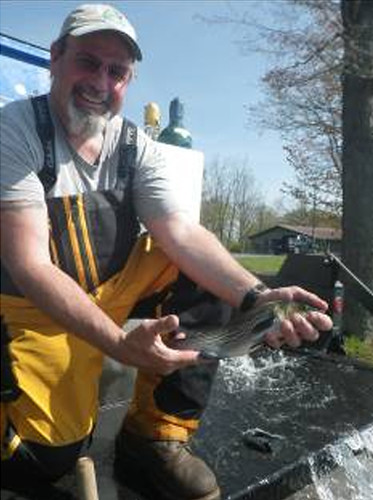
Photo courtesy of Maryland Department of Natural Resources-Fishing and Boating Services
Rocky Gorge Reservoir in the central region recently received stockings of striped bass and walleye fingerlings along with slightly larger sized tiger muskies. The Baltimore County Reservoirs are providing excellent fishing opportunities this week as largemouth bass in particular in a very active feeding mode of behavior. Water temperatures are still relatively cool so the bass are active most of the day but will be looking for shade during the sunniest part of the day.
The tidal Potomac River is fishing well this week as water clarity improves. Targeting the shallower areas early in the morning with topwater lures has been providing plenty of action from largemouth bass and northern snakeheads. The hatchery crews recently stocked approximately 260,000 largemouth bass fingerlings in the creeks and rivers that feed into the tidal Potomac. The tidal Potomac is of course home to more blue catfish than anyone could ever count and provide fun bottom fishing and excellent table fare.
The tidal rivers of the lower Eastern Shore are providing good fishing for largemouth bass this week and northern snakeheads are also part of the mix. Northern snakeheads are very common in the Blackwater area, the upper Little Choptank, Nanticoke, and Wicomico Rivers. Chatterbaits and buzzbaits tend to drive them to abandon and are an exciting way to catch them.
Over on the coastal side of Maryland everyone whether fishing the back bay areas or the canyons is getting a much needed reprieve from the wind this week. Water clarity is improving in the back bays and near the inlet making for better flounder fishing, large baits continue to account for the largest flounder in the channel areas and reduced boat traffic makes for more enjoyable fishing. At the inlet flounder and sheepshead round out the day action and bluefish, weakfish and striped bass fill in the evening and night. The sheepshead are showing up along the jetties and bulkheads and sand fleas are the preferred bait. Striped bass, weakfish and bluefish are being caught on bucktails, swim shads, Got-Cha lures and by drifting cut bait. Ryan Bodley holds up a nice pair of flounder he caught recently.
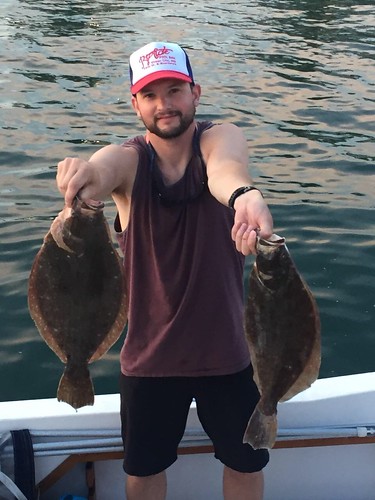
Photo courtesy of Ryan Bodley
Surf anglers continue to fish finger mullet rigs for bluefish and cut menhaden for striped bass. The expected surge of large striped bass migrating north has been a bit disappointing so far with only a few large fish caught. Those fishing smaller baits are catching flounder, blowfish and small black drum.
Sea bass fishing has been good to excellent on most days and flounder are now becoming more common in the mix. The boats headed out to the canyons are seeing a wide variety of fish this week. There has been a surge of Bluefin tuna varying from football size to giants. Bigeye tuna are part of the mix and a few yellowfin tuna are being caught. Gaffer size dolphin have also been plentiful at times. Mako sharks are being caught by those that target them at the 30 Fathom Line or out at the canyons.
"All things are connected. Whatever befalls the earth befalls the children of the earth." - Chief Seattle
|  Date : 6/7/2017 (1) Date : 6/7/2017 (1)
| | 6/7/2017 |
The weather forecast looks very promising for this coming weekend and for those looking for some family fun with small children there could hardly be anything better than participating in one of Maryland's free fishing days on Saturday, June 10, or going to one of the children's fishing events also being held this Saturday. There are four youth fishing events spread out across the state near Baltimore, Deer Creek, Hagerstown and Cumberland. Check out your little fisherman's youth fishing outfit, find some garden worms and head out to one of these fun events. There are additional youth fishing events scheduled, check out the fishing rodeo schedule to see what is coming up near you.
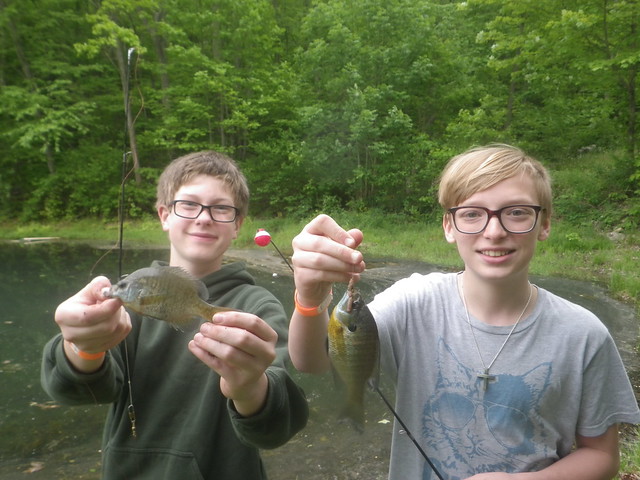
Photo courtesy of Alan Klotz
Those fishing in the upper reaches of the bay near the Susquehanna Flats and the lower Susquehanna have been enjoying good fishing for striped bass. The best fishing has been early in the mornings with topwater lures and to a lesser degree in the evenings. Some have been having luck in the rivers with soft plastic jigs and swimbaits. There are still plenty of white perch in the river that can be caught on small jigs or shad darts. Channel catfish are plentiful as are flatheads near the dam pool and lower river channel. Stephanie Infield holds up a big Susquehanna Flats area channel catfish caught while fishing for striped bass recently.
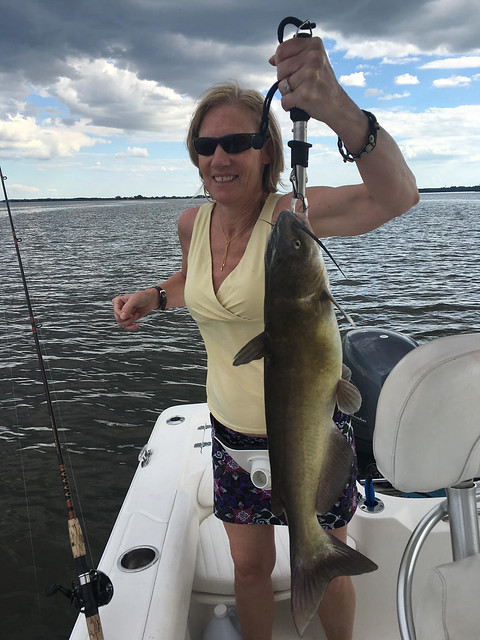
Photo courtesy of Ross Infield
A little farther down the bay drifting live eels near the deeper edges near Pooles and Hart Miller Islands where striped bass can be found suspended has been productive. The bridge piers of the Francis Scott Key Bridge have also been a good place to drift live eels. These same locations are also excellent places to find white perch. The charter fleet has been anchoring up at Swan Point as well as Love Point. There tends to be a lot of sub-legal striped bass in the chum slicks but enough legal-sized fish to make fishing worthwhile. Some of the better success in regard to larger striped bass has been occurring for those who allow their baits to drift to the back of the chum slick and rest on the bottom.
There has been some trolling action in the upper bay region but generally speaking the action is a slow pick at best. The channel edges in the neighborhood of 30' to 35' tend to be the best depth to target and the fish are holding close to the bottom so inline weights are required to get baits down to where the fish are. Umbrella rigs with a swim shad or a bucktail dressed with a twister tail make good trailers. Tandem rigged bucktails and swimshads as well as spoons are a good option also. There can always be some striped bass suspended near the Bay Bridge piers when a good current is running. Jigging tends to be the most popular way to work the bridge piers and those that keep at it and work the pier bases correctly more often than not can come up with a few nice fish. In recent seasons the plastic skirted jigs made by "Jigged Up Customs" and other similar local Maryland lure makers have been very popular and effective. The plastic skirts on these jigs are similar to the skirts on freshwater largemouth bass lures such as spinnerbaits and "jig and pigs", and the jig is tipped with a plastic trailer such as a BKD or Bass Assassin.
Below the Bay Bridge, the 30 foot outside edge of Hackett's Bar has been a popular and productive place to chum for striped bass this past week. Others have been having luck in the same general region trolling a mix of bucktails, swim shads and spoons. One thing of note is that there are a lot of striped bass in the 16" to 19" size range in the region and whether chumming, jigging or trolling they tend to abundant. Generally speaking this is a good thing since they represent the future, so handle them with care when releasing them. Breaking fish are being spotted at times and most anglers have learned the larger striped bass can often be found underneath the surface action. Light tackle jigging with soft plastic or metal jigs as well as spoons are a good bet and topwater lures always offer plenty of excitement on top. The channel edge of the shipping channel from Holland Point south to Chesapeake Beach has been a good place to look for striped bass on the western side of the bay. On the eastern side the mouth of Eastern Bay south to the mouth of the Little Choptank has been offering similar possibilities. Watching depth finders for suspended fish or keeping binoculars handy to spot breaking fish are tools of the trade. Andrew Malone holds up a nice 32" striped bass he caught while jigging off of Chesapeake Beach in 28' of water.
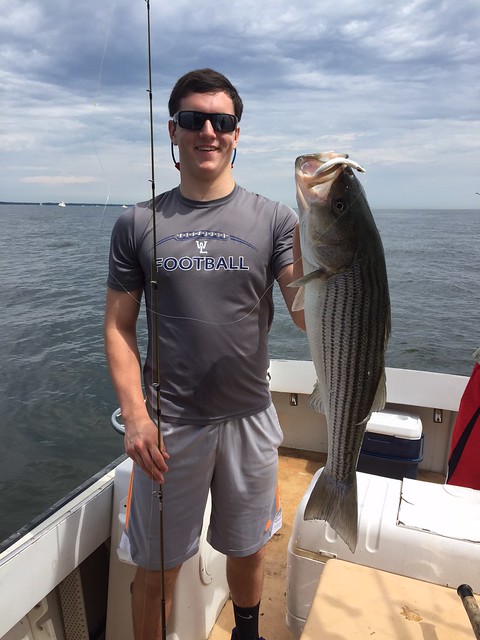
Photo courtesy of Andrew Malone
Water temperatures in the middle bay region are about 69 degrees this week and the salinity tends to be rather low. As we approach a full moon this Friday the annual may worm spawning ritual will be in high gear and as the spawning stage of our common clam worms swarm near the surface, striped bass and white perch will be gorging themselves on this easy feast. Anyone with a dock light will see them attracted to light often in huge masses.
The shallow water striped bass fishery continues to be good in the early morning and late evening hours near shoreline structure. Sunken breakwaters, prominent points and marsh edges are good places to cast topwater poppers. There tends to be so much grass and algae in these shallow areas that topwater lures are the best way to fish them. Sub-legal fish can dominate the catch at times but larger fish are out there also. White perch abound in the tidal rivers and creeks near piers, rocks and similar sunken structure both deep and shallow.
Black drum showed up at the Stone Rock area and Sharps Island Flats this past week and should stick around for a while. This fishery offers those who sign up, a major tussle with a bruiser of a fish in a knock down drag out fight. A baited hook with a portion of a soft crab attached with enough weight to get it down is dropped on them when they are spotted on a depth finder. Although not a common bait here in the Chesapeake, a shucked clam will receive the same response from a hungry black drum. This fishery is mostly a catch and release game for most but there is some good eating meat on them. Unfortunately there is a lot of waste due to the fact that they are often infested with flesh worms from the anus rearward. The meat above the ribs is a solid white meat that has a definitely different taste and texture than most fish. The scales are large and thick so the cuts must be made from within and out when filleting. Black drum have enameled pharyngeal plates about where our tonsils are that they use for grinding up clams and other shellfish. Take the time to extract them, they make a great trophy and conversational piece. The scales are so large that their growth rings are clearly visible and are a great thing to show children. The scales can also be used as guitar picks.
The lower bay region is offering some variety this week in the form of methods of fishing and species to target. Striped bass has been the main focus and small fleets of boats can be seen chumming at Buoys 70 and 72A, the Middle Grounds, Cove Point and Point No Point or anywhere fish can be spotted suspended along channel edges. There is a mix of striped bass of varying sizes along with 2 pound bluefish being attracted to the chum. There tends to be a lot of sub-legal striped bass in the region so the throwback ratio can be high at times.
Trolling deep with medium sized bucktails, swimshads and spoons along channel edges has been productive in the region and especially in the lower Potomac near St. Georges Island and Piney Point. There has been action from Cedar Point to Cove Point and north along the western edge of the shipping channel. Inline weights will be needed to get baits down to where the fish are and planers can be a good option also.
Jigging is a very good option this week when fish can be found suspended along channel edges in the bay or in the lower Potomac or Patuxent Rivers. Breaking fish are also part of the equation and jigging underneath can provide hook ups with larger striped bass. Casting to the surface fish with topwater lures or spoons is of course fun but the fish tend to be in the 16" to 19" size range. Medium size bluefish will also be part of the action.
Those that can get up early this time of the year are finding good shallow water striped bass action at places like Point Lookout, Cedar Point rocks, the lower Potomac, Patuxent and anywhere there is good structure and current. Topwater lures are the first choice for this kind of fishing. The evenings will also provide action.
Those looking for some bottom fishing in the lower bay region are finding a few small to medium size croaker and a few small spot are showing up around Point Lookout. There is excellent bottom fishing for white perch in the lower Patuxent River on oyster bottom and in the St. Mary's River and tidal creeks throughout the western side of the bay. Blue catfish are abundant in the lower Potomac, near the mouth of the Wicomico River and farther north.
Over on the eastern side of the bay there has been some wonderful speckled trout action along the marshes and islands in the Tangier and Pocomoke Sound areas. Drifting soft crab or peeler crab baits on an ebbing tide at the mouths of tidal creeks and guts is a great way to catch them. Casting Gulp Swimming mullet swimbaits also is very productive. There are reports of a few puppy drum being caught along with medium size bluefish. There are a lot of small striped bass in the area and can provide a lot of light tackle fun on topwater lures and some keepers are in the mix.
There is excellent white perch fishing in the tidal rivers and creeks in the region whether one I bottom fishing or casting small lures near shallow structure. Those that take the time to fish for them are finding a few summer flounder along hard bottom channel edges in the region.
Recreational crabbers have been doing well this week in the tidal rivers and creeks of the middle and lower bay regions. Recently recreational crabbers are starting to see catches improve in the upper bay region. Water temperatures are warming up and crabs are now being found in a variety of depths. Razor clams still reign supreme in regards to the most productive bait and although bait bags and snoots can be a pain they are catching the best. Unfortunately it is no secret to recreational and commercial crabbers that they catch so well and at $50 a bushel dockside it is a significant expense.
In the western region of the state there is some wonderful fishing opportunities for a wide range of fish species. At Deep Creek Lake water temperatures have warmed up to the middle 60's this week. Boating traffic is not too bad and there is good fishing. Smallmouth and largemouth bass can be found near shoreline structure and floating docks. Casting tubes and whacky rigged stick worms are good lure choices to target them. Large yellow perch and walleye can be found along deep grass edges by drifting minnows. Slow trolling along the deep waters of the dam face is a good way to catch some nice trout. Back in the shallow coves there are largemouth bass, chain pickerel and in slightly deeper waters, northern pike.
The upper Potomac River is in good shape this week, although slightly stained it is showing improvement with water temperatures approaching 60 degrees. This is a great time to fish for smallmouth bass that are now in a post-spawn feeding mode. Targeting current breaks, submerged ledges and rock flats with tubes, jerkbaits, crankbaits and even topwater poppers is a good bet.

Photo courtesy of Alex Courpas
When fishing for largemouth bass in the tidal rivers an ebbing tide can draw largemouth bass out of shallow grass and spatterdock fields and they can be found along deeper edges. Casting spinnerbaits and small crankbaits along those edges can be a good choice to target them. In the tidal rivers and creeks of the lower Potomac and the lower Eastern Shore northern snakeheads will be found in the same areas of shallow grass and spatterdock fields. Topwater lures such as chatterbaits, buzzbaits and frogs are a loud dinner bell for these ambush predators.
There are plenty of other species to target also this week, bluegill sunfish, crappie and several species of catfish and carp. There is definitely something to be said for an upturned 5 gallon bucket on a shoreline and watching a bobber or line resting in a forked stick, a very relaxing type of fishing. Most every tidal river has a good population of channel catfish and the lower Potomac is loaded with blue catfish. It would seem hard to find a pond or lake that didn't have a bunch of bluegill sunfish eager to munch on a hook under a bobber and baited with a garden worm.
The Ocean City area has plenty of fishing opportunities this week and the weekend looks very promising. There is a mix of striped bass, bluefish and black drum in the surf for those fishing larger baits and tackle. Cut menhaden has been a favorite bait for striped bass but surf clams are an excellent bait also if you can obtain them. There has not been a wave of large striped bass being caught in the surf recently but a fisherman's hope and patience is endless. Finger mullet tends to be the bait of choice for bluefish. Flounder and blowfish can be caught on squid.
Bluefish and striped bass are being caught in and around the inlet and Route 50 Bridge area by those casting lures or drifting cut bait. Flounder are being caught at the inlet and back bay channels.
Offshore there is good sea bass fishing on the wreck and reef sites and a few flounder are helping round out the mix. Farther offshore at the 20 and 30 fathom line mako sharks and at least one large thresher were caught recently by those chumming there. At the canyons a mix of yellowfin tuna up to 45 lbs. are being caught as well as bigeye tuna and gaffer dolphin.
"There are some who can live without wild things, and some who cannot." - Aldo Leopold
|  Date : 5/31/2017 (1) Date : 5/31/2017 (1)
| | 5/31/2017 |
Most enjoyed a nice break in the weather over the Memorial Day Weekend although there were scattered showers at times. The forecast for the rest of the week promises sunny and warmer weather. Those that fish the Chesapeake for striped bass are looking forward to all waters of the bay being open to striped bass fishing as of June 1. Cooler water temperatures are making for excellent freshwater fishing so which ever you choose - enjoy the outdoors this week.
Water releases at the Conowingo Dam have been highly variable this week with large releases during the day and barely any during the night. This certainly makes for some crazy fishing in the river if one is trying to cash in on the large numbers of white perch present. Out on the bay, near the channels below the flats, there continues to be good striped bass fishing in the mornings and evening. Topwater poppers have been a favorite along the shallower parts of the channel edges. On June 1, all parts of the bay will be open to striped bass fishing so anglers will be able to fish the lower Susquehanna if they wish.
The striped bass action tends to be a little slow as one ventures south in the upper bay region. There has been some action for those drifting live eels around the deeper channel spots around Pooles Island and there has been some chumming action at Swan Point. Those trolling are finding a few fish along the 30' channel contours by trolling umbrella rigs with bucktail or swim shad trailers. Love Point is always a place to check out and there is some trolling and chumming action there as well as Podickory Point. Striped bass are being found at the Sewer Pipe and Bay Bridge Piers by slow trolling close to the bottom, by jigging and a few boats are chumming, it tends to be a slow pick but can be worth the effort.
The middle bay region tends to offer some of the better striped bass fishing opportunities this week. There are some good concentrations of fish spread out along both sides of the bay, mostly along the edges of the shipping channel. The action has been good on the western side of the bay from Thomas Point south to below the power plant. The fish tend to be suspended along the 35' edge of the channel and at times are pushing bait in the form of bay anchovies to the surface and creating some fun topwater action. There are quite a few sub-legal sized striped bass involved when breaking fish are encountered but there are some nice fish in the 22" to 28" size range mixed in. Light tackle jigging has been popular but others are having fun with topwater lures.
Trolling is certainly an option and most are pulling a mixed spread of 3 to 4 ounce bucktails dressed with twister tails, spoons, red surge tube lures and also umbrella rigs, all with inline weights to get them down. Those looking to sit still and relax a little have been chumming at the outside 30' edge of Hackett's, the Hill and anywhere fish can be found suspended along the channel edges. Water temperatures in the middle bay region are about 65° this week and salinities are a bit lower than normal.
Black drum showed up on time at Stone Rock and the Sharp's Island Flats this week and more than a few boats got into the action. Standard fare for this show is a good depth finder, a sturdy conventional rod set up with a large circle hook with a whole or half of a soft crab held to the hook with a rubber band. Once a fish is spotted under the boat, the angler does their best to drop the bait close by and hope a cow-nosed ray doesn't pick up the bait. This happy angler holds up a nice one for the camera caught this past weekend.
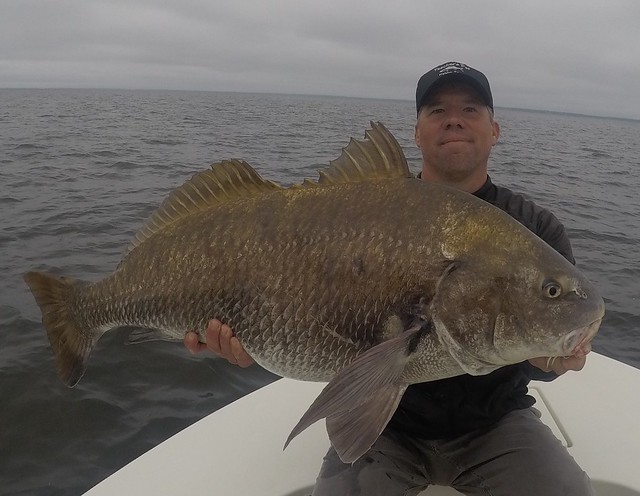
Photo courtesy of Travis Long
The shallow water fishery for striped bass in the middle bay region has been offering some exciting fishing this week in the early morning and evening hours. There is a mix of sub-legal and striped bass in the 22' to 26" size range moving about in shallower areas near prominent points, submerged breakwaters and shoreline structure. Topwater lures such as poppers are the best and most fun way to fish for them. June 1, all areas of the tidal rivers and creeks will be open to striped bass fishing. Eastern Bay will be one of the areas being looked forward to since there has been a nice concentration of striped bass in the area for the best part of the month of May.
In the lower bay region most of the striped bass action tends to be in the Cedar Point to Cove Point area. Everyone is anticipating being able to fish in the lower Patuxent starting tomorrow June 1. Trolling along the 35' channel edge with an array of bucktails, red surge tube lures and spoons have been popular; all are being pulled behind inline weights. There is also some good trolling action in the lower Potomac River near Piney Point and St. George Island. All of these channel edges also hold opportunities for light tackle jigging when suspended fish can be spotted on depth finders. Others are also entertaining the idea of chumming and have been setting up near Buoys 70, 72A and the Middle Grounds.
On the eastern side of the bay speckled trout are being caught despite the chilly weather and when the sun breaks out and warmer temperatures prevail, this fishery should really kick in gear. Drifting peeler crab or soft crab baits on a falling tide near the mouths of tidal creeks is the best place to be; advoiding cow-nosed rays is part of the deal. Casting white Gulp mullet baits is a good way to cover water and have fewer hook ups with rays. There are striped bass in the area as well, many are sub-legal but they offer plenty of action, especially on topwater lures.
A few croakers are showing up here and there in the Tangier Sound and Point Lookout areas as well as the mouth of the Wicomico River in the lower Potomac. Most are catching a lot of medium-sized blue catfish in the Bushwood area of the lower Potomac while bottom fishing.
Fishing for white perch has been good in all three regions of the bays tidal rivers and creeks. Fishing with grass shrimp or bloodworm baits near docks and piers is a fun way to catch up a mess of filleting size perch. Casting small spinnerbait jigs or spinners along shoreline structure in the morning and evening hours is also a productive and fun way to catch them.
Recreational crabbing continues to be good in most of the middle and lower bay tidal rivers and creeks. The catches tend to be a little better this week on the Eastern Shore and with water temperatures relatively cool, some of the best catches are coming from shallow water. Matthew and David Bishop "brought home the bacon" in a sense with this nice bushel of crabs destined for a Memorial Day crab feast.
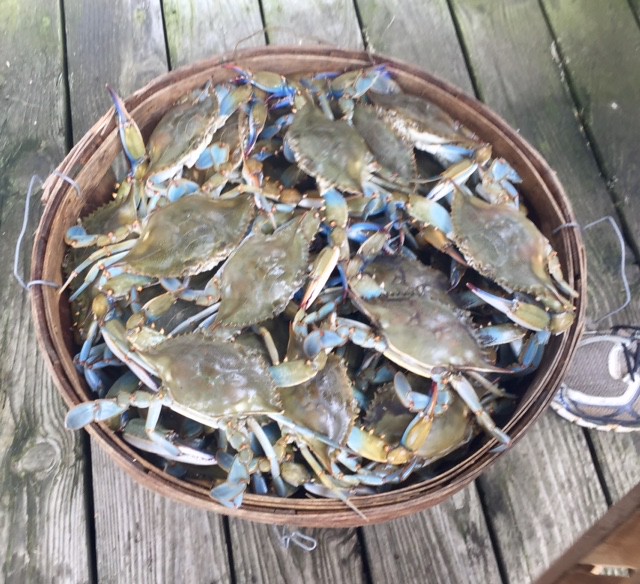
Photo courtesy of Sherry Bishop
At Deep Creek Lake smallmouth bass can be found on rocky flats on points, walleye are starting to go deeper as water temperatures warm up but can be found along rocky edges and deep grass lines by drifting minnows. Yellow perch can be found along those deep grass edges also. In the coves there are largemouth bass while northern pike can be found in the deeper parts of the coves. Largemouth bass can also be found near floating docks; flipping soft plastics under those docks is a great way to target them.
John Mullican was kind enough to send us an update report from the upper Potomac River. The Potomac River is flowing above normal due to the recent rains. Although predicted to fall towards the weekend, levels will still be fairly high and boaters should be very cautious. Smallmouth bass were actively spawning prior to the recent high water event and those flows could have negatively affected this year's year class. Bass fishing, however, has been good and bass have been taking a variety of offerings. Jigs/tubes have been the most reliable, but spinnerbaits, crankbaits, jerkbait and topwater baits have worked as well.
Largemouth bass are offering excellent fishing opportunities in small ponds, larger impoundments and tidal rivers throughout the state this week. The bass are in a post-spawn mode of activity and with water temperatures relatively cool, the bass are in a very active feeding mood. The shallow water morning bite has been lasting longer into mid-morning and starting earlier in the evenings due to overcast weather and cool water temperatures. Targeting shallow grass is a number one tactic during these times with topwater baits. Northern snakeheads will be part of the event when fishing topwater lures in many of the state's tidal rivers. Stick worms and soft plastics are good baits to use if you want to get down through the grass or along the edges, both should be whacky rigged. No one likes fishing in the rain but Russell Anderson stuck it out on Sunday at Lake Allen and had this nice largemouth to show for it.
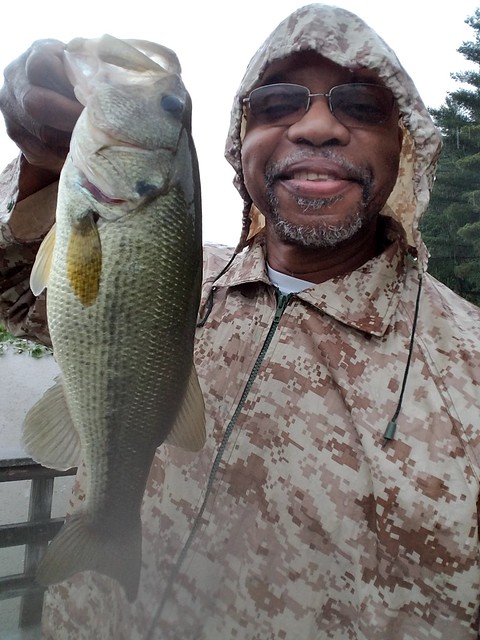
Photo courtesy of Russell Anderson
There are plenty of other freshwater fishing opportunities this week for various species of sunfish, crappie and chain pickerel. Trout fishing has been very good in the western region and recent stockings have bolstered trout fishing opportunities there. For those wishing to do some bottom fishing, channel catfish can be found in most tidal rivers and blue catfish in the tidal Potomac and Nanticoke Rivers.
Despite overcast and rainy weather in the Ocean City area there has been some good fishing in the surf and inlet area for short striped bass and bluefish. The striped bass are being caught in the surf on cut bait and the bluefish on finger mullet. At the inlet and channels near the inlet there is a mix of striped bass and bluefish being caught on bucktails, Got-Cha plugs and topwater poppers. Angelina Watts got to do some fishing with her dad today and sent us a couple of pictures of some fun fishing near the inlet.
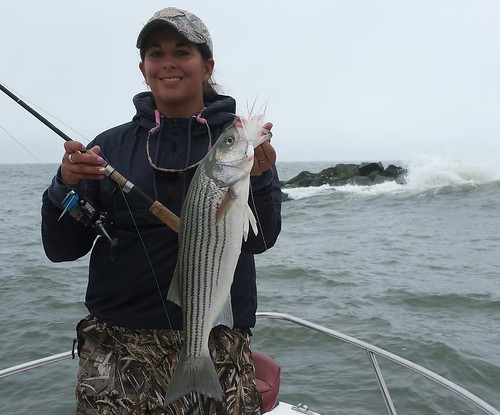 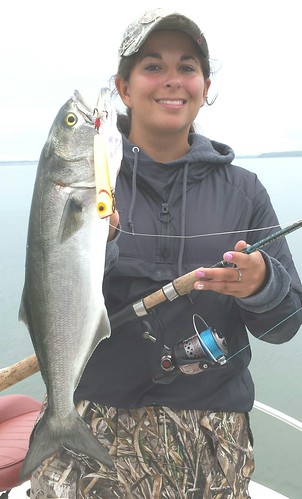
Photo courtesy of Rich Watts
Flounder are being caught in the channels near the inlet and even a few speckled trout. The smaller bluefish are expected to be around this week and a couple of black drum have been reported in the back bay channels.
The winds dropped off enough over the weekend that boats were able to get out to some of the wreck and reef sites closer to shore and experienced very good sea bass fishing with limits being common. Also over the weekend boats made it out to the canyons and came back with a mix of bigeye and yellowfin tuna, dolphin and those that chummed caught a few makos and had quite a few blue sharks fussing with baits.
"Most fishermen swiftly learn that it's a pretty good rule never to show a favorite spot to any fisherman you wouldn't trust with your wife." - John Voelker
|  Date : 5/24/2017 (1) Date : 5/24/2017 (1)
| | 5/24/2017 | Ready or not, here comes Memorial Day Weekend! For many it is a time for family "mini- vacations" over the long weekend to favorite places, and often fishing will be involved. No doubt all manner of vehicles will be spotted later on this week packed with gear and kids peering out windows, (or glued to their iPads), while dad drives and mom acts as copilot. For those of an older generation growing up in the influence of WWII veterans, there were always parades if you were a Boy Scout and the Stars and Stripes would be flying everywhere. In those days the last Spanish American War veteran and then the last WWI veteran would ride in a convertible in those parades. The few WWII veterans that are left are now in their 90's, and recently a good friend lost his dad, who passed away in his late 90's. That man was the last veteran of that great conflict that I knew well. It sort of closes a life chapter for me. Korean War veterans are now the "old guys" followed by Vietnam and Middle East conflict veterans. Please remember to honor them all, and thank them for their service.
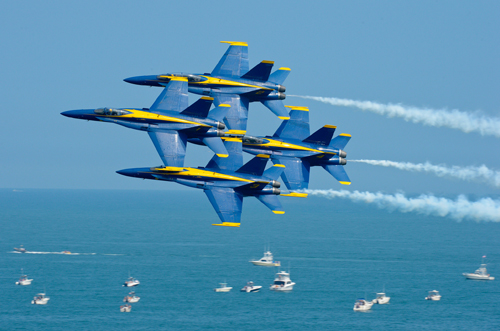
Photo provided by the U.S. Navy, the Blue Angels perform in Ocean City, MD
Water flows at the Conowingo Dam have been moderate during afternoon hours but very low during late night to late morning hours. Water quality in the lower Susquehanna and flats area has improved as a result. Fishing for white perch has been extremely good for those casting shad darts or small jigs in the river. Fishing for striped bass out in the channel areas around the flats has been good this week with plenty of fish over 20" in length. Soft plastic jigs such as Bass Assassins and BKDs have been favorites for jigging and during early pre- sunrise and late evening hours topwater lures can work well at times. Fishing for channel and flathead catfish continues to good in the lower Susquehanna up to the dam pool. Montana Grant spent some fun time with his niece and nephew catching some nice Susquehanna white perch when he hooked up with this big carp on his ultra-light spinning outfit.
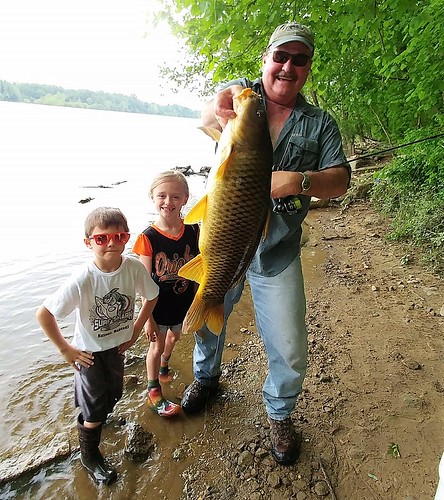
Photo courtesy of Montana Grant
Striped bass catches in the upper bay have been slim this week but some fish are being caught for those who wish to fish close to port. There has been some trolling action along channel edges such as Love Point and the Triple Buoys. Most are trolling three to four ounce bucktails dressed with twister tails in tandem or behind umbrella rigs with inline weights. There have been boats anchoring up at Swan, Love and Podickory Points chumming with some success as well as the deeper Bay Bridge piers. Jigging is a good option when fish can be found suspended along channel edges or structure such as the Bay Bridge piers.
In the middle bay region there have been good opportunities for striped bass in the 20" to 30" size range. The channel edges on the western side of the bay from Thomas Point south to below the Calvert Cliffs power plant are producing striped bass. Within that zone, the area around Parkers Creek and Chesapeake Beach are a real focal point for those trolling a mix of bucktails dressed with twister tails, spoons and surge tube lures. On the eastern side of the bay the channel edge off Kent Island, the Hill, Buoy 83 and the False Channel have been producing fish. Most anglers are trolling, but often fish can be found suspended or breaking water. Bay anchovies are becoming common as water temperatures move back towards the 60 degree mark so it pays to keep jigs down to 6" or so and chartreuse, purple, pink and pearl have proven to be good colors for soft plastics this week.
Those who are tired of trolling have been setting up chum lines at the outside edge of Hackett's and the Hill. Some are using menhaden chum and others are using razor clams.
The shallow water striped bass fishery in the middle bay region has really come into its own and there is hardly a more fun way to catch striped bass than casting topwater lures. There is a portion of sub-legal striped bass in the mix and unfortunately cow-nosed rays have moved into the region stirring up the shallows. Water quality overall has been good though, and grass cover has been in good shape.
Memorial Day weekend is upon us and more than a few will be slowly cruising over the shallows of Stone Rock looking for heavy marks on their depth finders indicating the presence of black drum. Anglers will be ready with a soft crab held to a hook with a rubber band and a 3 ounce sinker ready to drop to the drum at a moment's notice. A spot that usually has fewer boats and often presents a good opportunity for black drum is the James Island Flats.
More than a few anglers in the middle and lower bay have been excitedly remarking about the few large bluefish that have showed up in the bay recently and hopes of them becoming more common in the Chesapeake. Everyone likes to catch a large hard fighting fish and large bluefish are certainly noted for that. Barry Turner is all smiles with this big one he caught recently.
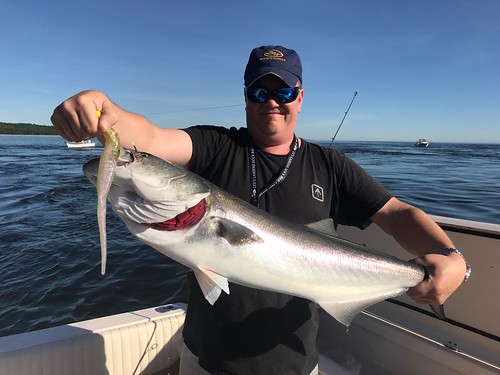
Photo courtesy of Barry Turner
Striped bass fishing in the lower bay region this week has been extremely good for fish less than 28". Trolling along channel edges from Cedar Point, past Cove Point and north has been very good along the 35' channel edge. Bucktails in the 3 to 4 ounce size range in chartreuse or white and dressed with twister tails have been great producers. Red surge tube lures are also being used along with small to medium sized spoons. There has also been successful chumming out at the Middle Grounds for striped bass and to a lesser extent near Buoy 72. There is trolling action in the lower Potomac as well.
Light tackle fishing has been good for those that can find suspended fish along channel edges or under breaking fish. Metal jigs and soft plastic have both been working well. There are a fair portion of smaller fish being encountered alone with bluefish when breaking fish are found but as is often the case larger fish can be found underneath. Bay anchovies are spreading out throughout the region and are being swept along channel edges in stiff currents.
Over on the eastern side of the bay some large red drum have been caught and released by those trolling large spoons above the Target Ship and some are lucky enough to hook into them while jigging. The creeks and guts flowing out of the marsh areas are attracting speckled trout and the catches have been good for those who fish for them. White Gulp Mullet baits tend to be the best bet now that cow-nosed rays have moved into the area making it hard to fish peeler or soft crab baits without hooking up with a ray. These same areas are also holding striped bass and there are throwbacks but enough larger fish to fill out a two fish limit on most trips.
Croaker are becoming more common and some warm weather will speed up their movement into local waters. There are reports of excellent croaker fishing at the James River area of Virginia last weekend so hopefully they'll be here soon. A few croaker are also showing up near Point Lookout along with small kingfish.
Recreational crabbing continues to move along at a good pace. Most are reporting the best catches are coming from relatively shallow water in tidal creeks.
Fishing at Deep Creek Lake will be noticeably different this weekend as vacationers begin to descend on the waters of the lake. One of the good things though is that floating docks are being deployed making good habitat for largemouth bass. Targeting docks is a major "go to" tactic for bass fishing on the lake with stick worms and soft plastics. Largemouth bass can also be found in the grassy coves. Smallmouth bass are holding over rocky points in about 6' of water and can be caught on jerkbaits and tubes.
The western region trout management waters continue to be stocked with trout this week creating good fishing in many areas. Conditions are good and this weekend will be a great time to get out and enjoy some streamside relaxation. The stockings can be viewed at the trout stocking website.
John Mullican checked in with a short report from the upper Potomac this morning.
The Potomac is in great shape and the fishing has been excellent. Smallmouth are taking everything from topwaters to jigs bounced on the bottom and everything in between. Fishermen have also been catching walleye and a few muskie too. Check the river gauges before heading out; the river is predicted to rise significantly from the forecasted rain.
Most everyone that is fishing their favorite pond, lake or tidal river for largemouth bass this week is having a great time. The fish are very active and can be usually found in less than 8' of water near most any kind of structure and especially grass. A variety of topwater lures are perhaps the most fun way to fish for them, weedless frogs over grass, poppers, buzzbaits and chatterbaits, take your pick. Pitching whacky rigged stick worms and soft plastics into grass where largemouth bass are holding is another good tactic.
In the tidal Potomac the growth of grass is reported to be excellent this year and definitely the best place to target bass. Water temperatures in most tidal rivers are about 70 degrees this week making for ideal conditions. The tidal rivers of the middle and lower Eastern Shore provide good fishing for largemouth and much like the tidal Potomac hold a lot of northern snakeheads that hold in the grass or spatterdock fields. The happy angler holds up a northern snakehead caught near Blackwater Refuge in Dorchester County while fishing for largemouth bass.

Photo courtesy of Don Goff
There are lots of other warm water freshwater fish to entertain anyone who fishes for them this week. Crappie have moved into shallower waters near brush and similar structure and can be caught on small jigs or minnows and lures like small jerkbaits. Bluegill sunfish can be found outside of lily pad or grass areas and an excellent introduction to fly fishing with small poppers or wet flies. Of course it is hard to beat a worm or grasshopper below a bobber or working a small spinner fly with an ultra-light spinning outfit. Depending where you are fishing there are other species of sunfish, the feisty rock bass and chain pickerel, and you can enjoy them all!
Unfortunately it was another windy weekend in the Ocean City area, making for some tough fishing from boats. In the surf and in around the inlet anglers got their last licks in on the large bluefish that have been moving through the region on their way north. Coastal anglers are hoping that north bound large migratory striped bass are right behind the big bluefish. Surfcasters will soaking baits this week in hopes of intercepting them and will also be catching sub-legal striped bass and bluefish.
Flounder fishing in the channels behind the inlet took a sleepy nap last weekend due to waters being churned up by strong winds. Hopefully, we're done with the stained water and seaweed for a while. Striped bass under 28" are providing some fun catch and release action along marsh edges near the Route 90 Bridge on topwater lures in the mornings and evenings.
Sea bass fishing promises to be good this week if the weatherman smiles on us and at least one boat slipped out to the canyons this week and came back to the dock with a load of large gaffer sized dolphin and yellowfin tuna.
"What people don't understand is that this is something that we only have in America. There is no other country in the world where the ordinary citizen can go out and enjoy hunting and fishing. There's no other nation in the world where that happens. And it's very much a part of our heritage. " - General Norman Schwarzkopf
|  Date : 5/17/2017 (1) Date : 5/17/2017 (1)
| | 5/17/2017 | Let the sun shine and warm the landscape and waters of Maryland this week. After several days of rain, cold temperatures and a root'n toot'n northeaster, I think we're all ready for some dryer and warmer weather. The rain does bring out the green in everything and this is a marvelous time of the year to be in the outdoors. A whole new opportunity has opened up for those who fish for striped bass in the Chesapeake as the minimum size has dropped down to 20" and the striped bass abound in many areas for fishermen this week. The water clarity in the middle and lower bay is amazing right now so get out there and enjoy the outdoors whether you are fishing for striped bass or largemouth bass; they're out there waiting for you.

Photo courtesy of Mike Naylor
Before we get into the Bay section of the fishing report, here is a quick reminder that Maryland will once again be having free fishing days in June and July. The Maryland Department of Natural Resources invites residents to participate in the state's three, free fishing days in 2017: June 3, June 10 and July 4. They provide a unique opportunity to fish the state's waters without obtaining a fishing license, stamp or registration.
The floodgates at the Conowingo Dam closed this past Sunday for the first time in over a week, which is good news for fishermen and the bay. The waters of the lower Susquehanna and the very upper portions of the bay will have stained water for a while as well as floating debris but will clear up in time. Presently the lower Susquehanna River is loaded with white perch and now that the river has calmed down there is excellent fishing to be found. There are still a few hickory shad being caught and released at the mouth of Deer Creek but there is a lot of white perch eager to take shad darts. Lower flows in the river will also mean better fishing for flathead and channel catfish and there could very well still be some American shad near the dam pool.
The Chesapeake Bay striped bass regulations changed on May 16 to allow bay fishermen to keep 2 striped bass between 20" and 28" or one fish above 28" and one below. This is a welcomed change for those weary of trolling back and forth across the channels in hope of hooking up with a striped bass over 35" in length. The upper boundary line has moved a bit farther up the bay from the Brewerton Channel to a line drawn across the bay from the southern tip of Hart-Miller Island to the end of Route 21 in Tolchester. This will be a welcomed relief to those wishing to jig or troll for smaller fish that they can take home. Chumming and chunking will also be a good option this week. There have been exciting reports of striped bass in the Swan Point area as well as the Triple Buoys, Love Point, Podickory Point and the Bay Bridge piers.
There are encouraging reports of 20" to 28" sized striped bass at a number of locations in the middle bay region. There have been good reports of jigging action at the Hill area that up until May 16 has been catch and release only. Metal jigs and soft plastic jigs are the ticket and some are using 9" soft plastic jigs and finding a few trophy class fish. Other locations that are holding a lot of fish are the channel edge off Kent Island and the 35 foot channel edge near Parkers Creek to the power plant on the western side of the shipping channel. Despite chilly weekend conditions these guys enjoyed exciting jigging action in the middle bay region.
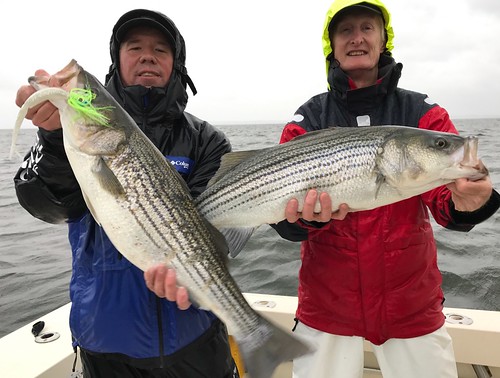
Photo courtesy of Travis Long
Captains who continue to troll will be adding smaller lures in their trolling spreads this week and will be able to target and keep fish smaller than 35", which will make everyone happier. As most will attest, the spring trophy striped bass season has been a bit disappointing. The weather was certainly not on our side and everyone is still trying to figure out how our post-spawn striped bass slipped through the fleet of boats pulling planer boards with as many as 40 lines on the larger charter boats. At this point, it is hard to say what sneaky shenanigans the spawning striped bass played on us. One thing is a fact, surface water temperatures have dropped from above 60° to 55° by the weekend. Warmer weather this week and plenty of sunshine should get our bay water temperatures back to a more favorable level.
The lower bay region offers good fishing for striped bass under the 35" mark this week. Locals will be happy to divert their attention from trophy sized fish or the lack thereof to something more accommodating to their efforts. Large trophy sized striped bass are still being caught along some of the traditional steep channel edges along the shipping channel and in the lower Potomac River. There are also a lot of striped bass in the 20" to 30" size range in the region and they tend to be congregated near the Cove Point to Cedar Point area.
Recent continued late-night enforcement at Fishing Creek Bridge in Dorchester County by the Maryland Natural Resources Police resulted in nine men being charged with illegal fishing and 154 undersized striped bass being seized. Officers charged four men with fishing in a prohibited area, keeping too many striped bass and keeping undersized fish. Fifty-six striped bass were seized. The men are scheduled to appear in Dorchester County District Court. Each charge carries a maximum fine of $1,500. Many thanks to the NRP officers who are out patrolling along the Bay during some very late hours.
On the bright side, the lower Eastern Shore fishing scene has seen some wonderful speckled trout catches in the past week along the lower Eastern Shore marshes. Targeting guts and tidal creeks where they empty out into the bay on an ebbing tide has always been the place to be and once again those stinky old white Gulp mullet baits tend to be the best lure to use. Flounder are showing up in the Tangier Sound area, and an old buddy from the 1960's, northern blowfish, are being caught by those bottom fishing. Cow-nosed rays are moving into the region and spreading to the north in waves just in time for the opening of areas where shallow water fishing for striped bass is a passion for many. William Rohrer Sr. is sure happy with this big speckled trout he caught recently in the Tangier Sound area.
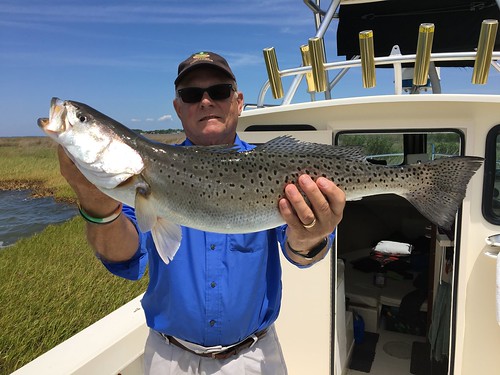
Photo courtesy of Ken Zborowski
Fishing for white perch has been very good in most of our tidal rivers and creeks this week. The perch have arrived at their summer haunts and are ready for fishermen of all ages. Fishing with ultra-light tackle and casting to shoreline structure in the evenings is a wonderful way to pass some time if you live close to the bay or tidal rivers. Structure such as fallen trees, logs, riprap and current beaks are good places to cast small spinners, spinnerbaits or plastic jigs. In deeper waters, near docks, a shad dart tipped with a grass shrimp is hard to beat when jigged close to the bottom and under the dock.
The weather on Thursday through Saturday was not very inviting to fishermen or recreational crabbers. Crabbing is picking up speed and although water temperatures took a dip this past week, crabbing in the shallower creeks offered some rewards. Rich Watts and his daughter Angelina had a hankering for some fresh crabs and set out collapsible crab traps in a middle bay region tidal creek, they came up with several dozen. Rich mentioned that the crabs were found in shallow water where water temperatures were in the upper 60's.
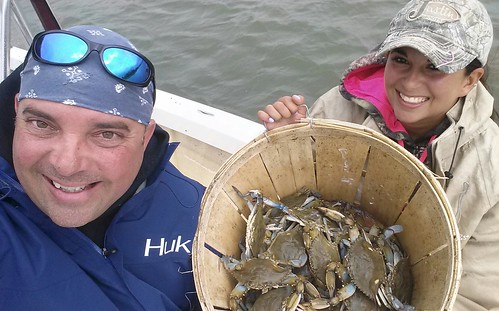
Photo courtesy of Rich Watts
To kick off the freshwater/inland section I wanted to mention the new Maryland state record muskellunge (true musky) which weighed 32.5 pounds and was caught by Tessa Cosens, in the Upper Potomac River, below Dam #5. You can read more about this awesome fish, caught on a black spinner, in the recent press release.
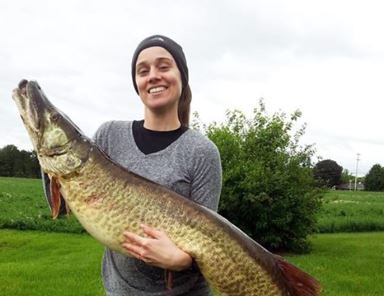
Photo courtesy of Tessa Cosens
Fishing for walleye continues to be good at Deep Creek Lake along rocky drop-offs and deep grass edges. Drifting minnows has been a favorite way to fish for them and anglers are also catching a mixed bag of smallmouth bass, rainbow trout and large yellow perch. Largemouth bass are moving into the cove areas and other shallow areas in preparation for spawning and males are starting to carve out nests. Northern pike can be found in the deeper parts of the coves and chain pickerel in the shallower grass.
Trout are still being stocked this week in trout management waters with emphasis on waters that will stay cold for the next month. These western region trout management waters offer wonderful fishing through the month of June.
Largemouth bass in many areas of the state are beginning to shift towards a summer mode of behavior but with water temperatures relatively cool, they can be found most of the day near grass and similar structure. Whacky rigged stick worms have been working well in the grass and topwater lures in the shallows. In many of the state's tidal rivers and creeks, northern snakeheads are becoming more of a shallow water target for those who wish to help cull their population and take home something to eat. The lower Eastern Shore tidal rivers and creeks have an expanding population and the tidal Potomac area has had a lot of northern snakehead for several years. Miles Spicer was fishing on the upper Anacostia River when he caught this big one.
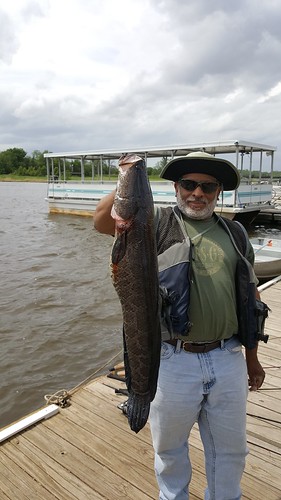
Photo courtesy of Bruce Wernek
Fishing for crappie remains good this week near structure such as fallen tree tops, brush and grass. Bluegills can provide plenty of fun fishing, especially for the young crowd equipped with a simple bobber and worm rig. There are children's fishing rodeos almost every weekend this time of the year and they provide fun fishing for out little angler's with a bit of competition thrown in. What kid doesn't like to win a trophy? To find a fishing rodeo near you, check out the rodeo schedule. Amelia Hatmaker seems to have had a great time fishing and came home with a trophy, a tackle box and bragging rights.

Photo courtesy of Michael Hatmaker
There are plenty of blue catfish in the tidal Potomac River waiting to jump into someone's ice chest for a trip to the filleting table and freezer. Cut bait such as fresh white perch or gizzard shad and a bottom rig is all that is needed.
The weather has finally started to smile on the Ocean City area this week and the fishing continues to be great for large bluefish in the surf, the inlet Route 50 Bridge area and the back bay channels. These bluefish are real choppers and although skinny, provide some fun fishing. They are being caught in the surf on cut bait rigs and a few striped bass are also being caught. Those fishing with baits such as squid and peeler crab are catching black drum and blowfish.
Casting Got-Cha plugs or drifting cut bait at the inlet will also get one into large bluefish. There are flounder being caught in the back bay channels such as the Thorofare on white Gulp baits and the traditional squid and or minnow bottom rigs. There are short striped bass to be found in the Route 90 Bridge area and they are providing some fun catch and release fishing.
As better weather moves into the region, and hopefully lighter winds, the boats will be heading out to the wreck and reef areas. The sea bass season opened May 15 as the tautog season closed; hopefully boats will enjoy good sea bass fishing this week. If winds allow, boats will also be heading out to the canyon region and come back with catches of tuna, dolphin and mako sharks.
"I recognize the right and duty of this generation to develop and use the natural resources of our land; but do not recognize the right to waste them or to rob by wasteful use, the generations that come after us." - Theodore Roosevelt
|  Date : 5/10/2017 (1) Date : 5/10/2017 (1)
| | 5/10/2017 | As most know or better know, this coming Sunday is Mother's Day and for many of us that loved to fish in our youth, it was our mom's that fussed over us about dressing properly, being careful and being home on time when we left on our fishing adventures peddling down the road. They worried then and they worry now, but let little outdoorsman be free to taste the adventures of the world. We don't see too many kids peddling down the road with fishing rods these days, perhaps due to busier traffic conditions or mom's keeping an even closer eye on youngsters in these different times. These days it is often moms that succumb to the pleas to of "please take me fishing.". To all the moms out there that fish, we hope you catch the biggest fish of the day.

Photo courtesy of Marybeth Downes
The flood gates at the Conowingo Dam are open and cold and stained water is pouring through into the lower Susquehanna River. This past weekend's extreme high tides also added floating wood debris to the mess. The striped bass catch and release season is closed in the area so the most common fish being targeted now are white perch and catfish. The American shad and hickory shad are still in the river and providing some catch and release fun. There are a lot of white perch in the river at this time and should be for another week or so, making for a great time to catch some filleting size perch.
In the upper bay region that is open during the trophy season below the Brewerton Channel the most productive trolling action tends to around the Triple Buoys and the Love Point Channel edge. Large parachutes in chartreuse with white sassy shads have been one of the most popular trolling options in about 40' of water. The weekend before the end of the Susquehanna Flats catch and release season there were raving reports of plenty of striped bass in the 26" to 30" size range in the Susquehanna Flats region. Hopefully, those fish will be available in the region south of the Tolchester/Hart-Miller Island boundary line after May 16.
Chumming and chunking for trophy sized striped bass has been an alternative for those tired of trolling back and forth across the shipping channel. The steep channel edge at Podickory Point has been a favorite spot to anchor up and just take it easy and relax while a few baits drift out over the edge of the channel. The Bay Bridge piers are always worth checking on and jigging can offer some fun action as can chunking.
The middle bay region has been offering some trolling action at some of the traditional steep channel edges. The channel edges off Kent Island, Bloody Point Light, the False Channel, CP Buoy and the edge off Taylor's Island. The action could best be described as a slow pick and those who are constantly changing up or making extreme efforts are the ones routinely pulling fish on board. I personally have not seen one go by yet but I hear of some charter boats pulling as many as 40 lines in an extreme effort to get their clients on fish. Ted Kolobow has plenty to smile about with this beautiful fish he caught along the channel edge off Taylor's Island.
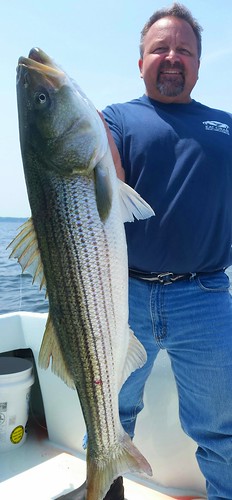
Photo courtesy of Ted Kolobow
The best trolling action reported in the lower bay region for striped bass this week has been along the channel edges at Cove Point but it is far from the action expected for the beginning of May. Catches continue to be sparse and somewhat disappointing for many. The east side of the shipping channel near the HS Buoy and Buoy 72 have been giving up some fish as has the lower Potomac near St. George's Island and Piney Point. Those fishing up near the Wilson Bridge for other species report there are still striped bass splashing about up there. These most likely are smaller fish and this may be their first time on the spawning grounds, they were often called "May Rock" by old timers. Similar action has been seen this week on the Choptank and Nanticoke Rivers.
White perch continue to offer good fishing in the tidal rivers and creeks in all regions of the bay. The can offer some fun ultra-light spin fishing in the mornings and evenings along shorelines with some kind of structure. Some of the more reliable spots are fallen tree tops, sunken logs, old piers, rock groins and prominent points with a good current flow. Small spinners and jigs are good choices for lures and small chartreuse Clouser flies the ticket when fishing with a 4 or 5 weight fly rod. Few things can be relaxing and fun as sitting on the end of a dock and fishing with grass shrimp, bloodworms or minnows. Channel catfish are active in most tidal rivers and the tidal Potomac River from the Route 301 Bridge to the Wilson Bridge is full of blue catfish.
Trout stocking in the put and take trout management waters in the eastern, central and southern regions will begin to slow down as water temperatures begin to elevate to levels that are not the best suited for trout. The waters of the western region are of course a lot cooler due to air temperatures and shaded watersheds and will offer excellent trout fishing through the summer months.
The upper Potomac River is reported to be unsuitable for fishing this week and dangerous for any boating activities. The tidal Potomac is reported to have a lot of floating debris as a result of last weekend's extreme high tides and the waters are stained. Despite these conditions in the tidal Potomac fishing for largemouth bass has been good. Some areas are seeing the last of the spawning and the post-spawn bass are in a very active feeding mood. Targeting grass has been the number one tactic this week with whacky rigged stick worms in the grass or working poppers over the grass. This same tactic has also been working well on the tidal rivers of the middle and lower Eastern Shore near grass of spatterdock fields on an ebbing tide. Calvin Riley and his dad had a fun time together at Broadford Lake in western Maryland and Calvin got to reel in his very first largemouth bass.
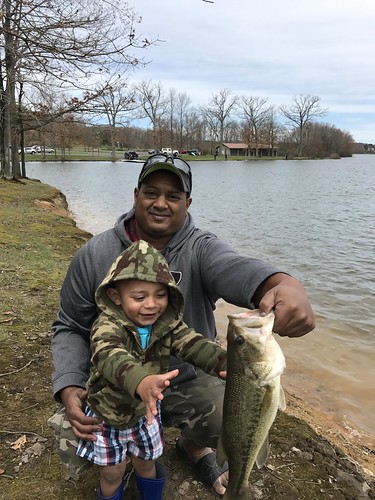
Photo courtesy of Dan Riley
Crappie fishing in the tidal rivers and impoundments continues to be good with the crappie being found in shallow waters now. Small jigs or minnows under a slip bobber is a very popular way to catch them. Whether one is fishing a small local pond or one of the larger reservoirs to be found in Maryland, the month of May offers some of the finest freshwater fishing opportunities of the year.
The Ocean City area like most of Maryland has been subject to windy conditions that made it difficult or impossible to be out on the open waters of the ocean and back bays in a boat. The large spring bluefish are still being caught in the back bay areas, the inlet and nearshore waters. They have been offering a lot of fun to anglers that want to catch a big fish. They are being caught on Got-Cha lures or by drifting cut bait in the inlet and Route 50 Bridge area or by trolling in the channels. Surf casters are catching them on finger mullet and cut baits. Tautog are being caught in the inlet area on sand fleas and pieces of green crabs. Flounder are being found in the back bay channels; white Gulp baits or squid and minnow baits are working well.
As winds hopefully subside this week, boats will once again head out to the wreck and reef sites in search of tautog and others will head even further offshore to the canyons in search of yellowfin and bluefin tuna, along with dolphin and mako sharks.
"The best thing about hunting and fishing". The old man said, "is that you don't have to actually do it to enjoy it. You can go to bed every night thinking about how much fun you had twenty years ago, and it all comes back as clear as moonlight" - Robert Ruark
|  Date : 5/3/2017 (1) Date : 5/3/2017 (1)
| | 5/3/2017 | When fishing, the outdoors always presents a side show that can at times surpass the main event. Last Wednesday evening I happened to find myself out on the bay and came upon the tall sailing ship, the Coast Guard Eagle. For some it has been known that she spent the winter at the Curtis Bay dry docks in Baltimore being worked on. I happened to luck into seeing her headed down the bay in route to New London, Connecticut to pick up the 2017 seasons batch of cadets for sea training. As I watched her go by under power with most likely a skeleton crew onboard she was a sight to see and a shot of pride went through me. Maryland is a wondrous place and the Chesapeake Bay offers plenty of side show entertainment for those who ply her waters. Below is what this marvelous ship looks like under full sail.
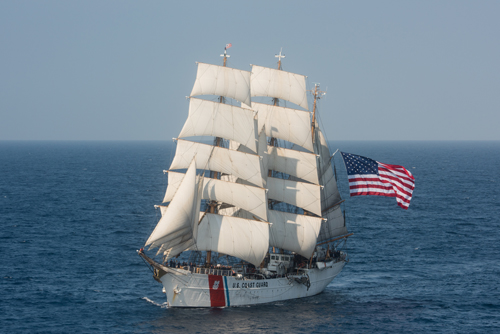
Photo courtesy of United States Coast Guard, Photo by Petty Officer 3rd Class David Micallef
Today, May 3rd marks the last day of the Susquehanna River and flats area catch and release season. Most would agree it was a season marked with a lot of cold and stained water punctuated in early April with spring tides that turned the area into a mine field of floating logs and assorted debris. Those who have stuck it out have been enjoying outstanding catch and release fishing for striped bass in the 30" size range around the outside edges of the flats for the last week or so. Herb Floyd sent us this picture of a fish he caught and released on a topwater lure this past weekend.
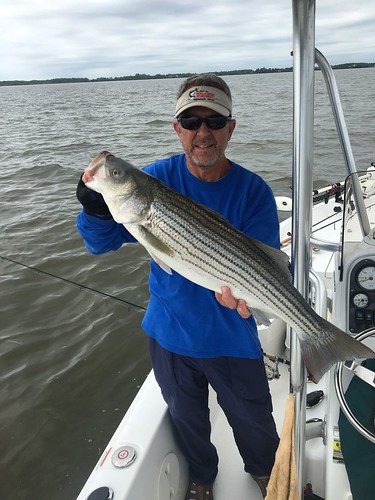
Photo courtesy of Jimmy Sargent
Hickory shad and American shad are present in the Susquehanna River. The hickory shad have been running up Octoraro and Deer Creek and the American shad can be found near the Conowingo Dam pool. The hickory shad runs are often governed by weather events such as warm sunny weather and cool rain events. If you are driving a long distance, be sure to keep an eye on recent weather. There are plenty of flathead catfish and channel catfish to be caught in the lower Susquehanna this week on various cut bait or chicken liver. White perch are in the river and the fishing has been extremely good for those fishing with shad darts or bottom rigs baited with bloodworms. For those who enjoy this wonderful eating fish it is a good time to get in on the action for some large filleting size perch.
Generally speaking, the fishing action for trophy sized striped bass in Maryland's portion of the Chesapeake Bay has been very slow up to this week. If I was ever to place my bets on when to be out trolling, it would be this week. The first full week of May usually offers the best chances and last year there was what might be described as a four day blitz in the middle and lower bay regions. Up to the day of writing this fishing report the action is still being reported as slow. The weekend and beginning of this week was also hampered by small craft warnings so hopefully better conditions will prevail later on this week and into the weekend. They do call it fishing.
In the upper bay region below the Brewerton Channel the Spring Trophy Season continues and the action has generally been slow with a fair portion of the boats returning to port with a skunk onboard. There were reports from last weekend of pre-spawn fish still being caught in the upper bay region. If this upper bay fishery is going to kick into gear this is the week that it usually happens. The best places to troll have been the Triple Buoys and Love Point channel edges and the Craighill Channel just above Sandy Point Light. The Sandy Point Light area or what many call Podickory Point has also been a place where those chunking or chumming have been having success. The Bay Bridge Piers that are in deeper water have also been holding large striped bass and are always worth a few passes if trolling or jigging with large soft plastics. If you are brave enough to anchor up current of the bridge piers, chunking can also be a good option. Unfortunately the area around the bridge is what could be called the graveyard of anchors due to debris laying on the bottom.
The middle bay region success rate for catching large post-spawn striped bass has been better this week than the upper bay region but so far has been disappointing in its own rite. It would suffice to say one will have to work for their fish unless the fish gods smile upon you. Boats have been plying back and forth across the shipping channel from just below the Bay Bridge to below Breezy Point. It would be optimistic to call trolling a slow pick. Fish are being caught and it only takes one of these to make someone very happy. Josh Kaltreider certainly has plenty to smile about as he holds up a trophy sized striped bass.
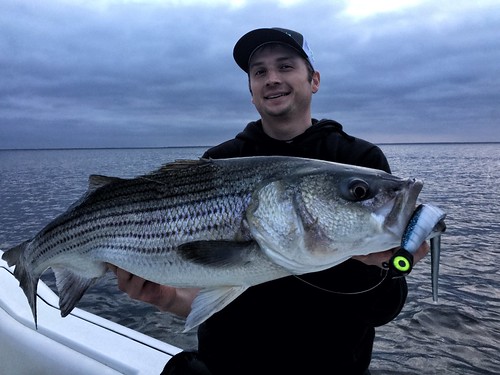
Photo courtesy of Travis Long
Some of the traditional steep channel edges to check out would be Bloody Point Light, the Gum Thickets, Thomas Point, the channel edge west of Poplar Island and down to off Taylor's Island. Lure colors have settled down to chartreuse and white and a chartreuse parachute with a white sassy shad tail has been very popular, sort of the best of both worlds. Surface water temperatures in the middle bay region have just kissed 60° this week and with warmer weather ahead, they will continue to climb.
In the lower bay region, captains have been working the shipping channel edges and picking up a few trophy sized striped bass, but generally speaking the action has been slow. The western edge of the shipping channel from Cedar Point past Cove Point has been one of the better places to troll. The eastern edge of the shipping channel from Buoy 72 up to the CP Buoy has been another good place to troll. The mouth of the Potomac River to Smith Point so far this week has not been good but that could change quickly. The post-spawn striped bass have to leave the Woodrow Wilson Bridge to D.C. area at some point, and when they do the fishing should improve greatly.
Fishing for white perch has been good in most of the tidal rivers in all regions of the bay. The white perch have settled into their summer habitat and are eagerly taking small lures and bottom rigs baited with bloodworms or grass shrimp. Channel catfish offer good fishing in most tidal rivers and the tidal Potomac holds large numbers of blue catfish. Hickory shad are still present in the upper Choptank and Marshyhope Creek but will begin to fade out this week as spawning commences.
The locust trees are in full bloom and traditionally this event marks when blue crabs undergo their first shed of the season. Early season crabbing has been good for many for sweet tasting rusty bottom crabs that survived their winter in the bottom of the bay. As the crabbing season begins it is a good time to mention that if you are using the classic orange plastic basket that is commonly seen in commercial fishing circles; this basket does not represent what is considered a bushel by law. The commercial fish baskets actually hold more than a standard bushel which is determined by the common wooden basket. If you use these plastic baskets do not fill them to the top, you could face a summons. The Winter Blue Crab Dredge Survey results have been out since April.
In the western region of the Maryland the walleye fishing at Deep Creek Lake has been good for those drifting along deep rocky edges with minnows. Walleyes can also be caught before sunup or at sundown by casting lures from shore along steep edges. There are plenty of rainbow trout swimming around in the lake and smallmouth bass fishing has been good. Northern pike also add some excitement and can be found at the mouths of some of the larger coves areas. The upper Potomac River is reported to be running high with stained water conditions. Greg Boyer holds up a nice northern pike he caught at Deep Creek Lake recently.
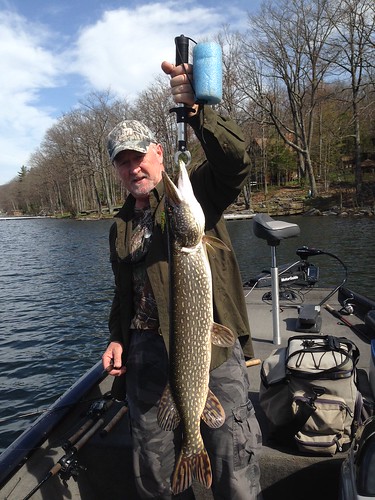
Photo courtesy of Greg Boyer
Trout fishing continues to be good in the trout management waters and generous stockings are taking place every week in the put and take areas. Crappie fishing remains very good in many of the impoundments scattered across the Maryland landscape as well as most tidal rivers. Minnows or small jigs under a slip bobber worked near deep structure is a sure fire way to catch them.
Largemouth bass are finished spawning in most areas of the state and are actively feeding to build up body stores after spawning. Grass beds in relatively shallow areas near the spawning areas as well as the mouths of feeder creeks are good places to target. Unweighted stick worms are a good bet in the grass, topwater lures are also a fun way to work some of the shallower areas. Tidal rivers are always a fun place to fish for Largemouth bass and of course the tidal Potomac continues to be an outstanding fishery. The tidal rivers of the lower Eastern Shore tend to get overlooked except by locals and these river provide picturesque places to fish for a mix of largemouth bass, chain pickerel and northern snakeheads. A falling tide is often one of the better times to work the edges of grass and spatterdock fields.
There certainly has been an air of excitement along Ocean City beaches and the inlet area for over a week now. Large migrating bluefish that are moving north have been on the prowl for anything to eat. Looking at them it is easy to see they are emaciated from the long swim from southern waters with few stops at local snack bars along the way. They are all head but certainly are fun to catch. Surfcasters have been catching them on bottom rigs baited with cut baits or finger mullet. At the inlet cut baits, Got-Cha lures or anything else that looks good to eat are being eagerly taken by bluefish. The local tackle shops are doing a brisk business in replacing tackle lost to those big teeth so fishermen and shop owners are all happy. This happy angler holds up a nice one caught off the Route 50 Bridge on cut bait.
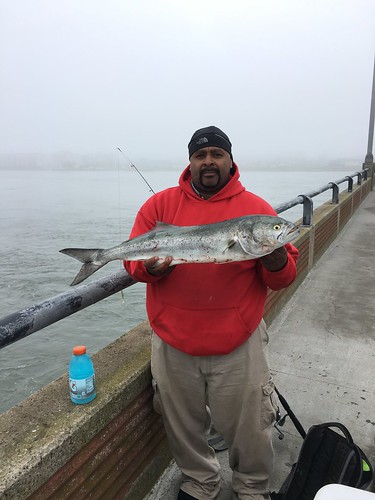
Photo courtesy of Karon Hickman
Tautog are also being caught at the inlet and the Route 50 Bridge area along with a few flounder. In the surf large bluefish tend to be targeting any large cut bait in the surf, but a few medium-sized black drum and short striped bass are being caught. There are also blowfish in the area. In the back bay channels, flounder are being caught on white Gulp baits as well as the standard squid and minnow baits. Short striped bass are providing some entertaining catch and release fishing.
The boats headed out to the wreck and reef sites report good fishing for tautog. Other boats decided to head farther offshore this past weekend and targeted the Triple Zeros area and came back to the docks with the season's first yellowfin tuna, dolphin and bluefin tuna. Other boats fishing near the 30 Fathom line came back to port with a couple of nice sized mako sharks.
For the offshore tuna anglers, NOAA Fisheries (NMFS) has announced Effective April 30, 2017, through December 31, 2017, the bluefin tuna (BFT) daily retention limits are the following: For HMS Angling-permitted vessels: 2 school BFT (27 to under 47") + 1 large school/small medium BFT (47 to under 73"); for HMS Charter/Headboat-permitted vessels: 3 school BFT + 1 large school/small medium BFT. For more information and further updates on the federally managed offshore species, see the news page at the NMFS Permit Shop.
"Surf fishing is to saltwater angling what trout fishing is to freshwater. It's a one-man game from start to finish." - Van Campen Heilner
|  Date : 4/26/2017 (1) Date : 4/26/2017 (1)
| | 4/26/2017 | After a few days of cool rainy weather, the sun is beginning to peek through and warm or perhaps hot weather is predicted for the rest of the week. Spring is here and it is a wonderful time to be outdoors and an especially nice time to have fun with children. There are a host of children's fishing events scheduled for the coming weeks. Gather up some youngsters and take the time to attend one near you. Here is the schedule of youth fishing events in Maryland.
Water conditions have not been good this week in the lower Susquehanna River area as cold stained water is coming down the Susquehanna River and through the Conowingo Dam. There are reports of high river levels below Harrisburg so conditions are not expected to improve anytime soon. Local rains will most likely chill waters in Octoraro and Deer Creeks so the hickory shad catch and release fishery may back off temporarily but air temperatures in the mid 80's later on this week may warm the creeks enough that there will be another spawning run this weekend. Previously there has been good fishing for hickory shad and American shad at the dam pool and hickory shad have been running up Octoraro and Deer Creek to spawn. Fishing for channel and flathead catfish at the dam pool and below has been very good recently. Predicted high flows may cause some difficulties for holding bottom. Sean Allen Sr. holds a whopper sized flathead catfish he caught recently in the lower Susquehanna.
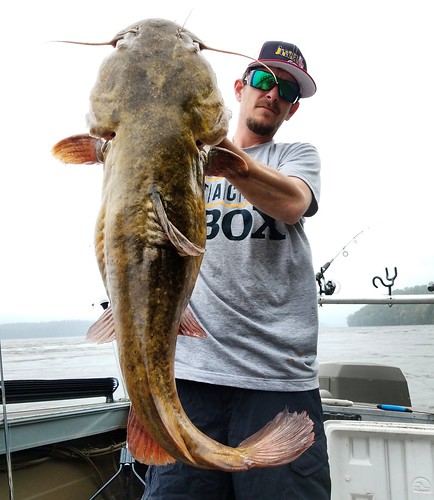
Photos courtesy of Sean Allen, Sr.
The Susquehanna Flats striped bass catch and release season has certainly had its ups and downs due to water conditions in the area being dominated by flows from the Conowingo Dam. The lure of the fishery has been waning since the trophy season opened and the Susquehanna catch and release fishery will end next Wednesday May 3rd. Those using cut bait, such as menhaden or gizzard shad, have tended to have a better success rate in the stained water conditions over those casting jigs, crankbaits and jerkbaits.
The upper bay region has been providing some trophy striped bass action in the areas around the Triple Buoys, the Love Point channel edges and Podickory Point. Most are reporting that the major concentrations of jellyfish are now below the Bay Bridge but are reporting loose sea lettuce fouling lures in some areas. Anyone fishing near the Bay Bridge this Saturday April 29th will see a progression of paddle boards and kayaks racing across the bay between the two spans between 8:30 am to 11:30 am. Boat traffic will be restricted and enforced a quarter mile on each side of the bridge to keep planer boards from sweeping through the paddle board fleet. Rich Watts managed to get out earlier this week to avoid the crowds and caught this beautiful 46" striped bass trolling near the channel edge at the Triple Buoys. That is 12" of sassy shad hanging off of that parachute.
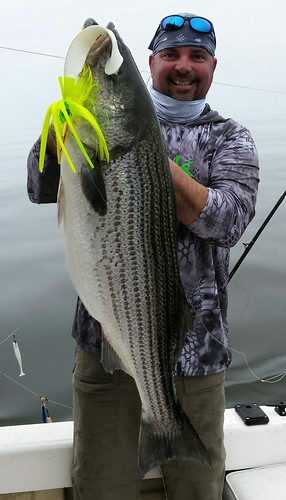
Photo courtesy of Rich Watts
The Maryland Artificial Reef Initiative (MARI), DNR Artificial Reef Program is deploying concrete material today at the charted and permitted Love Point fish reef (also known as "Fish Havens" on the NOAA nautical charts). This reef is located approximately 1.5 miles north of Love Pt (northern tip of Kent Island), with a water depth of 26-30 feet. McLean Contracting Company from Glen Burnie/Baltimore is providing the material and deploying with their crane barge rig.
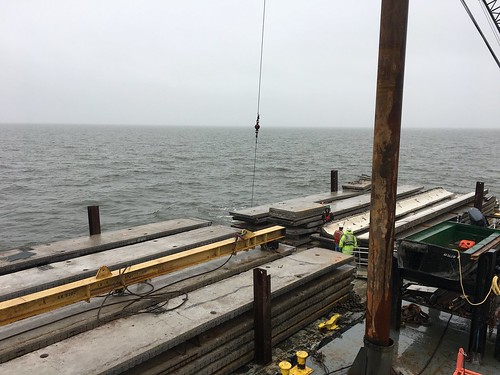
Photo courtesy of Michael Malpezzi, DNR
In the middle bay region fishing success for trophy sized striped bass is gaining momentum as more post-spawn fish exit the spawning rivers and ply the shipping channel edges. I had the opportunity earlier this week to see some beautiful fish come into the docks at Oxford, including one 50" specimen. Traditional steep channel edges have been where the action is and a mix of chartreuse or white parachutes and bucktails dressed with large sassy shads have been the winning ticket. Most are trolling tandem rigged baits but an umbrella rig here and there in a trolling spread is not something to be overlooked. Large spoons are another good option but can cause a frightful twisted mess if they get tangled up with another line.
Water temperatures in the spawning rivers are in the mid 60's and nearly all of the spawning is over on the Eastern Shore. Water temperatures out in the bay are holding around 54° and we can expect those temperatures to climb a bit with predicted hot weather later on this week. River herring are also leaving the Eastern Shore tidal rivers and out into the bay headed south. They will become quick lunch if encountered by any hungry post-spawn striped bass.
Lower bay trophy striped bass fishing is moving along at a steady pace and improving with time. As we approach the first week of May we should expect the fishing to really take off. Large striped bass are moving down the bay and also out of the Patuxent River. Shipping channel edges off Cedar Point, Cove Point and the HS Buoy will be popular places to troll. The Potomac River spawn has been a little behind schedule, possibly due to cooler water temperatures from upper watershed runoff. The predicted warm weather may speed things along and eventually those fish will be available in the lower Potomac. The places to be are the steep channel edges in the lower river off St. Georges Island and Piney Point, as well as the mouth of the river and Smith Point.
Fishing for hickory shad this week on the upper Choptank River at Greensboro to Red Bridges has been very good. The upper Marshyhope near Federalsburg has also been good for hickory shad catch and release fishing. The upper Patuxent River has a good population of hickory shad and they can be found all the way up to Brighton Dam. The fishing for hickory shad and American shad has been very good at the Chain Bridge area on the Potomac. Richard Gunion shows off a nice Potomac River American shad before slipping it back into the river.

Photo courtesy of Richard Gunion
White perch are now being found in their typical summer season estuarine haunts. They can be caught near bottom structure on simple bottom rigs baited with bloodworms or grass shrimp. Casting spinners near shoreline structure in the evenings is a great way to catch them on ultra-light tackle. The tidal rivers of the upper bay, middle bay and lower bay regions provide a lot of fun white perch fishing that will carry on through the fall months. Fishing for channel catfish continues to be good and a fun type of relaxing fishing that can often be done from shore in the tidal rivers. Fishing for blue catfish in the tidal Potomac continues to be a "all you wish to catch" type of fishing where it is very easy to catch of cooler full of good eating catfish. Fishing for northern snakeheads in the tidal rivers has been good for those fishing for them, chatterbaits tend to be the bait of choice to get their attention.
Crappie fishing in many areas of the state continues to be very good as crappie hold to deep structure. Those that are targeting them are enjoying catching some big ones in many impoundments throughout the state. Many of the tidal rivers hold good populations of crappie with the tidal Potomac near the Wilson Bridge and Fort Washington area being one of the top locations. Often boats can be seen with spider rigged boats slowly working structure in the "Spoils" area or marina docks and piers. Small minnows under a slip bobber or small soft plastic crappie jigs do the trick.
Largemouth bass in the tidal Potomac are almost finished spawning at this time and if they are off the nests, they can be found near creek mouths and milfoil grass. Stick worms with no weight have been a favorite to work the grass.
Largemouth bass in other regions of the state are in various stages of spawning. As one could imagine in the western region where water temperatures are colder they are in the beginning stages of spawning behavior and in the central, southern and eastern regions they are actively spawning. Most shallow water baits work well this time of the year.
The water level at Triadelphia Reservoir is reported to be down this week by about 15' as a 2 year long project begins on the Brighton Dam. The work entails replacing intake screens and sluice gates on the dam and the concrete spillway surface.
Fishing at Deep Creek Lake has an extra bonus this week now that the walleye season is open. Reports are that the fishing for a mix of smallmouth bass, walleye and large yellow perch has been good. Drifting along deep grass edges with minnows under a slip bobber is a relaxing way to fish for them this time of the year. Casting jerkbaits and crankbaits toward dark along steep bank edges is also another good tactic to target walleye.
Trout fishing continues to be very popular this week as stocking crews continue to place trout in the many trout management waters. The stockings are posted the day they are accomplished on the trout stocking website. We also have a trout stocking map website that can be very useful to those that are not familiar with certain trout management waters. The trout waters are listed by clicking on the county of your choice.
The fishing at the Ocean City region has been very exciting for those fishing at the inlet, surf and just off the beaches as a horde of northerly migrating "racer" bluefish have descended upon the region. They are being caught in the surf on bottom rigs baited with finger mullet or menhaden baits. The term "racer" bluefish refers to migrating bluefish that are very skinny, which is typical in the spring. Surf anglers are also catching short striped bass, some medium sized black drum and for those fishing with squid or clams there are some blowfish in the area to be caught.
At the inlet and Route 50 Bridge are it has been all about the large bluefish for the past week that are being caught on cut menhaden or by casting lures. Tautog are being caught on sand fleas and pieces of green crab. A few flounder are being caught and there continues to be short striped bass in the back bay areas that are providing some catch and release fun. Offshore the boats heading to the wreck and reef sites are reporting good catches of tautog. Bryan Rosensteel got a real surprise when he caught this big bluefish off the balcony of the waterfront condo he was renting.

Photo courtesy of Bryan Rosensteel
"Three-fourths of the Earth's surface is water and one-fourth is land. It is quite clear that the good Lord intended us to spend triple the amount of time fishing as taking care of the lawn." - Chuck Clark
|  Date : 4/19/2017 (1) Date : 4/19/2017 (1)
| | 4/19/2017 | Another Maryland spring time opening day has arrived and passed, and the fishing will only get better as the season progresses. The opening day of the spring trophy striped bass season was slow, most of the post-spawn fish have yet to exit the spawning rivers so fishing will improve in the next two weeks. The Maryland landscape is ablaze with flowering plants, bushes and trees which makes for very pleasant surroundings when fishing. The mosquitoes and biting flies have not emerged yet for the most part and temperatures continue to be mild. All in all, a perfect time of the year to enjoy time outdoors, don't let it slip by.
The lower Susquehanna River is beginning to warm up and water clarity is slowly improving as water flows through the Conowingo Dam have decreased. As a result water temperatures are now in the low 60's and because the weather has been mild with no large rain events Octoraro and Deer Creek are showing inviting water temperatures tempting hickory shad to ascend those creeks to spawn. Hickory shad and American shad have been present in the lower Susquehanna for several weeks and it is only now with warmer water temperatures that they are becoming more active. Reports of good catch and release fishing was reported this week at both creeks. Octoraro Creek tends to run a little warmer than Deer Creek. Catch and release fishing has also been good near the Conowingo Dam pool for both hickory shad and American shad this week. Don Goff happily holds up his third hickory shad this day, caught and released near the dam pool.

Photos by Don Goff
Water clarity is slow to improve in the Susquehanna Flats area this week so catch and release fishing for striped bass continues to be slow. Fortunately much of the floating wood debris that blanketed the area as a result of spring tides has beached on windward shores making for safer boating in the region.
The upper bay region below the Brewerton Channel was of course busy with boats trolling along the shipping channel edges on Saturday as most fishermen were anxious to participate on opening day of the 2017 striped bass season. It was a slow day in regards to catching, which is not uncommon for the first week of the trophy striped bass season, especially in the upper bay region. Fish were caught by a few lucky souls along the steep edges near Podickory Point, Love Point and around the Bay Bridge. Fishing success will improve in the coming weeks. Luck was with Mike Fisher on opening day as he holds up a beautiful fish he caught near Love Point on an umbrella white bucktail combination.

Photo courtesy of Mike Fisher
In the middle bay region it would seem that post-spawn striped bass are taking their time exiting spawning rivers. Although the bulk of spawning activity is past, there was still spawning going on in the upper Choptank, Patuxent and Potomac as late as yesterday. Generally speaking the progression of spawning activity and fishing success out in the bay is on track. Traditionally opening day tends to be slow and the best fishing usually occurs around the last week of April and the first week of May. As can be expected Saturday's reports told of the best success at first light and that fishing success tapered off as the morning wore on. It seemed to be a toss-up which color of parachutes and bucktails caught the most fish. Surface water temperatures in the middle bay region are about 60° today and water clarity is fairly good.
Jellyfish were a big problem for those trolling in the middle bay region and mates and others were kept busy clearing fouled lines as they trolled along the steep edges of the shipping channel and the current breaks that occur there this past weekend. Recently I've noticed vinyl skirted parachutes being used in the theory that they do not become bogged down with jellyfish goo like the nylon skirted parachutes. My friends tell me that they will foul also but to a lesser degree but when they do they have to be hosed off, rather than brushed out like the nylon ones. Who said it was going to be easy?
In the lower bay region one would most likely describe the striped bass fishing as a very slow pick. Unfortunately there were a lot of disappointed fishermen in charter and private boats this weekend. The lower Potomac tended to be slow and reports of good fishing in the catch and release area near Ft. Washington supported the notion that a lot of the fish have not completed their cycle of spawning and heading down river into the areas below the Route 301 Bridge. There were reports of a few fish caught along the channel edge out in front of St. George's Island and Piney Point. The channel edges at Cove and Cedar Points were also slow. Patience can be a tough virtue for fishermen but better fishing is just around the corner. On the eastern side of the bay a few fish were caught near the HS Buoy and Aiden Reilly was lucky enough to catch this beautiful 41" specimen in Tangier Sound with his dad.
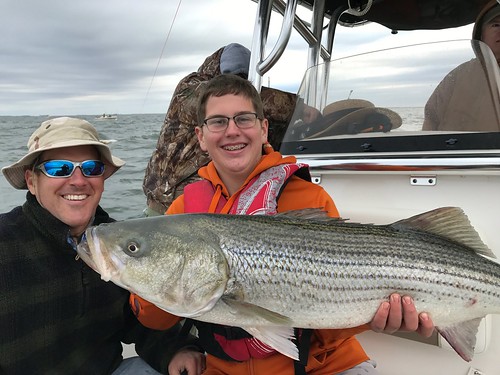
Photo courtesy of Dr. John Reilly
Catch and release fishing for hickory shad and American shad in many of the tidal rivers of the Chesapeake has been very good this week. Reports from the upper Choptank near Greensboro and the Marshyhope near Federalsburg have been good. Hickory shad tend to dominate the fishery but there are just enough American shad to create more excitement. There is good catch and release fishing for hickory shad being reported in the upper Patuxent River. The upper tidal Potomac near Fletcher's Boathouse has been extremely good this week. Maryland anglers are reminded that they'll need to purchase a District of Columbia fishing license to fish above the Maryland line.
White perch are working their way down the spawning rivers and are beginning to spread out into their typical late spring/ summer habitats. Small jigs, spinners and bottom rigs baited with bloodworms or grass shrimp are the way to catch them. Channel catfish are active in most of the state's tidal rivers and crappie fishing has been very good. The tidal Potomac has an excellent population of crappie and everyone is enjoying wonderful fishing near structure such as sunken wood, marina piers and fallen tree tops.
Fishing for blue catfish has been very good in the tidal Potomac and one does not have to be in a boat to fish for them. There are many access points in the Ft. Washington area to fish from shore and on a warm sunny day fishing from shore has a special appeal. Eight year old Bailey Krikstan got to enjoy some fishing with her dad and shows off a big blue catfish she caught on a white perch cut bait.
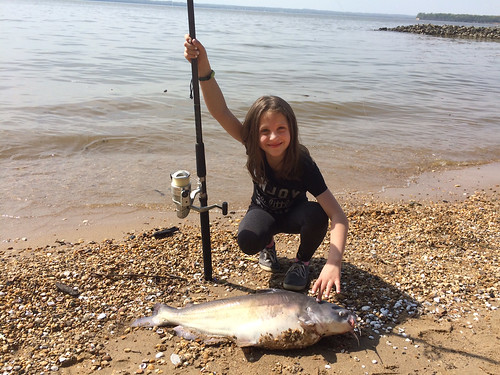
Photo courtesy of Bailey Krikstan
Fishing for largemouth bass in the tidal Potomac River has been good as largemouth nose into small tidal creeks and shallow areas along the river to spawn. Covering emerging grass in the shallower transition areas with spinnerbaits, chatterbaits, shallow running crankbaits and jerkbaits as well as soft plastics are a good bet. Northern snakeheads will be part of the equation as well and fishermen are finding them to be a welcome addition to any fishing outing.
Trout fishing in the many stocked put and take trout management waters continues to take center stage for many fishermen this week. Often many of the put and take areas are close to home and that makes it easy to find time to enjoy some trout fishing. Stocking crews continue to work at a grueling pace to get trout placed at your favorite location and those stockings are posted by early afternoon the day of the stocking. The stockings can be viewed on the trout stocking website or by receiving notice via the email subscription service.
Largemouth bass are beginning to spawn this week in some of the warmer water ponds and impoundments in the southern, central and eastern regions this week or close to it. Most bass fishermen know that the possession of largemouth bass is of course prohibited from March 1st to June 15th in nontidal waters so bass should be handled carefully. The tidal rivers of the Eastern Shore hold good populations of largemouth bass and they can be found holding near the shallower spawning flats and feeder creeks. Crappie and bluegill fishing has been very good in these same areas and the tidal rivers of the Middle and lower Eastern Shore hold populations of northern snakeheads.
As water temperatures warm in the coastal areas of Ocean City, fishing is steadily improving. Water temperatures near the Ocean City Inlet are approaching 49° this week. The first reports of tautog caught at the inlet came in over the weekend and fishing will only improve this week. Bottom rigs baited with green crab pieces or sand fleas are the most popular baits and often slack tide is one of the better times to fish for them. If you have a boat it is pretty hard to beat fishing at the South Jetty. If your shore bound the bulkhead from 2nd to 4th Streets, the North Jetty or Route 50 Bridge are good places to fish.
Surf anglers are catching a few short striped bass, and clear-nosed skates and spiny dogfish are keeping everyone busy. In the back bay areas there is plenty of action with striped bass that are less than 28" in length. Casting a variety of lures near prominent sedge islands and the Route 90 Bridge have been good places to get in on this catch and release action.
The tautog fishing on the offshore wreck and reef sites has been good. There are limit catches by some anglers while others tend to scratch out only a couple of fish. Captain Monty Hawkins sent us this intriguing picture of a tautog peering out of its hide away and a sea bass hovering nearby.
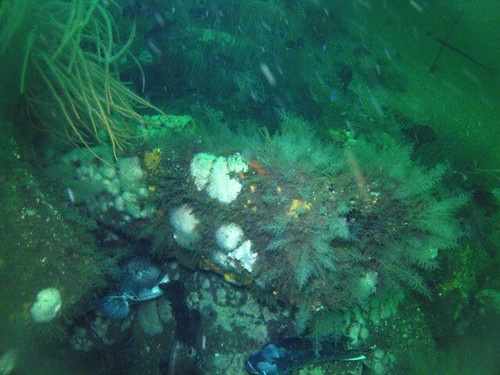
Photo courtesy of Capt. Monty Hawkins
There is only one theory about angling in which I have perfect confidence and this is that the two words, least appropriate to any statement, about it, are the words "always" and "never". - Lord Grey of Fallodon 1899
|  Date : 4/12/2017 (1) Date : 4/12/2017 (1)
| | 4/12/2017 | The Maryland landscape continues to be bathed in warm sunshine and warm temperatures; spring is definitely here and presents some wonderful opportunities to enjoy the outdoors with family and friends. There are few experiences that can match spending time in the outdoors with children. We all have or will spend time sitting along the sidelines watching kids play baseball or soccer but when it comes to one on one personal time in a quiet setting few things can rival fishing with your children or a few of your children's friends. If you're an empty nester there is always the "rent a kid" program where you can take the children of someone you know or neighborhood kids for a fishing adventure. This father and daughter duo teamed up for some trout fishing and made some lasting memories together.
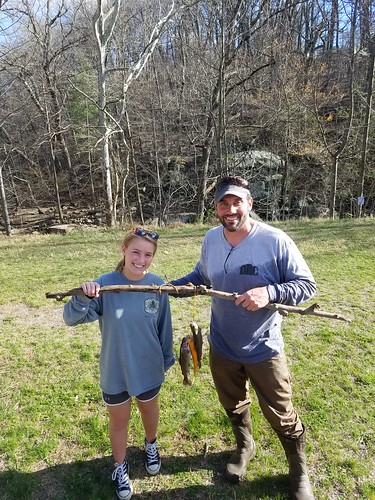
Photos by David Costopoulos
This coming Saturday is a big day for Chesapeake Bay fishermen, April 15th marks the opening day of the Trophy Striped Bass Season where anglers have a chance to catch a striped bass over 35". Many will go 40" or better and the fishing will only get better in the following two weeks as post-spawn striped bass exit the spawning rivers and look for something to eat before heading out into the ocean. The weather looks good for the weekend, there has been major spawning in the middle and lower bay spawning rivers for the last week and a half so the fishing should be good. Spring tides have caused some floating wood debris in the bay so keep a sharp lookout when trolling current breaks. Good luck to all, be safe and remember to have a good time. It'll be crowded out there for sure so turn up your patience knob a bit and try to let boating etiquette offenses go without conflict. Just keep in mind that it is all about smiles and fun together. Here is a shot from last year's spring season to remind everyone what they're after.
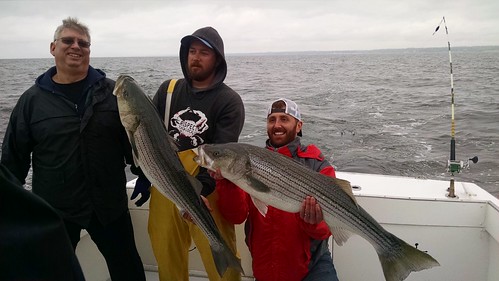
Photo courtesy Andrew Ashby
Fishing conditions in the lower Susquehanna River and flats areas have not been good this week and conditions are not expected to improve before the weekend. There is a great amount of cold and stained water pouring through the gates at the Conowingo Dam. Water temperatures at the mouth of the river are about 49° today and slightly higher in the shallower areas of the flats. Water clarity is poor with visibility less than 18" in the river but clearer water can be found on the east side of the flats. Add to these conditions there is a lot of floating debris covering much of the area made up of large logs and various types of wood.
Those wishing to fish the upper bay this weekend for their chance at a trophy size striped bass will be focusing their efforts for the most part along the steep channel edges of the shipping channel south of the Brewerton Channel. One of the steepest edges is off Podickory Point and will no doubt get a lot of attention from those trolling. The channel edges near Love Point to the triple Buoys will also be popular. If water clarity is an issue chartreuse might out shine white parachutes and bucktails. Hopefully wood debris from farther up the bay will not be a problem but lion's mane jellyfish drifting in the current breaks most likely will. Boats will be seen trolling in and around the Bay Bridge while others try jigging near bridge piers. No doubt a few will trying chunking or chumming along popular channel edges and hopefully those trolling and those chumming can live in harmony.
There will be surf casters present at Sandy Point trying their luck casting bottom rigs baited with bloodworms or cut bait and other prominent points in the upper bay. Fishing for white perch has been good in many of the region's tidal rivers. The white perch are moving down the spawning rivers and spreading out towards their usual summer season haunts. Channel catfish are active and also provide good fishing in the tidal rivers. Here is a fine example of a big tidal river channel catfish that brought plenty of smiles to this happy angler.
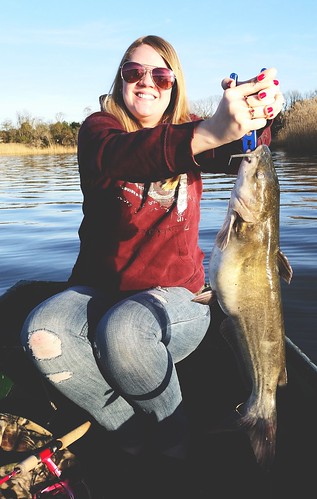
Photo by C.J. Wood
In the middle bay region those looking for a trophy post spawn striped bass may have good opportunities as spawned out female striped bass begin to exit middle region spawning rivers. There has been active spawning in the Choptank and Nanticoke rivers for over a week and the spawning really hit high gear last weekend. Those fish will be hungry and looking for large items to gain their strength and vigor back from the stressful process of spawning. Accelerated current breaks along steep channel edges will be the place to look for them and large baits will entice them to strike. Most trolling spreads will have a mix of white and chartreuse parachutes and bucktails dressed with 8" to 12" sassy shads usually trolled in tandem. Jellyfish are expected to be a problem in regard to fouling lines so cockpits will be busy no doubt, clearing lines. Current surface water temperatures are about 54° so most striped bass will be found in the upper region of the water column until boat traffic drives them deeper.
Those who wish to fish the tidal rivers this week there is plenty of action to be found in the middle bay region's rivers. There is good catch and release action for hickory shad in the upper Choptank River above Greensboro at Red Bridges. Water temperatures at Red Bridges were about 55° yesterday. Blueback herring are also present and of course plenty of hidden submerged snags hungry for shad darts. There are still a few white perch in these areas but most have moved farther downriver and will continue heading towards their summer haunts. Hickory shad can also be found in the upper Marshyhope near Federalsburg.
Crappie fishing continues to be extremely good in the tidal rivers and are often found holding deep near fallen tree tops. Channel catfish continue to be active and this is one of the best times of the year to fish for them with cut bait, chicken livers or worms. In the Dorchester County tidal creeks and rivers northern snakeheads are providing plenty of action for the anglers that fish for them this week.
Lower bay region anglers in pursuit of trophy striped bass should have plenty of opportunities as post spawn striped bass migrate south out of the spawning rivers in the middle bay region and two very important spawning rivers in the lower bay region, the Patuxent and Potomac Rivers. The shipping channel edges near Cove Point, Cedar Point and down to Point No Point and Smith Point will be popular places to troll. In the Potomac River the channel edges near St. Georges Island and Piney Point are go to spots. Water clarity in the lower Potomac will be stained so chartreuse may be a better bet than white but most everyone will have a large enough trolling spread to employ both colors.
On the eastern side of the lower bay the steep shipping channel edges from the CP Buoy off Taylors Island south to below the HS Buoy and Buoy 72 will be good places to troll. The Hooper Island Straits and Tangier Sound channel edges are often a good place to intercept striped bass exiting the Nanticoke River.
Those fishing skinnier waters than the bay continue to find good trout fishing in many of the trout management waters throughout Maryland. The put and take areas are always very popular and stocking crews are working hard to get the trout out and have the stocking posted on the trout stocking website and email service by mid-afternoon of the same day.
Water flows have improved in many areas since late March and water temperatures are about perfect for trout and air temperatures are about perfect for fishermen. This time of the year is a wonderful time to take kids fishing and the put and take trout management areas offer great opportunities for them. There are some streams and ponds set aside for their exclusive use along with blind anglers and some are for the older crowd. They are all listed on the trout stocking website. Brooke Young of Frederick got to go to go trout fishing with her dad and was fishing in Carroll Creek when she caught this trophy sized rainbow trout that they trout hatchery crews raise to enormous size to allow lucky anglers to catch the trout of a lifetime.
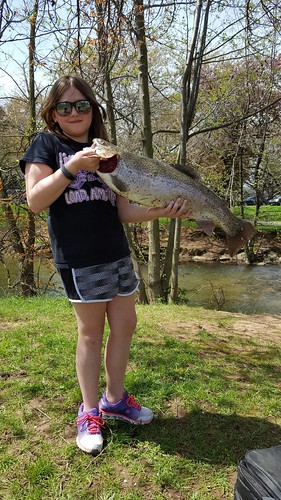
Photo courtesy of Jennifer Young
The upper Potomac is running strong at this time and water clarity is stained but the river is fishable if one is careful. Tubes are the lure of choice for smallmouth bass and walleye worked along current breaks. Fisheries biologist Alan Klotz sent in an Angler's Log commenting that recent surveys show that there should be plenty of good walleye fishing in Deep Creek Lake when the season starts on April 16th.
Farther down the Potomac in the tidal regions, there are reports of stained water and floating wood debris in the main river. The floating wood debris is mostly likely due to recent spring high tides, water temperatures in the river are about 56°. Largemouth bass are staging at the mouths of small creeks and transition areas near the spawning shallows where water temperatures are 60° or better. Swimbaits, stick worms and chatterbaits and spinnerbaits are good choices for baits. If this warm weather continues spawning may begin to occur next week.
Fishing for blue catfish has been very good out in the main stem of the tidal Potomac and fishermen are urged to take advantage of this resource. There are plenty of them with no minimum sizes or creel limits. The large catfish give on heck of a fight as do the smaller ones for their size. The smaller ones make excellent eating and freeze well. Matthew Flynn spent the first day of his spring break fishing with his dad when he caught this blue catfish.
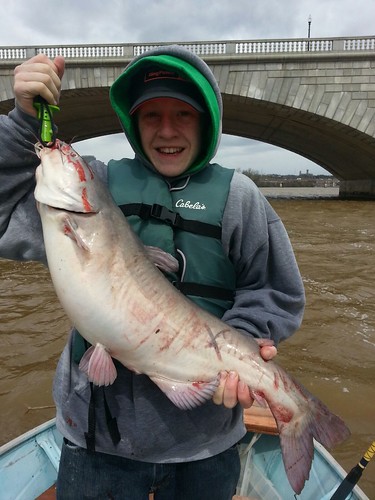
Photo courtesy of Michelle D'Amour Flynn
Fishing for crappie in the tidal Potomac is about as good as it gets this week as crappie can be found holding close to structure such as sunken wood, fallen tree tops and marina docks and piers. I happen to be going over the Wilson Bridge this past weekend and boats could be seen working the spoils area next to the Maryland side of the bridge with spider rigs and spinning tackle. Small minnows or crappie jigs under a slip bobber is a surefire way to catch them and it pays to put some anise on those jigs for further enticement.
Many of the impoundments found throughout Maryland hold good populations of crappie and they can be found holding near deep structure. Fallen tree tops, brush or sunken wood are great places to look for them. Many of the central region reservoirs have excellent populations of crappie as does western region impoundments and those on the Eastern shore.
Largemouth bass are progressing through their pre-spawn phase and it some areas are moving into the spawning areas. Anglers are reminded that fishing for largemouth bass in nontidal waters is strictly catch and release until June 15th. A variety of baits will work for largemouth bass this time of the year, everything from soft plastics to chatterbaits. Due to ideal water temperatures for the bass they can be found moving in and out of shallow waters and near emerging grass and spatterdock fields. Jason Maddox got to go fishing at a local pond near Waldorf with his dad and holds up a whopper he caught on a shallow running crankbait before slipping it back into the water.
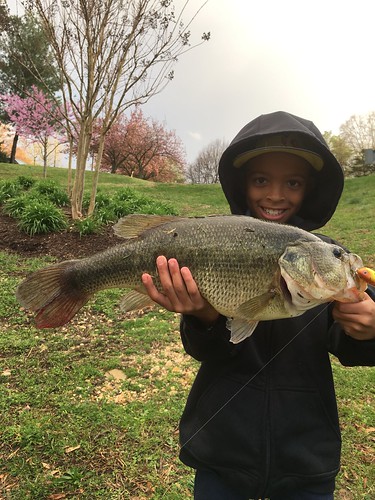
Photo courtesy of George Maddox
Over in the Ocean City area there is some fun catch and release striped bass action in the back bay areas and particularly near the Route 90 Bridge. Most of the fish are around 20" but every now and then there is one that will exceed the 28" minimum. All in all though the fishing is very good and makes for some fun light tackle action. The first flounder caught at Ocean City was reported this week, near the Route 90 Bridge.
Offshore there is excellent tautog fishing at the offshore reef and wreck sites, many of the charter boats are reporting limit catches. Offshore water temperatures at the wreck fishing sites are running around 48°.
"Once in a while", the old man said, "a fellow wants to get away from everything that's complicated and fishing is really the only way I know of to do it". " - Robert Ruark, Fish Keep a Fellow Out of Trouble
|  Date : 4/5/2017 (1) Date : 4/5/2017 (1)
| | 4/5/2017 | The recent warm spring weather we've been experiencing can really get one excited about fishing and the forecast for the weekend looks good. Trout stocking crews are busy this week and warming waters have many local fish in a very active feeding mood.
Last night I had the opportunity to set out in my canoe and drift down the Choptank River through the first substantial striped bass spawning that I've witnessed this year. Warm weather has pushed water temperatures into the upper 50's and that along with a very strong ebbing tide was all it took to get things going. Looking back at my choices, it was probably not a good idea to take my dog with me since she loves fishing and fooling with released fish in shallow water. She was all over it, moving from side to side of the canoe as spawning fish rolled and splashed on both sides of us. I made sure I had my life vest on, just in case we ran into any trouble. All in all she was actually very well behaved despite all the action around us. It was a beautiful evening, bald eagles were patrolling hoping for an easy snack, a turkey was gobbling in the nearby woods and even an otter was enjoying a good swim along the shoreline. I hope that all of you can find a little down time for yourselves, wherever it might be, to enjoy the bounty of nature that we are so fortunate to share here in Maryland.
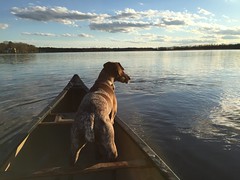 
Photos by Keith Lockwood
Present conditions up at the Susquehanna Flats area do not bid well for striped bass catch and release fishing. There are several gates open at the Conowingo Dam dumping loads of cold stained water into the lower Susquehanna River. Water temperatures are about 46° and water clarity is non-existent. If a trip up to the area is in your plans, consider the east side of the flats where water clarity might be a little better and afternoon sun may warm up the water a few degrees. Crankbaits and jerkbaits with rattles may be a good choice for attracting a strike, swimbaits are often a good choice also. If you go, be prepared ahead of time with all of the optimism an angler can muster so you are ready for a quick and gentle release of these large fish. Lip fish with a glove if you can and keep the fish in the water and if you take a quick picture, support the fish horizontally. If you choose to use bait, circle hooks are mandatory and you most likely will land some nice channel catfish in the process.
The tidal rivers of the Chesapeake are still holding white perch in the upper reaches of the tributaries. Many of the larger white perch have already spawned and can be found holding in some of the deeper holes slightly down river of the spawning areas. As most will find out, the spawning areas are still holding a lot of pre-spawn white perch that are 4" to 6" size range who seem to have arrived late for the annual party. Shad darts and small jigs are perhaps two of the better choices for lures and it doesn't hurt to tip them with a piece of cut minnow, nightcrawler or Fishbites. Anglers will also find a mix of chain pickerel, crappie and various sunfish when fishing these areas. The yellow perch have descended into the middle areas of the spawning tidal rivers and can be found if one looks for them.
A number of tidal rivers have spawning populations of alewife and blueback herring as well as hickory shad. The Anadromous Restoration Program of the Maryland Fisheries and Boating Services has been working very hard to restore populations of river herring and hickory shad in Maryland's tidal rivers. Hickory shad are arriving in several tidal rivers and the first are being caught at this time. The Choptank River above Greensboro, the Marshyhope near Federalsburg, the upper Patuxent and the Potomac River below Great Falls are a few rivers that are providing catch and release fishing for hickory shad this week. . I received a phone call from the field from biologist Matt Baldwin on the upper Patuxent yesterday concerning water temperatures. They recorded 58° at the Wayson's Corner (Route 4 Bridge) area and also mentioned that they electro-shocked four large northern snakeheads while surveying for hickory shad.
Deer Creek is of course a very popular spot for hickory shad but it will be a while before this fishery hits high gear. The hickory shad are in the lower Susquehanna at this time but cold water has them hunkered down and waiting for warmer water temperatures in the mid- 50's before getting excited about spawning. Attractive lures such as shad darts and spoons or colorful sinking flies are good choices for lures. Don Cosden dug into his tackle box and shared with us some of his favorite hickory shad lures and flies.
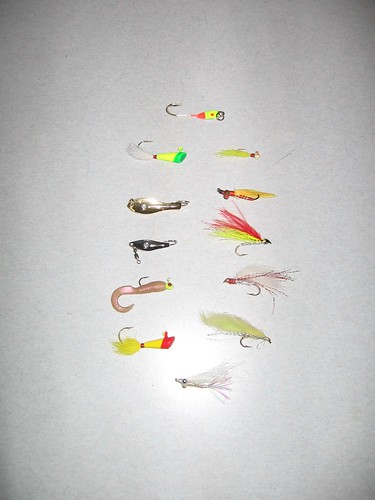
Photo courtesy Don Cosden
The much anticipated opening of the Trophy Striped bass season is only two weekends away for the opener on April 15th. The minimum size this year is 35" and the bag limit is one fish per person per day. Of course everyone wants to get out on opening day but the real action for post-spawn striped bass will not really kick in until about the last weekend of April. The striped bass are at the spawning reaches for the Potomac, Patuxent, Nanticoke and Choptank Rivers and are still arriving at the Susquehanna Flats/River area. There is a minor spawn going on at this time in the upper Choptank River. The recent warm weather got things started this past Sunday and it definitely kicked up a notch on Tuesday and today. The Nanticoke, Patuxent and Potomac usually follow closely to this same schedule so there is good promise for some post spawn striped bass on opening day in the middle and lower bay regions.
At present middle bay region water temperatures are about 50° and steadily rising. On April 15th it might be a good idea for anyone trolling to stick to the steep shipping channel edges in the middle and lower bay regions. Bloody Point Light, Thomas Point and close to the Buoy 84 and 84A will certainly be good places to troll. The False Channel edges and the steep edge out in front of the Little Choptank down to the inside edge of the CP Buoy may be a good place to intercept post-spawn striped bass exiting the Choptank. Often the largest female striped bass are the first to spawn so you might find that fish of a lifetime. Out in front of the mouth of the Nanticoke River, the Hooper Island Straits, Tangier Sound channel edges and just a little north at the steep edges at Buoys 74, 72B and 72A are good traditional places to troll. On the other side of the bay, the Cove Point and Cedar Point channel edges are known hot spots. The steep channel edges in the lower Potomac near Piney Point and St. George's Island will be good places to troll.
Chilly bottom water temperatures will cause large striped bass to be cruising close to the surface as they use the strong currents near the channel edges. Striped bass do not like engine noise so the mass of boats expected on opening day will drive them down quickly. This is definitely a case of the early bird getting the worm. You should plan to be out there at daybreak and if part of your crew is late, apologize later. Planer boards are the name of the game for this type of fishing and crews are forewarned to bring plenty of rubber bands and slide rings when using planer boards. The same stiff currents that attract the large striped bass along the steep channel edges are also carrying the spring migration of lion's mane jellyfish that are headed for the mouth of the bay. This is the time of the year that they drift in the currents and they easily are swept up in current breaks, which is right where you should be trolling. There will be a lot of grumbling in regard to constantly clearing lines but if you're serious that is what you're going to need to do. The old saying that a busy cockpit catches the most fish could not be more on the mark in regard to this situation.
For those without planer boards sending flat lines way back will be the best option but will make you hair stand on end with crossing boat traffic. Large parachutes and bucktails in white or chartreuse will be the most popular colors, both dressed with filleting size sassy shads. Stinger hooks are often popular with these large baits and tandem rigged baits will dominate most trolling spreads. Light tackle fishermen will find some jigging action at the Calvert Cliffs Power Plant discharge and if you can find some good marks on your depth finder, there is no reason why jigging won't catch you your fish. There may even be a few souls out there that will try chumming and they will most likely catch a few fish also.
Last but not least there will be pre-spawn striped bass caught on opening day that is a fact. How you deal with it is your own personal decision and yours alone. If you are on your own boat or a friends, there is a good chance you be out fishing later on after most fish have spawned. If you've booked your "once this season" charter, that is a whole different story. Most will say "a fish is a fish' and certainly no one should be throwing rocks at another fisherman's decision. It does pay to be prepared though if you might release a fish. Rubber mesh landing nets, gloves and a quick release go a long way to reducing stress if a fish is going to be released.
April and trout fishing just seem to be a natural and as the month starts off this fact is true. Stocking crews are working very hard moving trout from the hatcheries to a trout management water near you. This is hard work lifting thousands of trout a day, out of tank trucks and down slippery stream banks. I suspect a bottle of Advil is standard equipment on the dashboard of every stocking truck. The stockings are posted every day that stockings take place and the news is out usually by 3:00 pm the day of the stocking on the trout stocking website or through our email news subscription service.
This a wonderful time of the year to introduce kids to fishing. One does not have to travel far to find a good local fishing spot for either the abundant trout stockings or pan fish. There are a number of trout stocked ponds and streams that are set aside for young children so the odds can be greatly stacked in a child's favor. These sites are listed on the trout stocking website. Local ponds offer some great opportunities also. A Barbie or Spiderman child's fishing outfit, a bobber, hook and a few garden worms and you're all set for some great fun. Grace Ziegler definitely had fun with her dad catching sunfish.
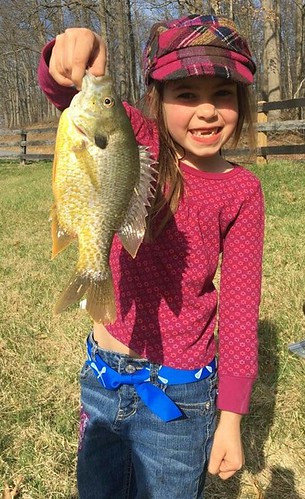
Photo by David Ziegler
The upper Potomac River is running pretty stiff this week so be careful out there and remember your best friend is a PFD that is on your body. The current flows are strong and waters are a bit stained but there is good smallmouth bass fishing in the mid- river current breaks. Tubes are the number one choice for lures. Farther down river in the tidal portion of the Potomac in Maryland waters fishing for largemouth bass is picking up. There are reports of quite a few male largemouth bass staging in slightly deeper water near the spawning areas. Soon they will be making nests to lure spawning female largemouth bass to set up a nursery. Targeting these transition areas and covering a lot of water near emerging grass is a good tactic with lures such as spinnerbaits. If you can find sunken wood or rocks, soft plastics worked slowly near the bottom often works.
In the tidal Potomac the fishing for crappie could hardly be any better right now. Casting small jigs or minnows under a slip bobber near sunken structure has been very productive. Drifting around in a boat with spider rig poles is also a proven way to fill up an ice chest with slab sized crappie. The spoils against the north side of the Wilson Bridge on the Maryland side is a great place to fish as is marina docks in the Fort Washington area. There are plenty of blue catfish in the river and it is not hard to fill up ice chests with some good eating fish. Simple bottom rigs with fresh cut bait will do the job every time.
Over on the Eastern Shore fishing for crappie has been excellent in many areas. The crappie are schooled up near sunken structure such as fallen tree tops or similar sunken wood. The tidal rivers hold good crappie fishing as do lakes such as Wye Mills, Tuckahoe Lake, Smithville Lake and the lakes in Salisbury. Largemouth bass fishing in the tidal rivers has been good and the Wicomico, Pocomoke and upper Nanticoke are great places to fish. Northern snakeheads are more and more part of the mix when fishing in these tidal rivers and they certainly provide some exciting fishing action. Angelina Watts enjoys fishing some of the backwater areas in Dorchester County for them and holds up a whopper for the camera.

Photo courtesy of Ryan Jones
Nearshore water temperatures are slowly rising in the Ocean City area and have hit the 45° mark this week. Surf casters are enjoying some beach time watching lines set with bottom rigs and bait and catching a few striped bass and a whole lot of clear-nosed skates. Out at the wreck and reef sites fishing for tautog has kicked up a notch with some nice fish being caught.
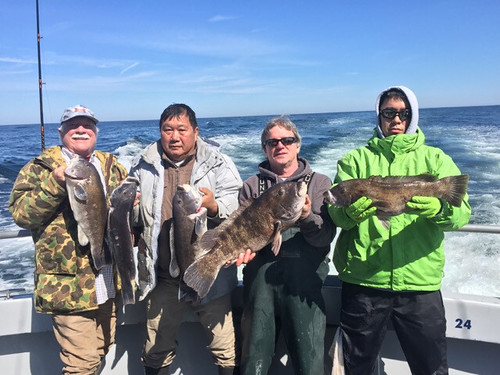
Photo courtesy of Monty Hawkins
Offshore fishing is focused mostly on tautog fishing near the wreck and reef sites. The charter and head boats are reporting fair to good catches on most days.
There has been rumor of a few tautog caught at the Ocean City Inlet area recently and it is expected that those rumors will turn into solid reports shortly. In the back bay area's there is some striped bass action for those casting swimbaits, jigs and jerkbaits. Most all of the striped bass are just shy of 28" but they make for some fun catch and release fishing.
"No man is born an artist nor an Angler." - Izaak Walton |  Date : 3/29/2017 (1) Date : 3/29/2017 (1)
| | 3/29/2017 | Spring conditions throughout Maryland are presenting wonderful fishing opportunities as water temperatures steadily warm up and all manner of fish become more active. Except for some low flow conditions in a few areas, the opening day of the traditional trout season was a big success with beautiful weather and plenty of trout. Parents and children all had a wonderful time sharing in a meaningful experience together. Many children caught their first fish ever or their first trout and for many whether it was their first trout or one of many over the years it was all good fun. Jessica Richard is all smiles with her first trout landed on the second day of trout season on the Little Gunpowder while fishing with her dad.

Photo by Dave Richard
Reports from the lower Susquehanna River this week tell of stained water conditions and water temperatures around 40°. Farther south and in shallow waters out on the flats water temperatures can be as high as 46° on sunny days. A forecast of rain later on this week and continued snow melt in the Susquehanna watershed will probably keep water temperatures depressed for the remainder of the week. Crankbaits and jerkbaits with rattles inside might be one of the better choices for casting under stained water conditions; swimbaits are another good choice when catch and release fishing for striped bass in the Susquehanna Flats catch and release fishery. Since this is a catch and release fishery, mashing down the barbs on hooks or filing them down will go a long way in quickly releasing fish.
White perch are still providing plenty of entertainment in the upper bay tidal rivers and creeks. Water temperatures are in the upper 40's in most areas and white perch fishing continues to be good. Post-spawn white perch are becoming a more common catch this week mixing in with the pre-spawn perch. Shad darts, small jigs and bait such as minnows and worms have been popular choices. Crappie are often being found in the same areas as the white perch and can add a substantial portion to the catch. Channel catfish are very common in the upper bay tidal rivers and can be caught on worms or cut bait. John Horgan holds up a nice channel catfish he caught in Bush Creek while fishing with cut bait.
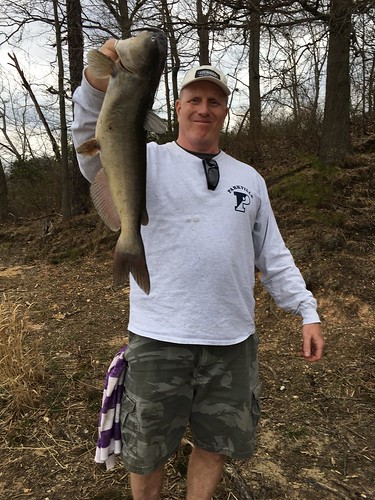
Photo courtesy John Horgan
Water temperatures in the middle and lower bay regions are holding around 46° this week. Windy conditions have kept most off the more open waters of the bay recently but calmer conditions will most likely bring out a few catch and release fishermen this coming weekend. Most will be jigging in order to enjoy the best part of catch and release fishing rather than trolling. Whichever type of tackle you use, be sure you use heavy enough tackle followed by a quick release.
Those who will be out trolling all manner of parachutes, bucktails and umbrella rigs will no doubt run into lion's mane jellyfish during this year's Spring Trophy Striped bass season. The lion's mane jellyfish begin their life cycle in the bay in late fall and develop into adults over the winter. They have an orange-brown center, short tentacles and are about 6" in diameter this time of the year. They begin their exit down the bay around now, and usually by May they are gone from our portion of the bay. Clearing fouled lines is a chore and often it is a busy cockpit that tends to have the best success when it comes to trolling.
Fishing for white perch continues to offer bountiful fishing opportunities in the upper reaches of the tidal rivers in the middle and lower bay regions. Water temperatures are in the mid 50's in most areas and although the white perch continue to spawn; this may be the last week of major spawning activity. Recent catches have been a mix of post- spawn and pre-spawn white perch. In many cases finding a spot with a deep hole can lead to the best catches of decent size white perch. Small jigs and shad darts are a favorite and minnows and worms on work well also.
Hickory shad are starting to show up in the upper reaches of tidal rivers such as the Choptank River and can offer some fun catch and release fishing opportunities. The area of Red Bridges between Greensboro and Goldsboro is always a great place to fish for both white perch and hickory shad. Shad darts tend to be one of the better choices when fishing for hickory shad.
Crappie fishing has been very good recently in the upper reaches of the tidal rivers throughout the state and also ponds and reservoirs. The crappie tend to be holding near sunken brush or similar structure such as marina docks and fallen tree tops. Slowly working small jigs or minnows under a slip bobber around some of this type of deep structure is a proven way to catch crappie and where there is one there is usually more. Jay Yesker shows what is possible when working a small jig under a float near structure for crappie. Jay was fishing at an Eastern Shore lake recently.

Photo by Jay Yesker
Channel catfish are very active and can be found in most of the tidal rivers feeding into the bay. Cut bait is a great way to catch them and catching a few small white perch on worms is a very good fresh cut bait to use. In the tidal Potomac River blue catfish are very active and provide plenty of action for those who fish for them.
After Saturday's traditional opener of closure 1 and 2 trout management waters, Maryland's trout fishing season is in full swing this week. Stocking crews on out working overtime to keep the flow of trout coming in the many put and take areas. There has been some adjustments due to low flow conditions in some waterways such as the lower Gunpowder River and other areas saw trout moving from stocking locations to find suitable water depths to their liking. All in all it was a beautiful day for the opener with balmy weather and plenty of smiling kids and happy parents. Trout fishermen can obtain notice of current stocking on the day they occur by checking the trout stocking website or by receiving notice on the Fisheries subscription service. The stockings are usually posted by mid-afternoon of the day they are completed. Brothers Matthew and Ryan Bishop got to go trout fishing with dad at Fishing Creek and judging by the smiles had a great time together.
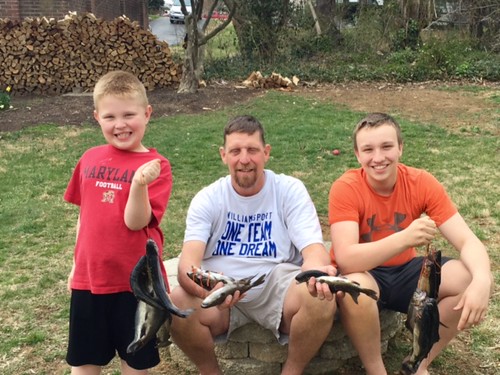
Photo courtesy Sherry Bishop
The upper Potomac River is a little high this week but in good shape for fishing. Rain fall later on this week may cause water levels to increase further so it pays to keep an eye on weather conditions. At present fishing for smallmouth bass has been good and tubes tend to be the lure of choice. Walleye fishing has also been good.
Fishing for largemouth bass has been very good in the ponds, reservoirs and tidal waters of Maryland this week and will tend to be extremely good as the bass respond to warmer water temperatures and actively feed. Water temperatures are generally in the mid 50's in most areas and largemouth bass are holding in transition areas leading up to the shallower spawning areas. They tend to be holding near sunken wood and some of the emerging grass beds. Spinnerbaits are a great lure to use when trying to cover territory and when targeting sunken wood, soft plastics are hard to beat. Travis Franklin sent in this picture of a Lake Allen largemouth bass he caught recently.
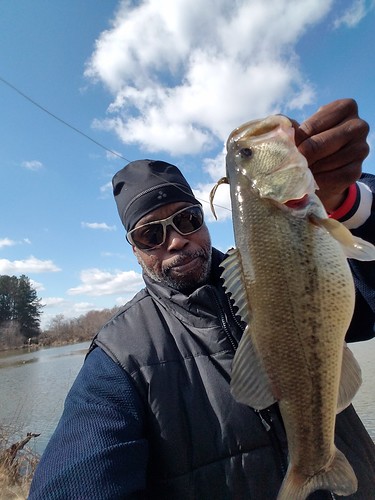
Photo courtesy of Travis Franklin
The coastal waters in the Ocean City area are slowly beginning to warm up. At present nearshore water temperatures are about 43°. It will not be too long before tautog begin to move into the inlet area and provide some shoreline fishing opportunities. In the meantime there has been some catch and release action for striped bass in the back bay areas near the Route 90 Bridge. Most of the striped bass being caught are under 28" in length but do provide some fun fishing opportunities. Swimbaits and bucktails tend to be the best choices when fished near the bottom.
Offshore fishing is focused mostly on tautog fishing near the wreck and reef sites. The charter and head boats are reporting fair to good catches on most days.
"There is no substitute for fishing sense and if a man doesn't have it, verily, he may cast like an angel and still use his creel largely to transport sandwiches and beer." - Robert Traver
|  Date : 3/22/2017 (1) Date : 3/22/2017 (1)
| | 3/22/2017 | This coming Saturday will be an exciting day for put and take trout fishermen throughout Maryland as Closure 1&2 trout management waters open up for what can be considered the traditional opening day of Maryland's trout season. This is a wonderful time to gather up the family or neighborhood kids for a rite of spring. If your trout fishing posse has some youngsters in it, be prepared with an extra set of dry foot wear and pants. It goes without saying that kids near water will get wet and muddy and will be smiling and laughing the whole time.
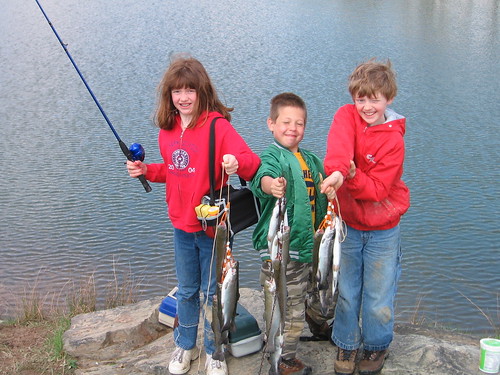
Photo courtesy of Alan Klotz
The recent snow that blanketed much of the northwestern side of the state is beginning to melt and has resulted in water temperatures in the lower Susquehanna River dipping to about 42° at the present time. The Conowingo Dam is operating under modest water releases during late evening and early morning hours. These factors have checked the progress of hickory shad and striped bass staging for upcoming spawning activity. Both species have arrived in the lower parts of the river and a few hickory shad are being caught up near the dam pool. Striped bass are present and those participating in the catch and release fishery are reminded to use barbless hooks, and to stay below the spawning reach line that runs from the Susquehanna State Park boat ramp to Twin Rocks to Tomes Wharf in Port Deposit. Natural Resource Police officers are present in the area, enforcing regulations (no fishing in the spawning reach for striped bass) and are warning anglers that striped bass must be released immediately in the legal Susquehanna Flats Catch and Release area. Striped bass are to be released immediately by law, so be prepared to unhook fish quickly in the water and if you must pose for a picture, be prepared ahead of time, support the fish horizontally and do it quickly, very quickly.
White perch spawning runs are now replacing the yellow perch runs and good white perch fishing can be found in most every tidal river in the upper bay. A variety of baits and lures will do the trick when the perch are running but small fish will often dominate the catch. Lures such as shad darts and small Mr. Twister plastic tails on a 1/16 or 1/8 ounce lead head help to keep things going as one sorts through fish to be released. A small piece of minnow or your favorite fish juice on the shad dart or lead head jig/twister will help a lot. There is also plenty of channel catfish and crappie action in the region's tidal rivers and creeks and offer additional opportunities.
There is some good news for fishermen who like to catch their own minnows. The Fisheries Service has revised the regulations concerning the use of minnow traps by those who do not own waterfront property. A minnow trap may now be set in tidal and non-tidal public waters except trout management waters if your Maryland DNR ID is attached and you are present within 100' of where the trap is set.
The Spring Trophy Striped Bass Season will kick off on April 15th , which is not far off, so everyone is getting a bit anxious. The minimum size this year will be 35" measured as a total length (to the tip of the tail, NOT fork length). The striped bass are moving up the bay and into the spawning tidal rivers. They are the Potomac, Patuxent, Nanticoke, Choptank and Susquehanna Rivers. Despite the unusually warm weather in February, everything looks on track for a normal mid-April spawn.
In the middle bay area a few boats can be seen practicing some trolling catch and release fishing along channel edges in the main part of the bay with barbless hooks. Most will agree these fishing forays are mostly to shake the bugs out of gear and the winter blues. Light tackle jigging at the Calvert Cliffs Power Plant warm-water discharge is popular every winter and early spring, as striped bass nose into that warm water to gain some relief from 43° water in the middle bay region. Anglers have also been catching a few speckled trout and small red drum in the discharge.
The tidal rivers in the middle bay region are alive with runs of spawning white perch and they provide some fun light tackle action in the upper reaches of the tidal rivers and creeks. Baits such as minnows and grass shrimp will work, but due to the fact that one must sort through large numbers of small fish, lures such as shad darts will go a lot farther. Water temperatures in the upper reaches of the region's tidal rivers is running about 45° this week so it may be a while before water temperatures hit the 50° mark, which starts the spawning process. Fishing for channel catfish has been good in most of the region's tidal rivers and crappie and chain pickerel are also very active. Angelina Watts poses with a nice Tuckahoe River chain pickerel before releasing it recently.
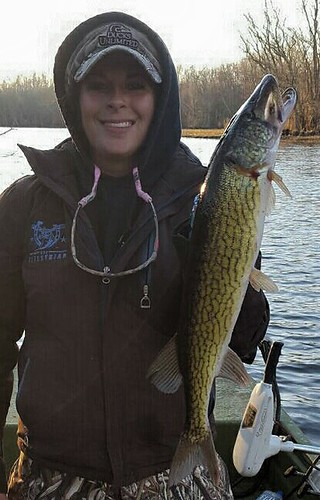
Photo courtesy of Ryan Jones
The lower bay region of Maryland's portion of the Chesapeake Bay has been offering some light tackle jigging catch and release action around the Point Lookout area near channel edges. This is perhaps the most fun type of catch and release fishing, just remember to file off or squash down the barbs on your jigs. A few boats will be seen out trolling and practicing some catch and release fishing while shaking out the cobwebs in gear and boats. Barbless hooks and a quick release are a must, so make sure everyone on board knows what the drill is ahead of time.
This coming Saturday, March 25th , will mark the traditional opening day of trout season in the put and take closure areas 1 and 2. The weather forecast could hardly be better with warm temperatures predicted. This is a great time for kids to enjoy some trout fishing success with relatively simple gear. A light spinning outfit, a simple hook and split shot rig and good old Powerbait, or old fashioned garden worms. The trout hatchery staff have worked very hard this year to bring Maryland trout fishermen the best trout possible despite water flow difficulties at the Albert Powell Hatchery. In season trout stockings can be found on the trout stocking website.
Fishing for a mix of yellow perch, walleye and smallmouth bass has been improving along the shorelines of Deep Creek Lake. Minnows on a slip bobber are hard to beat when targeting yellow perch and walleyes. Smallmouth bass can be found near rocky points and targeted with crankbaits and jigs that resemble crayfish. Northern pike and chain pickerel are active and fishermen are urged to look for tags on northern pike as part of ongoing research. Project manager Matt Sell has posted an angler's log describing the program.
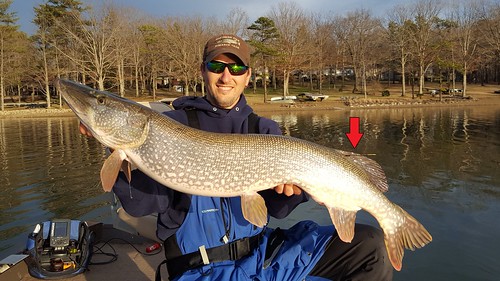
Photo by Matt Sell
John Mullican reports that water temperatures in the upper Potomac dropped almost 15° due to snow melt recently. He added that walleye fishing has been good and that most of the walleye have spawned and hopes are high for a good year class of reproduction. Fishing for smallmouth bass will improve as water temperatures warm up in the next week or so. Steve Peperak holds up a beautiful spawned out upper Potomac walleye for the camera before slipping her back into the river.
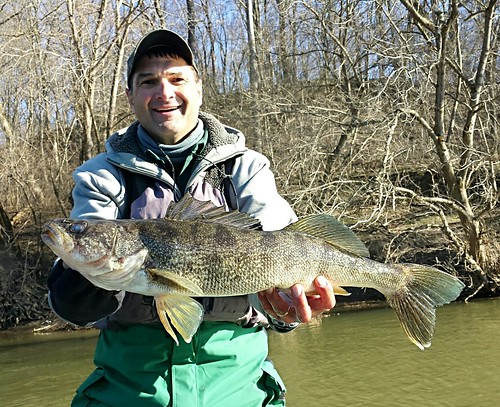
Photos by John Mullican
Water temperatures in many of the ponds, lakes and tidal waters where largemouth bass can be found are warming up and fish are becoming more active. Water temperatures have reached 50° in some areas. Lures such as spinnerbaits are a great way to cover a lot of water near sunken structure or channel edges. Crankbaits would also be a good choice when working these transition areas in slightly deeper waters. Crappie are holding near structure and small jigs or minnows under a slip bobber are a great way to target them. Bluegills are active and can be caught on small flies, jigs or a simple bobber worm combo.
The fishing scene at the Ocean City area mostly revolves around fishing for tautog at the offshore reef and wreck sites at this time. Water temperatures close to shore are holding around 44° this week. The catches have been fair to good when sea conditions allow offshore trips. There was a pulse of Atlantic "Boston" mackerel that passed by our Maryland shores in early March and a few lucky boats and anglers were able to get a taste of what used to be a spring rite 30 years ago. Here is a lucky angler with 4 mackerel caught at one time on a classic "mackerel tree" and diamond jig rig. This is the same rig that was used on the party and charter boats back in the 1980's and early 90's. The mackerel tree rig consists of multi-colored small pieces of surgical tubing ("hoses") tied into dropper loops on a monofilament leader. The bottom of the rig is weighted with a bank sinker or preferably a shiny diamond jig ranging from 3 – 8 ounces to provide some extra flash.
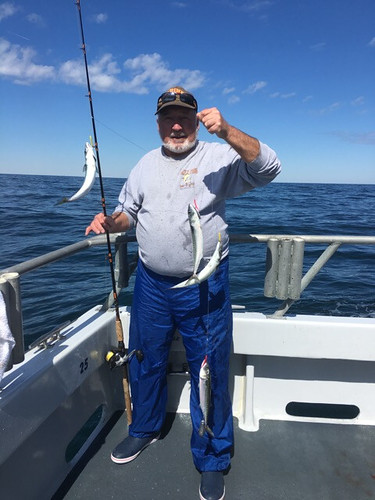
Atlantic "Boston" mackerel photo courtesy of Capt. Monty Hawkins
The 2017 summer flounder regulations have been set at a 17" flounder with 4 per day starting April 1st through December 31st. (Note- the summer flounder regulation currently in the books is 16" fish and 4/day, BUT this will change on April 1!). Sea bass season will start on May 15th through September 21st and pick up again on October 22nd and run through December 31st with a daily creel limit of 15 fish per day and a 12.5" minimum. Tautog is open till May 15th at 4 fish per day and then switches to 2 fish per day from May 16th to October 31st, the daily creel limit returns to 4 fish per day from November 1st to November 26th and the minimum size is 16".
"Perhaps the greatest satisfaction on the first day of the season is the knowledge in the evening that the whole rest of the season is to come." - Arthur Ransome
|  Date : 2/15/2017 (1) Date : 2/15/2017 (1)
| | 2/15/2017 | Mid-Winter Fishing Update
February tends to be a tough month for playing outdoors. Most hunting seasons are closed and it is a little bit early for comfortable fishing. Fortunately the trout production program and the many fisheries biologists that stock the trout have given fishermen a chance to enjoy good trout fishing in the put and take trout management waters across the entire state as part of the pre-season stocking program. It is a little early for yellow perch but those that give it a whirl are finding a few male yellow perch here and there in the tidal rivers. There are fishing shows just about every weekend this month and into March. During this time of the year, many start to think about buying a new fishing license. Remember that fishing licenses now go 365 days from the date of purchase, so check the date on your current fishing license.
The lower Susquehanna River near Perryville has been offering some of the most consistent yellow perch fishing to be found right now. The typical pattern for this time of the year is that the yellow perch congregate in about 40' of water just below the Route 40 Bridge. This is vertical fishing for the most part from small boats or kayaks when weather conditions are favorable. Most prefer to use a sinker with a Christmas tree type rig with two dropper flies or small soft plastic jigs in the 1/32 oz. to 1/8 oz. size category. Tipping the lures or flies with a small piece of cut minnow or a dip in your favorite fish attractant juice can often pay better dividends.
Farther upriver and closer to the dam pool there has been some productive fishing for flathead and channel catfish. The flathead catfish tend to be in the 3lb. to 5 lb. size range in the river below the dam pool. The whopper sized flatheads tend to hold in the dam pool below the turbines where lunch consisting of mostly gizzard shad is served during power generation.
In the upper, middle and lower bay regions, most anglers have their favorite places to check in the tidal rivers and creeks as they look for the vanguard of the spring yellow perch run. This usually consists of male yellow perch and a few can be found here and there at traditional locations. Water temperatures in the tidal rivers and creeks are generally in the low "forties" (40° - 44° range) right now due to a relatively mild winter. This water temperature range is relatively close to the 46° mark that will start the spawning event. The young male yellow perch want to be the first ones to show up for the party, so they are beginning to stage in deeper areas below the spawning reaches. John T. McMullen holds up a nice yellow perch for the camera.
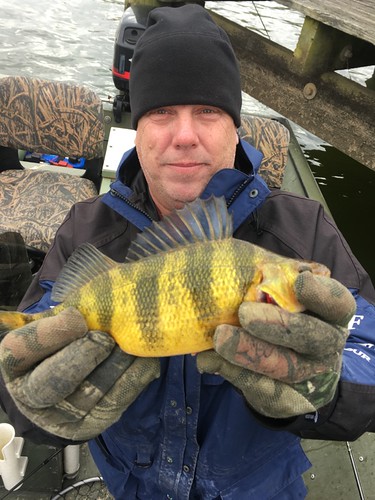
Photo courtesy of John T. McMullen
Generally speaking, water temperatures between 48° to 54° will show the greatest amount of spawning activity. Traditionally the tributaries on the western side of the bay will be a little warmer than similar waters on the eastern side of the bay at the same latitude. Yesterday the surface water temperature at Hillsboro on the Tuckahoe River was 41°. The 2013, 2014 and 2015 were good year classes of yellow perch and the 2011 year class of yellow perch was a dominant year class. It takes about 3 years for a yellow perch to reach 9" so the 2011 year class should provide some nice yellow perch in the 12" or better size range. John Horgan holds up a nice yellow perch he caught in the Gunpowder River while using live minnows.
The section of the Bush River called Gray's Run is starting to get the attention of local yellow perch fishermen as is the Wayson's Corner area on the Patuxent. There is a scattering of male yellow perch at these locations with a large portion of them being undersized. Now is the time to get your favorite tackle together. If you are a bank fisherman it is hard to beat braid for its fine diameter which helps one be able to cast a country mile. Usually a 2' piece of 4 lb. to 6 lb. fluorocarbon or mono tippet is tied on to fool the perch but also allow one to break off on those pesky submerged logs and branches that always seen to reach out grab your jig or hooked minnow. If you can come up with an educated guess on how deep the holes are that you're fishing (and yes that is where you want to be) a small 1/32 oz. soft plastic jig or hair jig under a bobber is a great way to fish. Often the bobber will need to be 4' or more above your lure or lures. If fishing this way I like the small foam type that you can slide up and down the line for adjustment; allow the light jig to sink to the proper depth and reel in slowly while giving a twitch now and then. Another way to fish is to up to a 1/16 oz. jig, a Mickey Finn type streamer fly or use a minnow with a split shot a couple of feet ahead; when fishing this way I like to keep my rod tip up high with a belly in the line and you will see it twitch in the line when a perch picks up your offering. Another tip is to not forget small shad darts, they work also whether tipped with a little piece of minnow or your favorite fish attractant juice.
Spawning runs of yellow perch and white perch are governed largely by water temperature so a warm day might spur things on and a cold day cause things to retreat. This type of fishing is often categorized by the familiar replay to how is the fishing? "Well you should have been here this morning or yesterday". It is something up to debate among fishermen but I have always placed my bets on a low flood tide during the warmth of the day. The following link will take you to our yellow perch fishing location maps on our fisheries website.
The annual winter trawl survey is just about completed on the upper bay and the lower regions of the major tidal rivers. This survey work is conducted by pulling a 25' trawl along the bottom by the research vessel RV Chesapeake to monitor resident populations of white perch, yellow perch, striped bass, catfish and forage fish such as gizzard shad. Species are sorted, measured and counted at predetermined locations the same way each year so comparisons can be evaluated. I recently was able to assist in the survey work and as one would expect this time of the year; the perch and other species were holding in deep areas at the mouths of the upper bay's tidal rivers.
 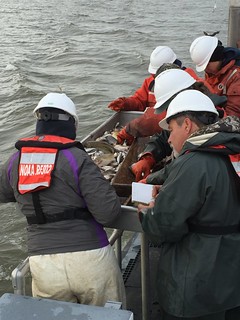 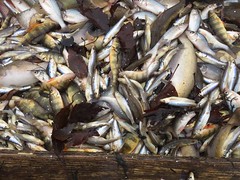
Photos by Captain Mike Simonsen and Keith Lockwood
The Spring Trophy Striped Bass Season opens on April 15th this year and for those who may be guessing on the opening day, it is set every year as the third Saturday of April. There has been some catch and release action at the Calvert Cliffs Power Plant warm water discharge for those seeking a little jigging action. Most of the striped bass being caught and released are in the 30" size range. Traditionally the large spring migrants will begin to show up at the discharge sometime in March. Surface water temperatures in the middle bay region are about 40° this week.
There is some deep water jigging action to be found in the deeper channel areas at the mouths of the major tidal rivers and some locations in the bay for white perch. For example there have been reports of white perch being caught in the lower Patuxent River in about 60' of water. A decent sized sinker with two dropper flies is the usual offering to get in on this early season action.
One of the most active fisheries in tidal waters this time of the year is fishing for blue catfish in the tidal Potomac River. The Fort Washington area tends to be the central location for the best fishing. This time of the year in particular is one of the best times to target trophy sized blue catfish if you're looking for a tussle. If you are looking to fill your freezer there are also plenty of medium-sized blue cats in the region. The fresher the better is the name of the game, when it comes to cut bait for blue catfish and a simple bottom rig and stout tackle is all that is needed.
The pre-season trout stocking in many "put and take" trout management areas is well under way this month and trout fishermen from the Eastern Shore to the far western regions of the state are enjoying some fun and productive fishing. These stockings offer something for everyone from those casting nymphs and wet flies with fly tackle to ultra-light spinning tackle and a pea sized piece of Powerbait on a hook. The stockings are posted as they occur on Maryland Department of Natural Resources Fisheries Facebook, on the email subscription lists, and on the trout stocking website
Also of interest to trout fishermen are the ongoing water supply issues at the Albert Powell Trout Hatchery that will have an effect on the upcoming spring and fall trout stocking schedules. Hatchery staff are working hard to maintain and stock trout while working under tough conditions. For more information, readers can go to the following link on the Department of Natural Resources Fisheries website to learn about the situation.
Jonah Lee got to go trout fishing recently at Antietam Creek and he sure is happy with this golden rainbow trout he caught
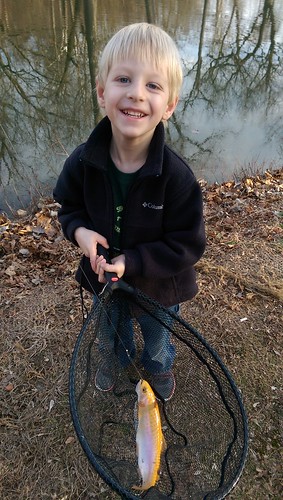
Photo courtesy of Jonah Lee
Western Region fisheries biologist Alan Klotz sent us a great report this week.
Anglers should find some good trout fishing in Western Maryland's smaller trout streams this weekend. The weather forecast predicts sunny skies with daytime temperatures in the 50's. Last weekend the weather was warm, but stream flows were high. I fished for brook trout in a small stream within the Potomac State Forest, and had good success using a black woolly bugger fished in the deeper, slower pools.
Deep Creek Lake has no ice cover, and this weekend may be a good time to try and catch a few walleye before the season closes on March 1 through April 15. The Fisherman Access Area at the Route 219 Bridge is an excellent place to fish from shore for walleyes. Best time is right at dusk using sinking Rapalas or live shiners. I'll be there this weekend - and hopefully sharing some pictures on the Angler's Log!
Fisheries biologist John Mullican fished the upper Potomac last weekend and was kind enough to send us this report and a picture of Charlie Dolan and a fine looking upper Potomac walleye.
The Potomac River is in great shape, but a little below normal flow. River temperatures are now in the low 40s thanks to the recent warm weather and fish are becoming more active. Smallmouth bass and walleye fishing has generally been very good, though severe cold snaps can shut the action down briefly. Tubes and hair jigs are still the most reliable baits for smallmouth with suspending jerkbaits beginning to pick up some of the larger bass. Crankbaits and jigs have been getting steady attention from walleye. Due to a strong year class in 2015, most of the walleye are running between 14" - 16" though fish over 20" are still available.

Photo courtesy of John Mullican
Chain pickerel are comfortable in cold water and are eager to chase down most any offering coming their way in tidal waters or lakes and ponds. Crappie are also active but tend to be holding close to structure in deeper waters as are largemouth bass which are holding close to the bottom in the deepest waters. Small jigs or minnows will work well for crappie and the largemouth bass may be enticed to bite on blade lures or soft plastic jigs worked slowly and close to the bottom.
Fishing opportunities over near the Ocean City area are a bit sparse this time of the year with offshore tautog fishing being the best show in town. The day's success can vary from fair to good depending on the mood of the tautog and sea conditions. Surf fishermen might find a little entertainment with spiny dogfish and skates. Ocean water temperatures are holding around 45° this week.
"Once in a while," the Old Man said, "a fellow wants to get away from everything that's complicated and fishing is really the only way I know to do it." - Robert Ruark, The Old Man And The Boy |  Date : 1/25/2017 (1) Date : 1/25/2017 (1)
| | 1/25/2017 | Mid-Winter Fishing Report
It is not hard to notice that the weather this winter has been like a Yo-Yo in regard to air temperatures. This is great for those who have a hard time staring at their fishing tackle as they pass through the garage every day. Fortunately for those who enjoy an hour or so of light spin tackle fishing there are fishing opportunities close to home in the upper reaches of the bay's tidal rivers and creeks or lakes and ponds. This is of course the time of the year where fishing shows and flea markets abound. It is a great time to browse and pick up a few bargains and get out with family and friends and make a day of it. It is also a time to spend evenings or rainy weekends going over tackle; swapping out line, and checking ceramic guides and reels. Check your tackle now, while there is still time to get professional help at a local tackle shop (if you can't fix it yourself). In regards to fishing line, if you don't swap out last year's line, at least pull off the first 20 feet and discard of it properly. No one likes to see a little curl at the end of their line where a knot failed on the largest fish you ever lost. At the very top of the Bay there have been some limited fishing opportunities for yellow perch in the lower Susquehanna River. The fish are reported to be as deep as 40' which is normal for this time of the year. The action tends to be a bit unreliable but most likely will be more stable later on in February. Due to the current in the river and sometimes a steady wind; it will take some weight to get down to the perch. Often a sinker with two dropper flies, small soft plastic jigs or similar soft plastics are employed. A drop shot rig with a small soft plastic bait or a live minnow is also a good choice. Tipping jigs or flies with a piece of worm or cut minnow never hurts to help attract the attention of yellow perch that are in a lazy mood close to the bottom. The area below the Route 40 Bridge and in front of the condos in Perryville has always been a popular spot. There is other action to be found in the lower Susquehanna River up closer to the dam. The flathead and channel catfish are active and can be caught on cut bait below the dam pool. The water releases from the dam have been variable with afternoon releases and extremely low flows during the morning periods. Farther down the bay there is action to be found in the tidal rivers and creeks on both sides of the bay for a mix of chain pickerel, yellow perch and a scattering of white perch, crappie and largemouth bass. The yellow perch in these protected and relatively shallower areas can be targeted from shore or small craft such as kayaks. This type of fishing is perfect for ultra-light spinning tackle. A small streamer fly such as a Mickey Finn or similar pattern in purple is a great choice with a split shot or two about 3 feet in front. The retrieve is slow once you feel you're on the bottom and often there is no telling what might pick up the fly. A minnow can also be fished this way when hooked through the lips. Small soft plastic jigs are also a good choice if fished slow and close to the bottom. There has been spotty action in regards to yellow perch in a variety of tidal rivers such as the Choptank River, the Nanticoke near Marshyhope Creek and the upper Patuxent. Most of the perch being caught are males. John Hogan braved some chilly temperatures on the upper Gunpowder and shows off a nice yellow perch caught on a minnow.
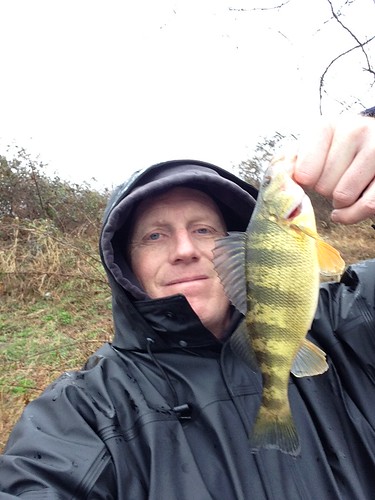
Photo courtesy of John HorganChain pickerel love cold water and are very active this time of the year. The aquatic vegetation is down, which means that pickerel will often be holding near sunken wood structure such as fallen tree tops. They are an ambush predator and lash out at anything that comes by them. Jerkbaits, crankbaits, spinnerbaits, spoons, spinners and soft plastics will all get their attention. They often attack with abandon so try to be careful with treble hooks and have pliers handy. Torn and bloody gills are usually the kiss of death for these entertaining fish. Many who live and fish in the Gunpowder River area are well aware of the fish kill that occurred in Late December. Images of dead carp and other species was not a very welcomed way to finish out 2016. The Maryland Department of the Environment was the primary investigator into the fish kill and they have recently published a report on their findings.
The report makes for some interesting reading. The tidal rivers of the middle and lower bay hold much of the same action focused around a mix of chain pickerel, yellow perch, crappie and channel catfish. Sunny and mild days will tickle most fidgety anglers into heading out to local fishing spots to have a little fun. For those looking for a little action out on the bay there has been some talk of a little catch and release jigging action for striped bass in the channels between Cedar Point and the Buoy 72 area as well as the mouth of the Potomac. The Calvert Cliffs Power Plant warm water discharge always holds some manner of striped bass during these cold months. Drifting in the discharge wash and jigging with soft plastic or butterfly jigs is the ticket to this catch and release show. Anglers on the lower Potomac can give the Morgantown Power Plant warm water discharge a try for some of the striped bass that have their noses in that warm water. Freshwater anglers at Deep Creek Lake are wishing for colder weather so they can have some hard water fishing opportunities. They came close earlier in the month with some coves freezing up with marginal ice but that is all gone now and the lake is completely open. The state boat ramp is usually open when temperatures are above freezing but anglers should check ahead of time by calling the Deep Creek Lake State Park office or the Discovery Center. As one can imagine, dripping water from boat trailers being hauled out can turn the ramp into a one way icy slide into the lake. Yellow perch fishing has been good off of main point drop-offs in about 25' of water and the hump out in front of the state boat ramp is always a go to place. The perch are right on the bottom and offerings of small jig/minnow combos should be worked very slowly. Silver Buddy blade lures are also a good choice and walleye can often be part of the mix. John Mullican sent in the following report from the upper Potomac River.
"Recent steady rain is causing significant rises on the Potomac River and tributaries. Most gauging stations will show crests Wednesday and Thursday, but levels will still be well above safe levels into the weekend. The mild beginning to 2017 has Potomac temperatures near 42°F and fishing has been good. Unless severe winter temperatures return, experienced river anglers can expect a mixed bag of smallmouth bass, walleye, and muskie when the river returns to normal levels. Winter is a great time to catch trophy sized fish, but anglers will need to take precautions to stay safe and slow down, way down, to be successful. In general, lightweight jigs presented very slowly along the bottom will elicit that slight "tap" through the rod that signals the offering was inhaled. Dress warm, wear your PFD, and don't forget to get your fishing license!" Steve Peperak holds up a beautiful upper Potomac Smallmouth bass before slipping it back into the river.
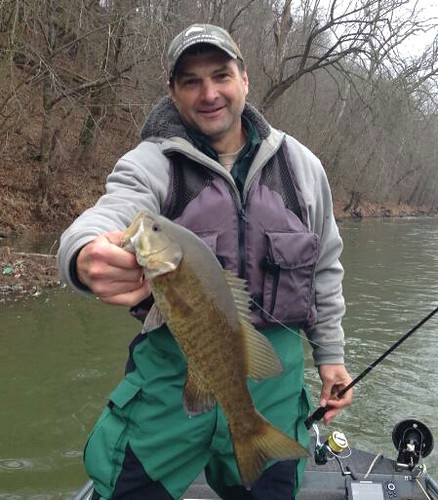
Photo courtesy of John MullicanPre-season trout stocking will begin soon in many of the trout management waters slated for such stockings. Once they begin, they will be a great incentive to get out and fish. Trout hatchery staff have been working hard to supply fishermen with the best trout possible. Recently I made a stop at the Albert Powell Trout Hatchery and I can tell you there are some amazing trophy sized trout being held for the spring stockings. Warmer temperatures have caused ponds and lakes throughout Maryland to be open except for a few small ponds that might ice over in the next couple of days in the far western region. Largemouth bass are hunkered down in the deeper waters waiting out winter. Small lures such as blade lures and jigs worked close to deep structure can entice them to pick up a lure but those pickups will be very subtle. Crappie can also be found close to deeper structure and can be caught on small jig/minnow combinations. This young angle takes a last look at a nice largemouth bass he caught in Bear Creek before releasing it.

Photo courtesy of Sean AllenOcean City area fishing has been focused mostly on offshore tautog fishing, and the action has been described as fair at best. When you factor in the rough conditions, the picture is not too inviting, except for the more hardcore "tog" or "blackfish" anglers. It takes some sand for sure to venture out on cold and often rough seas to try entice a few tautog to bite on a piece of green crab. Keep checking in with the party boats and other coastal contacts, since there is potential for a fair to good winter tautog bite off Ocean City if the wind and sea conditions calm down and stabilize during improved weather windows over the next few weeks.
"Life isn't a box of chocolates…life is a jar of jalapeno peppers. What you do today is sure to burn you tomorrow." - Dan Minar |  Date : 12/14/2016 (1) Date : 12/14/2016 (1)
| | 12/14/2016 | This week's fishing report will be the last for the 2016 season but the Fishing and Boating Services has a special treat for our readers next week. For those that might be confused by our new title; the Fisheries Service that everyone is familiar with has merged with Boating Services in an effort to be more efficient and save money in administrative costs.
At the very top of the bay in and around the lower Susquehanna and Elk Rivers a few striped bass are being caught by those casting jigs and swim shads. Most are undersized but a few legal fish are being caught and in the lower Susquehanna there is a chance to catch a nice walleye. John McMullen enjoyed catching this nice walleye while fishing for striped bass.

Photo courtesy of John McMullen
The water releases at the dam have been skimpy lately and when power generation is curtailed there is hardly any water coming through the dam gates. Yellow perch are starting to be targeted more in the mouths of the tidal rivers in the area and it is definitely worth the effort to fish for them. Yellow perch will start to congregate in the deeper channel areas but have not taken a deep six journey to the very deepest holes yet so they are accessible. It is hard to beat a small minnow on a drop shot rig but small jigs will work well also and a small piece of minnow on the jig will really brighten up your perch prospects. Channel catfish will be found in the same areas so expect to get more than you bargained for in regards to a tussle once and a while.
Farther down the bay those who persevere are finding striped bass in the channel areas at the mouths of the major tidal rivers and the shipping channels in about 30' of water. The fish are close to the bottom and rather lethargic so slow trolling speeds very close to the bottom are in order. This is also the time of the year when bottom bouncing can really pay off. It can be tiring to one's arms but it does put fish in the boat. Others have some success with jigging but with water temperatures around 45°, the action is slowing down.
At the Bay Bridge there is some limited action to be found near some of the deeper bridge piers, the rock piles and the concrete bridge abutments. The striped bass and white perch are holding deep and are not exactly much in the mood to eat. Cold water temperatures have their metabolism slowed down and they are hunkered down for the winter. The edges of the shipping channel are another place to look and the edges off Kent Island are holding both striped bass and white perch. Sinker rigs with two dropper flies of a metal jig with a dropper fly are a good choice for white perch. The larger striped bass in the range of 28" or better are a bit more active than their smaller cousins so larger soft plastic jigs tend to be one of the better choices. Rich Watts went out yesterday in search of large white perch and managed to put some nice ones in the boat while jigging with a sinker/ dropper fly combo.
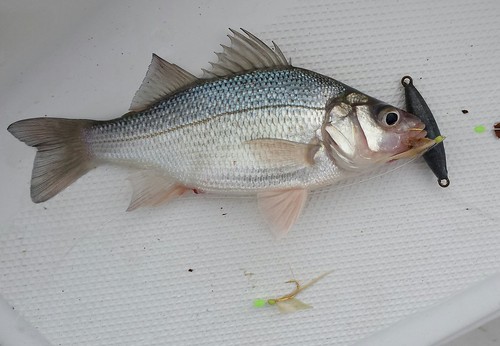
Photo courtesy of Rich Watts
Trolling for striped bass is still an option for many fishermen, especially those who happen to be on a boat with a heated cabin. There has been some excellent trolling opportunities for large fall migrant striped bass that have finally moved into the Point Lookout area this week so there is a good chance some of those large fish will also be found in the middle bay region so large parachutes and bucktails in chartreuse and white should be part of everyone's trolling spread. Water temperatures in the middle bay region are about 45° and the salinity continues to be very high at 19 parts per thousand.
There is still good fishing for medium-sized striped bass in the lower Potomac River and shipping channel edges in the bay. Large soft plastic jigs tend to be the best option for these striped bass that are measuring in the high 20" category to the low 30's. Perhaps some of the most exciting news to break this week in the lower bay region is the arrival of large fall migrant striped bass. Smith Point, the Point Lookout area, the channel edge from Buoy 70 up past the HS Buoy are good places to troll for these large fish. The Hooper Island Straits and Tangier Sound should not be overlooked either. Tandem-rigged large parachutes and bucktails dressed with sassy shads will be in order. Adam Smith holds up a nice striped bass he caught while jigging near the mouth of the Potomac River.
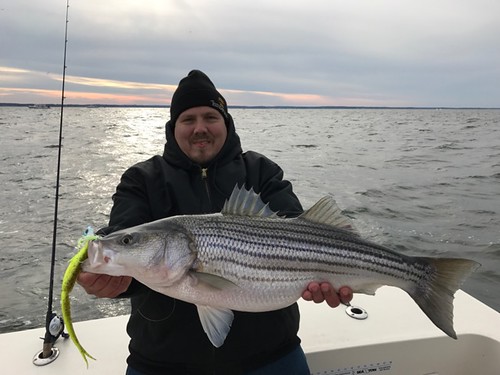
Photos courtesy of Travis Long
There is still good white perch fishing in the deep holes of the Patuxent and Nanticoke Rivers. Often the perch are holding in 50' of water over hard bottom. Bottom rigs baited with pieces of bloodworm would be the best option or sinker rigs with dropper flies tipped with pieces of bloodworm. There has also been some good yellow perch action in the middle to upper reaches of the major tidal rivers in the region. The Patuxent, Nanticoke, Wicomico and Pocomoke all have healthy yellow perch populations. Small jigs and minnows worked close to the bottom in the shallower channels tends to be the best tactic.
Freshwater fishing in the western region of Maryland has been good for a variety of coldwater species this week. Yellow perch, walleye, smallmouth bass, northern pike, chain pickerel and of course trout tend to like these colder water temperatures. There is some exciting news for trout fishermen on the North Branch of the Potomac. Fisheries biologists recently stocked about 9,000 cutthroat trout fingerlings at several locations in hope that they will provide some fun fishing opportunities in the future.
Fishing for yellow perch at Deep Creek Lake has been good in the deeper waters of the lake, smallmouth bass and walleye are active at relatively shallower depths. Northern pike and chain pickerel can be found at the mouths of coves and near structure such as sunken wood. Recent surveys on Deep Creek Lake revealed an abundant walleye population with many in the 15" to 18" size range. There is also a strong showing of 2015 and 2016 year class walleye fingerlings. Walleye and smallmouth bass are active in the upper Potomac this week and water levels are more acceptable to fishing. The findings of recent surveys on the upper Potomac showed smallmouth bass populations slightly below average. The upper Potomac River receives supplemental stockings of walleye fingerlings every year by fisheries biologists and recent surveys showed that these fingerling make up about 50% of the total walleye fingerlings found so these stockings are important to a healthy walleye fishery.
Largemouth bass tend to hunker down in deeper waters now so fishing slow and close to the bottom structure with small lures is important. Strikes will be subtle at times and those that are patient and tend to tease the bass will do best. Fishing for chain pickerel can provide a lot of action, especially in the upper reaches of Maryland's tidal rivers as well as ponds and lakes. They tend to hold near shoreline structure such as fallen treetops and most of these will be what are referred to as "hammer handles"; chain pickerel less than 18". The big ones can often be found near deeper structure.
Crappie can be found holding near deep structure such as bridge piers, marina docks or fallen treetops and sunken wood. Small jigs or minnows under a slip bobber is a good tactic. Channel catfish are active in most of the tidal rivers and blue catfish are very abundant in the tidal Potomac River like this one being brought to the boat.
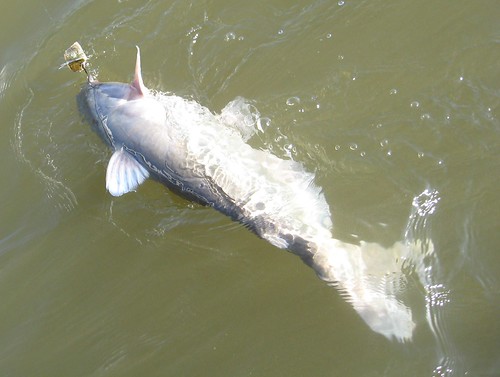
Photo courtesy of Jim Gronaw
Ocean City area fishermen are still patiently waiting for a good slug of large fall migrant striped bass to flood the Ocean City area. So far it has not happened although a few large fish are being caught now and then on the near shore shoal areas at the inlet and off the beaches. There are still a lot of fish off New Jersey so just maybe colder water temperatures will push them south and along our beaches. Water temperatures here are about 47° and are reported to be close to 40° off New Jersey.
Sea bass fishing has been excellent at the offshore wreck and reef sites and limit catches are common with some fairly large ones spicing things up a bit. There are also a few flounder being caught by those who fish for them around the sea bass fishing sites.
At the inlet a few striped bass are being caught by those casting bucktails and swim shads. Some are also drifting live eels or cut bait with good success. Many of the striped bass are undersized but some nice ones are being caught also. Those fishing in the surf are mostly using bottom rigs with cut bait and some striped bass are being caught. Hope is in the air that more of the large fall migrants will swing close to the beaches any day.
"The wrong lure in the water still has a better chance than the right lure in your tackle box." - Thomas Anthony, It Ain't Lyin' if They Didn't See It.
|  Date : 12/7/2016 (1) Date : 12/7/2016 (1)
| | 12/7/2016 | Although most recognize December 7th as a historical date that thrust the United States into World War II, for those of the Baby Boomer generation and the few remaining veterans of that era it held a special significance. For my generation it was fathers who would not utter a word about their combat experiences, especially those who fought in the Pacific. All they wanted to do was try to live a normal life and raise a family. It was obvious to even a youngster that they would immerse themselves in past time activities such as fishing to help with the mental healing process. Fishing has a way of soothing the soul and can have the same mental healing effect for anyone. A quiet personal fishing experience or fishing with family and friends can have a wonderfully positive effect on one's life priorities.
Maryland's striped bass season for the Chesapeake Bay and its tidal rivers will be closing on December 20th, December 31st for the tidal Potomac River and does not close along the Atlantic coast line. This link to the recreational fisheries home page will help to answer any questions on the striped bass regulations. ("Recreational Chesapeake Bay Striped Bass Season Runs Through December 20, 2016").
At the very top of the Chesapeake, anglers are now seeing daily power generation water releases at the Conowingo Dam in the early afternoons. There has been some limited topwater action for striped bass as well as some being caught on swim shads and soft plastic jigs. Water temperatures are now around 48° so the striped bass action is steadily slowing down.
Farther down the bay there is still some limited striped bass action in the tidal rivers on both sides of the bay. Most of the striped bass that are being caught are sub-legal and they are being caught on a variety of lures including crankbaits, jigs and topwater lures. Although it is a sub-legal fish this angler was happy for a little local action in the Patapsco River.
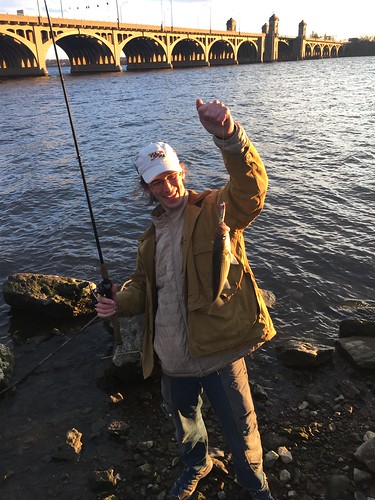
Photo courtesy of Team Balhogs
Colder water temperatures are basically putting the fishery to sleep as striped bass and white perch hunker down in many of the deepest areas to sit out the winter. Most of the bait has left the tidal rivers and they too are seeing warmer water temperatures in either deeper waters or farther south. There is still some trolling action to be found in the deeper channel areas but the action can best be described as a slow pick. Heavy inline weights ahead of tandem- rigged bucktails or umbrella rigs have been the most common choices for trolling.
At the Bay Bridge there are striped bass to be found holding close to the bottom near some of the deeper bridge piers, rock piles and concrete abutments. The only way to get to them is to jig with soft plastics or metal. Depth finders will show them packed in fairly tight and it may be tough to get them to bite due to cold water temperatures. It is not uncommon at this time of year and in this situation to foul hook a fair percentage of the fish.
Water temperatures in the middle bay region are now in the upper 40's and the fishing action is quickly slowing down. The salinity in the middle bay region continues to be high for this time of the year. There is of course more than a few reasons to venture out on the bay when weather conditions are favorable and give it one more try before wrapping it up for the season. Most of the action being found now is in the deeper channel areas in the main stem of the bay or at the mouths of some of the major tidal rivers. The shipping channel edges along Kent Island and the western shore are good places to look for striped bass and white perch hugging the bottom. The False Channel, the Buoy 83 edge and down to the inner edge of the CP Buoy have also been offering some limited action. Jigging with large soft plastics or trolling deep are the best options. It will take a lot of weight to get tandem-rigged bucktails or umbrella rigs down to where the striped bass are holding. Large plastic jigs are good choice for striped bass and metal jigs with a dropper fly or a sinker rig with two dropper flies is a good bet for white perch. A small piece of bloodworm on those dropper flies will go a long way to enticing sluggish white perch to bite.
The lower bay region offers some of the best fishing opportunities this week as the 2016 Chesapeake Bay striped bass season approaches the last two weeks of the season. Those fishing the lower Potomac River will be able to fish additional days until December 31st. The shallow water action in the Tangier/Pocomoke Sound area seems to have ended as cold water temperatures push the striped bass to deeper waters. Most are now focusing on targeting the deeper channel areas where striped bass are holding deep. The deeper channels on the eastern side of the bay, places like the HS Buoy have been good places to either troll deep or jig. On the western side of the bay the mouth of the Potomac has been offering the best fishing. These two bundled up anglers are all smiles with these striped bass they caught at the mouth of the Potomac.
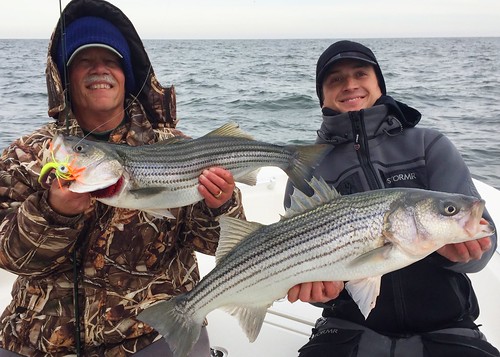
Photo courtesy of Travis Long
The mouth of the Patuxent River and the deeper channel edge off of Cove Point have also been good places to look for suspended fish. Fishing for white perch in the lower Patuxent River continues to be very good at depths of 50' over hard bottom.
Freshwater stream and river water levels in the western region of the state are still below normal but have improved with better water levels and anglers may see even more improvement by the weekend. There is plenty of good trout fishing to be found in many of the trout management waters and smallmouth bass and walleye fishing in the upper Potomac River.
Largemouth bass fishing has settled into winter type techniques of fishing close to deep structure and placing small lures close to the bottom and working them extremely slow. Small grubs and similar soft plastics like craws, as well as jigs, small crankbaits and blade lures are all good choices.
This week, a crew from Maryland Department of Natural Resources, Fishing and Boating Services deployed concrete reef balls to create new habitat for largemouth bass in the Smoots Bay area of the Potomac River, near National Harbor. The crew included staff from Inland Fisheries (Tidal Bass Division), MARI Artificial Reef Program, and Hydrographic Operations. Because of a variety of reasons, much of the submerged grasses in Smoots Bay died and have failed to re-emerge in the past 10 years. This habitat loss likely lessened population growth for largemouth bass on Potomac River, considered once as a world class fishery. This project aims to re-establish habitat to Smoots Bay and couple monitoring and periodic stocking to help improve the river-wide fishery.
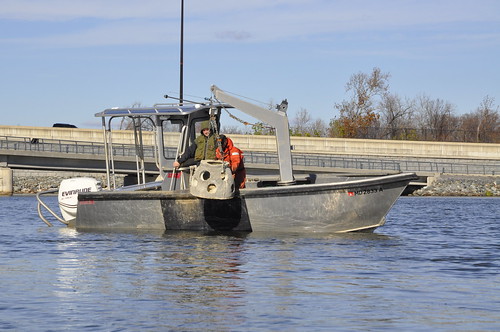 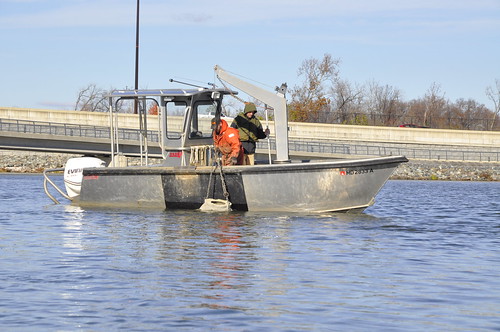
Photos courtesy of Kevin Ensor
Crappie fishing continues to be good near deep structure such as bridge piers, marina piers, brush, fallen treetops or other types of sunken wood. Live minnows or small jigs under a slip bobber are excellent ways to target them. Blue catfish are very active in the tidal Potomac River below the Wilson Bridge and fishing for channel catfish in the bay's tidal rivers and selected impoundments is very good this time of the year. Ronnie Alder holds up a whopper of a channel catfish he caught recently on the Nicodemus Fishing Bridge at the top of Liberty Reservoir
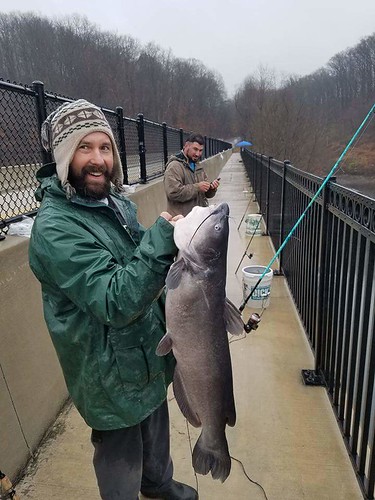
Photo courtesy of Ronnie Alder
One of the good things about colder water temperatures is the fact that we do have a few freshwater fish in Maryland that prefer colder temperatures. Chain pickerel thrive in colder waters and are very active this time of the year. Aquatic vegetation has died back making for easier fishing in the tidal waters and freshwater impoundments where chain pickerel are found. Walleye love cold water and they can be found in the upper Potomac River, the lower Susquehanna and also in Deep Creek Lake. Yellow perch are also more tolerant of colder water and that fishery is developing in the tidal rivers of the upper bay and at Deep Creek Lake.
Anyone who has fished Deep Creek Lake lately cannot help but notice that the water levels are at historic lows. Apparently the lake has been lowered to additional lows due to a large sewer system trunk line that will be running near the breast of the dam and lower water levels are aiding construction.
The big news in the Ocean City area is that the long awaited arrival of the fall migration of striped bass has finally arrived off Maryland shores. Recently striped bass were found off Delaware and Maryland in about 50' of water. The boats that are trolling are pulling large bucktails, Stretch 25 lures and Mojos and others are having good success by jigging or drifting live eels.
Surf fishermen are beginning to enjoy some of the action and the action may hit high gear by the weekend. Casting plugs such as Red Fins or swimming Creek Chubs is a good bet or fishing with cut bait and circle hooks.
A reminder to all coastal anglers that the tautog fishery is closed from November 27 - December 31 in state waters. Catch-and-release tautog fishing is also illegal, and you are not allowed to catch tautog on a vessel in Federal or out-of-state waters and transport them to Maryland.
The sea bass fishing at the offshore wreck and reef sites has been excellent with limit catches being common. Spiny dogfish are becoming pesky at some of the sea bass fishing sites and so far the large bluefish have not intruded on the sea bass fishing.
"Fly casters have long been judged by smoothness of line flow and easy grace of movement… An angler's form in casting may be important to himself and other anglers. To the fish, who will be the final judge of his prowess, form matters not at all." - Lee Wulff
|  Date : 11/30/2016 (1) Date : 11/30/2016 (1)
| | 11/30/2016 | Despite chilly temperatures and some pesky wind, on mild days this is a wonderful time to do some fishing whether on the bay, a favorite lake, pond or tidal river. There is still some color in the trees and the fish are still biting. Make an effort to get out, even if for a short spell, before the holiday rush gets too crazy and winter's grip tightens.
Fishing in the lower Susquehanna has been slow this week for striped bass and other species due to the lack of power generation water releases from the Conowingo Dam. Out at the mouth of the Susquehanna and Elk Rivers striped bass fishing has also been slow with the only action coming from the deepest parts of the channels. Yellow perch are beginning to show up in the lower sections of the rivers in the upper bay region and providing some action and good eating.
Farther down the upper bay, cold water temperatures are turning the striped bass action dial to lower readings as the fish begin to hunker down in the deeper parts of the channels. Some are still feeding but it takes patience and a lot of lead in the form of inline weights to get bucktails down to where the fish are suspended if you are trolling. Jigging can still be productive and soft plastics or metal jigs will get the job done if you can find some cooperative fish. There continues to be a lot of small fish around but some real whoppers are being caught also. The action in the tidal rivers such as the Patapsco, Gunpowder, Magothy and Chester has been reported to be slow lately but there is hope it will pick up again. Water temperatures are hovering around the 50° mark this week and once they fall into the low 40's most striped bass will hunker down to sit out the winter in the deepest parts of the channels that have sufficient oxygen levels and slightly warmer water temperatures.
The Bay Bridge is always a late season draw and fish will be found suspended at the rock piles and bridge abutments holding close to the bottom. Jigging is the best way to get to them and soft plastics often outperform metal in this situation. Small heavy metal jigs are a good bet when fishing at the rock piles for white perch.
In the middle bay region there continues to be scattered striped bass action and all of it tends to be in very deep water, 50' or more. The deeper channel edges of Kent Island are usually a great place this time of the year to find schools of striped bass and white perch holding close to the bottom. The mouth of the Choptank and Little Choptank have been providing good reports this weekend for those jigging deep. Josh Kaltreider holds up a nice one he caught recently near the Gooses in about 50' of water.
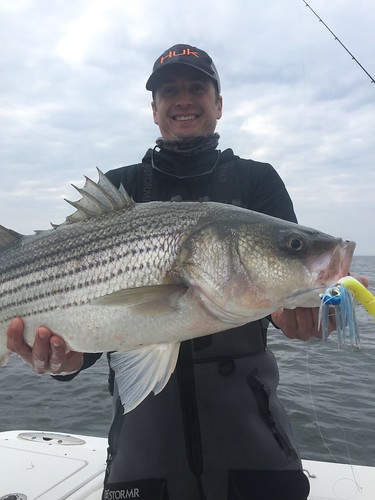
Photo courtesy of Travis Long
White perch are also holding in the deep waters of the major channels in the region, often in 50' of water and holding close to the bottom. Hard bottom is a key and a jig with a dropper fly is a good way to get down to them. If the drift is too fast or currents too strong a medium-sized sinker with two dropper flies is a good bet. Tipping those dropper flies with a small piece of bloodworm will increase the odds of success.
In the lower bay region fishing for striped bass has been good with decent size legal fish being caught throughout the region. As would be expected most of the action is deep but occasionally there has been some action on top. Concentrations of baitfish to attract and hold striped bass are the key factor for success as we move into the last month of the season. The lower bay region is the last stop for baitfish schools as they head south into Virginia waters, and most of the action was in that region last year, in December of 2015. Sea gulls and gannets have been marking the way to much of the action and usually when gannets are involved the baitfish are fair sized and thus the striped bass are also. Channel edges at Buoy 76, the HS Buoy, Buoy 70, 72A, Cove Point and the Targets have been some of the better places to find action. The lower Patuxent and Potomac have also been providing good fishing. Vertical jigging with larger soft plastics cuts down on dealing with smaller fish and trolling bucktails with heavy inline weights has also been effective.
The last month of the Chesapeake Bay striped bass season is when hopeful anglers look for large fall migrant striped bass that make a right hand turn up the Chesapeake on their fall southerly migration. Rumors abound of a few large fish being caught just south of us at the Cut Channels but so far the action has yet to develop to any degree in Maryland waters. The bulk of the migration tends to be out in the EEZ area right now off southern New Jersey but there was some exciting action off southern New Jersey beaches over Thanksgiving, so maybe some fish will come this way in early December.
Those who wish to put some tasty fillets in their freezers for the winter months have been targeting white perch in the lower Patuxent and Nanticoke Rivers in about 50' of water over good oyster bottom. Jigging and fishing with bottom rigs baited with pieces of bloodworm have been the way to fish for them. Also anchoring up along channel edges in the tidal Potomac from the 301 Bridge to the Wilson Bridge and bottom fishing with cut bait is a great way to fill a cooler with a mess of medium-sized blue catfish. Alvie Sickle holds up a nice blue catfish destined for the freezer.

Photo courtesy of Jim Gronaw
Freshwater fishing in the western region is still going strong but due to colder water temperatures, tactics are changing. Water temperatures are in the 40's now in most areas and if fish can go deep to find slightly warmer water they will. At Deep Creek Lake there has been good fishing for yellow perch in about 40' of water working small jerkbaits and silver buddies slow and close to the bottom. Walleye are also very active and can be caught on similar lures.
Smallmouth bass and walleye fishing in the upper Potomac River has been fairly good but fishing has been hampered by low flows in the river and loose grass and fallen leaves fouling lines. Tubes and small crankbaits have been good choices for lures. Trout fishermen are also dealing with low flows but like the smallmouth bass and walleyes; they have to be somewhere so targeting the deeper pool areas and channels is a good bet. Small spinners and spoons are good bets for spin casters and wooly buggers and nymphs for fly casters.
Largemouth bass are moving into deeper waters due to colder water temperatures and the mantra tends to be "deep, slow and small". Fish small lures like silver buddies, crankbaits, grubs and jigs close to the bottom and let them almost sit on the bottom and twitch and retrieve slowly. Targeting deep structure such as sunken wood, rocks, bridge piers and deep grass is always a good bet this time of the year. Caleb Mutchler got to do a little fishing with his dad and grandfather and enjoyed catching and releasing some largemouth bass.
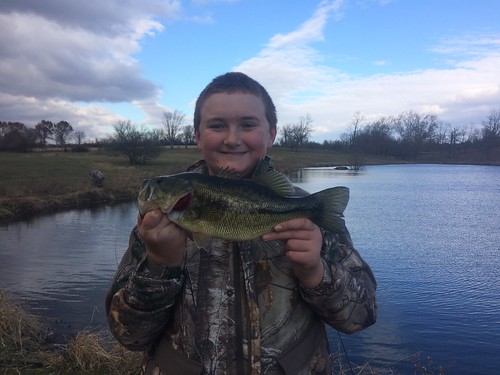
Photo courtesy of Caleb Mutchler
Crappie are schooling up, suspended near deep structure. Marina dock piers, bridge piers and fallen tree tops are all good places to look. Minnows or small jigs under a slip bobber is a good way to fish for them. Channel catfish and blue catfish are active and can be found in deeper waters. The channel catfish are found in most of the tidal rivers flowing into the Chesapeake and blue catfish tend to dominate the tidal Potomac River.
Oceanside anglers at the Ocean City beaches and near shore shoal areas are anxiously waiting for the southerly striped bass migration to hit the Maryland beaches. This could be the weekend that it happens. A large body of striped bass hit the southern beaches in New Jersey over Thanksgiving in an old fashioned blitz situation where menhaden were driven up onto the beaches and fish were caught on almost every cast. A few striped bass are presently being caught off the beaches and on the near shore shoal areas.
There has also been plenty of action in the inlet and Route 50 Bridge area, many are coming up short but it is good fun catching them. Casting plugs, swim shads, bucktails or drifting live eels or cut bait have been favored ways to fish. There are a lot of tautog being caught in the area but the throwback ratio is high but still a lot of fun.
Boats have been crisscrossing the shoal areas off the beaches in search of migrating striped bass and bluefish. Most are trolling a mix of umbrella rigs, bucktails and Stretch 25 lures. Farther offshore limit catches of tautog and sea bass are fairly common at the wreck and reef sites. A few medium-sized bluefish and flounder are still being caught and spiny dogfish are beginning to show up at the sites.
"The solution to any problem, work, love, money, whatever is to go fishing and the worse the problem, the longer the fishing trip should be." - John Gierach
|  Date : 11/23/2016 (1) Date : 11/23/2016 (1)
| | 11/23/2016 | The recent cold front that clobbered us with stiff winds, cold temperatures and gale warnings on the bay seem to have set the stage for what is to come in regards to cold weather. It was very unfortunate indeed that lives were lost on the lower Potomac over the weekend due to rough conditions brought on by stiff winds. Hopefully the winds will subside soon and many will be able to get out on the water for a traditional Thanksgiving morning of fishing before the big turkey event. Be careful out there, water temperatures are cold, everyone is wearing a lot of clothing and please wear a life jacket or vest when fishing on open waters, especially on windy or choppy days. Make sure you have enough PFDs for all on board, and check the safety equipment on your vessel before leaving the ramp or dock.
The water temperatures at the top of the bay continue to drop in the Susquehanna/Elk River area. There have been some early afternoon water releases at the Conowingo Dam but not on a regular schedule. There has been a good topwater bite in the Susquehanna and lower Elk Rivers in the evenings with a fair number of legal-sized fish. Some are having good luck trolling deep with crankbaits and swim shads in the lower part of the rivers and along the channel edges farther south.
The striped bass fishing action is expected to regain momentum once small craft warnings are lowered on the upper Chesapeake. It was pretty stiff out there into yesterday but some did find haven in the leeward shores of the western side of the bay in the tidal rivers. The Patapsco, Gunpowder and Magothy Rivers have been offering some topwater action in the mornings and evenings in about 10' of water. Others have had luck jigging in the channels for a mix of striped bass and white perch or slow trolling deep with heavy inline weights and bucktails. There are a high percentage of sub-legal striped bass but definitely worth the time to put a couple of legal fish in the boat. Mike Kvech holds up a nice striped bass he caught near Hart/Miller Island.
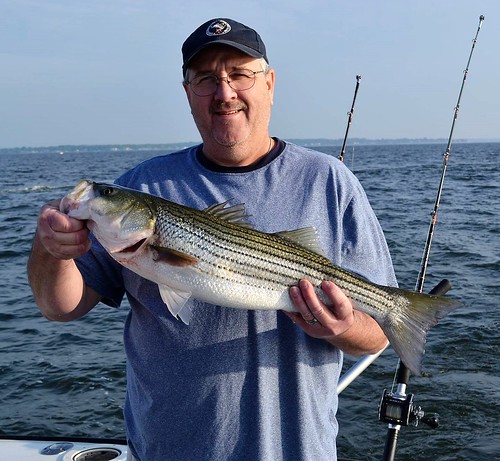
Photo courtesy of Montana Grant
Once the winds lay down, fishing should resume out in the main stem of the upper bay with most of the focus along deep channel edges for the larger fish. Water temperatures are taking a nose dive with the colder weather and stand at about 52 degrees today. The fishing action is expected to diminish with these colder water temperatures as bait heads down the bay and fish start to hunker down in the deepest areas and begin to become less active.
The Bay Bridge will continue to hold a mix of striped bass and white perch near the deeper parts of the rock piles and piers. Vertical jigging will be the main way to target these fish and it will take some weight to get to them when the current is running strong. Below the bridge there are white perch and striped bass holding along some of the deeper edges of the main shipping channel and to a lesser extent the channels at the mouths of the major tidal rivers. As has been the case this fall, there are a lot of small fish spread throughout the region and it can be tough at times to find a nice grade of fish. Jigging deep will continue to be a light tackle fun way to fish but trolling can also be very effective. It takes a lot of lead to get tandem rigged bucktails down to where the fish are holding.
Water temperatures will most likely begin to dip below the 50 degree mark by next week and striped bass will show decreased activity and will be holding deep. The salinity in the middle bay region is about 18 p.p.t. which is considerably high for this time of the year. We are going on our fourth month with hardly any rain and without freshwater pouring in from the tidal rivers higher salt content water is pushing up the bay with each tide. This is okay for fish but you may find white perch and channel catfish in places you normally don't see them this time of the year. These high salinities are not good for oysters since the diseases that hamper their survival are more prevalent in higher salinity waters.
Once the winds lay down, some places to check will include the shipping channel edges off Kent Island and near Thomas Point, the False Channel at the mouth of the Choptank, off the Little Choptank and the mouth of the West River have been good places to check. Most fish encountered close to the surface will be smaller fish; the larger ones will most often be deep. Ted Kolobow caught this nice striper north of Bloody Point while jigging deep just before the weekend winds hit.

Photo courtesy of Ted Kolobow
In the lower bay region there has been good fishing for striped bass in the lower Patuxent and Potomac Rivers along the main channel edges. Jigging and trolling have been equally good ways to hook into some fish. Smaller fish as usual have been very common but there are some larger fish to be found deep. There has also been good action at the mouth of the Nanticoke River, off Hooper's Island and along the western side of the shipping channel. It may take some time to find the fish size you're looking for but this is typical for this time of the year. Colder water temperatures are slowing fish down and once water temperatures drop into the 40's action will be even slower.
White perch are holding in deep water at the mouth of the Patuxent and Nanticoke Rivers and can be found over hard oyster bottom. A bottom rig baited with pieces of bloodworms or a jig with a dropper fly are good choices to target them. There are also a few sea trout around.
There is good fishing for blue catfish in the tidal Potomac and the catfish are generally holding in 25' of water or more. There are plenty of medium sized ones to catch and they certainly make a good addition to any freezer. The grass beds farther up the river are breaking up due to shorter daylight hours and cold water conditions so fouled lines will be something to contend with.
Still no rain! That is what western Maryland and most of Maryland has been dealing with for the last several months. Water levels in the western Maryland rivers, streams and reservoirs are very low. The state boat ramp at Deep Creek Lake and others on the upper Potomac are unusable or barely so. At Deep Creek Lake water temperatures are beginning to dip below the 50 degree mark. Fishing for smallmouth bass has been good and jigs and crankbaits that resemble crawfish have been the best lures to use. The bass are feeding heavily on crawfish that are moving towards deeper water and cover to sit out the winter months. Walleye fishing is picking up and yellow perch fishing has been good. Live minnows either drifted free or under a slip bobber is a good way to fish for them. Chain pickerel and northern pike are much more active now with colder water temperatures. Look for them along deep grass and at the mouths of many of the shallower coves.
Trout fishing remains a fun option but it will take some stealth as they may be concentrated in the deeper pools due to low and clear water conditions. As the stocked trout from October become more accustomed to not being fed at the hatchery they will be looking for aquatic insects and smaller fish, so flies, spinners and even ultra-light sized jerkbaits are good choices to fish with very light line. The upper Potomac has the same water level conditions this week so tubes and crankbaits cast with light line would be a good choice when targeting smallmouth bass.
Largemouth bass are doing the same strategy as smallmouth bass but typically in lakes, ponds and tidal rivers throughout Maryland. Shorter daylight hours and colder temperatures are causing grass beds to die back for the winter and small baitfish and particularly crawfish have lost their cover so they're headed for deep structure for the winter months. To reach these deeper areas where they might find places to hide, they have to cross barren bottom and that is where largemouth bass are waiting for them. Hair jigs, tubes, soft plastic craws on a jig head, small crankbaits, basically anything that looks like a crawfish is a good bet when worked close to the bottom. Sean Allen was fishing the Gunpowder recently and got into some wonderful largemouth bass action such as this beauty.

Photo courtesy of Sean Allen Sr.
Ocean water temperatures continue to drop and they are very close to passing the 50 degree mark. In the surf fishermen are patiently waiting for the main body of migrating striped bass to arrive from New England waters. New Jersey anglers have been getting in their licks this past week but reports have most of the southbound fish far offshore and in the protected area in the Federal Exclusive Economic Zone or "EEZ" (fishing for striped bass is illegal in the Federal EEZ in the ocean, which starts 3 miles offshore and extends out to 200 miles off the coast). A few large striped bass are being caught this week in Ocean City and Assateague surf, perhaps this week things will really hit high gear.
Large bluefish are also part of the fall migration and these are the biggest and baddest of their species, with many weighing 12 lbs. or better. They will soon start showing up at the sea bass fishing sites and should be found on the inshore shoal areas and surf zones soon.
At the inlet and Route 50 Bridge area, tautog and striped bass have been the big focus. Many of the tog are undersized but if one sticks with it you can catch your limit of legal fish. There are also plenty of striped bass in the area and again a high percentage are short of the required 28" but they're close. Casting bucktails, swim shads, drifting cut menhaden baits or live eels have been the choicest ways to fish for them.
Outside the inlet at the offshore wreck and reef sites boats have been putting their anglers on some excellent sea bass and tautog fishing. Limit catches of sea bass and tautog are not uncommon. There is also a mix of flounder, medium sized bluefish and a few triggerfish coming over the rails. Richard Gunion holds up a nice sea bass for us on the way back to port.
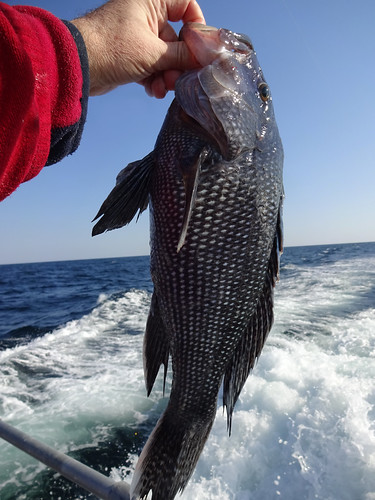
Photo courtesy of Richard Gunion
"It was pushing on for Christmas when my grandma, Miss Lottie, pursed her mouth one day after she finished her coffee and remarked that if there were any menfolk in the house worth the powder and shot to blow them to perdition they would bestir themselves and go find a couple of wild turkeys that were dumber than they were." - Robert Ruark, Somebody Else's Turkey Tastes Better
|  Date : 11/16/2016 (1) Date : 11/16/2016 (1)
| | 11/16/2016 | There has been some limited striped bass action in the lower Susquehanna River this week on topwater lures and soft plastic jigs such as Bass Assassins and grubs. Breaking fish can be spotted at times just south of the flats area but they are usually 14" to 16" fish. Water releases from the Conowingo Dam have not been on a daily schedule this past week. Farther south breaking fish can be spotted all the way down to the Bay Bridge area. Larger striped bass are being found in some of the tidal rivers such as the Patapsco, Bush, Gunpowder and Chester. At times they can be caught in relatively shallow water on topwater lures or by casting jerkbaits and crankbaits or by jigging. David Sohns sent in this picture of a nice striped bass caught in the Patapsco River recently.
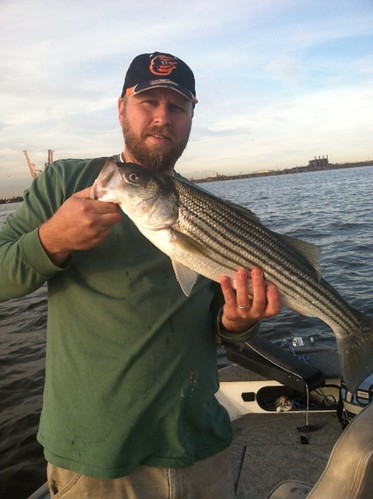
Photo courtesy of David Sohns
Striped bass are spread throughout the upper bay region with some of the better grade fish being found along channels such as the Craighill Channel near the mouth of the Magothy and the edge of the Dumping Grounds. Many are trolling deep with heavy inline weights and medium-sized bucktails to cover a wider area to find the larger striped bass that tend to be in isolated pockets at times. Other times one can be lucky enough to get over a group of suspended fish and enjoy good jigging action with metal or soft plastic jigs.
White perch are also part of the mix in the upper bay and can be found holding deep at the mouths of the major tidal rivers. A two hook bottom rig tipped with pieces of bloodworms or dropper flies over a sinker are a great way to stock up on some nice white perch. A depth finder is an invaluable tool this time of the year for locating fish that are holding deep. White perch are also stacking up near the rock piles at the Bay Bridge and usually they're big ones mixed in with the striped bass.
South of the Bay Bridge it is the same story of small striped bass working on schools of bait that are exiting the tidal rivers and moving down the bay swept along by tidal currents. One has to either try working deep underneath the surface action or around the perimeters of the smaller fish. Sometimes one may just have to leave fish to find fish which seems to go against common sense but it can pay off with finding larger fish. The larger striped bass are looking for menhaden and even smaller sized white perch and soon river herring and hickory shad will be flowing out of the Choptank. The larger striped bass can move freely in the swift tidal currents along the shipping channel edges and of course they do like structure. The channel edges near Thomas Point, Kent Island, the mouth of Eastern Bay, off Chesapeake Beach, the False Channel and the mouths of the Little Choptank, West River and the Severn are all good place to check. Rich Watts holds up a nice striped bass he caught while jigging off Kent Island.
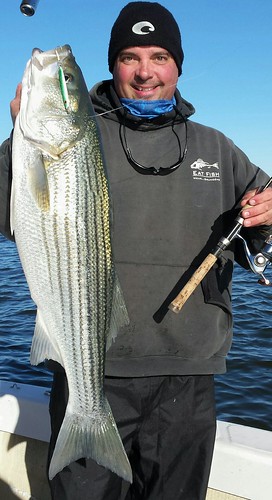
Photo courtesy of Rich Watts
Trolling medium-sized bucktails behind heavy inline weights is an excellent way to get down to fish holding deep and to also cover plenty of water. Keep an eye on those depth finders and when you find a good concentration of fish hopefully they will be in the mood to take a shot at your lures. White perch are doing much the same thing as the striped bass and there are some nice white perch out in the bay holding deep over oyster bottom and hard-bottom channel areas. Jigging with smaller metal jigs with a dropper fly is a great way to target them when found.
The striped bass story tends to repeat itself in the lower bay region; go deep along the outside edges of smaller surface breaking fish or target steep channel edges and similar structure. Depth finders will often lead the way and jigging or trolling deep are the two best options to target the larger striped bass. The lower Potomac, Patuxent and Nanticoke Rivers are good places to take a look since bait is pouring out of these rivers. When trolling, tandem rigged bucktails with sassy shads or twister tails are hard to beat and it will take a lot of lead to get down to the fish; often as much as a pound.
White perch are holding deep over oyster bottom in the lower portions of the tidal rivers and jigging with metal and a dropper fly, two dropper flies over a sinker or simple bottom rigs will do the trick. Small pieces of blood worm on dropper flies or hooks complete the ticket. In the lower Potomac River there are large numbers of medium-sized blue catfish and they can be easily caught on a moving tide on cut bait.
Freshwater fishing has solidly moved into a late fall phase of fishing where many species of fish continue to feed heavily as water temperatures continue to drop into the low 50's in most areas. Water levels in the western region of the state are still very low and can cause some difficulties for anyone not used to fishing light and with stealth. The upper Potomac and many of the trout streams are running low, but approaching with a stealthy mindset can result in some truly great smallmouth bass or trout fishing. Steve Peperak caught this beautiful 25" rainbow trout at the Yough last weekend near the Deep Creek Lake out fall on a wooly bugger. He and a buddy caught several other rainbows and a few small browns as well.
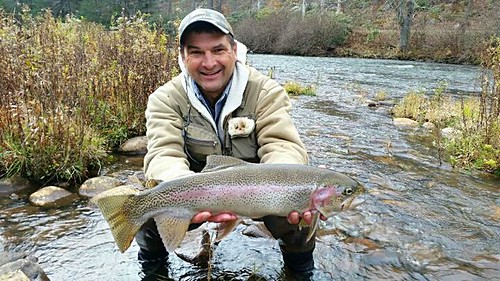
Photo courtesy of Steve Peperak
Largemouth bass are feeling the effects of cooler water temperatures and moving to slightly deeper waters. These deeper areas between the normal summer habitat and the deepest areas of lakes and tidal rivers offer great places for largemouth bass to ambush crawfish and small bait fish leaving the deteriorating grass beds and cooler waters looking for refuge in deep structure for the winter months. Hair jigs, plastic craws, spinnerbaits, jerkbaits, crankbaits and grubs are all good choices to work these transition water depths.
Crappie are schooling up near deep structure such as sunken wood, bridge piers and marina piers. It is hard to beat a minnow under a slip bobber for this type of fishing but small tubes and soft plastics can also work well. The colder water temperatures are much to the liking of chain pickerel, northern pike and walleye. Fishing for walleye has greatly improved in the upper Potomac, Deep Creek Lake and the lower Susquehanna. Northern Pike are very active in Deep Creek Lake and can be found near deep grass at the mouths of coves. Chain pickerel are spread throughout Maryland's many ponds, lakes and tidal rivers and offer lure attacks with total abandon and can spice up any fishing outing.
The fishing scene at Ocean City has moved into a fall fishing pattern as we move through the middle of November. Flounder fishing is just about at an end in the coastal bay areas and tautog, striped bass are targeted species now at the inlet and Route 50 Bridge area. Most are using sand fleas for tautog fishing and striped bass fishing at the inlet is mostly occurring at night by casting bucktails and swim shads or drifting live eels. There is some action in the surf for striped bass and anglers anxiously wait for the first large fall migrants to pass through our areas. Reports from up north hold hope that the fish will arrive soon.
Outside the inlet fishing for tautog and sea bass has been very good. Those targeting sea bass are catching limits of nice fish along with some medium-sized bluefish and flounder. Reports from New Jersey tell of large bluefish moving through the region. Up north these large bluefish are often called choppers or slammers and unfortunately when they show up at Maryland's sea bass fishing sites there are going to be some sea bass bitten off as they are reeled to the surface.
"There are days when the fishing is better than one's most optimistic forecast, others when it is far worse. Either is a gain over just staying home." -Roderick Haig-Brown
|  Date : 11/9/2016 (1) Date : 11/9/2016 (1)
| | 11/9/2016 | At the very top of the bay there has been some good striped bass action in the lower Susquehanna and channel areas beyond the mouth of the river. A good number of the fish are well over the 20" minimum and topwater lures have been working in the mornings on the river. Jigging has been a good choice later on in the day in the channels and deeper areas. Water temperatures are around 55° and the water clarity has improved. White perch can also be found in some of the deeper areas of the channels and channel catfish are very active.
Striped bass are spread throughout the entire upper bay region and can be found in the tidal rivers and out in the bay near the deeper channel edges. Light tackle jigging with metal or large soft plastic jigs is a good way to target suspended fish when they can be found under birds or spotted on a depth finder. Trolling with heavy inline weights is another way to target fish holding deep along channel edges. Bucktails dressed with a twister tail, Storm type swim shads, spoons and surge tube lures are all good choices to troll with. The Brewerton Channel has been a good place to troll as well as the edges of the main shipping channel. There is plenty of action to be found in the tidal rivers on topwater lures early in the morning, and jigging along channel edges when fish move deeper. The mouth of the Chester River, the Magothy, and the tidal rivers near Baltimore have all been providing good fishing. Michael Loyd caught this nice striped bass while casting in the Gunpowder River.

Photo by Todd Wallace
The Bay Bridge area continues to be a great spot to check out with a depth finder. There are striped bass suspended near the bridge piers, cement abutments and the rock piles. White perch are also stacking up in the deeper areas and often these are larger perch. Larger white perch can navigate in the swifter waters near the deep bridge structure so often a wonderful grade of white perch are available to those who jig for them.
Sub-legal sized striped bass tend to be dominating the surface action seen in the middle bay region but there are also larger fish to be found. At times they can be found deep underneath the surface action or on the outside edges and again deep. Depth finders are about the most important tool on a boat this time of the year. They can help find suspended fish but keep in mind there are other species of fish schooling out in the deeper regions of the tidal rivers and bay. Schools of gizzard shad can confound anglers at times when guys just can't understand why the fish beneath them just won't bite. The mouth of Eastern Bay, West River, Choptank, Little Choptank have all been good places to start the search for fish. Also of note is there is some topwater action to be found in the tidal rivers in depths in the range of 10'.
Light tackle jigging with metal jigs or soft plastics is a fall favorite but trolling with a mix of bucktails, Storm type swim shads, spoons and surge tubes behind heavy inline weights is also very effective. Trolling also allows one to cover a lot of water in the search for striped bass over 20" in length.
In the lower bay region striped bass of various sizes are spread from the shores of Hooper's Island and Pocomoke Sound to the lower Potomac and Patuxent Rivers. There seems to be striped bass everywhere but finding ones over 20" in length can seem challenging at times. The deeper edges of channels and the outside edges of surface action down deep can give one the best chances of finding larger fish. On the eastern side of the bay, the Hooper's Island area, the mouth of the Nanticoke, Wicomico and Pocomoke all have fish colliding with bait that is exiting the rivers. On the western shore the lower Potomac and Patuxent have been real standouts as has the Middle Grounds and the Cedar Point channel edges. Look deep for the better grade of striped bass whether you are jigging or trolling. Sea trout are still part of the jigging mix in the lower bay for a little while longer.

Photo by 123 Fishing Rigs
There are a lot of white perch stacking up in the deeper areas at the mouths of the region's tidal rivers, often over good oyster bottom and 35" of water or more. Jigging is one of the better ways to catch the larger sized perch and using a jig with a dropper fly or a sinker with two dropper flies is a proven tactic. If you can get out on the tidal Potomac hordes of blue catfish await you if you feel like bottom fishing and all they want to do is jump into your freezer; don't miss out.
Despite the light rain we received yesterday, most freshwater streams and rivers are experiencing low flow conditions. Many reservoirs are low in the western region and boaters are having difficulty launching boats. If you are trout fishing and enjoying the trout that are still present in good numbers as a result of the fall stocking program, think about stealth. If you are using spinning tackle drop to 2lb. test line and think about some of the fluorocarbon monofilament lines on the market. If you are fishing with bait look at switching to 3X dry fly hooks. Western Region fisheries biologists Josh Henesy and Kenny Wampler both agreed that when fly fishing go light. Put an emphasis on the longer, lighter tippet. The water levels are extremely low and clear and trout can be particularly spooky. Minimize line drag/drift and go subsurface with larger (#8-12) attractor nymphs for big browns. These can be fished tandem with a smaller nymph below. Pheasant tail, stonefly, bead head prince nymph, midge nymphs are good choices for flies.
Fishing at Deep Creek Lake has been good this week, water temperatures are about 53°. Largemouth bass are being caught near structure in about 10' to 20' of water on crankbaits, jigs and soft plastics. Smallmouth bass are being found in about 12' of water and plastics that resemble crawfish have been a proven winner.
The upper Potomac like many western region streams is experiencing very low flow conditions with extremely clear water. Long casts with light line and small lures such as tubes will be one of the better tactics. The deeper underwater ledges will be good targets and unfortunately grass beds are breaking up and fallen leaves are adding to line fouling headaches. Smallmouth bass are not the only fish in the upper Potomac as Solomon Jovenal proves with this large walleye he caught recently.
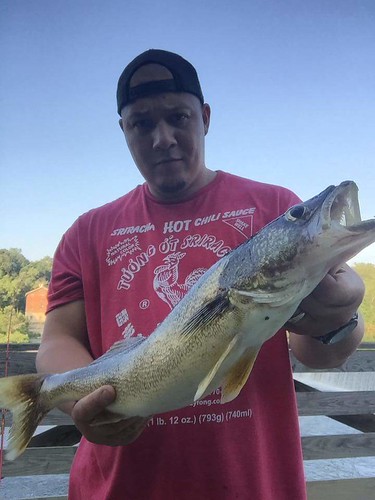
Photo by Solomon Jovenal
Fishing for largemouth bass in the tidal rivers, lakes and ponds is very good this week and the action continues throughout the day. Tactics may change but the bass are very active and feeling the need to fatten up. There is topwater action in the morning hours and good fishing in the intermediate or transition zones that are slightly deeper. Crawfish are leaving the shallow grass beds and other cover and running the gauntlet to get to deep cover to sit out the winter months. Crankbaits, jigs and soft craws are good choice when fishing these areas close to the bottom.
Crappie are schooling up due to cooler water temperatures and deep structure such as marina piers and docks in the tidal Potomac are a great place to target them. Bridge piers such as those at Liberty Reservoir and Deep Creek Lake are great places to fish small jigs either as they are or under a bobber and of course it is pretty hard to beat the real thing, minnows.
At the Ocean City area cooler water temperatures have made big changes for those who fish the inlet, surf and coastal bay areas. Flounder are exiting through the inlet, so targeting the channels leading to the inlet and the inlet itself are the place to be. Tautog are setting up residence at the jetties, bridge piers and bulkheads just inside the inlet. Sand fleas have been a popular bait recently with the added bonus of attracting medium-sized black drum and a few triggerfish that are still hanging around. The evening crew fishing for striped bass have been enjoying a lot of action with just enough keeper size fish to make it all worthwhile. Casting swim shads, bucktails and drifting live eels have been good tactics. Fall migrant striped bass are showing up along the beaches of New Jersey this week so with a little luck we may see some action in the Maryland beaches soon.
Outside the inlet sea bass fishing have been excellent on the onshore wreck and reef sites and farther out to some of the sites beyond the 30 Fathom line. Flounder have been a big part of the catches and besides limits of sea bass with limits of flounder added.
"Young anglers love new river the way they love the rest of their lives. Time doesn't seem to be of the essence and somewhere in the system is what they are looking for." -Thomas McGuane
|  Date : 11/2/2016 (1) Date : 11/2/2016 (1)
| | 11/2/2016 | Welcome to November. All connected to the outdoors, be they fish, animal or outdoorsman, will feel the change as the winter months begin to be sensed like a soft and distant sound that will only get louder as it gets closer. Do not miss out on the fantastic fishing opportunities in the next month before they fade as the winter months approach.
The very upper portion of the Chesapeake Bay near the mouth of the Susquehanna and south past Pooles Island has been experiencing stained water due to runoff coming down the Susquehanna lately. The Conowingo Dam has been releasing water on a daily basis about mid-day. Water temperatures in the upper bay are about 58° this week. The fishing has been good for striped bass in the lower Susquehanna and surrounding areas near the flats and the mouth of the Elk River. Josh Smith holds up a nice Susquehanna Striped bass he caught recently.
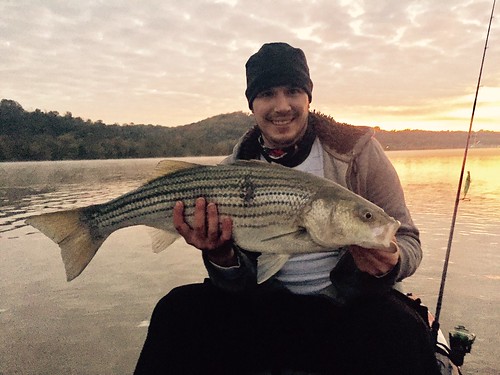
photo by Don Goff
There has been plenty of good striped bass action to be found along main channel edges such as Brewerton Channel and the main shipping channel. Jigging has been one of the more productive methods when birds can be spotted or suspended fish can be located on a depth finder. Trolling has also been a good way to fish when heavy inline weights are used to get bucktails and spoons down deep to where the fish are holding.
White perch in the upper bay are also holding deep in the channels near the mouths of the tidal rivers and the bay. Most are using bottom rigs baited with pieces of bloodworm or jigs. Channel catfish and yellow perch can also be part of the mix. At the Bay Bridge, white perch are holding near the rock piles and some of the bridge piers.
Near the Bay Bridge and south to the middle bay region striped bass are spread out over a wide area. Most of the legal-sized fish are holding deep along channel edges or in the channels. One of the better ways to locate them is to watch depth finders near these areas and then jig metal or soft plastics. Slicks are a good thing to look for and also jigging deep near smaller surface feeding striped bass, which are often marked by diving sea gulls. The main shipping channel and the channels leading out of the mouths of the region's main tidal rivers are excellent places to explore. Those that are jigging in these areas are also finding a mix of sea trout and large white perch. Dennis Jester Jr. was out jigging with his father and they enjoyed catching some nice fish such as this 31" fish.

photo by Dennis Jester Jr.
Shore bound anglers have been enjoying some good fishing opportunities for striped bass and white perch at some of the fishing piers within the region that offer access to deeper waters and the Kent Narrows offers good fishing from the bulkheads. Casting jigs on an angle up current and jigging as the current sweeps a bucktail along is usually a good bet. Crankbaits and jerkbaits can also be a good choice where the current is not strong at prominent point and jetties and bloodworms or cut bait works well on bottom rigs.
Water temperatures in the middle bay region are dipping below the 60° mark and salinities are relatively high at 17 p.p.t. this week. A few of the best fishing reports have been coming from the mouth of Eastern Bay, the False Channel area at the mouth of the Choptank, the mouths of the West River and Little Choptank.
In the lower bay region there is plenty of good fishing opportunities this week for a mix of striped bass, sea trout and white perch. The better striped bass fishing has been taking place in the lower Potomac and Patuxent Rivers over active oyster bottom. The Middle Grounds has been holding a lot of striped bass and sea trout as well as the Cover Point and Point-No-Point areas. The mouths of the Nanticoke, Wicomico and Pocomoke Rivers are offering good fishing for striped bass, sea trout and white perch. Most are jigging over suspended fish near the channel edges for this mix. Trolling is another good option when striped bass are the primary target. Bucktails dressed with twister tails, spoons and surge tube lures are all good choices to be pulled behind heavy inline weights. The striped bass are holding deep so it takes some weight to get down to them.
If white perch are your primary target; they can be found in about 50' of water holding over oyster bottom in most of the major tidal rivers. Bloodworms on a bottom rig or small jigs or flies rigged over a sinker will get you down to the perch. Small jigs and flies tipped with a piece of bloodworm often tend to be more enticing to the perch.
Some have not given up on getting out for one more bushel of large and heavy crabs this week. The crabs are in about 15' of water and despite much cooler temperatures well worth the effort, so think of bundling up and give it a go. Trotlines work well and collapsible traps have the added bonus of working any time of the day. Marissa Nimon and Joe Bandy traveled all the way from New Mexico to enjoy some crabbing on the Chesapeake recently with family.

Photo by Rich Watts
Water temperatures in the many freshwater streams, rivers, lakes and ponds continue to drop and in most waters temperatures are somewhere in the 50's. In the western region of Maryland, rivers and streams are running extremely low and clear due to lack of rain. The upper Potomac is very low with water temperatures around 52°. Grass has been breaking up due to cooler water conditions and falling leaves will now add to line fouling. Tubes, grubs and whacky rigged stick worms cast with light line from a distance have been good tactics for these water conditions. Submerged ledges and large submerged boulder areas tend to be good targets when fishing this variety of lures. Trout fishermen taking advantage of the fall trout stocking program are enjoying wonderful fishing conditions despite low water levels. In many trout management waters stocking crews have altered normal stocking locations to place trout in some of the deeper pool areas to insure their long term survival and availability to trout fishermen over a longer period of time. Light lines and stealthy approaches are proven tactics under these conditions whether using bait or small spinners, spoons or flies. Ryan Bishop got to go trout fishing with his dad at Middle Creek and is all smiles with this trout that he caught.
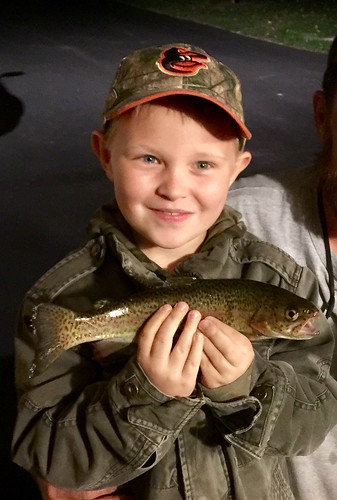
Photo by David Bishop
Deep Creek Lake water levels are down due to draw downs and with water temperatures around 57° fish are very active. Largemouth and smallmouth bass, yellow perch and northern pike are all actively feeding and with boat traffic down to a minimum; this is a wonderful time of the year to fish Deep Creek Lake. Most of the floating docks have been hauled out so natural structure such as grass beds, rocky points and fallen treetops are all good places to target.
Fishing for largemouth bass is usually always good this time of the year due to cooler water temperatures pushing bass to actively feed and put on as much bulk as they can for the coming winter. The shallow topwater bite in the mornings is not something to be missed and right now with our fall daylight savings time adjustment still off till Sunday it is easier to be out on the water before sunrise. Cooler water temperatures do extend the morning topwater bite now that we're into a fall pattern of fish behavior and chain pickerel, northern pike, northern snakeheads and smallmouth bass will be part of the mix depending on where you are fishing. Transition areas that have structure such as sunken wood, rocks or grass are great places to target with spinnerbaits, crankbaits, jerkbaits or various rig situations with soft plastics and stick baits. In tidal waters working the outside edges of grass beds or spatterdock fields on a falling tide is always a good bet.
As water temperatures drop in the shallower areas and grass beds begin to diminish; crawfish will start migrating to deeper water and looking for a place to hunker down for the winter. When this begins largemouth and smallmouth bass will be on the prowl to catch them out in the open so jigs, craws and crankbaits are good choices to get in on this action. David Halbritter Jr. caught and released this whopper size largemouth bass at Piney Run Reservoir in Garrett County recently.
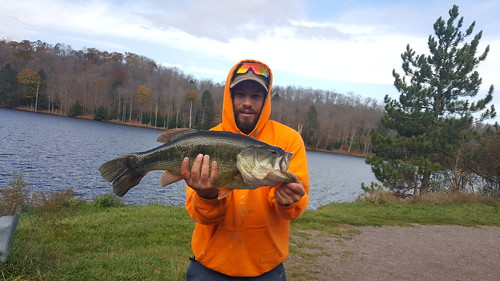
Photo courtesy of Denzil Halbritter Jr.
At the Ocean City area fall is certainly in the air and water temperatures approach the 60° mark. Summer flounder are moving out of the coastal bay areas through the channels leading to the inlet and moving offshore. This is a wonderful time of the year to get in on the action and unfortunately is missed by many who have not experienced it. Large baits are often the ticket for the largest flounder. Gulp baits, live spot if you can find them or finger mullet are all good choices. The inlet and Route 50 Bridge area is where it is happening this week when it comes to fishing for striped bass, tautog, flounder and black drum. The South Jetty is a go to location if you're in a boat but the nearby bulkheads and Route 50 Bridge offer good opportunities also. Casting bucktails, swim shads or drifting live eels can get you into the striped bass action in the evenings. Tautog and black drum are being caught on sand fleas along the jetties and bulkheads.
Surf casters are picking away at striped bass on cut bait and small bluefish on finger mullet. Fishing with bloodworms, clams or sand fleas can get one in on some black drum action in the area also. Outside the inlet boats fishing the Bass Grounds and the various wreck and reef sites are reporting limit catches of sea bass and flounder by those onboard. Triggerfish and bluefish are also part of the mix coming over the rails.
"In the end there is a reverent and private moment when a hand is placed upon a great fish or animal and a connection is made that belongs to only two." - Keith Lockwood
|  Date : 10/26/2016 (1) Date : 10/26/2016 (1)
| | 10/26/2016 | After a spurt of warm weather last week, cooler air temperatures have returned and water temperatures continue their decline. Fish are feeling the urge to pack on as much as they can to prepare for the winter months so it is an ideal time to get out and fish, whether freshwater or saltwater fish are your target.
At the very top of the bay there continues to be some striped bass action near the mouths of the Elk and Susquehanna Rivers by jigging over suspended fish. Many of the fish are sub-legal but there are enough legal-sized ones to make it worthwhile to jig with metal or soft plastic jigs. There is also some topwater action near shoreline structure and the deeper edges of the Susquehanna Flats for a better grade of striped bass. The Conowingo Dam has had some substantial water releases lately creating strong currents in the river and dropping water temperatures to the 60° mark. Farther south there are schools of striped bass to be found suspended along channel edges or up on the surface chasing bait. Light tackle jigging is usually a favorite way to fish and metal jigs in the 2-ounce size range tend to be just the ticket for action. Soft plastic jigs can be cast to surface fish but the best grade of striped bass often tends to come from the depths beneath the surface action. Trolling is another option with bucktails, spoons and swim shads behind inline weights and often can put one onto a better grade of fish.
Dropping water temperatures are pushing white perch into deeper waters this week and some of the better white perch fish will be found in 20' of water or more. Small jigs or flies above a sinker or heavier jigs can be used when perch can be spotted on a depth finder. In the very top of the bay and the region's tidal rivers yellow perch can also be found along with channel catfish. White perch are also starting to school up near the rock piles at the Bay Bridge.
In the middle bay region fishing for striped bass has picked up once again after last week's warm weather raised water temperatures and put a damper on fishing success. Water temperatures rose to about 70° last Thursday but have dropped back to 62° this week. This is the time of the year to be watching for birds and slicks; jigging is what fall striped bass fishing is all about on the Chesapeake. There have been a lot of sub-legal striped bass in the tidal rivers but often a better grade of fish can be found out towards the bay. The mouth of Eastern Bay near Poplar Island, Thomas Point, outside of the West River, Little Choptank and the False Channel at the mouth of the Choptank have been good places to check. A few sea trout have also been part of the mix when jigging lately. A good running tide is very important.
Trolling can be a good option along channel edges and anywhere slicks can be spotted. Bucktails dressed with twister tails, spoons and swim shads are good choices behind inline weights. Umbrella rigs are also productive but of course add to the weight of gear that must be reeled in with a fish. Greg French holds up a chunky striped bass he caught while trolling in the lower Choptank River near Tilghman Island.

photo by Dr. Sandy McClinton
The striped bass seem to have moved from the shallower shoreline areas now that water temperatures approach the 60° mark so the topwater fishing will have to take a back seat to jigging until next year. In some areas where the shoreline waters are deeper; casting crankbaits, jerkbaits or soft plastic swim shads can produce a couple of legal-sized striped bass in the early morning or evening hours. White perch have also moved to deeper waters and can be found holding over oyster bottom.
In the lower bay region striped bass are being found chasing schools of bay anchovies and small menhaden throughout the region from the Potomac River to Tangier Sound. Many of the fish on the surface tend to be sub-legal but larger fish can often be found suspended near channel edges or below the surface feeding smaller fish. The channel edges in the lower Potomac have been a good place to jig as have channel edges along the western shore of the bay and Tangier Sound up to Hooper's Island. Trolling can be very effective in these same areas or anywhere slicks can been found. Bucktails dressed with twister tails, spoons and swim shads are all good choices to troll behind inline weights.
The spot and croaker have departed the region for the most part but fishing for white perch has been excellent in the tidal rivers over oyster bottom in 20' to 35' of water. There are also some sea trout being caught also. It is pretty hard to beat pieces of bloodworms placed on bottom rig hooks or small jigs.
If you find yourself looking into a freezer and wondering if you packed enough fish away for the winter months, you might think of filling up those spaces with some blue catfish fillets. The bottom of the Potomac River from the mouth of the Wicomico north seems to be paved with medium-sized blue catfish this time of the year. They are easy to catch and the white meat is mild and freezes very well.
There are still crabs to be caught in the lower sections of the tidal rivers in all regions of the bay this week. You will have to go deep for them and many are saying using collapsible crab traps makes it easy and you can go out later in the day when it is warmer.
Freshwater fishing could hardly be any better this week as most fish species feel the urge to actively feed throughout most of the day due to cool water temperatures. Smallmouth and largemouth bass can be found in Deep Creek Lake near grass beds and rocky points. Yellow perch are active near deep grass. There is good smallmouth bass fishing in the upper Potomac River this week. Water levels are low and clear but the smallmouth bass are active. There is also good fishing for smallmouth bass and walleye in the lower Susquehanna River.
The October trout stocking program is still going strong and although many western region areas are a little sparse on water flows the trout are being stocked in the deeper pools. Be sure to check the stocking updates for areas near you at the following link. http://dnr.maryland.gov/Fisheries/Pages/trout/stocking.aspx
Cooler water temperatures in Rocky Gorge and Liberty Reservoirs have the landlocked striped bass active and moving into shallower waters. Trolling jerkbaits, crankbaits or casting are a popular way to fish. Largemouth bass can now feel comfortable moving about in all areas of ponds, lakes and tidal rivers due to cooler water temperatures. Casting a variety of lures near grass, sunken wood or creek mouths is a good tactic. Crankbaits and grubs or other plastics are good options near sunken structure, topwater lures are always fun near shallow areas. Twelve year old Mark Rapson Jr. is all smiles with this nice largemouth bass he caught at a Hartford County pond.

photo by Mark Rapson
The tidal rivers of the Eastern Shore offer some added peace and quiet to already excellent fishing for largemouth bass with the added bonus of northern snakeheads when fishing shallow near grass and wood. Crappie will begin to school up in the tidal rivers of the Eastern Shore and also in the tidal Potomac near marina docks and fallen tree tops.
Ocean City area fishing is entering an exciting window of time near the channels leading towards the inlet this week. Cooler water temperatures will start the annual migration of flounder through the inlet as they head to offshore wintering grounds. Live spot or live finger mullet along with Gulp baits are the best baits to target the largest of the flounder. Small bluefish are also in the area as well as puppy drum and striped bass. Water temperatures at the inlet and surf areas are about 66° this week.
The boats headed out to the inshore shoal areas and the wreck and reef sites are catching limits of flounder this week. The sea bass season opened up again on October 22nd and some very nice sea bass are now being landed as a nice addition to the flounder catches. Windy conditions have made it tough for boats to venture out to the canyon areas but there are still some yellowfin tuna in the 25lb to 30 lb class out there to be caught.
"The solution to any problem, work, love, money, whatever is to go fishing and the worse the problem, the longer the trip should be." - John Gierach
|  Date : 10/19/2016 (1) Date : 10/19/2016 (1)
| | 10/19/2016 | October is a favorite month for sportsman as temperatures moderate and most of summer seems to be behind and there is a taste of fall in the air. It is an exciting time for fishermen as both freshwater and saltwater fish species shift to an active fall feeding pattern.
At the very top of the bay near the mouth of the Susquehanna and Elk Rivers striped bass in a mix of sizes are being caught this week. Small 12" to 14" fish tend to be following bait and are usually marked by diving birds. Larger fish above 20" are being caught on topwater lures along the edges of the flats and shoreline structure areas. Sparse water releases at the dam are making for clear water conditions in the area. Those who fish the lower Susquehanna River and the Flats area are well aware there are other kinds of bass in the area such as largemouth and smallmouth bass and they can be part of the mix. Beth L'Heureux was fishing in the lower Susquehanna when she caught this beautiful smallmouth bass that weighed close to 5 lbs.

photo by Douglas Rash
Farther down the bay in the vicinity of Rock Hall and Baltimore there are plenty of small striped bass chasing bait and every once and a while one of those schools of breaking fish will turn out to be fish over 20" in length. Striped bass are in a fall pattern now and jigging over suspended fish or casting to breaking fish is a light tackle delight for fishermen. Trolling deep with inline weights in front of umbrella rigs or tandem bucktails and swim shads which can usually be pulled behind planers if they do not cause too much drag. The action continues south to the Bay Bridge where striped bass can be found suspended near the bridge piers and white perch are beginning to stack up near the rock piles.
In the middle region of the bay the striped bass fall pattern situation brings to mind a saying I've heard somewhere. "They're everywhere, they're everywhere!" Maybe it was a line out of some movie but it sure pertains to striped bass fishing in the middle bay region. Now they might only be 12" long but there sure is plenty of them. It will often take some moving around which is hard for some to do which brings up another quote "Don't leave fish to find fish"; but that is what it may take to find fish measuring over 20". They are out there; you may get lucky and find them right off and you may have to burn some gas. Vertical jigging is the name of the game for light tackle fishing out in the deeper waters of the bay and the mouths of some of the major tidal rivers. Small gray trout are also being caught while jigging and many are measuring over the 13" minimum. Menhaden and bay anchovies are on the menu and the striped bass are lining up in the buffet line. Herb Floyd sent in this picture of a striped bass he caught that just had to eat one more mouthful.
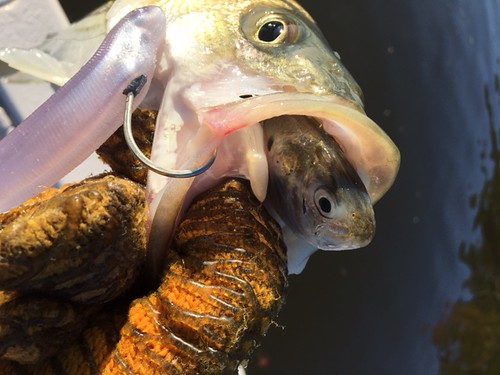
photo by Herb Floyd
Trolling is another option and pulling medium sized bucktails and swim shads or spoons behind planers and inline weights can be productive; you must get down to where the fish are. Umbrella rigs will need quite a bit of weight to get them down and unfortunately except for a few head shakes there will not be much fight in the fish. Some of the better locations to check for birds and suspended fish are Eastern Bay, Thomas Point to Dolly's Lump, the False Channel and the mouth of the Little Choptank.
Fishing along the shorelines of the bay and tidal rivers has been a fun way to catch striped bass with topwater lures. Water temperatures are in the upper 60's so striped bass feel comfortable in either shallow or deeper waters. Others are having good luck casting jerkbaits and swim shads from boats, local docks and shorelines in the morning and evening hours. This time of the year presents a wonderful opportunity for shore bound fishermen to travel down to local waters and enjoy some peaceful casting with a variety of lures.
Fishing for white perch could hardly be any better right now and they can be found in a wide variety of water depths. Bottom fishing with pieces of bloodworms on hooks or small jigs is a great way to fish the deeper waters. Small lures and ultra-light fishing tackle are a good choice for fishing shoreline structure areas.
In the lower bay region there seems to be striped bass spread from one end to the other and then some. All it takes is a moving tide and the action starts. Diving birds will shout the way to breaking fish and slicks will whisper that there may be something going on below. The edges of the shipping channel are a "Go to" when the tide is moving but the tidal rivers are also very good places to find striped bass. Frank Nesbit III and his friends reported nonstop action in the lower Potomac recently while jigging with pearl sassy shads near channel edges.
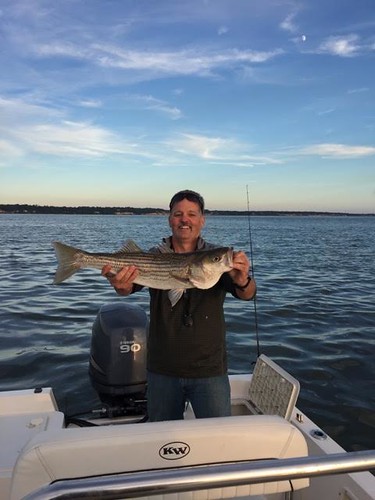
photo by Paul Skeens
Quite a few gray trout are being caught by those bottom fishing for the last remnant of the spot and croaker as they leave for parts south. The trout are spread from Tangier Sound to the western shore and they are also being caught by those jigging for striped bass. Anglers are reminded of the 13" minimum length and creel limit of one per day. White perch fishing has been excellent in the tidal rivers whether one is fishing deep with bloodworm tipped hooks or fishing shallower with small jigs and spinners.
There are still plenty of blue crabs to be caught by recreational crabbers and now that many commercial crabbers have switched over to oystering there is a little more elbow room. The better catches tend to be coming from the lower sections of the bays tidal rivers and deep.
In the freshwater fishing circles this month much of the excitement is about the fall trout stocking program and the fun fishing it provides across the state where most fishermen can find access to trout fishing close to home. Fisheries staff are busy stocking trout each week this month and they may be stocking a local favorite fishing hole of yours soon. The stocking schedule is not posted in advance like the spring trout stocking program so one needs to check the trout stocking website each day to see what has been stocked. https://dnr.maryland.gov/Fisheries/Pages/trout/stocking.aspx
Better yet is to be on the Fisheries email subscribers list and you will be notified by email within a few hours after the stockings are completed. https://dnr.maryland.gov/Fisheries/Pages/email.aspx
Many of the streams and rivers in the western portion of Maryland are running low and clear this week so light lines and a stealth approach is in order if one is fishing for trout or smallmouth bass. Deep Creek Lake water levels are down due to draw off and water temperatures are holding around 62 degrees. Casting jerkbaits, spinnerbaits and various soft plastics around grass beds or sunken wood and rocks is a good bet. Yellow perch are being caught on small jigs tipped with a piece of worm or live minnows under a slip bobber. The floating docks at the state ramp have been pulled and private floating docks are quickly disappearing also. The upper Potomac River water temperature is about 62 and water levels are low. Grass is breaking up and causing problems with fouled lures. Targeting submerged rock ledges and large boulders with tubes is a good choice.
Largemouth bass fishing has taken a new dimension as the bass have now shifted to a fall pattern and are freely moving in various water depths throughout much of the day. Shallow areas can be targeted with topwater lures, sunken wood and grass in intermediate depths are a good place to try whacky rigged stick worms, small crankbaits and spinnerbaits.
At the Ocean City area water temperatures at the inlet are hovering around the 70 degree mark this week. There are still a mix of kingfish, medium-sized black drum and small bluefish being caught in the surf on bloodworms, sand fleas and finger mullet. At the inlet there is much the same mix of species plus flounder are beginning to move through the inlet headed offshore and striped bass are being caught in the evenings. The channels leading to the inlet are the place to be this week if flounder are your target. The big push by flounder to exit the bays has not started in earnest yet but there is indication that flounder are moving towards the inlet. Small red drum are also being caught in the channels near the inlet and some are falling within the 18" – 27" legal slot size.
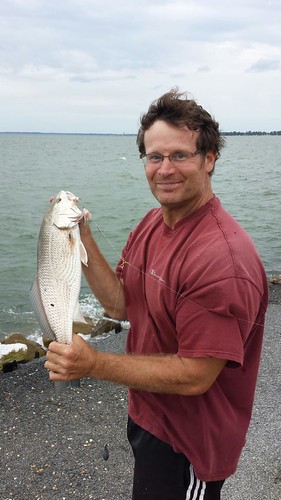
photo by Steve Hill
Offshore there have been some good catches of flounder at the wreck and reef sites with a mix of sea bass and assorted species coming over the rails. Farther offshore there are good numbers of small yellowfin tuna to be found at the canyons and the Rock Pile along with a mix of dolphin and wahoo.
"There are memories of both fish and fishing. Sometimes fish are taken and sometimes they are lost. Anglers often remember lost fish more clearly than those surrendered and fishless days remain as stubbornly in the mind as the happier memories of success. " -Ernest Schwiebert, Remembrances of Rivers Past
|  Date : 10/12/2016 (1) Date : 10/12/2016 (1)
| | 10/12/2016 | This is Erik Zlokovitz again, filling in for Keith Lockwood while he continues his hunting adventure out west. Keith will be back from his trip next week and I'm sure he will have plenty of great stories! The remains of Hurricane Matthew hit the Chesapeake Bay and Ocean City area over the weekend with moderate to heavy rains and gusty winds which kept most boat fisherman at the dock. Some wind gusts up to 50 miles per hour were reported in the Ocean City area. We were fortunate to avoid the damage and flooding which was experienced in the Carolinas and Southeastern Virginia. The rain and colder air temperatures have caused water temperatures in the Bay to drop down to the mid-60's. A few bluefish, red drum, speckled trout and stray flounder have been reported from the middle and lower portion of the Bay, but the Spanish mackerel seem to be gone due to the cooling water temperatures. The big ocean run migratory striped bass have not arrived yet, but small to medium sized fish are very active and have been spotted surface feeding in the upper and middle Bay. Recreational crabbing is also very good, but will not last long, so make sure you get on the water soon to take advantage of the fall harvest! John McMullen had a great "combo trip" on the upper bay, catching crabs and striped bass with friends Mike Yants and Chris Keithley.

Photo by: John T. McMullen
In the extreme upper Bay/Susquehanna area, striped bass are being caught by shore anglers at the Conowingo tailrace, Elk Neck State Park and Turkey Point. Striped bass are being caught on the bottom with bloodworms and cut fish bait, and also on flies, and small jigs. Topwater lures should work during morning and evening hours and on overcast days. Channel catfish have been biting well on the Susquehanna flats. Clam snouts have been the best bait for catfish, but they are also biting on night crawlers, cut fish bait and bloodworms.
The larger migratory striped bass have not arrived yet, but small to medium sized fish have been reported breaking on the surface and feeding on small baitfish such as anchovies and silversides over a wide area in the upper and middle Bay and in the rivers such as the Patapsco, Magothy, Severn, and West/Rhode system. Most anglers are jigging, trolling and fishing topwater baits, with a few folks still live lining spot. As I mentioned last week, the spot will be hard to obtain with the rapidly falling water temperatures.
Striped bass fishing has improved in the Lower Bay and in some of the southern rivers such as the Patuxent. The fish are not big but they are providing some action for trollers and jiggers using small lures to imitate the small profile baitfish. The majority of the Spanish mackerel have left the lower Bay, but there are still a few bluefish, red drum, and speckled trout being caught. A stray flounder was caught in the lower Patuxent River near Solomons. The rain did not scare Julie Tomasik off the water, and she caught this nice striped bass from her kayak on the Patuxent River.

Photo courtesy of Julie Tomasik
Recreational crabbing continues to be good in the rivers with good catches reported from the Severn River and upper Bay. If you have not had your fill of the blue claws yet, then this is the time to go out and harvest some fall-run heavy crabs!
On the freshwater scene, steady rains last week produced a much needed but small rise in upper Potomac River levels. The small increase in flow made navigation a bit easier and the fishing has been good, though the fragments of aquatic vegetation present a real challenge, especially for surface lures and moving baits with treble hooks. Smallmouth fishing on the Potomac has been consistent and will remain good well into the fall and early winter. The best options for smallmouth continue to be small, lightweight tubes or other plastic baits bounced along the bottom and swept over boulders and ledges. Fall is a wonderful time of year to be outdoors and it can be tough deciding what fish to pursue. Trout fishing in October can be excellent too. A recent trip to the Savage River tailwater produced many nice brown trout. The water was slightly stained and larger nymphs proved to be best. Don't put those rods away just yet!
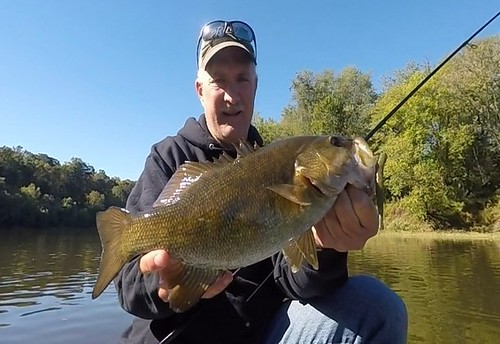
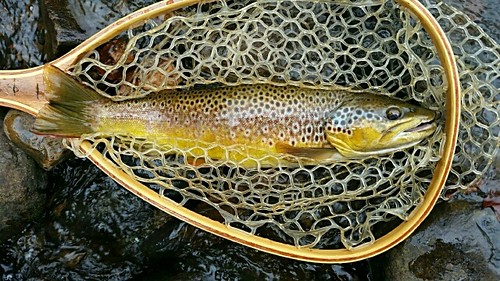
Smallmouth Bass and Brown Trout Photos courtesy of John Mullican
DNR Biologist Kenny Wampler out in Garrett County sent in the following report from a recent outing; the fishing at Deep Creek Lake is getting better with the recent cool weather and with water temperatures dropping into the low 60's. In recent outings I have fished for a mix bag of species and have covered the lake from deep water weed lines to docks in a few feet of water and I have found fish deep, shallow and everywhere in between. This time of year I like to throw jerkbaits, crankbaits, and jigs with a "match the hatch" approach. Using these lures along weedbeds has produced a mixed bag of bass, perch, walleye, pike and pickerel. Live bait should be in your arsenal as well. Jigs tipped with minnows, minnows under a bobber, and drifting worms should produce some action. Outside edges of weedbeds and drop offs have been good for live bait options. Live bait has produced mostly perch with an occasional walleye and bass thrown in the mix. Late fall is a great time to be on Deep Creek with little boat traffic and the fish will in a feeding 'free-for-all' in the weeks to come. Don't give up too soon, or you might miss a shot at a big Northern pike like this one caught by Rick Krivda.
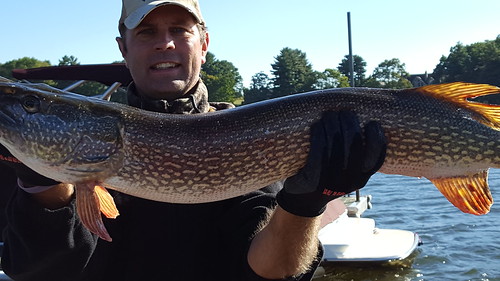
Photo courtesy of Rick Krivda
In Ocean City, wahoo and dolphin were biting well in the Washington Canyon before the remains of Matthew moved through, but offshore fisherman stayed tied to the dock during the storm and few reports have been seen after the big blow. The flounder bite has been very good near the inlet and sheepshead are biting well on the jetty rocks. Nice sized bluefish up to 6 pounds, and striped bass were hitting well on the Route 50 bridge. The classic lures here are Gotcha plugs, plastic jigs, and bucktails. Kyle Wasem and his friend were drifting the inlet using 4" and 6" gulp jigs and caught a lot of small sea bass, a short flounder, and found a school of 17"-20" red drum. These two pretty puppy drum were quickly released after the photo was taken.
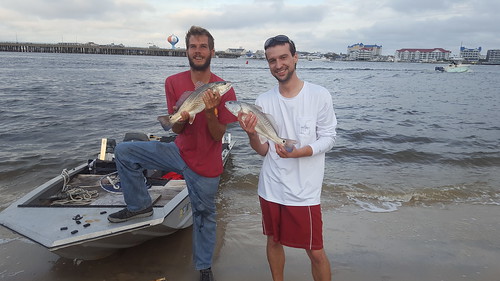
photo by Kyle Wasem
"Fishing provides that connection with the whole living world. It gives you the opportunity of being totally immersed, turning back into yourself in a good way. A form of meditation, some form of communion with levels of yourself that are deeper than the ordinary self" -Ted Hughes
|  Date : 10/5/2016 (1) Date : 10/5/2016 (1)
| | 10/5/2016 | This is Erik Zlokovitz, filling in for Keith Lockwood for the next two weeks while he is on a hunting trip in New Mexico. A major weather system with easterly winds and rain moved through the area on Wednesday through Saturday, which caused water temperatures in the Bay to drop further in Bay Waters. A combination of cooling water temperatures and lower salinity from the rain and freshwater input should start to push the summer visitors such as bluefish, Spanish mackerel, and red drum south towards their overwintering areas. The falling temperatures will also create new angling opportunities for resident fish in Maryland as they feed and prepare to fatten up for the upcoming winter months. For example, striped bass tend to bite well on topwater baits under overcast skies as the waters cool down.

Photo courtesy of Steven Snyder
In the extreme upper Bay/Susquehanna Flats area, water temperatures at the NOAA Data Buoy – "Susquehanna" – near Havre De Grace have dropped further to 72°. It seems that most of the rain during the last few days fell over on the Eastern shore, and the Conowingo Dam hotline reports that no flood gates have been open, so there is no extreme flow condition. Shore anglers have been reporting success on keeper size striped bass up to 27 inches in the Conowingo tailrace, using a fly or bass assassin in combination with a 2-3 ounce inline sinker and casting the rig with a long surf rod and 20lb braid.
In the upper bay region between Baltimore Harbor and the Bay Bridge, most striped bass are being caught on jigs, topwater baits, and trolling. Some folks are live lining spot around the Bay Bridge pilings, but this live bait will be less readily available as the water temperatures continue to cool down. The chumming bite which was steady all summer has also slowed down. Breaking fish have been reported anywhere from Love Point, south to the Bay Bridge, Poplar Island, and Thomas Point.
Fishing for white perch in the lower sections of the upper bay and middle bay's tidal rivers is slowing down in the shallows, but should be better in the deeper areas over hard bottom. Bloodworms and dropper rigs with small flies or plastics and small leadheads with twister tails work well.
Lower bay fishermen are were fishing on a mix of bluefish, Spanish mackerel and striped bass prior to the storm system on Thursday. The Spanish mackerel should be moving out now as waters cool.
Recreational crabbing continues to be good in the rivers with good catches reported from the Severn and West/Rhode systems. This is a good time of year to catch heavier crabs and boat traffic is very light.
The mid-Atlantic Region received much needed precipitation last week and the flows in most Maryland rivers and streams have improved. Smallmouth bass fishing on the upper Potomac has been good with most fish running 8 to 14" with larger bass thrown into mix enough to keep things interesting. Topwater baits fished during the evening hours have accounted for some of the larger bass while finesse-sized plastic baits fished on lightweight jig heads have been most successful under low, clear conditions.

Photo courtesy of John Mullican
The population of invasive flathead catfish in the upper Potomac has increased dramatically in recent years. The chance to catch large fish has attracted anglers to this fishery. Flathead catfish are excellent table fair and the Freshwater Fisheries Program encourages anglers to harvest these tasty predators to help control their numbers and reduce their potential to impact existing resources.
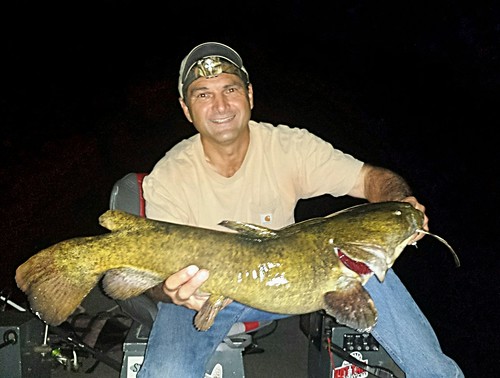
Photo courtesy of John Mullican
Freshwater fishing opportunities in Western Maryland are starting to increase. Drought conditions have been hampering trout fisherman in Western Maryland for a month or so. Cooler night time air temperatures along with a few days of rain should bring rivers and streams back to fishable form. Areas like the Youghiogheny and North Branch Potomac River, which has been experiencing historic low flows, will be fishing better due to last week's rain. Smaller streams which hold Brook Trout are also seeing the positive effects of rain and cooler temperatures. Environmental stresses on trout should ease and catch rates should go up.
Western Maryland's impoundments are also starting to fish better due to lower temperatures and increased rain fall. Surface temperatures, which have exceeded 70 ° the past couple weeks, have dropped. The lower temperatures have triggered fish activity and better fishing opportunities. Bluegill, Yellow Perch, and Smallmouth Bass, are being caught more frequently in areas like Deep Creek Lake. Early fall can be a great time to hook into a trophy Walleye or Northern Pike. As surface temperatures drop, game fish will be more active in shallow water and increase fishing opportunities throughout the month.
In Ocean City, there was very good white marlin fishing prior to the storm system. Wahoo and dolphin were biting well on Sunday after the system moved through. The flounder bite picked up inshore, and sheepshead were biting well around structure.
"The fishing was good; it was the catching that was bad." ~A.K. Best
|  Date : 9/28/2016 (1) Date : 9/28/2016 (1)
| | 9/28/2016 | A very exciting month approaches for all who fish in Maryland. October will see falling water temperatures and fish will be very active as they sense the change and prepare to fatten up for the winter months ahead. I will be absent from the fishing reports for the next two weeks as I spend some time chasing elk in the Rocky Mountains of New Mexico. Erik Zlokovitz has stepped up to the plate and I'm sure he will bring you the latest in fishing opportunities as we step into October.
At the very top of the Chesapeake Bay from Pooles Island north to the mouth of the Susquehanna and Elk Rivers an influx of legal-sized striped bass are moving into the area. Water temperatures have dropped to the 76° mark and there is developing early morning and evening topwater action in the shallower areas on the Susquehanna Flats and surrounding areas. The Conowingo Dam has been releasing very little water for the last few weeks so water clarity is very good.
Much of the striped bass fishing effort in the upper bay has switched to jigging, trolling and live lining spot. Schools of striped bass which tend to be sub-legal in size mixed with a few bluefish are chasing bait to the surface throughout the region so casting to the surface action or jigging deeper has been very popular. Legal-sized sea trout have recently been a welcomed surprise for those jigging in the upper bay. Those choosing to troll are pulling small Drone spoons, bucktails and surge tube lures ("hoses") behind planers and inline weights near channel edges or near concentrations of breaking fish. Live liners have been able to obtain a good supply of spot and are working the channel edges wherever suspended fish can be spotted on depth finders. The channel edge from Sandy Point Light north to above the mouth of the Magothy River, Brewerton Channel and the Bay Bridge piers have been good places to check for fish lately.
In the middle bay region, breaking fish composed of a mix of sub-legal and legal-sized striped bass, bluefish and the last of the Spanish mackerel are working over schools of bay anchovies throughout the region. The channel edges on both sides of the bay, Eastern Bay and the mouths of the region's tidal rivers have been providing a lot of action. Many of the striped bass are sub-legal but there are legal fish being caught, especially by jigging along with sea trout. Trolling has been popular and live lining spot is a very good way to target a better grade of striped bass wherever they can be found suspended along channel edges. The shallow water striped bass fishery is quickly improving with cooler water temperatures. Brad Foxwell holds up a nice striped bass he caught off of Chesapeake Beach.
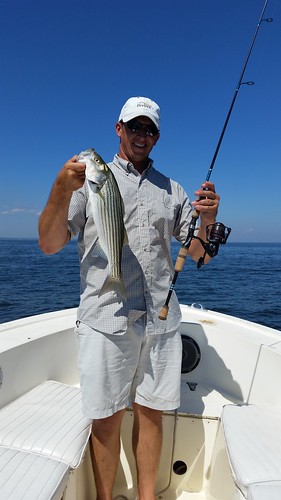
Courtesy of Bill Dickerson
Fishing for white perch in the lower sections of the upper bay and middle bay's tidal rivers has been very good in the deeper areas over hard bottom. Bloodworms have been the preferred bait but jigging with dropper flies is also a good way to catch a mess of white perch. Lower water temperatures are welcoming white perch to move into areas of shallow shoreline structure which opens the door for light tackle fishing with small spinners and jigs.
Lower bay fishermen are enjoying good fishing on a mix of bluefish, Spanish mackerel and striped bass that are working over schools of bay anchovies throughout the region. There is plenty of fun surface action along with jigging. The topwater action tends to comprise bluefish, Spanish mackerel and sub-legal striped bass. Jigging down deep has been offering better chances at larger striped bass with the bonus of sea trout and once in a while a screaming drag that signals the run of a large red drum. Trolling has been productive and most are pulling small Drone spoons, surge tube lures and bucktails behind planers and inline weights. It also pays to have at least one large spoon out in the trolling spread for a possible cobia or large red drum that are still in the region. The greatest concentration of large red drum and cobia has been at the Middle Grounds and cooler water temperatures are signaling them to start moving south with the Spanish mackerel.
Bottom fishing for large spot has been very good in the lower Patuxent River and good over in the Tangier and Pocomoke Sound areas. On the eastern side of the bay there is also a mix of speckled sea trout, kingfish and gray sea trout being part of the bottom fishing mix. White perch fishing has also been very good in the region's tidal rivers.
Recreational crabbing continues to be good this week and those out on the water at dawn are noticing the crowds are thinning out. This is the best time of the year to catch a bushel of heavy crabs and those who make the effort can start to pick crabs to put away in the form of crab cakes and picked crab meat for the coming winter months. This heavy whopper will make for some fine eating.
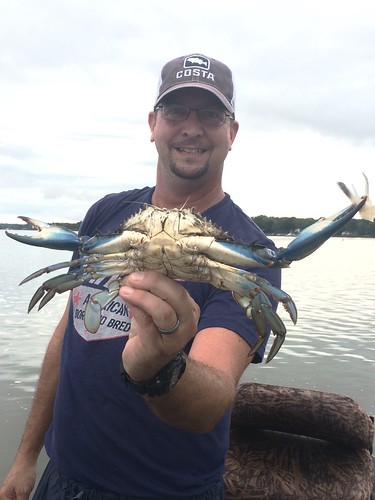
Photo courtesy of John T. McMullen
Before we get in to the freshwater fishing action, here is another update on Bay water conditions (salinity and temperature) from the DNR water quality monitoring team.
Elevated Bay Salinities - Maryland's portion of the Chesapeake Bay continues to show higher than average salinities (Orange squares). This allows fish typically only found in the higher salinity areas of the lower Bay (such as Spanish mackerel and bluefish) to move farther into Maryland waters.
Heavy rains are predicted over the next several days and may result in decreasing salinities. For more info on Bay conditions see eyesonthebay.dnr.maryland.gov/eyesonthebay/currentconditions.cfm.
Cooling Bay Water Temperatures - Chesapeake Bay water temperatures continue to cool across Maryland waters. Real-time Chesapeake Bay surface water temperatures are available at NOAA's buoybay.noaa.gov.
Note: Data for the map is collected by both Maryland and Virginia monitoring teams and funded by both States and EPA's Chesapeake Bay Program.
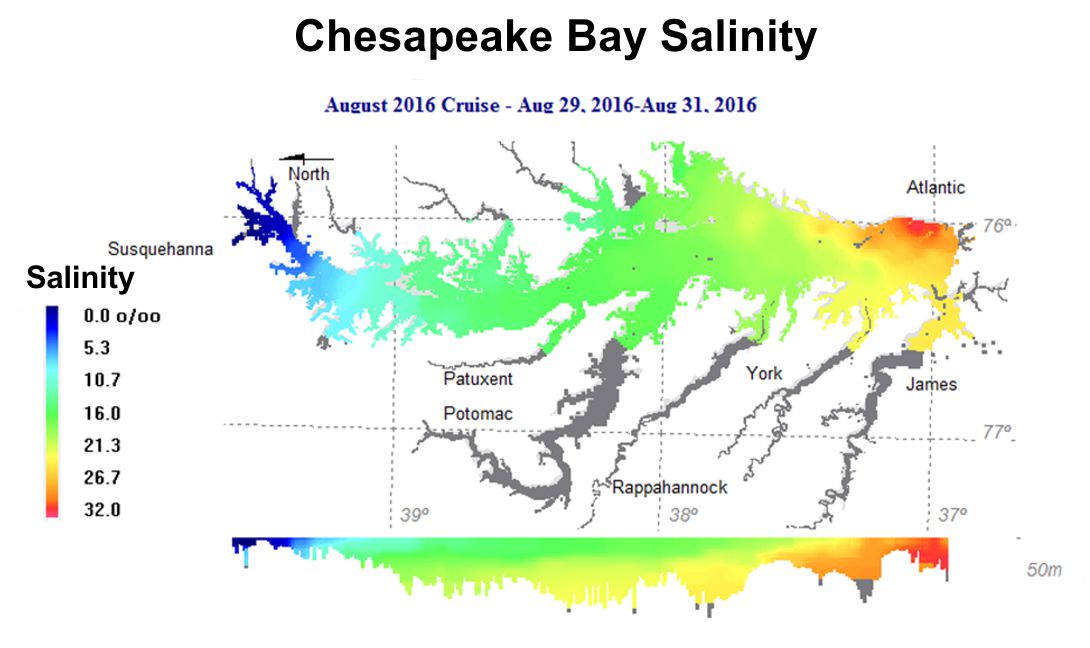
August Salinites Interpolated-2016

August Salinites-2016
Freshwater fishing is beginning to transition out of the lazy summer mode of fish behavior as water temperatures steadily fall to more comfortable levels for all species of fish. Water levels in most streams and rivers are rather low this week but today's rain storms and those that follow will do much to lower water temperatures further and bring water levels up. The upper Potomac River water levels for example has been running very low and clear and are about 75° prior to today's rain. Deep Creek Lake is experiencing significant draw down and lake levels are down about 3' and disrupting largemouth and smallmouth bass fishing near shallower structure. Floating docks and deeper structure have been the best places to target with whacky-rigged stick worms or soft plastics.
The tidal rivers are offering good largemouth bass fishing this week. The Eastern Shore rivers and the tidal Potomac are providing good topwater action in the mornings and evenings. A falling tide makes for near perfect conditions over grass or on the outside edges of grass beds and spatterdock fields. Northern snakeheads will also be part of the action in many tidal rivers as they continue to expand their range. Spinnerbaits and small crankbaits are good choices also for working the outside edges. Whacky-rigged stick baits and soft plastics are a good choice for working sunken wood or similar structure in deeper waters. This big northern snakehead came from the waters near Blackwater in Dorchester County.

Photo courtesy of Ernest Goff
Fishing for channel catfish in the tidal rivers is starting to improve with cooler water temperatures. Soon blue crabs will begin to move down the rivers and there will be less interference with baits fishing close to the bottom. Fishing for blue catfish in the tidal Potomac continues to be a good choice for anyone wishing to stock up a freezer with mild fish fillets. Fishing for bluegills is also a good option for anyone looking for some fun action in the many lakes and ponds that dot the Maryland landscape. A simple worm or cricket under a bobber is a good choice or small lures for spinning gear as well as rubber-legged poppers for fly fishing.
At the Ocean City area the summer tourist crowds are thinning and the fishing is improving on all fronts. Surf fishing continues to focus on a mix of small summer species but those casting larger baits are catching and releasing large red drum and also catching some medium-sized black drum and bluefish.
At the Inlet and Route 50 Bridge area flounder fishing has been very good, especially near the South Jetty; sheepshead, medium-sized black drum and triggerfish are being caught on sand fleas. The channel areas leading to the inlet area are providing very good flounder fishing as cooler water temperatures begin to tickle flounder into considering migrating out the inlet for offshore waters. Gulp baits and live spot have been accounting for the largest flounder.
Outside the inlet there has been some excellent flounder fishing on the inshore shoal areas as well as the wreck and reef sites. A mix of triggerfish, sea bass and northern blowfish are also being caught depending on baits used.
At the canyons fishing for white marlin has been very good with multiple catch and release numbers being common. Some exceptional gaffer size dolphin and large yellowfin tuna are being caught at the various canyons along with a few wahoo.
"Go afield with good attitude, with respect for the wildlife you hunt and for the forest and fields in which you walk. Immerse yourself in the outdoor experience. It will cleanse your soul and make you a better person." - Fred Bear
|  Date : 9/21/2016 (1) Date : 9/21/2016 (1)
| | 9/21/2016 |
At the very top of the bay water temperatures near the Susquehanna Flats area are still around 79° this week. One of the contributing factors is that very little water is coming through the Conowingo Dam. Recent rain may change that and help water temperature fall to a more comfortable level for striped bass. There is a limited amount of topwater action early in the mornings but legal-sized striped bass are hard to come by. Lane Miller is very happy with this nice striped bass he caught on a topwater lure near Battery Island.
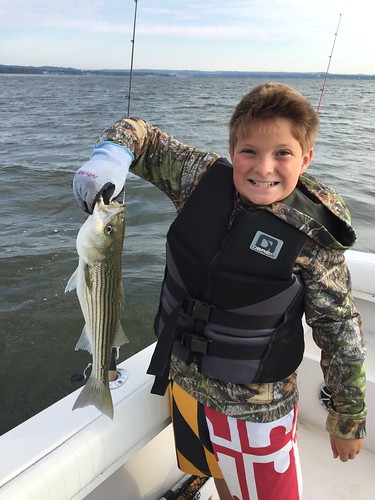
Photo courtesy of Shane Miller
Farther down the bay sub-legal striped bass can be found chasing bait and marked by diving gulls throughout the upper bay region with larger striped bass, small bluefish and the occasional Spanish mackerel being mixed in at times. Favorable water conditions in the middle and lower bay regions seem to be drawing striped bass in the over 20" size range farther south.
Fishing for white perch has been very good in most of the region's tidal rivers and hard-bottomed reef and shoal areas in the bay. In some of the shallower areas, spot are also being found. Live lining spot continues to be popular along the western edge of the shipping channel from Baltimore Light to the mouth of the Magothy River and near the deeper piers at the Bay Bridge.
The middle bay region has plenty of action this week as a mix of striped bass, bluefish and Spanish mackerel actively chase schools of bait throughout the region. Most of the striped bass are from 12" to 16" in length and tend to be the ones seen on the surface chasing schools of bay anchovies. The larger striped bass may be found underneath the surface action by jigging or by live lining spot along channel edges or trolling. The 30' channel edge from Dolly's Lump south to Thomas Point has been a popular place to live line as well as off of Poplar Island and the False Channel. Trolling a mix of small Drone spoons, bucktails and surge tube lures (hoses) behind planers and inline weights has been a good way to catch a mix of striped bass, bluefish and Spanish mackerel along channel edges and near breaking fish. Water temperatures in the middle bay region are holding around 77° this week and salinities are 17p.p.t. out in the main stem of the bay.
Cooler water temperatures in the tidal rivers will help revive the shallow water fishery for striped bass in the next week or so. Topwater lures are the favorite for this type of fishing along likely looking shoreline on a high falling tide in the mornings and evenings. White perch can also be found in these same areas and can be targeted with lighter tackle, spinners and small jigs. Bottom fishing for white perch has also been very good in the deeper waters of the lower tidal rivers over good oyster bottom. A mix of spot, croaker, northern puffers (also known as "blowfish") and the occasional, small red drum or sea trout may also round out the mix. Blowfish always get a chuckle out of everyone when they inflate while being unhooked. This is a defense mechanism when the fish is under duress. (Hint: rubbing the belly often triggers a response which causes the blowfish to inflate). Here is a blowfish in its non-inflated natural state, caught by Elvin Philip in the Choptank River.
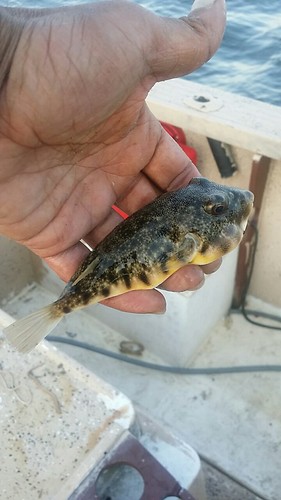
Photo Courtesy of Elvin Philip
Anglers in the lower bay region are enjoying a wide variety of fishing opportunities this week as larger numbers of striped bass move into the region from the north and bluefish and Spanish mackerel round out the mix. This trio of predatory fish are chasing schools of bait in the lower bay region and are often marked by diving sea gulls who are joining in when bait is driven to the surface. Most of the striped bass are small but there are fish over 20" in the mix and they can often be found deeper by jigging. Trolling a mix of small Drone spoons, surge tube lures and bucktails behind planers and inline weights has been a very effective way to get in on the action near channel edges and on the outside edges of breaking fish or when suspended fish can be marked. The action extends into the lower Potomac and Patuxent Rivers, east to Tangier Sound and north to the middle bay region. Speckled trout are being caught along the Eastern Shore tidal marshes, rivers and creeks by casting Gulp Mullet baits and similar soft plastics as well as by drifting pieces of soft crab baits.
Large red drum continue to provide exciting catch and release action in the vicinity of Buoy 72, the Target Ship and the HS Buoy. Most are being caught by trolling large spoons but jigging when schools can be located is also very effective and provides some intense rod bending action. There are still some cobia in the region and they are being caught by chumming near the Target Ship or farther south below Smith Point.
The bottom fishing for large spot has been one of the greatest opportunities in the lower bay region. The large spot are stacked in the lower Patuxent River and to a lesser degree in the Tangier Sound area. White perch are being caught in just about every creek and tidal river from the Eastern Shore to the Western Shore. The larger ones are being caught on bait in the deeper waters over good oyster bottom. Casting small lures along shoreline structure in the mornings and evenings is also effective and light tackle fun.
Recreational crabbing has been good to excellent in most regions of the bay this week. The upper bay tidal rivers are providing the best crabbing of the season and the middle and lower bay regions have been excellent. Larger male crabs are filling out and are a welcomed sight. Sooks and small crabs are a large part of what is being found on trotlines and collapsible crab traps this week.
Cool nights are beginning to lower water temperatures in the freshwater reservoirs of the western and central regions and fish are starting to show signs of increased activity. Smallmouth and largemouth bass are becoming more active at Deep Creek Lake and fishermen are enjoying the decreased boat traffic. Floating docks and grass are good places to target with whacky rigged stick worms and small crankbaits. The federal boat ramp at Jennings Randolph Lake has been closed due to low water levels but the Maryland DNR ramp off of Mt. Zion Road is extended enough to be useable.
The many small ponds and larger lakes that dot the Maryland landscape are providing plenty of good largemouth bass fishing. Extended daylight is becoming a bit sparse these days and making it easier to get out on the water at dawn to enjoy the early morning topwater action. Targeting shallow grass and structure with frogs and poppers provides exploding surface strikes that help define what largemouth bass fishing is all about. The evenings will also be a good time to give this tactic a try. Targeting thick grass and woody structure with whacky- rigged soft plastics during brighter daylight hours will tease shade seeking bass to strike. Jayden Venable got to spend some time at his favorite local pond and holds up a nice largemouth he caught.
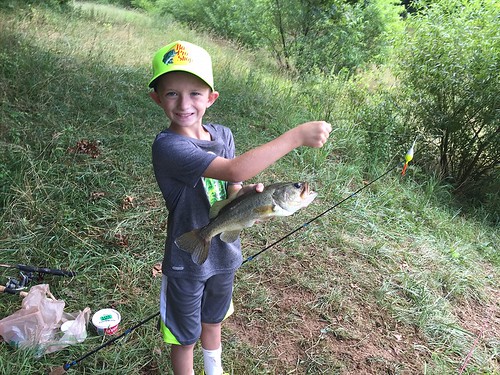
Photo courtesy of David Jackson
The Ocean City area is seeing water temperatures dipping to the 72 degree mark this week and as September rolls along subtle changes are beginning to occur with the regions summer migrant species. A mix of kingfish, blowfish, croaker, small bluefish and flounder are being caught in the surf this week. At the inlet a few striped bass and sea trout are being caught in the evenings along with bluefish. Live lining spot has accounted for a good portion of the sea trout and striped bass being caught along with some large flounder. In the back bay areas the water clarity is improving and flounder fishing has been good. Large Gulp baits and live spot have been catching the larger flounder.
Offshore some nice flounder are being caught on the nearshore shoal areas and the wreck and reef sites. At the canyons white marlin catches have been very good with multiple releases being common. A mix of medium-sized yellowfin tuna, dolphin, wahoo and blue marlin round things out.
"Perhaps fishing is, for me, only an excuse to be near rivers. If so I'm glad I thought of it." - Roderick L. Haig-Brown
|  Date : 9/14/2016 (1) Date : 9/14/2016 (1)
| | 9/14/2016 | Anyone paying attention to the outdoors can't help but notice the Maryland landscape is showing signs of changing. The vibrant green of trees is rather dull, and in some areas the leaves are turning brown and falling to the ground. The color change and the falling leaves during this time of year are caused by the general lack of rain. There is no question many areas could use some rain to replenish streams, rivers, lakes and ponds. On the brighter side, despite a recent return of hot weather, the evenings are a bit cooler and profound changes in our freshwater and saltwater fisheries are not far away with cooler weather approaching.
Water temperatures in the upper bay near the mouth of the Susquehanna River have remained above 80° this week due to hot weather and the lack of water releases from the Conowingo Dam. There has been some early morning topwater action in the area but most of the better fishing for striped bass is occurring farther south starting in the area around Pooles Island and extending to the Bay Bridge. There has been good striped bass fishing by a variety of methods. Breaking fish are being encountered from the Rock Hall area south to the Bay Bridge and casting or jigging has offered a lot of fun light tackle action. A large portion of the breaking fish are composed of sub-legal striped bass and bluefish but there are larger striped bass mixed in. Trolling small spoons such as Drone spoons behind planers has also been very effective along channel edges. Live lining spot has been by far the most popular method of catching a nice grade of striped bass. The most productive areas have been the channel edge from Sandy Point Light north to the 30' channel edge below Belvidere Shoal. There has also been good action over near Love Point on the 30' channel edge there and the deeper Bay Bridge piers. Nick Long got to go fishing with his dad recently and gets a little help from dad while posing with this beautiful 35" striped bass that Nick caught above the Bay Bridge.
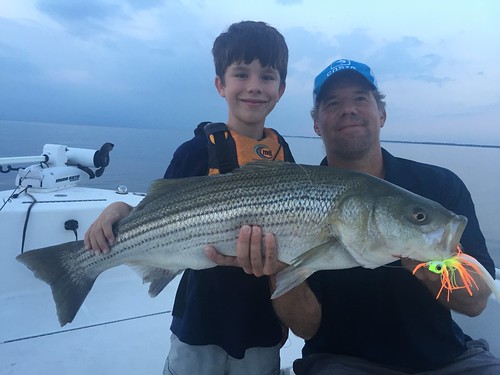
Photo courtesy of Travis Long
Striped bass fishing in the major tidal rivers of the upper bay has been relatively slow recently, mostly lightly due to elevated water temperatures. It may take a 10° drop in water temperatures or more to revitalize this shallow water fishery near shoreline structure. White perch have been filling in the void for light tackle fishing and they are being found near piers and rocks.
In the middle bay region a mix of striped bass of various sizes, small bluefish and Spanish mackerel can be found busting through schools of bay anchovies and small menhaden throughout the region. Some of the more active areas are the western side of the bay from Hackett's Bar south to the Power Plant, Eastern Bay, the Buoy 83 area, the False Channel and the mouth of the Little Choptank. Diving birds often mark the way but slicks are not to be ignored since they are telltale signs of recent feeding activity or present activity down deep. Casting various types of metal and jigging are a fun way to enjoy some light tackle action.
Trolling Drone spoons, bucktails and surge tube lures (hoses) behind planers is a great way to get into the mix of striped bass, bluefish and Spanish mackerel. Live lining along the 30' channel edges on both sides of the bay has been the most popular method of fishing when a larger grade of striped bass are on the agenda. Pesky bluefish do tend to take a toll on spot now and then but placing a chunk of fresh spot on a hook and drifting back can wreak some revenge and also provide some tasty eating whether smoked or grilled.
Much like other regions in the bay the shallow water topwater fishing for striped bass along shorelines in the bay and tidal rivers has not really kicked into gear yet. Water temperatures are close to 80° and it is just too hot to entice larger striped bass to venture into shallower waters to feed. There is some white perch fishing to be found in these areas but unfortunately most of the white perch are less than 10".
Due to the lack of rain the salinities in the bay are relatively high and those that are bottom fishing are seeing all kinds of summer visitors that are not so common other times of the year. Northern puffers, burrfish, northern and southern kingfish, small sea bass, cobia, small tautog and small red drum along with their parents that often exceed 40 lbs. or more. It can be challenging at times to identify fish that you are not used to seeing in the Bay. One fish that can easily fool you are juvenile black drum, which a look like the sheepshead. When black drum are small they exhibit strikingly bold vertical stripes that can cause some confusion with a sheepshead. Black drum do not have the bold enameled teeth that sheepshead have and they also have barbels under their chin which sheepshead do not.
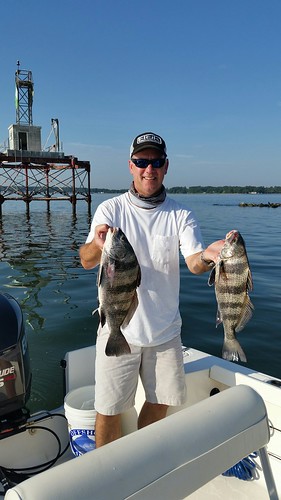
Black drum photo courtesy of Paul Roser
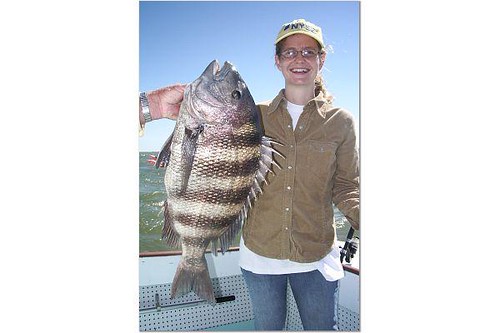
Sheepshead photo courtesy of Margaret Taylor
Bottom fishing for a nice grade of white perch has been good in the deeper waters of the bay and tidal rivers over good oyster bottom this week. Most are using bottom rigs baited with bloodworms when targeting white perch and spot. Peeler crab can work at times and is usually the preferred bait when croaker fishing. Croaker fishing remains fair in the middle bay region and is mostly an evening affair near channel edges leading to shoal areas.
The lower bay is providing a wide variety of fishing opportunities this week ranging from excellent bottom fishing to exciting breaking fish. A mix of striped bass, Spanish mackerel and bluefish are being found chasing bait throughout the region and at times large red drum can be part of the mix. Most of the action is taking place out in the bay from the mouth of the Potomac up along the western side of the shipping channel and from the Middle Grounds north past the Target Ship up to Hooper's Island on the eastern side of the bay. Light tackle casting and jigging to breaking or suspended fish has been popular. Trolling Drone spoons behind planers along with surge tube lures and bucktails has also been a very effective way to get in on the action. There has also been some limited live lining prospects off of Cedar and Cove Points. Large red drum and cobia are still being found in the vicinity of the Target Ship and below Smith Point.
Bottom fishing for large spot has been very good in the lower Patuxent River and Tangier Sound. White perch fishing in the tidal rivers has been good and croakers can be found in about 25' of water in the evenings near channel edges. Fishing for medium-sized blue catfish has been excellent in the lower Potomac River from the mouth of the Wicomico River up past the Route 301 Bridge.
Recreational crabbing continues relatively good to excellent this week. The upper bay is providing fair to good crabbing depending on which tidal river one crabs in. The Magothy and Chester have been good but others are reporting mixed results. In the middle and lower bay regions crabbing has been good to excellent with the largest crabs coming from deeper waters. The recent massive shed of a week to two weeks ago has caused a lot of light crabs to be a major component of the fishery this week, as are sooks. Check crabs carefully and toss those light ones back since it will only take a week or so for them to fill out.
Most have noticed that despite the return of relatively hot weather, the nights are a little cooler, which is signaling a slow shift towards fall. Flows in many of the streams and rivers throughout Maryland are low due to the lack of rainfall and lakes and ponds are lazily holding on to what is left of summer.
The upper Potomac River is running very low this week causing grass to appear thicker and water clarity to be very clear. It pays to downsize lines, think about fluorocarbon and make casts towards likely looking structure from farther than normal distances. Smallmouth bass tend to be spooky under low and clear water conditions. There has been good fishing in the grass and deeper submerged ledges and boulders with stick worms and tubes. In the early mornings and late evenings topwater lures can work well over grass for smallmouth bass also.
In the tidal Potomac River water temperatures are close to 78° and grass has been the main target for largemouth bass fishermen using topwater lures and stick worms. As tides recede working the edges of grass with spinnerbaits or small crankbaits can be a good option.
The tidal rivers of the Eastern Shore offer plenty of elbow room for largemouth bass fishing with good water quality and beautiful surroundings. A mix of largemouth bass, chain pickerel and northern snakeheads can be found near grass or spatterdock beds and sunken wood. Topwater lures such as frogs work well over grass and spatterdock for largemouth bass and northern snakeheads at higher tides in the mornings and evenings. During brighter hours of the day targeting sunken wood and the shade of overhanging brush or docks is a good bet with a variety of soft plastics. Gabriel Kiebler got to go fishing with his mom and dad after school and holds up a nice largemouth bass he caught.
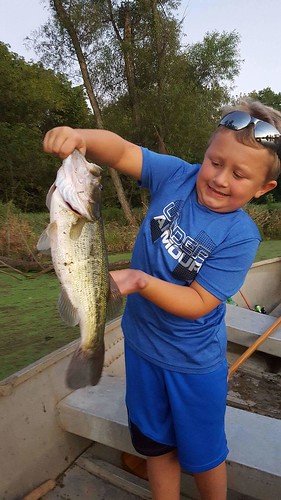
Photo courtesy of Jamie and Bob Kiebler
Large reservoirs and lakes continue to offer good fishing for a variety of fish. Many of the WSSC reservoirs hold a wide variety of fish ranging from landlocked striped bass and white perch to smallmouth bass and the ever popular largemouth bass. All are in a summer mode of activity so one needs to fish accordingly.
Crews are busy at the state's trout hatcheries preparing for the October trout stocking of many of Maryland's trout management waters. The stockings are scheduled to begin in October and they will be posted as they occur on the trout stocking website and to Fisheries email subscribers. There is no advanced stocking notice as is traditional with the spring stocking of trout. The link below will take you to the trout stocking website and there is also a link there to become an email subscriber.
As the Ocean City area winds down its traditional summer tourist season fishing is kicking into high gear. Surf fishermen are enjoying a nice mix of small bluefish, kingfish, croaker, spot and flounder in the surf. At the inlet flounder are being caught along with sheepshead and triggerfish near the jetties during the day. Spot are becoming more available and drifting live spot is accounting for some very large flounder, weakfish and striped bass. In the back bay areas, flounder fishing has greatly improved with better water clarity in the channels.
Outside the inlet flounder are being caught on the nearshore shoal areas and farther offshore at the wreck and reef sites. Farther out the offshore fishing fleet is finding the best white marlin fishing of the season. Double digit releases per trip are not uncommon with blue marlin and sailfish also being part of the action. Dolphin, wahoo and yellowfin tuna are rounding out the offshore mix. The Poorman's, Washington and Norfolk Canyons along with the Rock Pile have been the most popular fishing destinations.
"Voluntary adherence to an ethical code elevates the self-respect of the sportsman, but it should not be forgotten that voluntary disregard of the code degenerates and deprives him." - Aldo Leopold
|  Date : 9/7/2016 (1) Date : 9/7/2016 (1)
| | 9/7/2016 | There is an old saying among outdoor adventurers and a good motto for all: "prepare for the worst and enjoy the best". Those words rung true this past weekend as Hermine passed by our coastal areas with little more than wind, choppy sea conditions, higher than normal tides and for Ocean City some rain on Saturday. The best part of this was the cooler temperatures that brought down water temperatures throughout Maryland. If fish can smile they surely are in relief this week.
Fishing for striped bass near the mouth of the Susquehanna and Elk Rivers is steadily improving near the outside edges of the flats. Water temperatures are slowly falling but the fishing there is still an early morning, late evening affair with topwater lures. Although a good portion of the striped bass are falling short of 20 inches, there are enough larger fish to keep everyone happy.
Farther down the upper bay region striped bass are being found chasing schools of bay anchovies and providing some fun fishing for those casting to the surface action or jigging below. Most of the fish being encountered are undersized but there are fish over 20" being found mixed in. There has also been similar action in the mouths of some of the region's major tidal rivers. Trolling has been another option and most are pulling small spoons and bucktails or umbrella rigs down deep along channel edges. Chumming and live lining spot and white perch continues to be productive near Love Point and Swan Point. Mike Genco was fishing near Pooles Island when he got a surprise with this black drum which he released.

Photo courtesy of Mike Genco
The Bay Bridge piers and rock piles have been providing striped bass action for those live lining spot near the deeper piers. Others have been having good success with jigging bucktails and soft plastics. Pesky small bluefish have been rough on soft plastics.
White perch fishing has been very good in the upper Bay's tidal rivers and creeks this week with some of the better catches being made with bloodworm baits in deeper waters. Spot are being caught on hard bottom in some of the shallower areas and near the shallow ends of the bay bridge.
In the middle bay region all the news is about falling water temperatures and breaking fish. The surface water temperatures have dropped about 10° in the past week and despite another pulse of hot weather this week, water temperatures should continue to stay below 80°. Breaking fish composed of various sizes of striped bass, Spanish mackerel and small bluefish are being seen throughout the middle bay region. The mouth of Eastern Bay, off Chesapeake Beach, the mouth of the Choptank and Little Choptank have been common places to encounter this deadly trio making life tough for bay anchovies and small menhaden. Casting to the breaking fish or jigging underneath is always fun and it also pays to keep a sharp lookout for slicks that can indicate there is mayhem occurring beneath the surface or there was some recent action. Depth finders have great value this time of the year and definitely earn their keep.
Trolling has been a good option and most are trolling a collection of small spoons, surge tube lures and bucktails. Surge tube lures and bucktails are generally being pulled behind inline weights and small spoons behind planers for a mix of striped bass, bluefish and Spanish mackerel. Large red drum are in the region and it pays to put out at least one large spoon in a trolling spread.
Live lining spot has been center stage for those seeking a nice grade of striped bass along channel edges from Dolly's south to Breezy Point and near the False Channel at the mouth of the Choptank. More than a few live liners have been getting a little more than they bargained for when large red drum pick up a live spot and take off for parts unknown. Fishermen have been watching in disbelief as line vanishes off reels and they are left with an empty spool. Kevin Lengerhuis holds up a nice striped bass he caught while live lining recently.

Photo courtesy of Gary Lengerhuis
As of late last week the shallow water striped bass fishery in the middle bay region was a bit lackluster to say the least due to high water temperatures. In many areas the waters were also churned up from large gatherings of recently pupped juvenile cow-nosed rays rooting up the shallows and causing a lot of floating grass. As if to add insult to the whole scene stable flies have been out in force hammering away at ankles and driving the most peaceful anglers into madness. I'm not sure how much longer these pests will be around but if you're going out, don't forget the bug spray.
White perch fishing has been improving along shoreline structure areas as water temperatures drop and the best catches have been coming from some of the deeper water areas. Casting off a dock or pier with a simple bottom rig baited with bloodworms or grass shrimp has been paying off with some nice perch. If your dock or pier is extensive and over deep water, don't cast out but fish directly below close to the pilings. That is where the perch will be. There has been some limited croaker fishing in the evenings near channel edges out in the bay but generally it is nothing to write home about. The croakers are about 10" to 11" in size and the fishing is fair at best.
The lower bay region continues to have some exciting big game fish action as large red drum and cobia provide some of the most exciting fishing to be found in Maryland waters. The red drum are big with some being reported to be over 50 lbs. or more, They are being caught by trolling large spoons or by casting large spoons or soft plastic jigs to schools of red rum feeding on menhaden. At times the red drum are pushing the menhaden to the surface which makes for a very exciting scene. The area around the Target Ship and the Mud Leads tend to be ground zero but feeding red drum can be spotted most anywhere on the eastern side of the bay. This is of course a catch and release fishery only so be prepared ahead of time with cameras and a routine to get the fish released as quickly as possible.
Cobia fishing remains great from the middle Grounds/ Buoy 70 area up past the Target Ship. The most common way to fish for cobia has been to chum and drift menhaden baits back into the chum slick. Bluefish and the occasional striped bass have also been part of the mix.
Breaking fish are being spotted throughout the lower bay region from the Potomac to Tangier Sound. The action tends to be made up of striped bass mostly under 20", bluefish and Spanish mackerel. Bay anchovies tend to be "what's for dinner" with this group but small menhaden can get caught up in the carnage also. Casting spoons or jigging underneath are the most common ways to fish but trolling along the outside edges of the action can also pay off.
Bottom fishing in the lower bay region for a mix of large spot, medium-sized croakers, white perch along with small bluefish and sea trout has been very good. The lower Patuxent and Potomac have been offering some of the best opportunities but the Tangier and Pocomoke Sound area has also been offering good fishing.
Recreational crabbing continues to be very good in most areas in the bay's tidal rivers and creeks. In the upper bay regions there are good reports from the Gunpowder, Chester and Magothy Rivers. The middle bay region has been offering excellent crabbing with some of the largest crabs coming from deeper waters and razor clams continue to be the bait of choice for the best catches. Unfortunately small crabs and sooks are chewing up clam bags and for that reason chicken necks are beginning to gain favor. In the lower bay region it is almost impossible to find any tidal river or creek that is not offering outstanding crabbing opportunities this week.

Photo courtesy of Jim Livingston
Before we get into the freshwater fishing reports, here is an update on Bay water conditions from the DNR water quality monitoring team. This information will help to point you in the right direction for locating striped bass in the Bay. (Hint: surface water temperatures are cooling off which means that fish will start to spread out over a wider area).
Striped Bass water quality update
- Based on the latest Maryland DNR water monitoring data collected August 29 - 31, 2016 there are still large areas of mid-bay deep water habitat (deeper than 25 feet) with oxygen conditions unsuitable for Striped Bass.
- While surface water temperatures are still warm for striped bass, they are well mixed and have cooled to 80 F at the Susquehanna down to the 77 F waters from the Patapsco down to the Potomac River, providing Striped Bass with more areas within their temperature range. Real-time Chesapeake Bay surface water temperatures are available measured at NOAA's buoybay.noaa.gov website.
- Note: Data for the map is collected by both Maryland and Virginia monitoring teams and funded by both States and also EPA's Chesapeake Bay Program.
Finding early September Striped Bass in Maryland's portion of the Chesapeake Bay
- Last report suggested anglers explore the Chesapeake Bay bridge area from Rock Hall down to the Choptank River, at depths shallower than 25 feet, including surface waters. However, with the 5 degree drop in water temperature, the range up and down Bay will likely expand. Continue to focus on depths shallower than 25 feet deep.
- The best fishing areas could be further refined by intersecting these prime areas with underwater points, drop-offs, large schools of baitfish and moving water.
- These patterns will continue until there are major changes in weather such as high sustained winds, long periods of cool weather or rain.
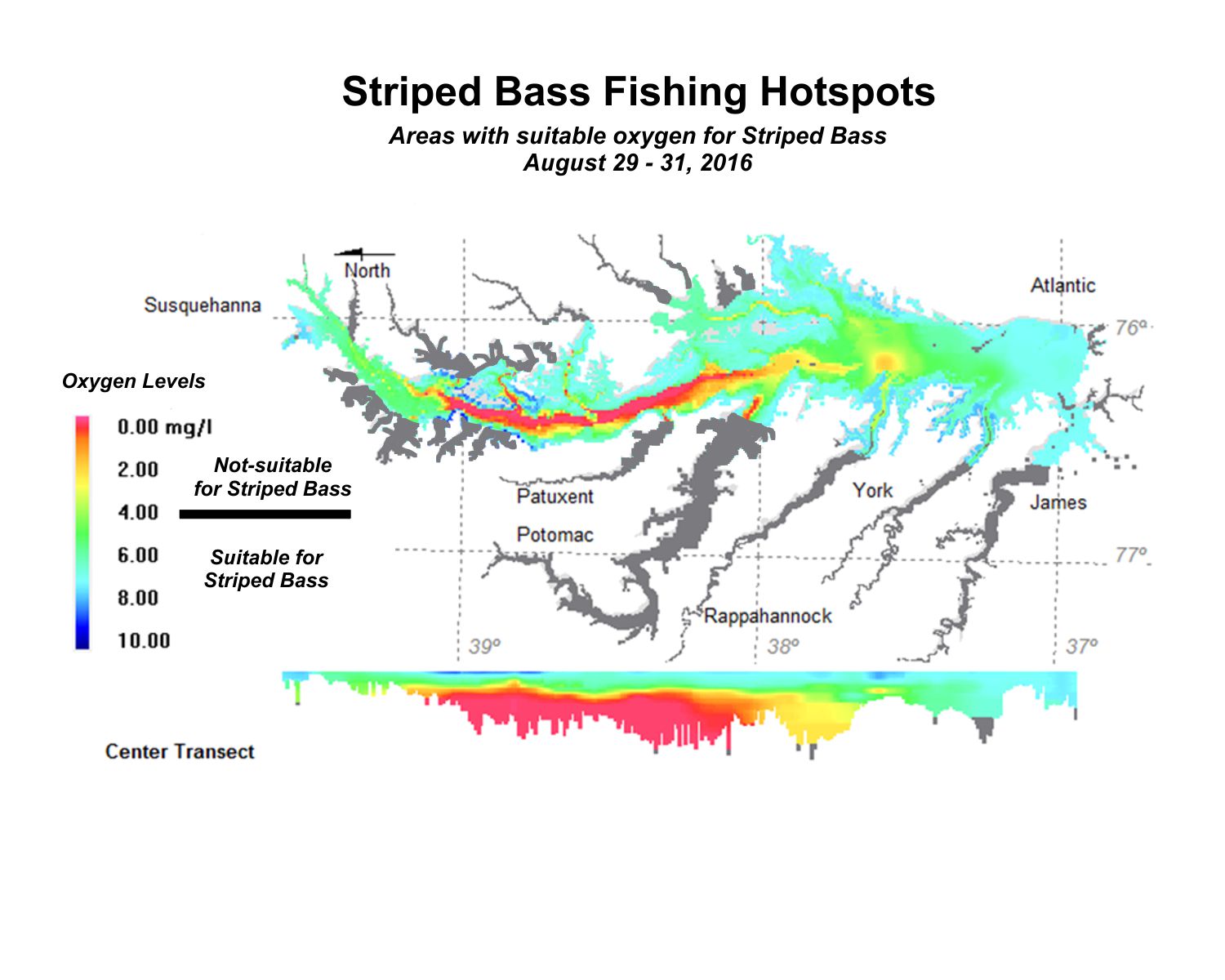
Courtesy of Maryland DNR
Cooler weather means cooler water temperatures for freshwater fish species and with those cooler water temperatures comes increased fish activity. The early morning bite will start to last longer into the mid-morning hours and the evening action will start early.
At popular resort areas like Deep Creek Lake the lake will start to become more civilized as summer vacationers begin to haul boats out for long term storage and peace one again returns to the lakes waters. Shoreline waters will show less staining from boat wakes and boat traffic in general will lessen. Smallmouth bass are being found over rocky points and near some of the floating docks over deeper water. Largemouth bass are near grass and shoreline structure such as fallen treetops and floating docks. Yellow perch and walleye are holding near deep grass and northern pike and chain pickerel are in the cove areas.
The upper Potomac River continues to be running low and clear this week and water temperatures are quickly dropping due to cool morning temperatures. Smallmouth bass fishing is getting better but conditions make for some stealthy fishing mandates.
Largemouth bass will start to feel increased desires to feed with cooler water temperatures and the fishing is only going to get better as the month proceeds.
The weekend's blow and churned up waters tended to put a hamper on the fishing in the Ocean City area early this week but conditions will improve and as is often the case a stir like this only improves fishing in the long run. The surf has already calmed down and fishing for a mix of kingfish, croaker, flounder and small bluefish will improve. The annual migration of mullet will be arriving soon and that usually puts the striped bass, red drum and bluefish activity in high gear.
At the inlet and Route 50 Bridge are look for better fishing as water clarity improves this week. The back bay areas are in the same situation with water clarity improving each day. Only a few boats have ventured out the inlet this week because of choppy conditions but those that did returned with great catches of yellowfin tuna from the Washington Canyon area. Traditionally white marlin fishing will be at its peak in the next two weeks and a mix of dolphin, wahoo and bigeye tuna will help round out catches.
"Not everything about fishing is noble, reasonable and sane. Fishing is not an escape from life, but often a deeper immersion into it all, all of it, the good and the awful, the joyous and the miserable, the comic, the embarrassing, the tragic and the sorrowful." - Harry Middleton
|  Date : 8/31/2016 (1) Date : 8/31/2016 (1)
| | 8/31/2016 |
Labor Day Weekend is upon us. Enjoy all that a traditional three day weekend has to offer and be careful if your fun includes fishing and boating activities.
The channel edges leading up to the Susquehanna Flats have recently been offering some early morning fishing for striped bass on topwater lures. Water temperatures are around 85° so the action does not last long after the sun cracks the eastern horizon. There has also been some striped bass action near the shorelines of Pooles Island. Breaking fish made up of striped bass of various sizes with a few small bluefish tossed in have been making it a tough life for the schools of bay anchovies in the region. The action tends to be spread out over a wide area from the Craighill Channel on the west side of the bay to Love Point and north to Swan Point. Chumming and live lining spot continues to be popular and trolling is another good option with spoons behind inline weights and planers.
The Bay Bridge Piers will always be a place to check for striped bass holding near the deeper bridge piers and white perch at the shallower ones. The reports from early this week tell of the bite being off for striped bass but will most likely improve. Spot are being caught at the shallower ends of the bridge also.
Below the Bay Bridge there is quite a bit of live lining for striped bass activity from Dolly's south to Chesapeake Beach on the western side of the bay. Most boats are anchoring up on the 30' channel edge. A few boats are also having success traditional chumming and some are live lining spot in their chum slicks. Small bluefish have been pesky destroyers of spot; always managing to take the portion behind the hook.
Breaking fish are being spotted throughout the middle bay region and usually the deadly trio of Spanish mackerel, bluefish and striped bass are the culprits. At times the striped bass will be undersized but other times of good size. Casting to the surface action or jigging underneath has been very popular with light tackle. Trolling is also popular and a great way to cover a lot of water. Most are trolling spoons and surge tube lures (hoses) behind inline weights and planers. The mouth of Eastern Bay, below Breezy Point, the False Channel and the Little Choptank have been providing some of the better action. Marco Santini holds up a nice Spanish mackerel he caught off of Poplar Island.
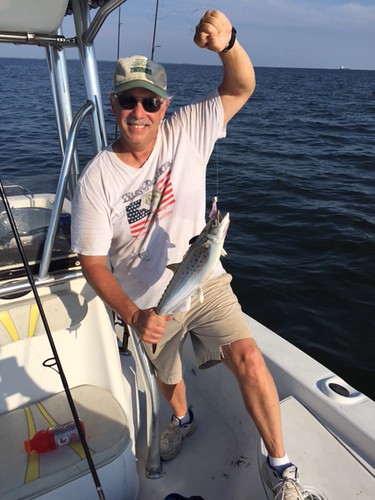
Photo courtesy David Jones
The shallow water fishery in the middle bay region for striped bass and white perch is showing some promise of improving. There has been some action on high tides at the crack of dawn and sunset. Water temperatures are still around 84° and salinities are elevated. White perch fishing has been good in deeper waters on bloodworm baits and some larger spot and croakers are also part of the mix.
The lower bay region is providing a lot of exciting fishing variety this week. A mix of Spanish mackerel, bluefish and striped bass are mixing it up with schools of bay anchovies throughout the region with some of the most consistent action occurring from the Middle Grounds to off Hooper's Island and near Cedar and Cove Points on the western side of the bay. Casting to breaking fish is always popular as is jigging with light tackle. Trolling has also been very productive with spoons behind inline weights and planers. Large red drum are in the region so it has been beneficial to have a couple of large spoons out in the spread for some exciting catch and release action. Julie Tomasik enjoyed a morning of casting topwater lures in the lower Patuxent and holds up a nice striped bass she caught.

Photo courtesy of Julie Tomasik
Bottom fishing for a mix of large spot, croaker and white perch has been very good this week. Some of the best fishing for large spot and white perch is occurring in the lower Patuxent River. The best croaker fishing is taking place at the Buoy 72 area, the Middle Grounds and Tangier Sound at dusk.
Recreational crabbing continues to be good in most areas. The tidal rivers in the upper bay can be variable at times but the Magothy and Chester have been fairly consistent. In the middle bay area the Miles and Wye seem to have come back to life and the Dorchester area has been providing excellent crabbing. The lower bay tidal rivers and creeks are some of the best places to crab in Maryland waters this week. All areas are seeing more small crabs, recent sheds and sooks are becoming more common.
At Deep Creek Lake the best fishing for a mix of largemouth and smallmouth bass continues to be early morning and late evening. Topwater lures offer some of the best fishing opportunities near grass. Fallen treetops and floating docks have been good places to target during brighter daylight with whacky rigged stick worms and soft plastics.
The upper Potomac has been flowing steady but grass has been breaking up causing fouled lines. Targeting large boulders and submerged ledges with tubes is a good tactic with light line and long casts. The smallmouth bass tend to be spooky due to clear water and summer river flows.
Largemouth bass fishing continues to be popular during the mornings and evenings along shorelines near grass, lily pads and spatterdock fields. Topwater lures such as frogs offer some of the best fun over grass. Soft plastics and spinnerbaits are effective around edges and crankbaits and grubs are effective near sunken wood. Fishing for largemouth bass in the tidal rivers has been good. The tidal Potomac River has shown extensive grass growth this year and most are targeting the grass with a variety of soft plastics. The tidal rivers and creeks of the Eastern Shore provide excellent fishing for largemouth bass and usually lots of elbow room. A falling tide is often one of the better times to fish along the outside edges of grass and spatterdock fields. At a high tide topwater lures such as frogs can provide a lot of exciting action back in shallow grass and northern snakeheads can be part of the mix. Angelina Watts holds up a northern snakehead she caught in a Dorchester County tidal creek.

Photo by Ryan Jones
The state's trout hatchery program is working hard this summer to raise the best trout possible for the much anticipated fall trout stocking that occurs in October. The fall trout stocking schedule is expected to be finalized towards the end of September and will be posted online on the trout stocking website.
The Ocean City area continues to provide plenty of summer fishing opportunities this week as the traditional tourist season begins to wind down with the upcoming Labor Day Weekend. Surf fishing for a mix of kingfish, croakers, small bluefish and flounder has been good in the morning and evening hours. At the inlet and Route 50 Bridge area bluefish continue to move through the area as well as flounder and striped bass. Near the jetties and bridge piers triggerfish, sheepshead and a few legal-sized tautog are being caught on sand fleas. There is good flounder fishing in the back bay channels with a mix of small bluefish and croakers. White Gulp baits are accounting for some of the large flounder being caught.
Outside the inlet there is some good flounder and croaker fishing on the shoal areas as well as cobia. The wreck and reef sites farther offshore are providing excellent flounder fishing with a few sea bass to round out a mix.
Out at the canyon regions; there has been very good fishing for larger yellowfin tuna, mostly by those using green stick tactics. Traditional trolling is accounting for a mix of white and blue marlin, yellowfin tuna, bigeye tuna, dolphin and wahoo. The occasional sailfish has been known to show up in a trolling spread lately also.
The Maryland Department of Natural Resources Fisheries Service has an exhibit set up in the Mosner Miller Building at the Maryland State Fair. The exhibit includes information on invasive species, surveys, DNR at work, and public fishing access. The exhibit will be running through Labor Day, September 5. Hours are 2PM-8PM on weekdays and 10AM-8PM on weekends. General state fair information is online at www.marylandstatefair.com/state-fair.
"Something within fishermen tries to make fishing into a world perfect and apart. I don't know what it is or where, because sometimes it is in my arms and sometimes in my throat and sometimes nowhere in particular except somewhere deep. Many of us would probably be better fishermen if we did not spend so much time watching and waiting for the world to be perfect." - Norman Maclean
|  Date : 8/24/2016 (1) Date : 8/24/2016 (1)
| | 8/24/2016 | All creatures big and small felt a welcomed relief Monday when temperatures and humidity dropped after a line of thunderstorms moved through the region Sunday. Water temperatures in the bay have dropped as much as 4 degrees in the past 24 hours and freshwater areas are seeing the same relief. Yesterday rivers and lakes could be seen steaming in the early morning chill. Hopefully this is the beginning of the hot and humid weather loosening its grip on the Maryland landscape.
The upper bay region is providing plenty of good fishing for striped bass from the Rock Hall area south to the Bay Bridge. There continues to be consistent chumming action at Swan Point, the channel edges at Love Point and the main channel edges outside the mouth of the Magothy River south to Sandy Point Light. There are plenty of spot to be found in the shallower waters and live lining spot has taken the forefront as the most popular and productive method to catch a nice grade of striped bass. There are bluefish in the upper bay also cutting through chum slicks and chasing schools of bait on the surface with small striped bass.
Trolling small spoons, bucktails and surge tube lures behind planers and inline weights has been a good option for those not wishing to chum or live line. The 30' channel edges are the place to be as well as near breaking fish. Umbrella rigs have also been popular items to troll.
Fishing for white perch has been good along shoreline structure in the mornings and evenings should improve with cooler water temperatures. Fishing deeper with bottom rigs baited with bloodworms over hard-bottomed shoal and reef areas in the bay and channel edges in the tidal rivers has been productive during brighter daylight hours. A simple sinker rig with two dropper flies or small jigs can also be very effective when fishing deeper waters.
The Bay Bridge piers and rock piles continue to hold striped bass that are providing good fishing for those live lining spot or jigging with bucktails. A mix of spot, croaker and white perch can be found in the shallower areas near the bridge piers.
Below the Bay Bridge boats have been anchoring up along the 30' channel edge from Dolly's Lump south to Chesapeake Beach and to a lesser extent along Brick House Bar south to Buoy 83. Just about all are live lining spot but a few are chumming with menhaden or razor clams.
Breaking fish are being encountered throughout the middle bay region this week on a regular basis. The surface action is often a mix of small striped bass, bluefish and Spanish mackerel chasing bay anchovies. Most of the striped bass are in the 14" to 16" size range but every once in a while a school of striped bass in the mid 20's will be encountered. In addition, a trick known to many is to jig underneath the surface action where larger striped may be lurking. Trolling is a good option with small spoons or surge tube lures behind planers and inline weights. It pays to place at least one large spoon out in a trolling spread for a chance at some catch and release action with the large red drum in the region.
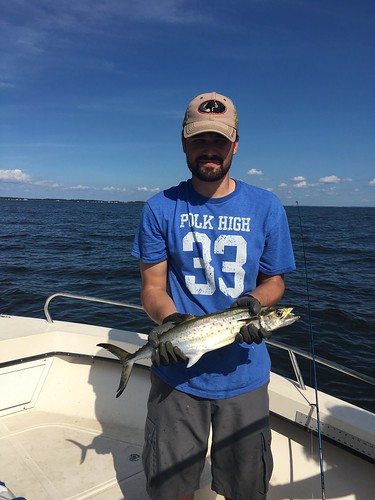
Photo courtesy of Ted Macknovitz
Bottom fishing for white perch on oyster bottom has been good in the lower sections of the tidal rivers and spot and croaker can also be part of the mix in 20' of water or more. Bloodworms are the preferred bait for white perch and spot and peeler crab will work well for croakers.
The lower bay region seems to be blanketed with bluefish from one shore to the other. There are two basic sizes; the 14" to 16" and larger ones to 28" or more. The small ones tend to be in the tidal rivers and close to shore while the larger tend to be out in the main part of the bay at areas such as the Middle Grounds. Chumming is effective and there is the possibility of drawing in a cobia also. Legal-sized striped bass have been showing up in greater numbers this week in the bay and Potomac River. Trolling has been one of the more popular ways to target a mix of bluefish, striped bass and Spanish mackerel. Small Drone and Clark spoons trolled behind planers or inline weights helps get lures down to where the fish are. Breaking fish composed of bluefish, Spanish mackerel and sub-legal striped bass are being seen throughout the region working on schools of bay anchovies and small menhaden.
Large red drum continue to be a popular attraction for anglers looking for some fun catch and release action. Trolling large spoons behind inline weights has been a good way to target them. It is not uncommon to spot disturbed water where a school of red drum are feeding and jigging with large soft plastics can be a very exciting way to tussle with one of these beasts. These two guys are certainly happy as they quickly pose with a double of red drum.
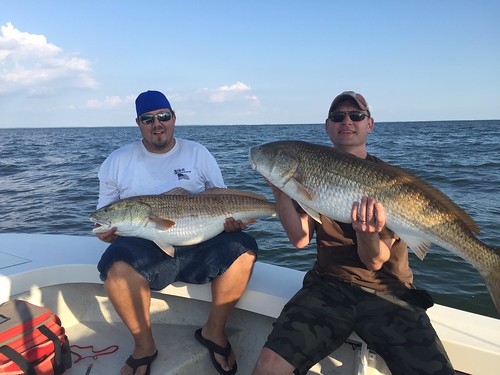
Photo courtesy of Travis Long
Bottom fishing for a mix of white perch, large spot, croaker and sea trout has been a wonderful plus for the lower bay region. Bloodworms tend to be the best bait for white perch and spot while peeler crab is the bait of choice for croaker and sea trout. The best croaker fishing continues to occur after sunset along channel edges leading to shoal areas but they can be caught deep during the day. Speckled trout are providing some exciting opportunities on the Eastern Shore marsh edges and tidal guts and creeks for those casting white Gulp Mullet baits or drifting peeler crab baits.
Recreational crabbing has been having its ups and downs depending which tidal rivers you are crabbing in. Water temperatures and oxygen levels have had a lot to do with where the best or worse crabbing can be found. Up north, the Elk River where the C&D Canal flows in has been good but some of the tidal rivers north of Baltimore have been disappointing to some. The Magothy has been good and there are good reports from the Chester River and Kent Island area. In the middle bay region the Wye and Miles Rivers have been off and the Dorchester County area has been very good and the tidal rivers on the western side of the bay have also been good. The tidal rivers in the lower bay region have been very good to excellent. Those who travel farther up the tidal rivers report a lot more smaller crabs with the larger crabs being the deeper waters in the lower sections of the tidal rivers. Doublers are a common site this time of year and sooks will become a more common item in collapsible crab traps and trotlines.
Striped Bass Water Quality Update
- Based on the latest Maryland DNR water monitoring data collected August 8-10, 2016 there are still large areas of mid-bay deep water habitat (deeper than 25 feet) with oxygen conditions unsuitable for Striped Bass.
- The Dissolved Oxygen video shows how the low oxygen areas increase over the summer months. Areas which are yellow and red have unsuitable oxygen levels for Striped Bass.

via GIPHY
- While surface water temperatures are still warm, they have cooled to the low 80's from Patapsco down to the Potomac River, providing Striped Bass with more areas within their temperature range. Real-time Chesapeake Bay surface water temperatures are available measured at NOAA's buoybay.noaa.gov website.
- Note: Data for the map is collected by both Maryland and Virginia monitoring teams and funded by both States and also EPA's Chesapeake Bay Program.
Finding Summer-time Striped Bass in Maryland's portion of the Chesapeake Bay
- Anglers may want to explore the Chesapeake Bay bridge area from Rock Hall down to the Choptank River, at depths shallower than 25 feet, including surface waters.
- The best fishing areas could be further refined by intersecting these prime areas with underwater points, drop-offs, large schools of baitfish and moving water.
- These patterns will continue until there are major changes in weather such as high sustained winds, long periods of cool weather or rain.
Our freshwater areas such as Deep Creek Lake will slowly start to see a cool down now that evenings are getting cooler. This will be a welcomed relief for fish and anglers. Water temperatures are about 79 at the moment. The best fishing continues to be early morning and late evening with recreational boat traffic being a big factor in safety and peace of mind. Largemouth and smallmouth bass are being found around deep grass with topwater lures offering some fun action. In brighter daylight, deep diving crankbaits are a good option in these same areas. Chain pickerel and northern pike may also be encountered. Thick grass, fallen treetops and floating docks will hold bass seeking shade during the day where whacky rigged tick worms can entice a strike.
Largemouth bass and most other freshwater fish are still in a summer mode of behavior and early mornings and late evenings will offer the best opportunities in the shallower areas with cover. Topwater lures are a favorite for this type of fishing.
At the Ocean City area water temperatures in the surf and inlet are about 74 this week. The best surf fishing for a mix of kingfish, croaker, small bluefish and flounder has been in the mornings and evenings. At the inlet and Route 50 Bridge area there are sheepshead and triggerfish being caught near the structure of the jetties and bridge piers on sand fleas. Striped bass and bluefish are being caught in the early mornings and evenings and a mix of flounder, croaker and small bluefish can caught during the day. In the back areas flounder are being caught in many of the channels and there is also a mix of croakers and small bluefish.
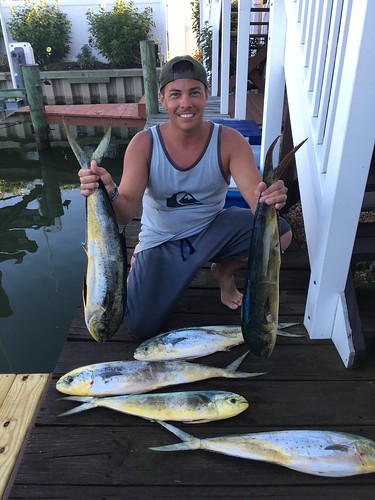
Photo courtesy of Donald Lorden
Outside the inlet there are flounder being caught on some of the shoal areas along with croakers and skates. Farther out at the wreck and reef sites flounder fishing has been very good with a few sea bass being caught. At the 30-fathom fishing areas a mix of yellowfin tuna, skipjack tuna, dolphin and wahoo are being caught. At the canyons 461 Lump and Rock Pile a mix of blue and white marlin, yellowfin tuna, dolphin, wahoo, bigeye tuna and the occasional sailfish are being caught.
"Something within fishermen tries to make fishing into a world perfect and apart. I don't know what it is or where, because sometimes it is in my arms and sometimes in my throat and sometimes nowhere in particular except somewhere deep. Many of us would probably be better fishermen if we did not spend so much time watching and waiting for the world to be perfect." - Norman Maclean
|  Date : 8/17/2016 (1) Date : 8/17/2016 (1)
| | 8/17/2016 | Water temperatures in the upper bay are in the 85 degree range this week and this can mean some tough going for the larger striped bass. Due to low oxygen levels in many of the deeper areas the fish can not go deep to find cooler water. This week in the upper bay the locations that are holding striped bass tend to be the western side of the Craighill Channel from Sandy Point Light to Baltimore Light on the 30' edge. The 30' channel edge west of the Love Point Buoy has also been a good place to find striped bass as has the Swan Point area. Chumming is still popular but live lining spot and white perch is taking the lead as a better grade of striped bass is possible with these larger baits. There are a lot of 14" to 16" striped bass in the region and they tend to be suckers for a chum slick during a good tide. Sending cut menhaden baits to the bottom and back of the slick as quickly as possible will pay dividends in larger fish. Bluefish are present in the upper bay and will be part of the chum slick mix.
Trolling can be a good alternative and working the 30' channel edges is a good place to start. Most are having good luck with umbrella rigs or small spoons pulled behind inline weights or planers to get them down to the fish. Breaking fish comprised of small striped bass and bluefish can be found now and then and jigging deep underneath can pay off with larger striped bass. Laurel Leitner is all smiles with this striped bass she caught while jigging underneath breaking fish.
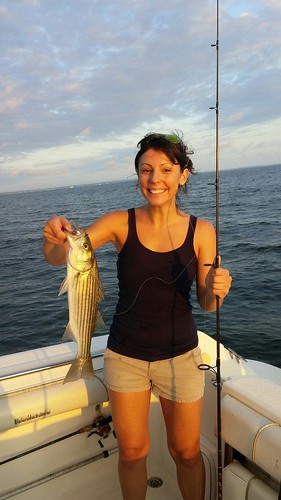
Photo by Lonnie Johnson
Spot have moved into some of the shallower shoal and reef areas in the upper bay's tidal rivers and can be caught on bloodworms. White perch are eager to take bloodworm baits over good bottom and medium-sized croakers are also part of the bottom fishing mix in the upper bay.
There is plenty of action to be found near the Bay Bridge piers and rock piles this week as a nice grade of striped bass are being found suspended near this structure. Live lining spot and white perch has been the most popular and productive method to catch striped bass. Jigging and chumming can also be effective.
There has been a lot of action below the Bay Bridge this week in the form of a mix of striped bass, bluefish and Spanish mackerel. The trio can be often found chasing bait along the eastern and western edges of the shipping channel, near the mouth of Eastern Bay, the mouth of the Choptank and Little Choptank Rivers. Most of the surface action is comprised of striped bass in the 14" to 16" size range along with 14" bluefish and speedy Spanish mackerel racing through the melee. Jigging deep underneath is a good option is larger striped bass are your goal. Karen Griswold is very happy with this nice Spanish mackerel she caught near the mouth of the Choptank River.
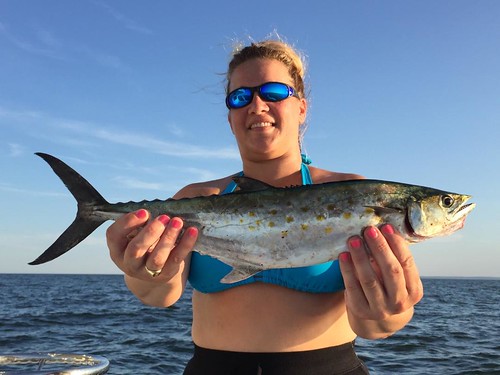
Photo courtesy of Karen Griswold
Boats have been anchoring up along the 30' channel edge from Dolly's Lump south to Chesapeake Beach on the western side of the shipping channel and south of Buoy 83 to Sharp's Island Light on the eastern side. Most are now live lining spot with good success but chumming is also popular.
Bottom fishing for a mix of spot, white perch and croaker has improved in many areas near the tidal rivers and oyster bottom. The spot and white perch can be caught during the day on bloodworms and the best croaker fishing is occurring along channel edges at sunset or later with peeler crab, shrimp or bloodworm baits.
Water temperatures in the bay are 85 degrees and even warmer in the shallower areas so the shallow water striped bass and white perch fisheries have really taken it on the chin. The best success is being reported to be in the pre-dawn hours and to a lesser extent after sunset.
The lower bay region continues to provide some exciting fishing for cobia out near the Target Ship and Mud Leads. Most are chumming and either drifting cut menhaden baits in their chum slicks or live lining spot and eels near buoys. Bluefish are being attracted to the chum slicks so live baits can really be in peril.
Breaking fish are being spotted throughout the region and usually they are a mix of bluefish and Spanish mackerel. Casting to breaking fish is always fun but trolling small spoons behind inline weights or planners is also very effective. Trolling large spoons and surge tube lures near the Middle Grounds to above the Target Ship has been providing catch and release action with large red drum and also the occasional cobia.
Bottom fishing for a mix of spot, white perch, sea trout and croaker has been very good in the lower bay region. The spot are being caught in the lower sections of the region's tidal rivers on bloodworms. The white perch can be found in 20" of water or so on oyster bottom and croaker are being caught after sunset on channel edges leading to shoal areas.
Recreational crabbing continues to be good in all regions of the bay. Salinities are up and crabs have moved farther up the tidal rivers and creeks. Crabbers do say that the largest crabs are being found in deeper water in many areas. In some areas such as the Dorchester County tidal rivers and creeks, crabs are being found in shallower waters. Cooler waters with plenty of oxygen are suspect. Razor clams continue to be the bait of choice.
Here is another map and updated results from the Maryland DNR water quality monitoring team, with new data on temperature and oxygen conditions in the Bay, and tips on locating summer striped bass.
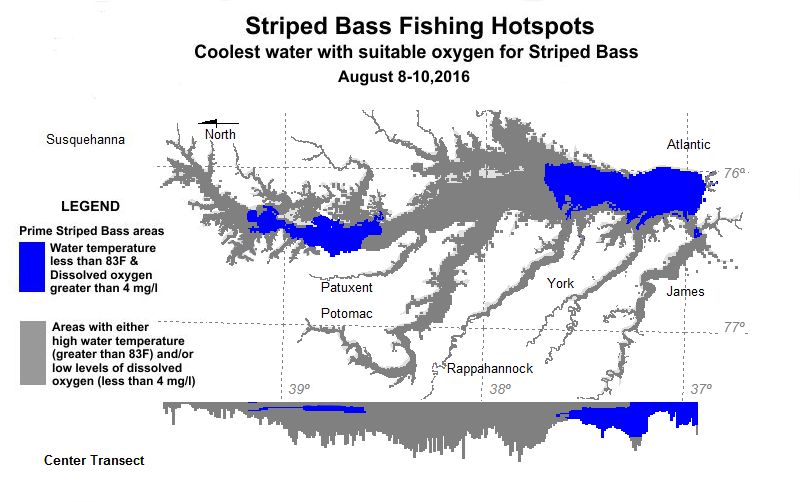
Striped Bass August 17 Hotspots Map, Courtesy of Tom Parham, DNR
- Based on the latest Maryland DNR water monitoring data collected August 8-10, 2016 there are currently limited areas with suitable temperature and oxygen conditions for Striped Bass. The Striped Bass Hotspot map above identifies areas that are both cool enough and have suitable oxygen for striped bass.
- Anglers may want to explore the Chesapeake Bay bridge area from rock Hall down to the Choptank River, at depths between 18 and 25 feet.
- The best fishing areas could be further refined by intersecting these prime areas with underwater points, drop-offs, large schools of baitfish and moving water.
- These patterns will continue until there are major changes in weather such as high sustained winds, long periods of cool weather or rain.
- Note: Data for the map is collected by both Maryland and Virginia monitoring teams and funded by both States and also EPA's Chesapeake Bay Program.
Freshwater Fishing Report
Many of Maryland's freshwater fisheries continue to deal with the oppressive heat that has a grip upon land and water. There is some relief in the western region of the state where the cold water trout rivers and streams do better due to shade and cold water influence. At Deep Creek Lake smallmouth bass are being caught in about 15' of water over rocky bottom on deep diving crankbaits during the early morning hours. Smallmouth bass can also be found near or under floating docks over deeper water; casting whacky rigged stick worms is a good tactic for these fish. Largemouth bass can be found near grass or under floating docks late; whacky rigged stick worms in the mornings are one of the better options. Gabe Kiebler holds up a nice largemouth bass he recently caught.

Photo Courtesy of Jamie Kiebler
Largemouth bass are locked into a summer mode of activity where they move into the shallower areas to feed at night. Fishing these shallow areas at the crack of dawn or late evenings with topwater lures offers a lot of exciting action. Sunken wood, over hanging brush, thick grass or old docks are good places to find largemouth bass looking for a little cool shade. Flipping whacky rigged soft plastics or stick worms to these areas is a good bet. The Bassmasters Tournament on the tidal Potomac finished up last Sunday so there should be a little more elbow room in the region.
Ocean/Coastal Bay Fishing Report
Ocean City is starting to return to the normal summer time bustle after the White Marlin Open wrapped things up last week. It is always amazing the number of high dollar boats that come into port for this event and the payout for the largest white marlin. Only a couple of white marlin made the 70 lb minimum weight at the scales and a 76.5 lb. white wound up being worth over $2.8 million.
Kingfish are being caught in the surf this week with the best fishing occurring during the morning and evening hours. Bluefish can be caught on finger mullet and some croakers and flounder are also being caught in the surf.
Surf anglers should be aware that Ocean City has just enacted a new ordinance which affects folks targeting sharks from the Town of Ocean City beaches. Chumming is off limits and transporting baits with kayaks or any other means out beyond casting distance is prohibited also. For more information on the ordinance, please contact the Town of Ocean City at 410-289-8221, or see the Town's website at: oceancitymd.gov/oc/
At the inlet and Route 50 Bridge area, bluefish continue to move in and out and are providing some fun fishing by casting a variety of lures. Striped bass are being caught in the mornings and at night. The South Jetty is the best place to fish and boats have been catching a mix of striped bass, bluefish, flounder, sheepshead and triggerfish. In the back bay areas a mix of flounder, croaker and small bluefish are being caught by bottom fishing.
Outside the inlet there is good flounder fishing on the inshore wreck and reef sites; sea bass fishing has been fair at best. Farther offshore a mix of large bluefish, false albacore, wahoo and the occasional yellowfin tuna are being found at traditional 30-fathom locations. At the offshore canyons chicken dolphin and a few gaffers are being caught with white and blue marlin, yellowfin tuna and bigeye tuna.
It is that time of the year when dead marine mammals or sea turtles carcasses may be spotted floating in the ocean. It is important to report these sightings to the proper authorities and to not intervene with what is usually a very stinky situation.
Since these animals (dead or alive) are protected under the Marine Mammal Protection Act (MMPA) and/or the Endangered Species Act (ESA) only federally permitted individuals are allowed to handle them. Citizens, watermen, charterboat captains, other state agencies, US Coast Guard, the National Oceanic and Atmospheric Administration (NOAA), Maryland Natural Resources Police, and many organizations report floating or beached carcasses via our 800-628-9944 toll-free 24/7 number. A response is then mounted and the carcass is examined. We appreciate the efforts of all who report these amazing protected species to the Maryland Department of Natural Resources Stranding Response Program.
"The secret places are the soul of fishing." - John Gierach
|  Date : 8/10/2016 (1) Date : 8/10/2016 (1)
| | 8/10/2016 | Water temperatures in the upper bay and other regions of the bay are in the mid-80's this week and even higher in some of the tidal rivers and shallower areas. These high water temperatures are having a profound effect on fishing. Striped bass are trying to hold deep along channel edges but also must balance where there is sufficient oxygen. It is August and as surface algae begin to complete their life cycle and expire, they drift down into the depths of the bay and remove oxygen in the process of decomposition. This is a stressful time for fish and shellfish in the Chesapeake Bay.
Before we get into the statewide fishing reports, here are some more tips from the Maryland Department of Natural Resources water quality monitoring team which could help you locate more striped bass in the Chesapeake Bay during the hot summer months.
Finding Summertime Striped Bass in Maryland's portion of the Chesapeake Bay
- In late summer, high surface water temperatures coupled with the majority of deeper water experiencing low dissolved oxygen conditions force Striped Bass into a very narrow band of water. This is known as the "Striped Bass Squeeze." Striped Bass can tolerate water temperatures up to about 86F and oxygen levels down to about 3mg/l. However, these conditions are far from optimal.
- Through Maryland DNR's extensive water monitoring efforts, we can identify areas best suited for Striped Bass. This monitoring also helps us understand current water quality conditions as well as track Maryland's progress towards restoring the Chesapeake Bay. DNR monitors Chesapeake Bay and its tidal and non-tidal rivers at 130 locations Statewide.
- Data for the map is collected by both Maryland and Virginia monitoring teams and funded by both States and also EPA's Chesapeake Bay Program.
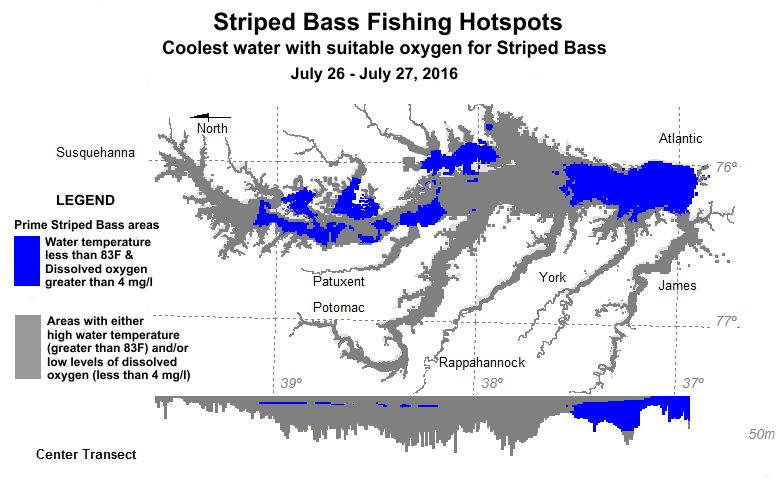
Striped Bass Fishing July Hotspots Map, Courtesy of Tom Parham, DNR
Results
- Based on the latest Maryland DNR water monitoring data collected July 25-27, there are currently limited areas with suitable temperature and oxygen conditions for Striped Bass. The Striped Bass Fishing Hotspot map above identifies areas that are both cool enough and have suitable oxygen for striped bass.
- Anglers may want to explore the Chesapeake Bay bridge area down to below Eastern Bay, Choptank River, areas above and below the mouth of the Patuxent River at depths between 22 and 28 feet. Tangier Sound also has large areas of cool, well oxygenated water suitable for Striped Bass.
- The best fishing areas could be further refined by intersecting these prime areas with underwater points, drop-offs, large schools of baitfish and moving water.
- These patterns will continue until there are major changes in weather such as high sustained winds, long periods of cool weather or rain.
Next update
- The next Striped Bass Fishing Hotspot map update will be on August 15th and will be based on monitoring results from August 8-10, 2016
Catch and Release
- Catching striped bass in the summer is very stressful to the fish. If you are practicing catch and release, please be prepared to get your fish back in the water ASAP. For more catch and release tips please visit dnr.maryland.gov/fisheries/pages/catch-and-release.aspx
Statewide Fishing Reports
The Conowingo Dam has been releasing water in the afternoons for power generation which helps cool down water in the dam pool and the river immediately below the dam. There is some striped bass fishing success in the tidal rivers near channel edges but most of the action is being found in the bay near some of the shoal areas and main channel edges. The Belvidere Shoals, Swan Point and Snake Reef are worth looking over and the Love Point channel edges continue to be a focal point for chumming. Dennis Cain was chumming near Love Point Buoy recently and sent in this picture of a nice striped bass he caught that was a bit tricky in being able to steal menhaden chunks from other fishermen before he met up with Dennis.

Photo by Pat McLinney
White perch are also feeling the effect of warm water temperatures and many of the larger perch have retreated to deeper waters searching for cooler water. There are still perch along shoreline structure in shallower waters but most are of smaller size. Bottom fishing on hard bottom shoals in the bay is accounting for the best grade of white perch with some medium size croakers with a few spot mixed in. Bloodworms are the preferred bait.
The Bay Bridge is a very good place to find striped bass this week; there tends to be plenty of them holding near the bridge piers, rock piles and to a lesser extent along the sewer pipe on the northeast side of the bridge. Chumming, chunking and live lining spot or white perch have been the most effective tactics. Trolling above the Bay Bridge near the Mud Flats and north to the Love Point area has been effective.
In the middle bay region some of the best striped bass action is occurring along the western side of the bay from Dolly's Lump south along the shipping channel edge to off of Chesapeake Beach. Chumming has been the most popular way to fish and boats can be seen anchored along the channel edge. There are also some chumming opportunities on the eastern side of the shipping channel from Buoy 83 south to Sharps Island Light. Bluefish are a big part of the mix and will be found in chum slicks or chasing bait. Trolling has been a good way to fish for a mix of striped bass and bluefish; spoons and surge tube lures (hoses) behind inline weights have been popular.
Breaking fish are becoming a common sight in the middle bay region and they tend to be made up of a mix of bluefish, striped bass and Spanish mackerel. There has been a lot of fine action around the mouth of Eastern Bay, the mouth of the Choptank, off Taylors Island and the western edge of the shipping channel. Casting to the surface action is always fun and jigging deep underneath is a good way to target the larger striped bass.
White perch fishing has been the best on live oyster bottom in about 20' of water this week with bottom rigs baited with bloodworms and peeler crab being the best choice. There are plenty of medium-sized croakers in the mix and also spot. In the early morning and late evening hours there is some ultra-light fishing action for white perch in the shallower areas along shoreline structure areas. The shallow water striped bass fishery is very limited this week due to water temperatures in the high 80's in the shallows. Most of the striped bass being caught are sub-legal. When bottom fishing there can be surprise catches such as a large black drum or a big channel catfish but in this case this big flounder is a real eye opener. Ryan Jones was bottom fishing near the mouth of the Little Choptank and reported that he and his girlfriend Angelina Watts caught several undersized flounder and then this one hit. This is an impressive flounder no matter where you're fishing but a special trophy for the middle bay region.
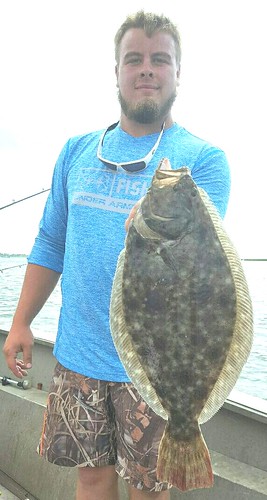
Photo by Angelina Watts
The lower bay region is blanketed with bluefish from little squirts of 14" up to 4 lb bruisers. They are providing plenty of action for those chumming or trolling in the region. Cobia fishing continues to be a big draw at the Target Ship and Middle Grounds areas. Chumming has been the most popular method to fish for the cobia. Trolling has been a good way to catch bluefish and Spanish mackerel this week; most are trolling a mix of small spoons and surge tube lures behind inline weights. Trolling large Drone spoons over by the Target Ship area and Mud Leads can get one in on some exciting catch and release action with large red drum. Adding large surge tube lures can also add the chance of enticing a cobia to strike.
Bottom fishing for a mix of croaker, spot, white perch with some bluefish and sea trout tossed in has been a real highlight in the lower bay region lately. Traditional locations in the lower Patuxent River, the Point Lookout area and Tangier Sound have been producing a very nice mix of fish. In the lower Potomac River from the mouth of the Wicomico River up past the 301 Bridge medium- sized blue catfish are extremely abundant. On the eastern side of the bay along marsh edges and creek mouths speckled trout are providing some exciting fishing.
Recreational crabbing in the tidal rivers continues to be good to excellent this week. The best catches are occurring in deep water in the lower sections of the tidal rivers on razor clams in the middle and lower bay regions. Smaller crabs and recently shed crabs are being reported farther up the creeks and rivers.
At Deep Creek Lake water levels are reported to be down and shallow grass is matting up. Largemouth bass are being found under this grass or under shallow water floating docks. Whacky-rigged stick worms have been one of the more productive ways to entice them to strike. Frogs have been a good choice over grass in the cove areas. Smallmouth bass are being found in 12' of water and small deep-diving crankbaits are a good choice to get down to them. The early morning hours tend to provide the best fishing opportunities.
The upper Potomac River received a bump in water levels last week and water temperatures dropped some making for better fishing opportunities for smallmouth bass. Loose grass has been an added problem and some of the best action has been occurring with topwater lures and whacky-rigged stick worms in the early morning hours.
Fishing for largemouth bass is typical for this time of the year; early morning or late evenings are the best time to be on the water. The largemouth bass are seeking cool shade during the day and only move into the shallows at night to feed. Whacky-rigged stick worms dropped through thick grass or to deeper structure is a good tactic. Flipping them under docks or overhanging brush is also a good way to reach a loafing bass. In tidal areas a low ebb tide is a good time to target the outside edge of spatterdock fields with spinnerbaits and shallow crankbaits.
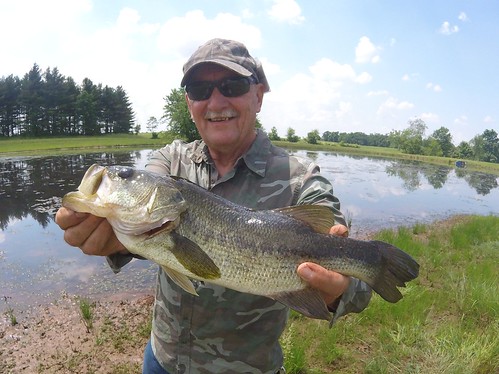
Photo courtesy of Jim Gronaw
Last month the Fisheries Service Hatchery Program stocked 8,000 tiger musky fingerlings into Triadelphia and Rocky Gorge combined, which should provide some exciting fishing opportunities in the coming years. Also 11,500 fingerling striped bass were stocked into Liberty Reservoir.
The big event this week in Ocean City is of course the White Marlin Open and with 329 boats entered and arriving from far away ports it will be a busy week around the docks. So far there is plenty of room for change on the leader board and several days left to fish.
For those seeking a little more subdued fishing experience there is good surf fishing for kingfish in the early morning and evening hours. Bluefish can be caught in the surf on finger mullet and a mix of inshore sharks can provide some fun catch and release action on large baits and heavy tackle in the evening hours.
At the inlet bluefish continue to move in and out with the tides when boat traffic shuts down. A few striped bass are being caught also in the evenings. During the day there are flounder in the inlet and Route 50 Bridge area as well as sheepshead and gray triggerfish near the South Jetty.
In the back bay areas flounder are the prime target and the flounder are spread out over a wide area. White Gulp baits have been accounting for some of the larger flounder being caught in the channels. Small bluefish and sea bass along with sea robins will keep those fishing with squid and minnows alert.
Out at the wreck and reef sites sea bass are being caught but the excellent flounder fishing has been taking center stage lately. Farther offshore at the canyons and beyond; the boats fishing the White Marlin Open are bring in a mix of white and blue marlin, bigeye and yellowfin tuna as well as dolphin.
"When I go fishing, I want to get away from it all, for it is silence and solitude even more than it is fish that I am seeking…As for big fish, all is relative. Not every tuna is a trophy." - William Humphrey
|  Date : 8/3/2016 (1) Date : 8/3/2016 (1)
| | 8/3/2016 | You may have noticed in the past couple of weeks that the fishing report is becoming shorter and more concise. The Fisheries Service is attempting to make the fishing report more user friendly for mobile phones and easier to get vital fishing information quickly. In the end, we service our readers so let us know what you think about the new format.
Before we get into the fishing reports from around the Bay, here are some thoughts and tips on this summer’s striped bass patterns and water quality in the Bay from Tom Parham, Maryland Department of Natural Resources, Tidal Water Quality Monitoring group.
Where did the Striped Bass go this summer?
- In late summer high surface water temperatures combined with the majority of deeper cooler water experiencing low dissolved oxygen conditions force Striped Bass into a very narrow band of water. This is known as the “Striped Bass Squeeze.” (For example, during June and July, a concentration of striped bass was found in a relatively small area between Sandy Point and Podickory Point at the mouth of the Magothy River).
- Striped Bass can tolerate water temperatures up to about 86F and oxygen levels down to about 3mg/l. However, these conditions are far from optimal.
- Based on the latest Maryland DNR water monitoring data collected July 25-27, there are currently limited areas with suitable temperature and oxygen conditions for Striped Bass.
- Anglers may want to explore the Chesapeake Bay bridge area down to below Eastern Bay at depths between 22 and 28 feet. In addition, consider the mouth of the Choptank River and Tangier Sound in depths down to about 20 feet.
- Note: A restored Chesapeake Bay will provide more areas with suitable dissolved oxygen for fish, crabs and oysters. While Maryland is on track to restore the Bay and we are seeing improvements in our waters in some rivers and streams, we still have more work to do. Please do your part to reduce nutrient pollution to the Bay by keeping your car and boat tuned up and making sure you pump, not dump your boat waste.
- For more information on Chesapeake Bay dissolved oxygen conditions visit dnr.maryland.gov/waters/bay/Pages/Hypoxia-Reports.aspx, and see the following map.
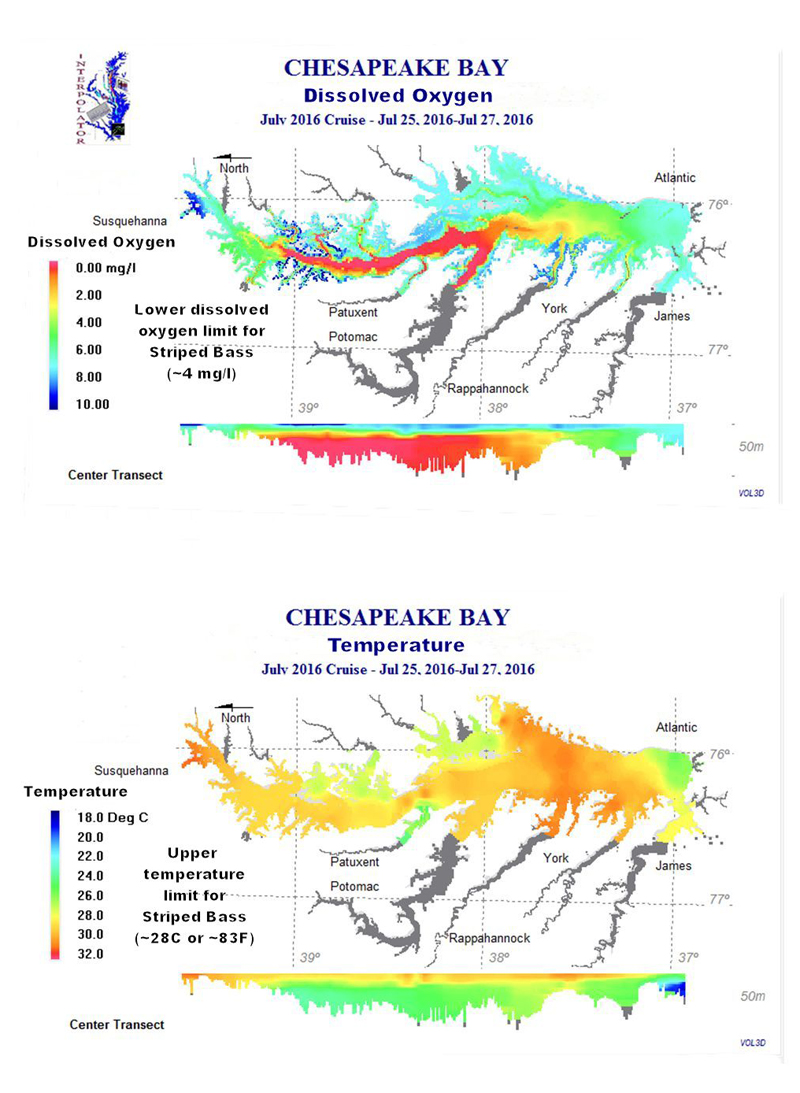
Bay Temperature and Dissolved Oxygen Map, Courtesy of Tom Parham, DNR
At the very top of the bay most fishing has been focused on a mix of white and yellow perch along with channel catfish. The water flows at the Conowingo Dam have been relatively low with only a few afternoon water releases in the past week. The striped bass action really kicks into gear when you get down to the Rock Hall area where Swan Point, the Triple Buoys, Love Point have been a popular places to chum for striped bass. On the western side of the Bay the inside edge of the Craighill Channel from Sandy Point Light to Gibson Island has also been a popular place to anchor up and chum but catches have been falling off as fish look for cooler water more to their liking. Bay water temperatures are now in the high 80s, and mornings coupled with a falling tide usually offer the best action. Pat McLihnney holds up a nice pair of striped bass he caught recently while chumming at the Love Point area.
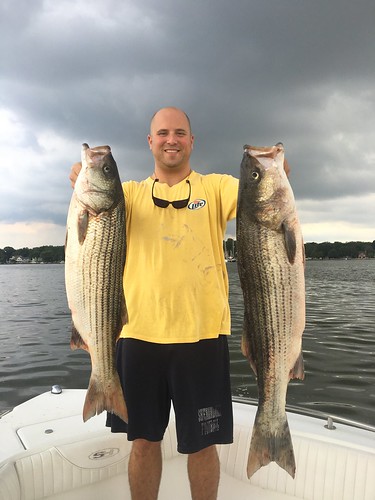
Photo by Dennis Cain
At the Bay Bridge Piers there are striped bass to be found suspended near the piers and rock piles. Chumming, chunking, live lining white perch or jigging are all effective ways to catch striped bass. The sewer pipe on the northeast side of the bridge has also been getting the attention of boats anchoring up current and chumming or trolling.
Below the Bay Bridge, the 35’ outside edge of Dolly’s Lump and Hacketts Bar have proven to be good places to chum for striped bass and bluefish lately as has over by the Hill off Poplar Island. Live lining white perch and precious spot have also been a great tactic. Breaking fish are becoming a more common site in the middle bay region as a mix of bluefish and striped bass make life tough for bay anchovies and small menhaden. As the month progresses Spanish mackerel will be a more common addition to the melee.
The Tilghman Island Artificial Reef, which is 1.5 miles west of Paw Paw Cove, Tilghman, was recently enhanced with 72 reef balls through a cooperative project between Department of Natural Resources (DNR)/Maryland Artificial Reef Initiative (MARI), Coastal Conservation Association (CCA), Chesapeake Bay Foundation (CBF) and students and teachers from the Science, Technology, Engineering, and Mathematics (STEM) program at Carroll County schools. The DNR/MARI program provided the permits and oversight.
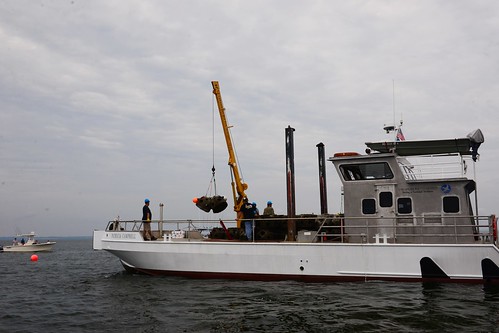
Photo by Joe Evans
Croaker fishing has steadily improved in the middle bay region with the best catches occurring after sunset as the croaker move out of the deep channels to forage on adjacent shoal areas. White perch fishing has been good with the largest perch being caught on bait in some of the deeper waters over good oyster bottom. Smaller white perch are being caught in the shallower areas of the region’s tidal rivers and creeks.
Water temperatures in the middle and lower bay are in the upper 80s now and the shallower water fishery for striped bass is being limited by those high water temperatures. There is an early morning bite before sun rise and one in the late evening but catches of legal-sized fish have been only fair. Bluefish are spread throughout the middle and lower bay regions and range in size from up to 4 lbs or better.
The lower Bay region continues to offer some exciting fishing for cobia this week in the area just below the Target Ship. Chumming has been one of the more popular methods to catch them but they are also being caught by trolling. A variety of surge tube lures (hoses), large spoons and bucktails dressed with sassy shads have been catching cobia and also large red drum. Megan Crabtree gets help from Captain Mike Willey for a quick picture before releasing this beautiful red drum caught while trolling a large Drone spoon.
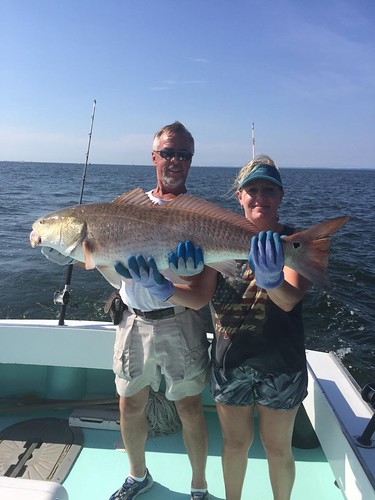
Photo courtesy of Megan Crabtree
Croaker fishing remains good this week in the lower bay region with the best catches occurring after sunset on 15’ to 20’ shoal areas adjacent to deep channels. Sea trout, speckled trout, small bluefish and white perch help round out the bottom fishing mix. The largest white perch are being caught in 20’ or more of water over live oyster bottom on bloodworms and peeler crab baits.
Recreational crabbing continues to be good in all regions of the bay with the best catches of large crabs coming from deeper waters in the lower regions of the tidal rivers. There is a big shed going on so crabbers will see a lot of light crabs. The crabs tend to be smaller the farther up the tidal rivers one crabs and some of the best crabbing in Maryland waters is occurring in northern Dorchester County. Recreational crabbing in the Wye and Miles Rivers has been reported to be rather lack luster this week.
Despite what seems like Kamikaze boating traffic on Deep Creek Lake there is good fishing to be found in the early morning hours on the lake. The best smallmouth bass fishing is occurring in about 10’ to 15’ depths on deep diving crankbaits. There is also a mix of large yellow perch, chain pickerel and the occasional northern pike being caught at these depths over rocky bottom and grass. The best largemouth bass fishing has been under the floating docks around the lake by flipping soft plastics under the docks.
The upper Potomac River received some much needed influx of runoff to raise the water levels and lower water temperatures a bit and creating better fishing for smallmouth bass. Most of the bass being caught are in the 14” size range but offer a lot of fun fishing. Tubes, soft jerkbaits and small crankbaits are good choices for baits this week.
The cool runoff from recent rain storms has cooled water temperatures a bit and although some areas are stained, largemouth bass fishing took an upswing this week. It is still an early morning and late evening fishing situation when the bass are more active. Targeting grass, sunken wood and creek mouths are a good tactic with soft plastics and topwater lures and small crankbaits. Russ Anderson is certainly happy with this largemouth bass.
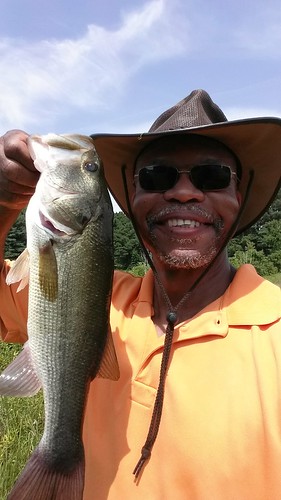
Photo courtesy of Russell Anderson
In the back bay areas of Ocean City and Assateague, flounder fishing has been good in the channel areas. Many of the largest flounder are being caught on Gulp Mullet baits but a good share of the flounder are also being caught on minnows and squid. At the inlet and Route 50 Bridge area flounder are being caught but the most exciting news is the bluefish that tend to swarm through the inlet at times. Casting Got-Cha plugs, spoons and jigs has been the favored tactic to catch a mess of bluefish and the occasional striped bass over 28”. Sheepshead are becoming more common at the South Jetty and even a few gray trigger fish have been caught by those using sand fleas for bait. In the surf kingfish are the big attraction for those using bloodworms or squid and bluefish are being caught on finger mullet. Inshore sharks are being caught and released on menhaden cut baits and stout tackle.
Offshore, the tuna chunk bite at Massey’s Canyon has dropped off and very few yellowfin tuna are being caught; water temperatures there have risen to 81° in the area. Sites along the 30 fathom line such as the Hot Dog, Jackspot or the Sausages are worth checking. Boats have been experiencing good sea bass fishing at the wreck and reef sites with a healthy addition of flounder. Farther offshore boats and crews are trolling the canyons and catching a mix of white and blue marlin, bigeye tuna, yellowfin tuna and dolphin.
The world is wide and there must be innumerable wild beautiful places yet unexplored that await the hunter and fisherman. Of these I am always dreaming and creating mental pictures. Yet the waters a fisherman learns to love always call him back. - Zane Grey |  Date : 7/27/2016 (1) Date : 7/27/2016 (1)
| | 7/27/2016 | Hot weather has descended upon Maryland and while some of our fisheries are slowing down to warmer water temperatures, others such as marine are creating new opportunities as summer migrant fish move into our waters.
At the top of the bay the Conowingo Dam has been flat lined for over 8 days with hardly any water releases. Higher water temperatures have many fish hunkered down waiting for an influx of cooler water that occurs with power generation water releases. Channel catfish and white perch are providing most of the action in the lower Susquehanna and the tidal rivers to the south. There continues to be some early morning striped bass and white perch action in the tidal rivers near Rock Hall and the Baltimore Harbor area for those casting near shoreline structure or jigging along channel edges. White perch can also be caught during the day on bait in deeper water waters.
Chumming for striped bass in the upper bay continues to be a big draw for boats from ports as far south as the lower bay this week. Swan Point, Love Point and the western side of the shipping channel from above the mouth of the Magothy River to Sandy Point Light have been getting the most attention. The 30' to 35' edge tends to be the sweet spot and it is hard to beat a falling tide for the best action. Water temperatures are about 85° and warm water stress and deep hooking of released fish is taking its toll so anglers are urged to exercise caution to protect the future of the striped bass fishery in Maryland.
Trolling deep with umbrella rigs and single lures has been an effective alternative to chumming lately as has jigging when fish can be found suspended along channel edges or near structure. Live lining white perch is also a very effective tactic where fish can be spotted suspended near channel edges. The Bay Bridge piers and rock piles are holding striped bass and jigging or live lining white perch there can really pay off. Dee Kolobow holds up a nice 33" striped bass she caught near the bridge piers on a live white perch.
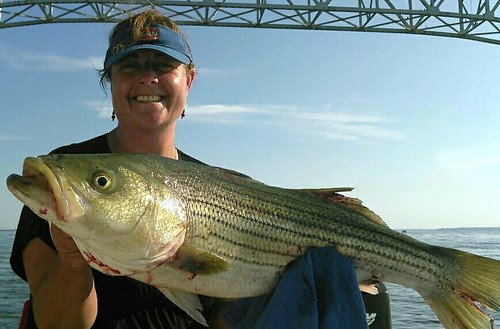
Photo courtesy of Dee Kolobow
In the middle bay region striped bass are being found along channel edges in about 35' of water on the outside edge of Hacketts and outside Poplar Island to Buoy 83. There is a little chumming going on but most are spotting suspended fish and either jigging or trolling for their striped bass and bluefish. Breaking fish are becoming a more common sight as bluefish join up with striped bass to harass schools of menhaden and bay anchovies along channel edges. Casting into the breaking fish or jigging underneath has been providing some fun action.
The shallow water striped bass fishery is slowing down as water temperatures in the shallower areas climb into the upper 80s which is a bit toasty for striped bass over 20 inches long. There is some action before the sun comes up and just before sunset on the higher tides. The warm water temperatures are having an effect on the shallow water white perch fishery as well and the action can be spotty at times. Fishing deeper water with bait or jigs around structure such as piers or oyster beds tends to be the best option.
In the lower bay, fishing for cobia is still holding center stage as the most exciting fishery. The prize is great and it has been a very long time since Maryland fishermen have had such an opportunity to catch a cobia. Most are chumming near the Target Ship, the Mud Leads or the Middle Grounds and catching a mix of bluefish, a striped bass now and then and hopefully a cobia. The cobia fishery currently remains open in Maryland state waters in the Bay, and state waters in the ocean, within 3 miles of the coast. The Maryland Department of Natural Resources Fisheries Service cannot implement regulations for cobia in Maryland waters unless the species is added to the "in need of conservation" list in the Code of Maryland Regulations (COMAR). The Department does not plan to try listing cobia as in need of conservation this summer but may consider it sometime in the future. The cobia fishery was discussed at the last Sportfish Advisory Commission (SFAC) meeting, and there may be some future discussion with the Atlantic States Marine Fisheries Commission (ASMFC).
There has been a rarely seen visitor to the Maryland portion of the bay in the past week and that is the greater amberjack. Juvenile amberjack in the 26" to 30" size range have been caught as far north as the mouth of the Choptank by chumming, trolling and casting to breaking fish. Travis Long sent us a picture of what one looks like.
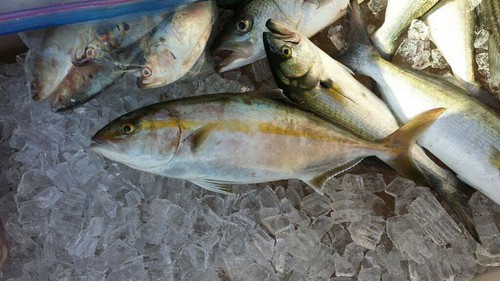
Photo courtesy of Travis Long
Bluefish are spread throughout the lower bay region and the first Spanish mackerel were seen last weekend by those casting into breaking fish or trolling small Drone and Clark spoons behind planers or inline weights. Surge tube lures (hoses) have also been a good trolling option for bluefish and the occasional striped bass.
The oppressive heat has driven water temperatures up and has slowed down the shallow water striped bass fishery and limited it to a short period before sunrise and after sunset. Speckled trout have been a welcomed addition to fishing along the bay's marshes and creeks this week. The eastern side of the bay holds the best opportunities but they can be part of the mix while bottom fishing anywhere in the lower bay. Croaker fishing remains an evening proposition due to warm water temperatures along channel edges. At times a few croaker can be coaxed to bite during the day in deep water but the action tends to be sparse. White perch are holding in deeper waters over oyster bottom and are active. Small red drum in the 12" size range are also part of the bottom fishing mix along with a few sea trout.
Recreational crabbing continues to be good in all three regions of the bay with the best crabbing occurring in the middle and lower bay regions. The larger crabs tend to be deep, often in 10' of water or more. Recently molted crabs and small crabs tend to be more of problem and razor clams continue to be the bait of choice. The hot and humid weather we are experiencing is really rough on holding crabs in a basket onboard and picking out dead crabs while loading up the steamer pot can be a big disappointment. Keeping a wet piece of burlap over the basket and out of the sun between runs can help.
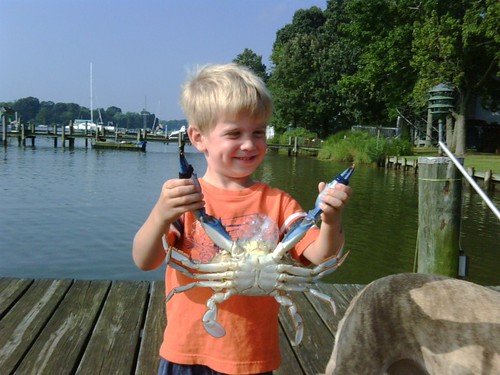
Photo courtesy of Jim Livingston
There is no getting around the fact that the hot weather we are experiencing is having a profound effect on freshwater fishing. Water temperatures are up and making it difficult for the fish and those who pursue them. The early morning hours before sunrise tend to hold the best opportunities for fishing places like Deep Creek Lake or the upper Potomac River for smallmouth bass and other cold water fish. Boat traffic on Deep Creek Lake is of course a limiting factor and low, warm and clear water on the upper Potomac is an issue to deal with.
Largemouth bass are moving up into the shallower areas during the night to feed and hunkering down early in the morning to a cool shady spot to wait out the day. Targeting shallow grass early in the morning or late evenings with topwater lures such as poppers and frogs is a good tactic and dropping plastic worms through heavy grass or under docks and brush during the day can offer good action. When fishing tidal waters for largemouth bass a low tide is best when working the outside edges of grass beds or spatterdock fields and creek mouths are also a good spot to target.
Water temperatures in the Ocean City area are holding about 70° this week close to shore. Surf casters are catching a mix of kingfish, small bluefish and flounder in the surf. The best action tends to be early in the morning and late evening. At the inlet bluefish are offering good fishing action in the early morning and late evening hours along with striped bass. Casting Got-Cha lures, bucktails, swim shads and drifting cut bait or live eels has been popular. Flounder are being caught at the inlet and Route 50 Bridge area. Flounder fishing has been very good in the channels leading to the inlet and also farther back in the bays.
Outside the inlet bluefish and Spanish mackerel are being caught by trolling spoons near some of the inshore shoal areas like the Bass Grounds and Little Gull Shoals. Flounder are also present in these areas as well as the wreck and reef sites where they help add to the mix for those fishing for sea bass.
Chunking for yellowfin tuna has become very popular recently and on the weekends a huge fleet can be seen for miles anchored up at Massey's Canyon. It is not a bad run from Ocean City Inlet and inviting for those hesitant to run out to the farther offshore canyons. Darren Rickwood holds up a fine example of the yellowfin tuna that are being caught while chunking.

Photo courtesy of Darren Rickwood
There has also been some action at other spots such as the nearby Chicken Bone and farther south at the Lumpy Bottom. At the Washington, Poorman's and Baltimore Canyons there is a mix of dolphin, yellowfin tuna, bluefin tuna, wahoo and white and blue marlin being caught, mostly by trolling.
"Most of the world is covered by water. A fisherman's job is simple; pick out the best parts." - Charles Waterman
|  Date : 7/20/2016 (1) Date : 7/20/2016 (1)
| | 7/20/2016 | Here is an overview of fishing around the state as we get into late July, starting with Conowingo Dam and ending up at Ocean City.
Water releases at the Conowingo Dam have been sporadic with several days passing before an afternoon water release. There continues to be a limited early morning striped bass bite in the dam pool for those casting swim shads and topwater lures.
White perch fishing continues to be good in most of the upper bay's tidal rivers and creeks this week. The early mornings and evenings have been offering good white perch fishing for those casting beetle-spins, spinners and small jigs along shoreline structure. White perch can be found deeper during daytime bright sun and heat. Rigs with dropper flies or bait will get the job done in the deeper waters. Striped bass can also be found in some of the major tidal rivers such as the lower Patapsco outside of Baltimore Harbor in much of the same way. They can be found early and late in the day close to shallower structure and deep at other times.
The chumming fleets continue to anchor along the channel edges from Sandy Point to above Baltimore Light as well as the Love Point and Swan Point areas. Most boats are chumming and drifting cut baits back into the chum slicks but chunking can also be a good option as well as live lining small white perch; an ebbing tide tends to offer the best action. Striped bass can be found in many other locations along 30' or better channel edges in the upper bay for those seeking a little elbow room. When fish are spotted on a depth finder, jigging can be a satisfying way to catch one's fish. Some enjoy the trolling option and pulling umbrella rigs behind inline weights or small spoons behind planers can be a good way to catch a nice grade of striped bass with a few bluefish thrown in for good measure.
The Bay Bridge piers continue to live up to their reputation of holding striped bass and as long as a good tide is running a variety of fishing methods will work. Casting bucktails and soft plastic jigs at the pier bases to suspended fish, chunking or drifting small live white perch are all good tactics. Alex Cain holds up a nice striped bass caught while jigging near the Bay Bridge rock piles.
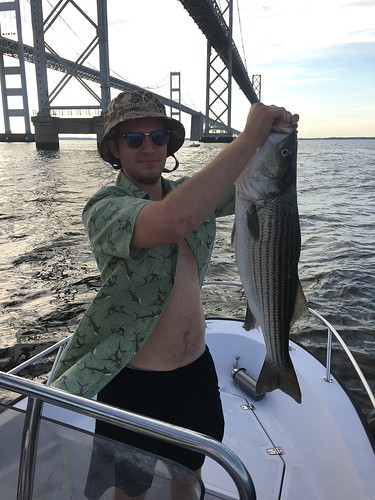
Photo courtesy of Alex Cain
In the middle bay region the western edges of the shipping channel from Hacketts south to Thomas Point have been good places to look for striped bass suspended along the 30' to 35' edges. Boats have been anchoring up from Hacketts to Thomas Point and chumming or live lining white perch for striped bass. Bluefish are attracted by the chum slicks and have been nipping off fluorocarbon and mono leaders. Light tackle jigging offers opportunities as does trolling or anchoring up and chumming. Bluefish are in the region and the classic scene of breaking fish and diving sea gulls is becoming a more common sight. Experience tells us that bluefish and smaller striped bass will usually be involved in the surface melee and large striped bass often lurk below so jigging is an effective strategy to catch larger striped bass. Aaron Hoxworth is all smiles with this 21" bluefish he caught off Chesapeake Beach recently.

Photo by Lonnie Johnson
The shallow water fishery for striped bass continues to be good this week with a few adjustments as water temperatures climb into the mid-80's. The early morning bite tends to be over as soon as the sun breaks the horizon and the evening bite starts a little later than it did a month ago. Topwater poppers tend to be the most popular way to fish near shoreline structure but swim shads work well when the water is a little deeper. Eastern Bay, Kent Narrows, Poplar Island and most of the larger tidal rivers and creeks all offer fishing opportunities. White perch can be found in many of the same areas and beetle-spins, small jigs and spinners can be a lot of fun with ultra-light tackle. Bottom fishing for white perch has been taking up much of the slack in the bottom fishing scene so far this summer. Croakers are hard to come by in the middle bay region but some are being caught out in the bay and in the major tidal rivers and a few sea trout of both species have been showing up here and there and even a few small spot have been reported.
All kinds of exciting fishing options are open in the lower bay region this week. The cobia fishery continues to come on strong and offers cobia fishing opportunities that has not been seen for a long time. Most are being caught by chumming and chunking at the area around the Target Ship, the Mud Leads, the Middle Grounds and south near Smith Point and the Cut Channels. A few have been caught while trolling and cobia are always a sucker for live eels cast near buoys or if cobia can be spotted on the surface.
Bluefish in the ¾ lb to 2 lb size range can be found throughout the lower bay region. They are being caught by chumming, trolling or casting to breaking fish. Striped bass fishing tends to be an early morning and late evening shallow water event near likely structure. Casting topwater lures and swim shads has been the most popular tactic. There is very little striped bass success occurring in regard to trolling or jigging.
The croaker fishing has now become almost exclusively an evening/night fishery. Water temperatures are in the 80's and the fish are holding deep during the day and are not interested in feeding. Daytime bottom fishing tends to center around white perch; they are ready and willing near the deeper oyster reefs. Some of the better evening croaker spots are the lower Potomac and Patuxent Rivers and the Wilson Reef. The croakers are being caught on peeler crab, shrimp, squid and bloodworms; most are in the 9" to 11" size range. The croaker fishing in Tangier and Pocomoke Sounds has been poor. A few sea trout and small spot are also being caught.
Recreational crabbing continues to be good this week as warm waters cause shedding and more legal size crabs entering the fishery. Recreational crabbers have been relying on razor clams for the best catches in the lower and middle bay regions and finding the best crabs in deeper waters. One note that a commercial crabber reported to me recently was that he noticed that the brightly colored mesh bags caught more crabs than black ones. Commercial crab potters all know that clean and bright pots catch more crabs than dull or fouled ones. Another interesting note I learned from another commercial trot liner was the fact that due to clear water he could notice crabs dropping off early in the process of the trotline being lifted. Recreational crabbers in the upper bay's tidal rivers are seeing opportunities improving and tend to be doing fine with chicken necks or even better yet with fresh cut menhaden or white perch in collapsible traps. Lucas Livingston got to go crabbing with his granddad and shows off one of the nice crabs they caught together.
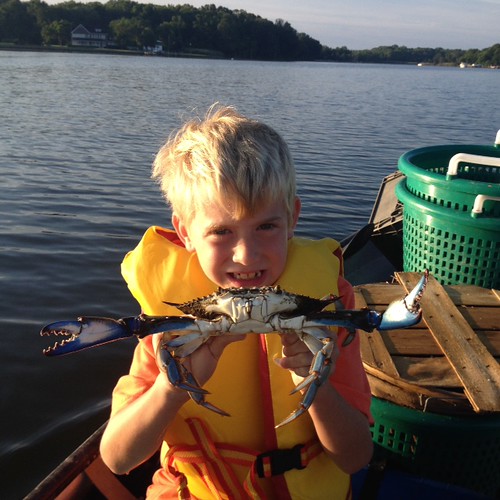
Photo by Jim Livingston
The freshwater fisheries in Maryland have slipped into a summer mode of fish behavior which corresponds with the heat of the day and the effects of a bright sun overhead. Just about all species of fish from coldwater species such as trout and smallmouth bass to warm water loving fish like largemouth bass tend to sit the day out in the best cool and shaded spot they can find.
The best fishing at Deep Creek Lake is during the early morning hours when smallmouth bass can be caught in about 10' of water near rocky bottom. Largemouth bass are near heavy grass and under floating docks. Walleye and trout are deep near the dam face and steep edges. On the upper Potomac River the water levels are low, clear and warm. The best smallmouth bass fishing is early and late in the day in the deeper current areas.
Largemouth bass fishing is also an early morning and late evening show with topwater lures and whacky rigged soft plastics being the ticket to the shallow water show. Grass is the major target to fish as is sunken wood or similar structure. In tidal areas a high flood tide will find largemouth bass in the shallow grass and just outside it as the tide ebbs to low or creek mouths; once again though this is an early morning and late evening bite. Megan Goodrich has plenty to smile about as she shows off a beautiful Broadford Lake largemouth bass before releasing it.
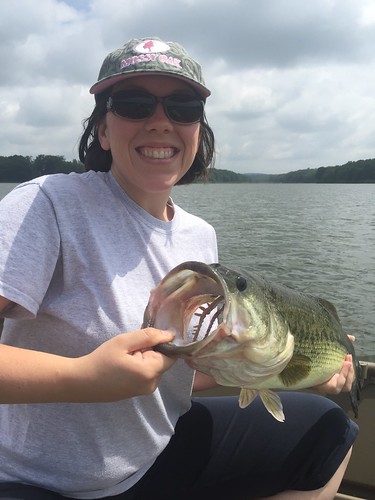
Photo courtesy of Megan Goodrich
Ocean City area fishing in the surf has settled into fishing for familiar summer species. Kingfish are being caught on bloodworms or Fishbites, small bluefish on finger mullet and flounder on squid. A few larger bluefish are being caught on cut menhaden baits but most of the takers are sting rays, dogfish and inshore sharks. A word of note for anyone catching sharks, most are protected and should be released while still supported by water which is not always easy in the wave action of the surf. Large sand tiger sharks are especially vulnerable to organ damage if they are dragged up on the beach for a photo. Certain species of inshore sharks in the coastal bays, such as sandbars, duskies, and sand tigers, are protected and it is illegal to possess them.
If you are planning to fish for coastal sharks in the surf and back bays, please take the time to learn how to ID the protected species. The following links provide some valuable information. Go to dnr.maryland.gov/fisheries/Pages/coastal/tagging.aspx, then click on shark catch card. Circle hooks and careful release techniques are strongly encouraged, this catch and release page is very informative and also has a species identification link. As a final note, here are some additional links on how to identify coastal sharks dnr.maryland.gov/fisheries/Pages/coastal/SharkFacts.aspx, and another from our neighboring state of Delaware.
At the Ocean City Inlet bluefish are being caught on Got-Cha plugs, Spec rigs. Striped bass continue to entertain those fishing in the Jetty and Route 50 Bridge area. Casting swim shads, bucktails or drifting live eels have been good choices. Flounder can be found in the area and a few triggerfish and sheepshead are being caught near the South Jetty on sand fleas.
Flounder fishing in the back bay channels has been good as water temperatures have risen to the upper 70's and water clarity has been very good. White Gulp mullet baits, squid strips and minnows have been good choices while drifting for flounder. Small sea bass and sea robins also love those stripes of squid.
At the wreck and reef sites there is a mix of sea bass, triggerfish and flounder being caught. At times double digit catches of sea bass can occur and some of the wrecks are swarming with gray trigger fish which make great table fare once one learns to cut out through the tough hide before filleting. Otherwise they can dull a knife fairly quickly.
Farther offshore there is good chunking action for a mix of bluefin and yellowfin tuna at the Hot Dog, Jack Spot, Massey's Canyon and the Lumpy Bottom. Out at the Washington and Poorman's Canyons there is a mix of bluefin, yellowfin, dolphin and white marlin.
Bumper sticker seen recently in the Florida Keys "If you think I'm a lousy driver, wait till you see me fish" "
|  Date : 7/13/2016 (1) Date : 7/13/2016 (1)
| | 7/13/2016 |
As a lifelong fisherman and a bit of a softy when it comes to kids and fishing, I had a warm spot glowing in my heart when I stopped by a kids fishing derby in Easton last Saturday morning. The local Elks Lodge did an amazing job of organizing what was a well attended event. One of the things that really struck me was that they provided fishing outfits for some of the less advantaged kids who live in town. To see them running around with a fishing outfit and actually catch one of the bluegill sunfish stocked by the Fisheries Service gave me an inner glow that carried me through the rest of the weekend.
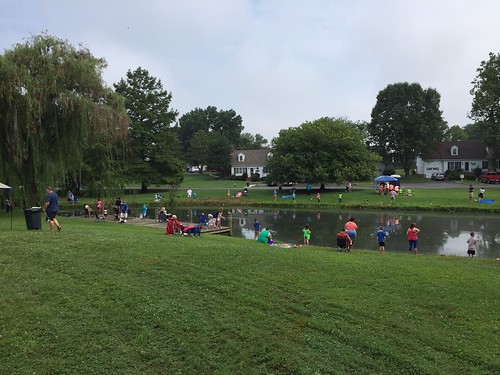
Photo by Keith Lockwood
As of yesterday the Conowingo Dam has not been releasing water for power generation in the afternoons. Fishing tends to be slow during these lulls although there tends to be a little topwater action for striped bass at dawn in the dam pool. Farther down the Susquehanna there are plenty of channel catfish to catch, largemouth bass in the grass of the flats and white perch in the adjacent tidal rivers.
The upper bay region has a lot of striped bass opportunities this week. The fleets anchored from Sandy Point Light north along the western edge past the mouth of the Magothy River and at the Love Point area to Swan Point are certainly noticeable as they chum for striped bass. The 25' to 30' channel edge tends to be the sweet spot when a good tide is running. There are other options for those who like to get away from the crowds. There are striped bass in the lower Patapsco River and similar tidal rivers in the upper bay region. Early in the morning and late evening are good times to try topwater lures along shoreline structure or jigging along channel edges can be productive. Catching small white perch in the tidal creeks and live lining them down deep along channel edges out in the bay is also a good way to catch a nice grade of striped bass. There has also been some limited striped bass action reported at some of the shoal areas such as Tea Kettle shoals and 9' Knoll so they may be worth taking a quick look at with a depth finder. Trolling umbrella rigs with bucktail or swim shad trailers is a good bet as are spoons trolled behind a planer. Bluefish are starting to show up in the upper bay so swim shads may come in a little short and sea nettles are becoming more common also. Water temperatures are about 79° with a salinity of 8 ppt. Chris Trumbauer was trolling near Swan Point and has good cause to smile with this nice 32" striped bass.

Photo courtesy of Chris Trumbauer
The Bay Bridge continues to be a good place to look for striped bass suspended near bridge piers. Some have been chunking with good luck as well as live lining small white perch and jigging. There is plenty of striped bass action in the middle bay region just below the bridge near Hackett's down to Thomas Point. Boats can be seen anchored along the 30' edge chumming. As with the dense chumming fleets above the bridge sometimes it is worth it to move away from the congestion and explore other channel edges for a little more breathing room. Suspended fish can be spotted on depth finders and chumming or live lining white perch can pay off well. At times fish can also be found near some of the anchored cargo ships at anchor for some light tackle jigging or trolling. Umbrella rigs or single spoons tend to be popular now for those trolling, especially now that bluefish are in the region. Lonnie Johnson was jigging near Thomas Point when he caught this nice striped bass.
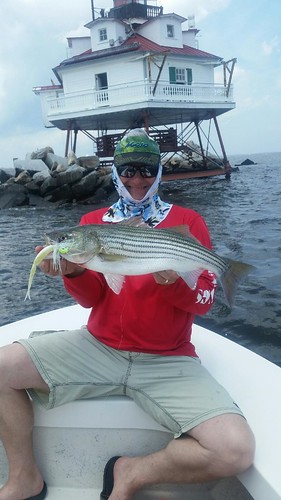
Photo by Travis Long
A few croakers are being caught in the middle bay region in the evenings as they move out of the deep channels to shallower waters to feed but they tend to be fairly sparse. Not so for white perch though. They are holding in all of their typical summer haunts and are providing plenty of fishing action for those who care to fish for them. Grass shrimp or blood worms on a bottom rig tend to be a standard for those who like to fish bait. An ultra-light spinning or baitcaster is a great outfit to use for casting beetle-spins, small jigs, shad darts or spinners around shoreline structure for white perch. It can be a lot of fun on a quiet summer evening and also provide some tasty fillets for the frying pan.
The shallow water striped bass fishery continues to hold great opportunities for catching some nice fish. There are a fair percentage of smaller fish mixed in but there seems to be plenty of action along prominent points and structure such as old piers, jetties and sunken rock breakwaters. Suspended jerkbaits and swim shads can be very effect lures to use but topwater poppers are by far the most entertaining. A high flood or high ebb tide tends to be one of the better times to fish the shallows and as water temperatures move into the low 80's the action tends to be over as the sun rises above the horizon and starts an hour or so before sunset. Lou Wayson made the effort to get up early and be out on the water before sunrise and was rewarded with this nice Choptank River striped bass.
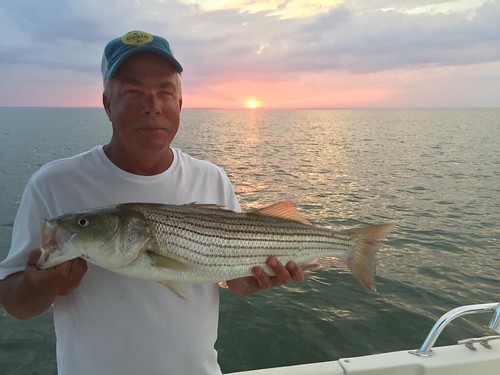
Photo by Rich Watts
Lower Bay region fishermen have wondering where all their striped bass have gone and of course the answer is north for a fair percentage of them, but not all. There are some striped bass being caught along the steep channel edges in the lower Potomac near Tall Timbers and also the lower Patuxent. Most are trolling small spoons behind planers or umbrella rigs with inline weights to get lures down deep. Bluefish will also be a big part of the mix when trolling. There is also a good shallow water bite in the early morning and late evening hours along select shoreline structure on both sides of the bay.
Although striped bass may be sparse, the lower bay has some incredible fishing opportunities no other region has. Two of those exciting options are croakers and cobia. The croaker fishing in the evenings along channel edges and shoal areas have been exceptional with limit catches the norm. Perhaps more exciting though is the presence of good numbers of cobia in areas near the Target Ship, the Middle Grounds and off Smith Point. Most boats are setting up chum slicks to lure the cobia in and drifting cut bait to them. It has been quite a while since Marylanders have had such good opportunities to catch a cobia in Chesapeake Bay waters. There are a lot of bluefish in the region so they will certainly be lured to these chum slicks.
All of the tidal creeks and rivers in the lower region of the bay are holding excellent numbers of white perch. They can either be caught deep on bottom rigs baited with bloodworms or grass shrimp or caught along shoreline structure in the evenings or early mornings. Fishing light with small beetle-spins, shad darts or spinners is a fun way to catch a mess of white perch. There are also plenty of medium-sized blue catfish in the lower Potomac and channel catfish in the Patuxent. Here is Kyle Murphy with a nice stringer of blue catfish from the Potomac.
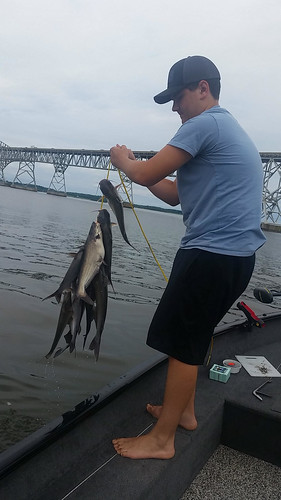
Photo courtesy of Pat Murphy
Recreational crabbing continues to be very good in most of the tidal rivers and creeks in the bay. The middle and lower bay regions tend to offer the best crabbing but the upper bay is quickly improving. In the middle and lower bay regions most of the crabs are holding in 13' of water or better and the largest crabs are reported to be in about 20' of water. Razor clams continue to outperform chicken necks and a lot of 2" to 3" crabs have been showing up on baits lately. Some crabbers in the upper bay stand by their fresh baits of cut white perch as one of the better baits to use in collapsible crab traps. Salinities are high enough now that sea nettles are downright pesky when running a trotline.
Freshwater fishing in the western region of the state at Deep Creek Lake has now focused on fishing early in the morning for smallmouth bass near rocky bottom in about 12' of water with tubes and crankbaits. Largemouth bass can be found looking for shade under floating docks or deep grass. Casting whacky rigged soft plastics under the docks or into the grass is a good tactic to get them to pick up a bait. Drifting near deep grass with minnows under a slip bobber can provide some relaxing fishing for a mixed bag of walleye, smallmouth bass, large yellow perch and chain pickerel. Water temperatures at the surface of the lake are about 75°.
The upper Potomac is running low and clear at the moment and that could change quickly with expected thunderstorms later on this week so be sure to check water levels. If conditions stay low and clear, light lines, fluorocarbon leaders and long casts will put you on smallmouth bass. The best times to fish are the early mornings and late evenings over rocky bottom, boulders and fast current. Tubes tend to be the best way to go.
Fishing for largemouth bass has anglers either up early before dawn out on the water or fishing in the evenings near shallow structure such as grass and lily pad fields. The largemouth bass are holding to a typical summer mode of behavior, where they seek out cool shade during the bright sunny days and move towards the shallows to feed in the evenings and night till morning.
Some of the central region reservoirs that are popular with largemouth bass fishermen also hold the possibility of catching large landlocked freshwater striped bass. The striped bass are stocked as fry and last month a total of 750,000 fry were stocked into Triadelphia (Howard, Montgomery counties) and Rocky Gorge (Howard, Montgomery, Prince George's counties) reservoirs. Through cooperative efforts between staff and the WSSC, there is a popular and productive fishery for striped bass in the reservoirs, where fish exceeding 20 lbs are caught with regularity. These fry were produced at Manning Hatchery from brood striped bass from the Patuxent River. The fish were spawned in the facility and later returned to the river.
The big news last week in the Ocean City fishing community was the amazing 94.6 lb cobia that 9-year old Emma Zajdel caught while fishing with her dad and friends near Little Gull Shoals. The following link will take you to the Department of Natural Resources press release.
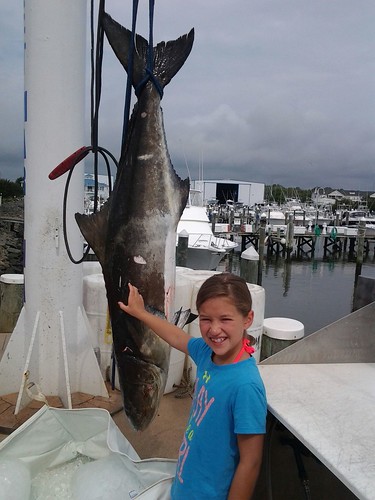
Photo courtesy of Steve Doctor
Ocean City area surf casters are enjoying good fishing for kingfish in the surf, especially in the mornings and evenings. A mix of flounder, small bluefish and dogfish add a little variety. Those fishing larger baits have been catching some large bluefish, inshore sharks as well as sting rays.
At the Ocean City Inlet/Route 50 Bridge area, bluefish have been moving through the inlet and some are rather large and striped bass are being caught in good numbers. Casting bucktails, swim shads and spec rigs has been popular and a few anglers are having good luck drifting cut baits. Flounder are in the area and casting white Gulp baits has been popular and a few sheepshead are being caught on sand fleas near the South Jetty.
The channels in the back bay region are holding flounder and catches have been fairly good. White Gulp baits have been popular as have squid and minnows. There are also bluefish in the back bays.
The boats heading out to the wreck and reef sites are finding sea bass and a few flounder. Double digit catches of sea bass are fairly common. Farther offshore bluefin tuna are being caught near Massey's Canyon and the Washington Canyon. Yellowfin tuna are being caught at the canyons by trolling and chunking as well as near the 30 Fathom Line, dolphin, wahoo, white marlin and a few bigeye tuna round out the offshore mix.
"Saltwater fish are much stronger than their freshwater counterparts. The freshwater fly rodder worries that a fish may break his leader- the saltwater man occasionally wonders if he owns enough line to hold the fish streaking through the water with his fly in its mouth. No one can really describe the run of a bonefish, the slugging of a jack crevalle, the mighty leap of a tarpon; these things have to be experienced. Once they are, the freshwater angler is never the same."- Lefty Kreh
|  Date : 7/6/2016 (1) Date : 7/6/2016 (1)
| | 7/6/2016 | Summer is here and children are enjoying extra time with parents, grandparents and that special uncle, aunt or family friend that will spend time to take them fishing. I have always noticed that our young first time fishing buddies love to choose their first fishing outfit and it is usually a theme related push button spincasting outfit. Fortunately they are relatively inexpensive, just the right size for our little buddies and also just the right size for fish such as bluegills and white perch.
 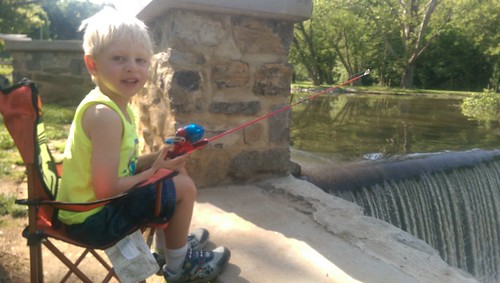
Frist photo by Pat Donlin, second courtesy of Photo courtesy of Nick Lee
The world is not without change. Tell all your friends and fishing partners that the fishing report has been switched to a new web page format which will be re-sizeable for mobile devices, the new address is dnr.maryland.gov/Fisheries/Pages/fishingreport/index.aspx.
You should also be able to find the link on the left side of the horizontal blue bar (under Fishing reports) on the Maryland Department of Natural Resources' Fisheries Service home page.
The water releases at the Conowingo Dam had been flat lined at just about nothing for several days until yesterday afternoon when a large power generation release occurred. This trend will most likely continue through this week as hot weather is predicted and folks will be using their air conditioners. There continues to be a limited striped bass bite in the dam pool and surrounding river area early in the morning. Most are casting topwater lures such as poppers but a few enterprising souls are using live white perch. There is also some limited early morning action out near the Susquehanna Flats area but again this is a "crack of dawn" type fishing with topwater lures and finishes up as soon as the sun pops over the horizon. This is a common pattern now that water temperatures are in the low 80's and fish are seeking cooler and deeper waters during the day.
There tends to be plenty of fishing opportunities this week in the upper bay region as striped bass are found in the lower sections of the region's tidal rivers. The most popular action is of course the chumming fleets that have been setting up on striped bass holding on major channel edges at Swan Point, Love Point and the edge from Sandy Point Light north to the mouth of the Magothy River. There is plenty of action in the early morning and late evening hours in areas such as the Patapsco River/Baltimore Harbor area along shore line structure. Old piers, prominent points, bridge piers and rock structure are all good place to enjoy casting topwater lures for striped bass. These areas also hold white perch for those casting beetle-spins and small spinners or jigs. During brighter daylight hours both striped bass and white perch will be found deeper and jigs will work well for the striped bass and smaller dropper jigs or bottom rigs baited with bloodworms will do the trick for white perch. Allison Lorden and Mary Beth Whalen have plenty to smile about with these two Patapsco River striped bass.
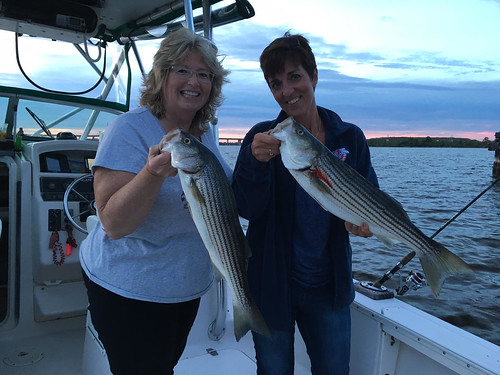
Photo courtesy of Donald Lorden
Charter and private boats from all regions of the bay continue to make the run to channel edges above the Bay Bridge where a large portion of our summer striped bass population has decided to take up residence. The western shipping channel edge from Sandy Point Light north to Baltimore Light tends to be one of the most popular locations to find good concentrations of fish to set up on for chumming or chunking. The Love Point channel edge has also be a good spot as well as Swan Point. A good tide is a must and a falling tide tends to be the best. Most are spotting fish on depth finders before setting up and obtaining a good spot on the 30' edge usually will result in some striped bass finding your offerings. The best catch reports tend to be coming from those who allow their baits to sink to the bottom at the back of a slick and this may take some weight to get baits down to where the fish are. Make sure that you experiment with fishing baits at different depths and varying distances from the boat.
The popular areas where the fleets are anchoring up can be fairly intimidating on the weekends so being a little adventurous and exploring new options along channel edges in other upper bay locations can pay large benefits in fish and peace of mind. Patience and flexibility can go a long way to enjoying some good striped bass fishing away from the densely packed fleets. Trolling deep with spoons or swim shads behind inline weights or planers is a good tactic when trying to cover territory as are umbrella rigs. Light tackle jigging is always a joy when fish can be found suspended over bottom and chunking or chumming over your own school of fish far from the crowds can be very satisfying. Another option is to catch some suitable sized white perch in one of the tidal rivers and try some live lining along likely looking shipping channel edges.
The Bay Bridge piers always hold an attraction to striped bass since it provides structure with plenty of food being swept by in fast moving currents. Chunking can be a good option if one can anchor up current of a likely looking set of bridge piers but the bottom does claim an anchor now and then. Casting bucktails or soft plastic jigs near the bases of the bridge piers is another good choice. White perch can also be found holding near shallower bridge piers.
In the middle bay region when it comes to chumming or chunking for striped bass the outer 30'+ edges of Hacketts, Dollys Lump, Tollys Bar have been good places to look for suspended striped bass to set up on. There has also been some limited action over at the Brick House Bar, the Hill and Buoy 83. A fair percentage of fish up in the chum slick will fall short of the minimum 20" required so handle them carefully and use non-offset circle hooks. Allowing baits to rest on the bottom can up the odds for larger fish.
Trolling umbrella rigs or single spoons and bucktails down deep is a good option for many in the middle bay region this week and don't be too surprised if you see your first bluefish this weekend. Light tackle jigging along steep channel edges is always fun and a great way to enjoy some quiet fishing. There are several steep channel edges just inside Eastern Bay on both the Tilghman Island and Kent Island sides that are great places to check as well as shipping channel edges or wherever birds may be found working over fish.
The early morning and evening shallow water striped bass fishery continues to be very productive and a peaceful way to spend time on the water. Prominent points, old submerged breakwaters and various shoreline structure areas are good places to cast topwater lures. Warmer water seems to have brought higher numbers of sub-legal striped bass into the shallows and they tend to attack poppers and similar topwater lures with abandon. Water temperatures in the shallower areas are now in the low 80's this week.
White perch can be found in the same shoreline structure areas as the striped bass and can provide plenty of fun action and wonderful table fare. An ultra-light spinning outfit matched with beetle-spins or small spinners is the perfect rig for enjoying the morning or evening fishery. During brighter daylight hours a simple bottom rig baited with bloodworms or grass shrimp fished near dock piers or oyster bottom is a good bet.
A few croaker are being caught in the middle bay region with the majority of the reports coming from the lower Choptank River. This fishery is not in the same place as it was several years ago so for now white perch are filling in the gap.
The lower bay region is seeing bluefish of different sizes rapidly moving into the region this past week. There are the smaller nipper size 12" to 14" ones found along bay edges and tidal rivers and a larger 2 lb to 3 lb size group out in the bay near locations such as the Middle Grounds, Point-No-Point to Point Lookout and over on the eastern side of the bay near Tangier Sound up to lower Hooper's Island. Bait is what brings them to the lower bay and when they find it they have no qualms about indulging, so the melee will often be marked by bird action overhead. Casting spoons or jigs into the action is always a fun and exciting way to catch bluefish but trolling spoons is also a tried and true method. If you are trolling in the area of the Middle Grounds or up near the Target Ship; it pays to have some larger spoons in your trolling spread for some catch and release fishing for the large red drum that are in the area. Also of note there are good numbers of cobia in the same areas and you might be lucky enough to catch one. Cobia can be targeted by chumming and chunking or drifting live bait near structure.
The striped bass fishery is not exactly setting the lower bay on fire this week but resourceful fishermen are finding fish in the lower Potomac and Patuxent Rivers. Trolling deep along channel edges with spoons, bucktails and umbrella rigs has been the most successful tactic lately. There is also an early morning and late evening shallow water fishery in the regions tidal rivers and bay shorelines on both the eastern and western sides of the bay.
The excellent croaker fishing is something the lower bay region continues to enjoy this week as the best croaker fishing in Maryland waters is in the lower bay region. The lower Potomac and Patuxent Rivers have been a standout with Tangier and Pocomoke Sounds beginning to provide some bottom fishing action. The best fishing is in the evenings and at night as the croakers move from deeper and cooler waters to the shallows to forage for food during the night. They can be caught during the day but one will have to find deep holes to fish. Bottom rigs, baited with shrimp or peeler crab tend to get the job done. A few small spot are starting to show up in the shallower areas but only a few.
White perch are providing a lot of action for those bottom fishing and they are a welcomed addition to croaker catches in many areas. They can be found in all of the tidal rivers and creeks in the lower bay region. In the evenings they are also providing fun light tackle fishing for those casting small jigs, spinners or beetle-spins along shorelines.
Recreational crabbing continues to be good in most of the tidal rivers and creeks in the lower bay and middle bay regions. There has been some improvement in the upper bay tidal rivers and this may improve further with time and less rainfall. The recent rains have pushed some crabs out of tidal rivers and creeks within the lower bay and middle bay and some of the better catches have been in deeper waters of the tidal rivers. Razor clams tend to be the bait of choice for those searching for the largest and best crab catches. Chicken necks are of course the standard bait and will still put crabs in your basket but if you can give razor clams a try.
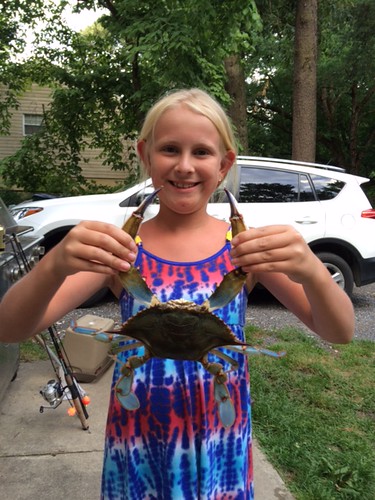
Photo courtesy of Kathryn Barrett
Freshwater trout fishing in the western region has had some issues lately with runoff. In particular the North Branch of the Potomac River and the Youghiogheny River has had high water levels recently. If you are driving a distance to fish these wonderful trout management waters it can pay to check the USGS daily stream flow conditions beforehand.
Deep Creek Lake is settling into a summer mode of fishing with the best fishing occurring early in the morning before vacationing boaters get out on the water. Smallmouth bass and walleye fishing has been good for those casting jerkbaits or Finesse type baits. As the day wears on the shallower coves offer some refuge from boating traffic and largemouth bass can be found under thick grass or chain pickerel will always be nearby. Largemouth bass can also be found under floating docks looking for cool shade and flipping soft plastics under these docks is a good way to target bass. Drifting along deep grass edges with live minnows is also a good way to catch a variety of fish such as walleye, smallmouth bass, large yellow perch and largemouth bass.
The upper Potomac River water temperature is around 80° this week and conditions are reported to be slightly stained. Water levels could change with rain events so the USGS stream flow site link that is listed above is worth checking if conditions are in question. As water temperatures rise the best fishing tends to be early in the morning or late evening in low light conditions. Rocky flats tend to be good places to target at these times and deep submerged ledges during the brighter day hours. Tubes, Finesse type worms and topwater lures all have their place and time.
Largemouth bass are reacting to the summer heat much the way people do. They might not have air conditioning but they do know how to seek cool shade during the day under old docks and thick overhead grass. Pitching soft plastics under docks or stick worms and jigs down through thick grass are good day time strategies. Largemouth bass will venture into shallow areas towards dark and generally search for food all night long where bait fish might be found. Late evening and early morning are good times to work topwater lures in the shallows and jerkbaits, spinnerbaits and small lipless crankbaits are good choices for transition areas in slightly deeper waters adjacent to the shallows.
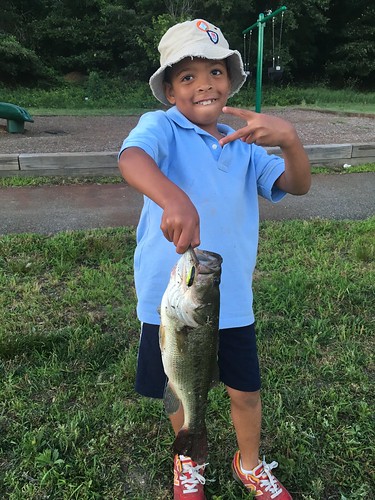
Photo courtesy of George Maddox
The Ocean City area has drifted into summer and with that water temperatures close to shore are around 70° and summer species of fish are available. In the surf kingfish are being caught on small baits in the early morning and evening hours. Bluefish are being caught on finger mullet rigs and there are plenty of inshore sharks and sting rays for those seeking a little more pull.
At the inlet there are a mix of tautog and sheepshead near jetties, bulkheads and bridge piers with the South Jetty offering the best fishing. Sand fleas have been the preferred bait. Flounder are moving through the inlet into the back bay areas. Bluefish and striped bass are being caught mostly in the early morning and evening hours. Got-Cha plugs have been a good choice when targeting bluefish and drifting cut bait or casting bucktails and swim shads have been good choices for the striped bass.
In the back bays, flounder fishing has improved with warmer water temperatures and clearer water. The channel areas offer the best day time fishing and channel edges are great places to target on a falling tide in the morning or evening hours. Silversides, live minnows, squid strips and white Gulp baits are all good choices for flounder.
Outside the inlet the wreck and reef sites have been offering fair to good sea bass fishing at times and flounder are becoming a larger part of the mix. A few bluefin tuna are being caught at traditional spots like the Fingers, Jackspot, Hot Dog and Massey's Canyon. Yellowfin have been showing up at some of these somewhat inshore areas also which is a real plus for those who hesitate running to the canyons. The size grade on the yellowfin tuna has improved recently to the delight of all with fewer throwbacks being reported. Gaffer dolphin, large wahoo and bigeye tuna have also been part of the mix lately at the canyons.
"The world is wide and there must be innumerable wild beautiful places yet unexplored that await the hunter and fisherman. Of these I am always dreaming and creating mental pictures. Yet the waters a fisherman learns to love always call him back."- Zane Grey
|  Date : 6/29/2016 (1) Date : 6/29/2016 (1)
| | 6/29/2016 | Blink your eyes, and here we are facing the Fourth of July weekend. It is a time for family and friends and many will be out on the water fishing and crabbing or spending time freshwater fishing near a cool and friendly pond or stream. July 4th is a Free Fishing Day and it is a great opportunity to take a friend or neighbor with you to perhaps introduce them to fishing or to remind a lapsed angler how much fun they are missing.
The Conowingo Dam continues to release water for power generation in the early afternoons but before that there is hardly any water coming out of the dam. There is a limited early morning striped bass bite in the calm dam pool for those casting topwater lures, suspended jerkbaits or flipping out live eels or white perch. Out along the channel edges near the flats and the mouth of the river there is an early morning topwater striped bass bite that is diminishing with rising water temperatures this week.
A large percentage of the resident striped bass from the lower and middle bay regions have moved into the upper bay region in the past couple of weeks. They can be found spread out along the shipping channel edges near Sandy Point Light, the mouth of the Magothy River and the Love Point channel edges. This is a happy time for boat crews coming out of upper bay ports. Chumming and chunking tends to be the most popular way of fishing and the armada of boats anchored up in these areas can be daunting. At times this can seem like combat fishing as boats and captains jockey for the best position and as the fleet swings with changing tides it can get very interesting at times. I would remind all that you're supposed to be out there to have a good time and if the heat is too much in the kitchen get out and find your own little piece of space somewhere else. Charter boat captains have to put their patrons on fish so they are going to do what it takes and they will put up with crowded conditions. If one watches their depth finder and explores channel edges in other areas striped bass can be found holding and you can set up on them with chum or chunks. A fair portion of the striped bass being encountered are sub-legal, so care must be taken to ensure they survive catch and release. Please use and encourage others to use circle hooks to minimize deep hooking injuries which are usually fatal within a few hours when using J-style hooks.
For those who wish to skip the mess of ground up menhaden, jigging over a suspended school of fish can be a lot of fun on light tackle. Soft plastic jigs such as BKDs or Bass Assassins have been favorite jigs to use. Trolling can also be effective and one can cover a lot of territory in their search for fish, just be careful to stay away from the chumming fleet. Umbrella rigs behind inline weights with swim shads or bucktails for trailers have been hard to beat. Small spoons behind planers are a close second and tend to be easier to reel in. A few of the alternative locations worth looking over are the mouth of Baltimore Harbor, the Triple Buoys, Swan Point and the Hart-Miller Island area. If all else fails, the Bay Bridge piers always seem to hold fish. This happy group of friends caught these nice fish north of the Bay Bridge in about 30' of water while jigging.

Photo courtesy of Jay Bernstein
The white perch fishing in the upper bay has been good to excellent in many of the tidal rivers and bay shorelines as well as shoal areas such as the 7' and 9' Knolls and Man O War Shoals. Bloodworms or Fishbites on a bottom rig are standard fare when fishing some of the deeper areas. Casting to shoreline structure with small jigs, spinners and beetle-spins on ultra-light tackle offers a lot of fun in the mornings and evenings. A good high tide either ebbing or flooding usually offers the best opportunities and the same holds when casting topwater lures for striped bass.
We all followed the outrageous and massive striped bass poaching case that occurred off of Kent Island in 2011 that started an extensive investigation by the Natural Resources Police. A recent Department of Natural Resources press release helps outline what the final outcome is for those involved.
In the middle bay region striped bass are spread throughout the region. They can be found along the shipping channel edges along the western and eastern sides of the bay. The concentrations of fish are not what they were several weeks ago but there are fish out there if one does some exploring. Trolling umbrella rigs behind inline weights or spoons behind planers is a good way to get down to where the fish are suspended near 35' to 40' edges. Watching a depth finder will help to locate schools of fish and at times light tackle jigging can be a fun alternative. There is a mix of sizes in the schools, and a fair percentage will fall a few inches short of the 20" minimum. Bass Assassins and similar soft plastic jigs have been the most popular jigs to use lately. Eastern Bay should not be overlooked; there are some good steep edges on the Tilghman Island side as well as Kent Island. The Kent Narrows always offers shore bound anglers a good chance to score on a nice striped bass or two and the area always holds a lot of white perch. The lower sections of the region's tidal rivers have been offering some good jigging action along channel edges, especially in the early morning and evening hours. James Berry holds up a nice one he caught while jigging.
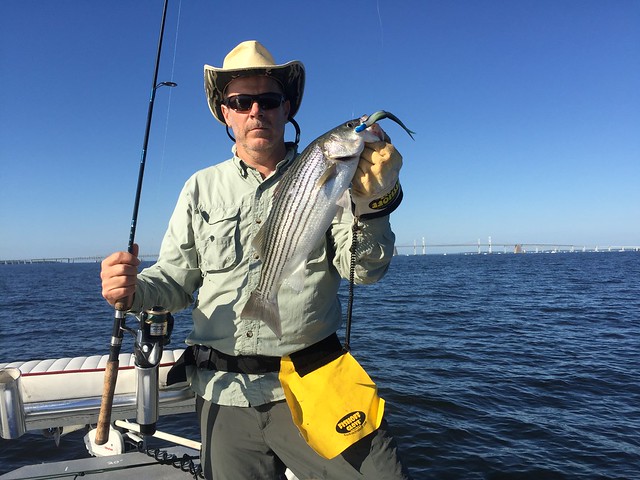
Photo by Travis Long
Chumming at Hacketts and off Poplar Island at the Hill and Clay Banks is still in play although recent reports are not as good as they were a couple of weeks ago. Charter boats from the mid-bay area have been making the trek to above the Bay Bridge. Water temperatures in the middle bay region are in the upper 70's this week and salinities are slightly down.
The shallow water striped bass action has been a great way to catch striped bass this week; water temperatures are still cool enough to keep this fishery very active. Topwater lures are perhaps the best choice when fishing over grassy areas but swim shads and suspended jerkbaits are also good choices when casting in deeper areas near structure such as breakwaters and rocks. This is an early morning or evening window of fishing and a very pleasant way to spend time out on the water. White perch will also be found in the same areas so an ultra-light spinning matched up with a beetle-spin or spinner offers some extra fun.
The lower bay region is offering some exciting fishing this week for several species of fish that are not being seen farther up the bay. The croaker fishing in the lower Patuxent and Potomac Rivers has been outstanding with limit catches of 10" to 12" croakers the norm. Bloodworms, peeler crab, shrimp or artificial bloodworm baits are being used on simple two hook bottom rigs. White perch will also be part of the mix along with blue catfish in the lower Potomac. There is a bit of croaker action in the Pocomoke/Tangier Sound area but it has been reported to be only fair.
Striped bass are being caught in the lower Potomac and Patuxent River areas and along the eastern side of the bay. Trolling has been popular but jigging has been effective also. Small bluefish are being caught in the Point Lookout area and more and larger bluefish will be filling in soon.
There has been some exciting cobia action near the Middle Grounds and the Target Ship recently and some big ones have been caught. Chumming has been popular and the cobia have been caught on cut bait or live bait drifted back in the chum slick. Casting live bait such as crabs or eels near buoys is also a proven strategy. Large red drum are also being reported above the Target Ship and a few have been caught and released by trolling large spoons behind inline weights.
Recreational crabbing continues to be excellent in the tidal rivers of the middle and lower bay regions this week. Crabbing in the upper bay is showing improvement. It is not uncommon for most to be able to catch a full bushel of good crabs per outing.
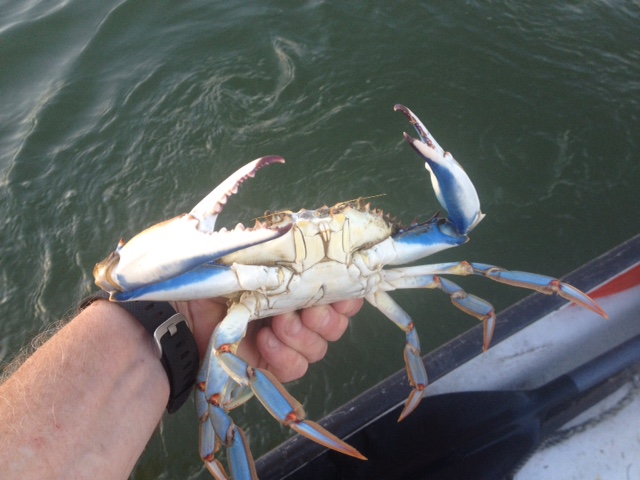
Photo by Jim Livingston
You may have heard the news that beginning in October 2015, Maryland recreational fishing and crabbing licenses are now valid for 365 days from the date of purchase.
We are reaching out to those who previously registered waterfront crab pots with these clarifications/reminders:
- The change in recreational licenses (from calendar year to 365 days from date of purchase) also applies to the waterfront crab pot registration.
- If you completed your free registration to use crab pots off private shoreline property prior to October 1, 2015, your registration has expired. Details on how to register are available here: FAQs on Waterfront Property Crab Pot Registration.
- Turtle excluders are required in recreational crab pots in Maryland. These devices prevent terrapins from entering a crab pot without hindering blue crab entry. Without turtle excluders, terrapins can enter crab pots and drown. You can make your own turtle excluder or visit a retail store to purchase one for your pots. When replacing a crab pot, look for one with turtle excluders already installed.
Information from waterfront crab pot registrations continues to provide the Department with improved information on recreational crabbing effort and helps us to raise awareness and assist property owners with information about using turtle saving devices.
As summer progresses freshwater anglers will see most species of fish slipping into a summer mode of behavior where early morning and late evening fishing will offer the best results. At Deep Creek Lake this means getting out on the lake before daybreak and wrapping things up by mid-morning not so much because of the fish but because of boat traffic. There has been good smallmouth bass fishing outside of floating docks and rocky points; tubes have been a favorite bait. There are largemouth bass holding under floating docks and shoreline structure such as fallen tree tops. Casting plastics such as stick worms or similar soft plastics under docks or to cover is a good tactic. The larger northern pike tend to be holding deep now near the mouths of coves and smaller ones along with chain pickerel can be found in the grassy coves. Spinnerbaits can be a good choice when fishing deep for the big ones. There are also some deep fishing opportunities for trout along the dam face while slow trolling deep with nightcrawlers.
The upper Potomac tends to be in good shape this week for smallmouth bass fishing. Clear water tends to make them very cautious so fluorocarbon line in lower poundage helps and being quiet on the water and fishing slow are good tactics. Tubes, small crankbaits and spinnerbaits are good choices for lures.
Earlier this month the Fisheries Service made an announcement concerning a few public access issues at some popular freshwater fishing locations, click here to read the information.
Fishing for largemouth bass as could be expected has slipped into a summer mode of behavior where the bass are seeking cool shade during the heat of the day and venturing into shallow feeding areas in the evenings through the night and into the early morning hours. This is a fun time to break out the topwater lures such as frogs, buzzbaits, chatterbaits and poppers. Targeting grass, lily pads and spatterdock are good choices as well as creek mouths and shallow structure such as fallen tree tops. When largemouth bass are hunkered down in thick grass weedless stick worms or similar soft plastics can be dropped down through the grass. Sunken wood or transition edges leading to shallower waters can be fished with suspended jerkbaits, spinnerbaits, jigs or small crankbaits. This little fellow is certainly happy with this largemouth bass he caught on a popper.
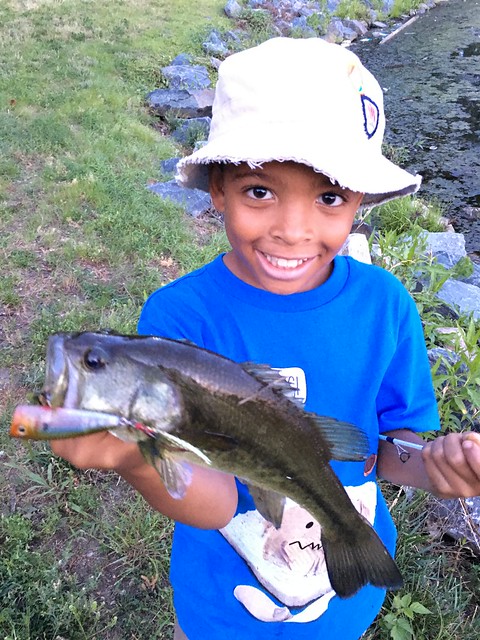
Photo courtesy of George Maddox
The Fisheries Service hatchery program has been busy raising other species of fish besides trout this past spring. To augment natural reproduction, walleye fingerlings obtained from Manning hatchery were stocked into the following areas: Triadelphia Reservoir (Howard, Montgomery Counties) – 20,000; Rocky Gorge Reservoir (Howard, Montgomery, Prince George's Counties) - 20,000; Savage River Reservoir (Garrett County) - 50,000; Liberty Reservoir (Baltimore County) - 50,000. An additional 30,000 walleye fingerlings were stocked in the nontidal Potomac River. These fingerling walleye were marked with oxytetracyline (OTC) to allow biologists to differentiate the stocked fish from wild fish and evaluate the contribution of the stocking program to annual year class strength.
Ocean City area water temperatures are rising into the low 70's this week and the fishing scene is adjusting to one more familiar with summer. Surf fishermen are catching a mix of kingfish, flounder and blowfish in the surf when using small baits such as bloodworms or squid. Those using finger mullet are catching small to medium-sized bluefish and dogfish, black drum, sting rays and skates are being caught on larger cut baits. Inshore sharks are beginning to show up in the surf zone in the evenings. Elmer Merino caught this nice flounder in the surf while fishing for kingfish with squid.
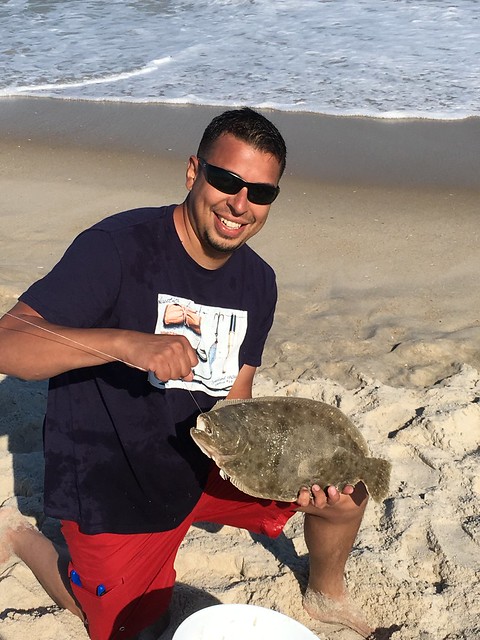
Photo courtesy of Elmer Merino
At the inlet some exciting striped bass fishing continues for anglers casting bucktails, swim shads and bluefish are also being caught mostly on Got-Cha plugs. A few tautog and sheepshead are being caught on sand fleas near the South Jetty and nearby bulkheads and bridge piers. Flounder are moving through the inlet and can be caught on white Gulp baits or traditional minnow or squid bait.
In the back bay areas flounder are being caught in the channels and channel edges from Sinepuxent Bay to the Route 90 Bridge. Drifting with white Gulp lures or minnow and squid baits are popular. Small sea bass, blowfish and sea robins have been enjoying the squid baits and help cut the slow times between flounder bites.
Outside the inlet sea bass catches have been fair to good at the wreck and reef sites and flounder are quickly becoming part of the mix. Farther offshore at the canyons there are a lot of small yellowfin tuna in the area of the Poorman's Canyon down to the Washington Canyon. Gaffer size dolphin, bigeye tuna and white marlin are also part of the mix.
"I only make movies to finance my fishing."- Lee Marvin
|  Date : 6/22/2016 (1) Date : 6/22/2016 (1)
| | 6/22/2016 | It is summertime, and as the song goes “the living is easy”. Many of our fisheries are transitioning as water temperatures warm and summer migrants drift into our bay and ocean areas. The living is easy and we all need to take time to enjoy it. There is no better way to spend special time with family and friends, to relax and do nothing but concentrate on fishing. There are a lot of wonderful fishing opportunities available no matter where you live in Maryland, don’t miss out. Mary Mahoney accompanied her husband for some fun shallow water fishing recently and proudly holds up a nice striped bass caught on a popper in the shallows of the Choptank River.
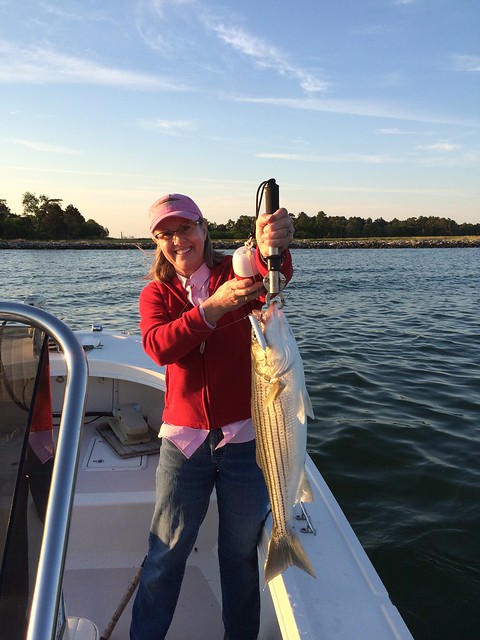
Photo courtesy of Matt Mahoney
At the lower Susquehanna River the Conowingo Dam is releasing some fairly hefty power generation water releases in the afternoons. There is some early morning striped bass action at the dam pool on topwater lures as well as crankbaits and swim shads. Down river, there are plenty of channel catfish and medium-sized flathead catfish. Out beyond the mouth of the river there is an early morning and evening striped bass topwater bite along the deeper grass edges.
Farther down in the upper bay region there is striped bass action to be found in the early morning and evening hours along shoreline structure such as rock breakwaters and channel edges. Topwater lures are perhaps the most fun way to fish but where channel edges are deeper swim shads or vertical jigging is a great option when fish can be spotted suspended over structure. There has been good action in the lower Patapsco River/Baltimore Harbor area this week with a mix of sub-legal and legal-size striped bass along with extremely good white perch fishing. White perch are also being found in good numbers in most of the other tidal rivers and coves within the upper bay region. Cownose rays have taken up residence in the upper bay and will be seen most anywhere and interfering with most types of fishing.
A lot of striped bass have been moving into the upper bay this past week and the dense fleets of boats are a sure give away to the action. Last Friday morning charter boats from the middle and upper bay region were trolling in a tight pack right off the beaches of Sandy Point working on striped bass. Large fleets of private and charter boats are anchoring up at Love Point, near the Triple Buoys, Swan Point and the steep channel edges from the mouth of the Magothy south to beyond Sandy Point Light chumming and chunking for striped bass. The striped bass are a mix of sizes with a lot of 16” to 18” fish up in the chum slicks and fish larger than 20” back in the lower tail end of slicks or right up in the water column close to the boats. Everyone is urged to use circle hooks even though many inexperienced find more fun fishing with J style hooks and enjoying setting the hook. The unfortunate price is deep hooked fish that are often seen floating down current below the fleets after being released.
The Bay Bridge continues to hold striped bass near many of the piers this week. The fish are suspended off the bottom and can be caught by casting bucktails and soft plastic jigs or by chunking. It can be tricky anchoring up current of the bridge piers and there are many anchors that never came back to the surface to their owners. There are cables and steel debris down there under the bridge, so be careful. White perch are also holding near some of the shallower bridge piers and can be caught on small jigs on a dropper rig or bottom rigs baited with bloodworms.

Photo courtesy of Travis Long
There is plenty of good trolling action for striped bass in the upper bay along channel edges. The mouth of the Patapsco and Magothy Rivers has been good as well as locations such as the Triple Buoys and Podickory Point. A word of caution would be to stay clear of the chumming fleets; when things get tight, tempers tend to flair. Umbrella rigs with inline weights are favorite, single spoons or tandem bucktails and swim shads can trolled behind a planer to get them down.
In the Middle Bay region the outside edge of Hacketts is one of the better shows in town. A lot of striped bass have moved north of the Bay Bridge from the Chesapeake Beach area, and Hacketts is a prime stop off point for them. The spot has been attracting a considerable fleet and some are also poking around the Hill looking for fish on depth finders to drop chum on. The striped bass have been spread out lately in the middle bay region so unless concentrations can be found suspended, trolling might be a good option over chumming or jigging. The striped bass tend to be along 35’ to 40’ channel edges so planers and inline weights help get lures down to the fish. Water temperatures in the middle bay region are about 76 degrees on top and about 10 degrees cooler at 40’.
The early morning and evening shallow water striped bass fishing has improved this week with clearer water and favorable tides. The shorelines of the bay and areas like Poplar Island, Eastern Bay and the lower Severn and Choptank Rivers have been great places to cast topwater lures. Often good white perch fishing can be found in these same locations and casting spinners, small jigs or beetle-spins with an ultra-light outfit can create some great fun. Anthony Nicholas and Andrea Deleonibus spent some fun time together casting topwater lures in the Severn recently.
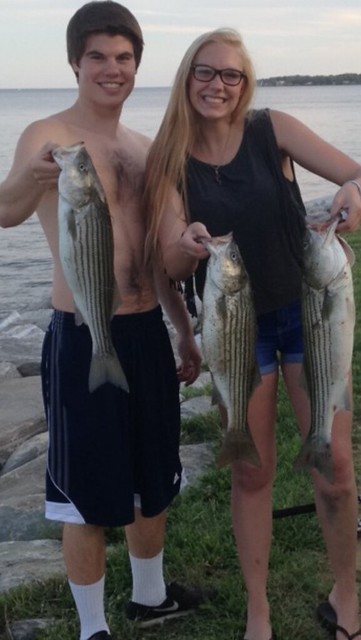
Photo courtesy of Anthony Nicholas
The croakers have moved into the lower Choptank River this week and may be found in the western tidal rivers this week as well. Peeler crab, bloodworms or table shrimp make good baits on a double bottom rig. One needs to make sure if they use table shrimp pieces, to purchase wild caught shrimp and not the farm raised white shrimp which have no scent. Croakers are being caught along channel edges in the early evenings and shallower areas at night. The Bill Burton Fishing Pier is a good place for shore bound anglers to give croakers and white perch a try.
Lower bay fishing for striped bass this week takes some luck and knowledge to find the fish and put them in the boat. They are spread sparse through the region this week. Perhaps one of the better tactics when searching for fish is to troll along channel edges in the lower Potomac River and along the edges of the shipping channel in the bay. If you do decide to troll it looks like it is starting to be a good idea to put swim shads away for a while. Small bluefish in the 14” to 16” size range are beginning to move into the Point Lookout area and their larger friends will be right behind them. Small to medium-sized spoons or bucktails would be a good choice for trolling lures.
There has also been some good early morning and evening topwater striped bass action along shoreline structure such as Cedar Point and places in the lower Patuxent and Potomac Rivers as well as the shorelines on the eastern side of the bay. A few speckled trout are being caught along the eastern marsh edges and large red drum are beginning to show up near the Target Ship.
Croaker fishing is hot and heavy in the lower bay this week from Tangier Sound to the lower Potomac River. The lower Patuxent has been particularly good from shore or in boats. As can be expected during the day the croakers are holding deep, often 50’ or more. At dusk they begin to move up channel edges to forage in shallower waters during the night. Oyster bars and channel edges are good places to anchor up and fish with peeler crab baits on a two hook bottom rig. Squid, shrimp and bloodworms can also be good baits and bloodworms will certainly attract any white perch in the vicinity.
Recreational crabbing this week continues to be very good in the middle and lower bay regions. Most tidal rivers on both sides of the bay are providing bushel catches for most that are using trotlines and or collapsible traps. Razor clams remain favored bait for many but with an abundance of crabs in all sizes around, chicken necks will work just fine. Jim Livingston kneels next to a nice bushel of crabs he caught while running 30 collapsible traps near the West and Rhode Rivers area recently.
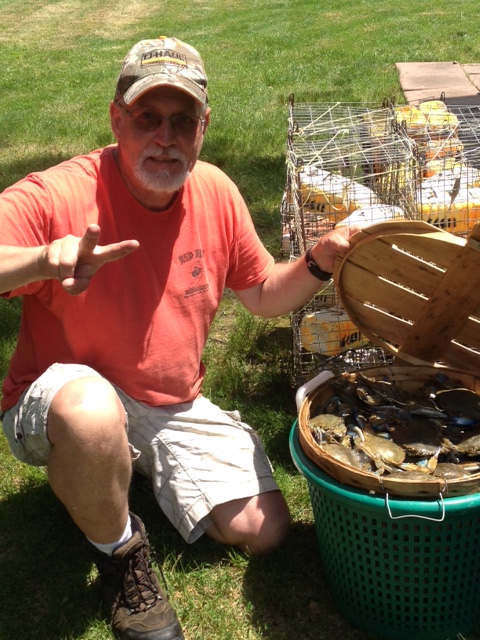
Photo courtesy of Jim Livingston
Photo courtesy of The Deep Creek Lake area has been hammered with heavy rains recently and water levels are up in the lake and shoreline edges are showing stained water conditions. There were also two unfortunate sewage spill events in the McHenry Cove area recently. Water temperatures are in the low 70s. It is that time of the year where serious fishing happens early in the morning due to crazy boat traffic. There is good fishing for smallmouth bass, largemouth bass and a mix of rock bass, bluegills and chain pickerel. Largemouth bass are starting to hold under floating docks now looking for shade. Stick worms, crankbaits and suspended jerkbaits tend to some of the favored lures to use. Some have been having good luck trolling night crawlers down about 30’ deep along the dam face for rainbow trout.
The upper Potomac River has been running clear with water temperatures around 78 degrees. The smallmouth bass have been skittish in the clear water so light line and long casts will go a long way to increasing success. Tubes and stick worms have been favorite baits lately. Heavy rain in the upper watershed of the Potomac can change water levels quickly so it pays to keep an eye on things. There is a saying among big wave surfers that is also good advice for small boat fishermen – “When in doubt, don’t go out!”
Trout fishing is still good in many of the trout management waters in the central and western regions where trout fishing is more restrictive than the usual 5 trout per day in put and take areas. Many of these management waters provide fun catch and release fishing through the summer months.
Largemouth bass are beginning to hold to grass or any kind of cover they can find including fallen tree tops, sunken wood, lily pads or spatterdock fields. Spinnerbaits are good to work through thin cover or along edges of thick cover. Buzzbaits are coming into their own now over shallow grass and stick worms dropped through grass is a good tactic. The best fishing is the early morning hours and evenings as largemouth bass transition into their summer modes of behavior. In tidal rivers grass near creek mouths are good places to fish as are the edges of grass or spatterdock field at low tide.
Fishing in the Ocean City area continues to transition into a typical summer fishery as water temperatures pass the mid-60’s this week along the surf and inlet areas. Small bluefish and some medium-sized ones also are being caught in the surf on finger mullet rigs. A few striped bass are being caught on cut menhaden baits. Dogfish, skates and sting rays tend to dominate the surf at the moment. Kingfish are being caught on bloodworms along with a few blowfish.
At the inlet bluefish tend to move in and out but the real action is fishing for striped bass. They are being caught with good regularity from the jetties and Route 50 Bridge on bucktails, swim shads, cut bait and live eels. Steve Doctor holds up a nice one caught from the Route 50 Bridge recently.
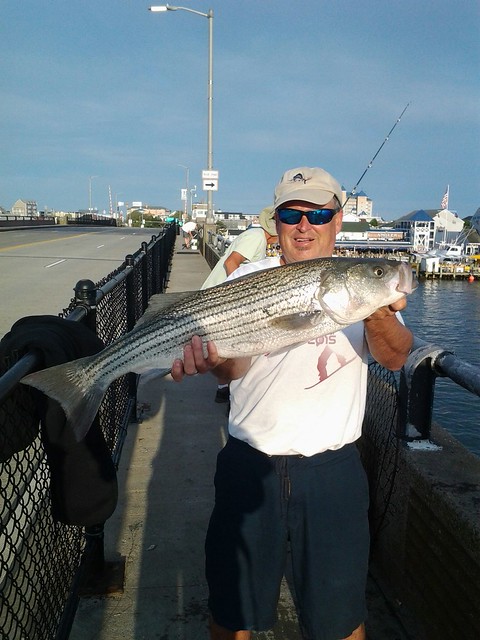
Photo courtesy of Steve Doctor
Flounder fishing is steadily improving but there is no getting around that the fishing is tough and keepers are even tougher to find. The channels leading to the inlet offer some of the best action but the edges of flats and shoals should not be over looked on a good falling tide. Small sea bass and sea robins have moved into the channels and can’t help but make short work of squid baits.
Sea bass fishing at the offshore wreck and reef sites has been steady with many rail huggers being able to put together double digit catches. Flounder are becoming a larger portion of the bottom fishing mix and certainly a welcomed addition.
Out at the canyons when weather conditions allow, the boats making the trek are finding some exciting fishing opportunities. There tends to be a lot of small yellowfin tuna around and many are sub-legal in size and being released. At times boats will run into a nice grade of 35 lb to 65 lb yellowfin. Dolphin and white marlin releases are part of the mix but perhaps the most exciting news is the bigeye tuna that are being caught.
"I fish all the time when I’m home; so when I get a chance to go on vacation, I make sure I get in plenty of fishing. "- Thomas McGuane
|
|
